Early Views of West Hollywood
| Historical Photos of West Hollywood |
 |
|
| (ca. 1931)* – Panoramic view showing the Sunset Medical Building (aka “Crescent Heights Shopping Center”) located on the south side of Sunset at Laurel. The Crescent Heights Market is on the right, and further to the right (out of frame) is Schwab's Pharmacy. On the left is Haverfield Drugs. West Hollywood is west of Crescent Heights. |
Historical Notes The beautiful 'French Norman revival' building was located on the southeast corner of Sunset Blvd. and Crescent Heights Blvd., just east of the Garden of Allah apartments. The structure faced Sunset Blvd. |
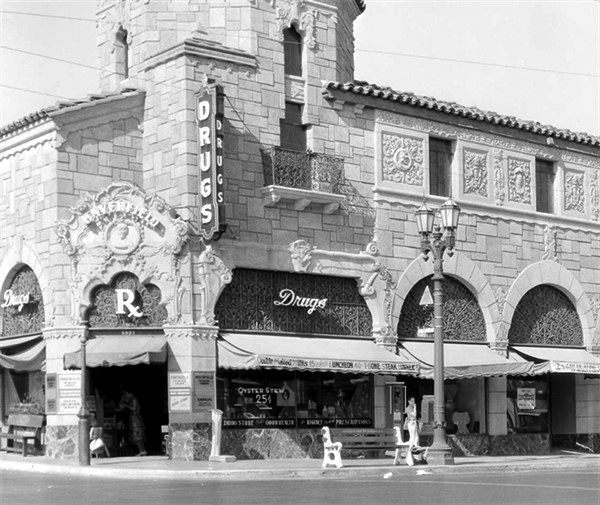 |
|
| (1928)* – View showing Haverfield Drugs at the northeast corner of Sunset and Laurel Canyon Blvd., across the street from the Crescent Heights Market and Schwab’s Pharmacy. The building is still standing today and a UPS Store now occupies the corner store. Click HERE for contemporary view. |
Then and Now
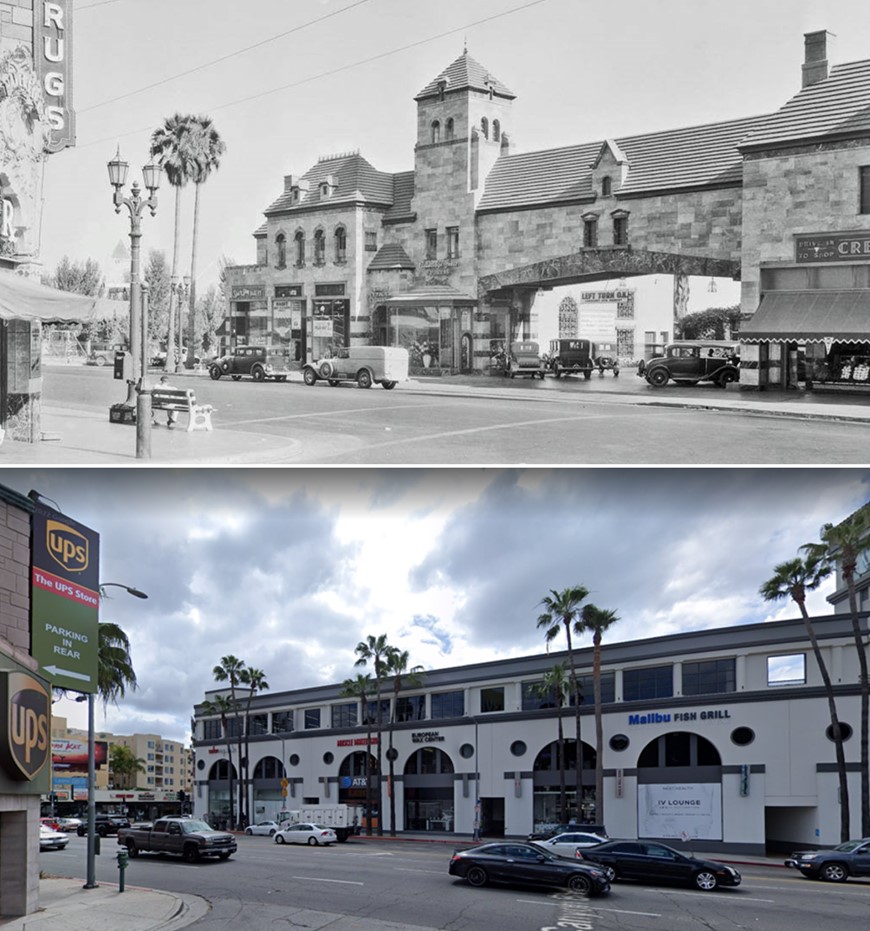 |
|
| (1931 vs 2019)* - View looking southeast from the corner of Laurel Canyon and Sunset Boulevard. Photo comparison by Jack Feldman. |
Historical Notes Today, the 8000 Sunset Strip Shopping Center stands at the southeast corner of Sunset and Crescent Heights. The center includes Trader Joe's, CB2 (Crate & Barrel), Sundance Cinema, Crunch Fitness, Subway and several offices. |
* * * * * |
Schwab's Pharmacy
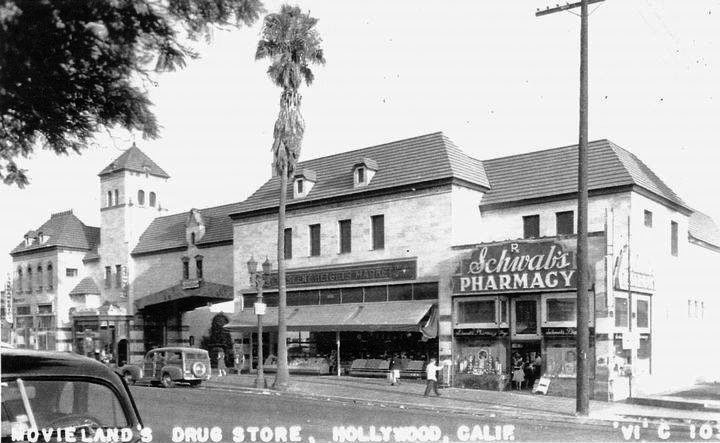 |
|
| (1940s)* – Postcard view looking at the south side of Sunset east of Crescent Heights showing “Movieland’s Drug Store” (Schwab’s Pharmacy). |
Historical Notes Schwab's Pharmacy was a popular hangout for movie actors and movie industry dealmakers from the 1930s through the 1950s. Like many drug stores in the United States throughout the mid-twentieth century, Schwab's sold medicines and had a counter serving ice cream dishes and light meals. |
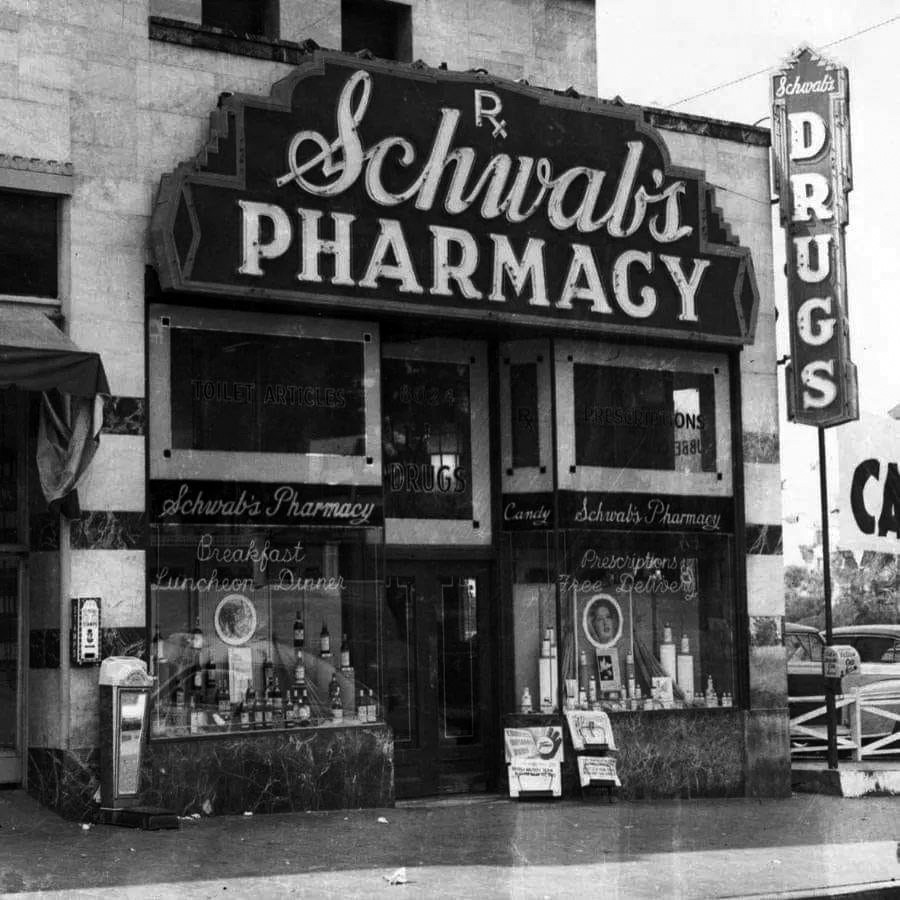 |
|
| (1940s)* – Close-up view of Schwab’s Pharmacy at 8024 Sunset Boulevard in West Hollywood. |
Historical Notes Schwab's opened in 1932 when Philadelphia natives and brothers, Jack, Leon, Bernard and Martin Schwab, bought a failing pharmacy on the corner of Sunset and Crescent Heights boulevards. The pharmacy was located just around the corner from several studios and the brothers set up their pharmacy to cater to the Hollywood crowd. Schwab's was more than just a place to fill prescriptions: there was a grocery store, a make-up counter (Gloria Swanson bought all her cosmetics there) and a restaurant that served all-American fare like hamburgers and meatloaf (Marlon Brando and Orson Welles were fans). |
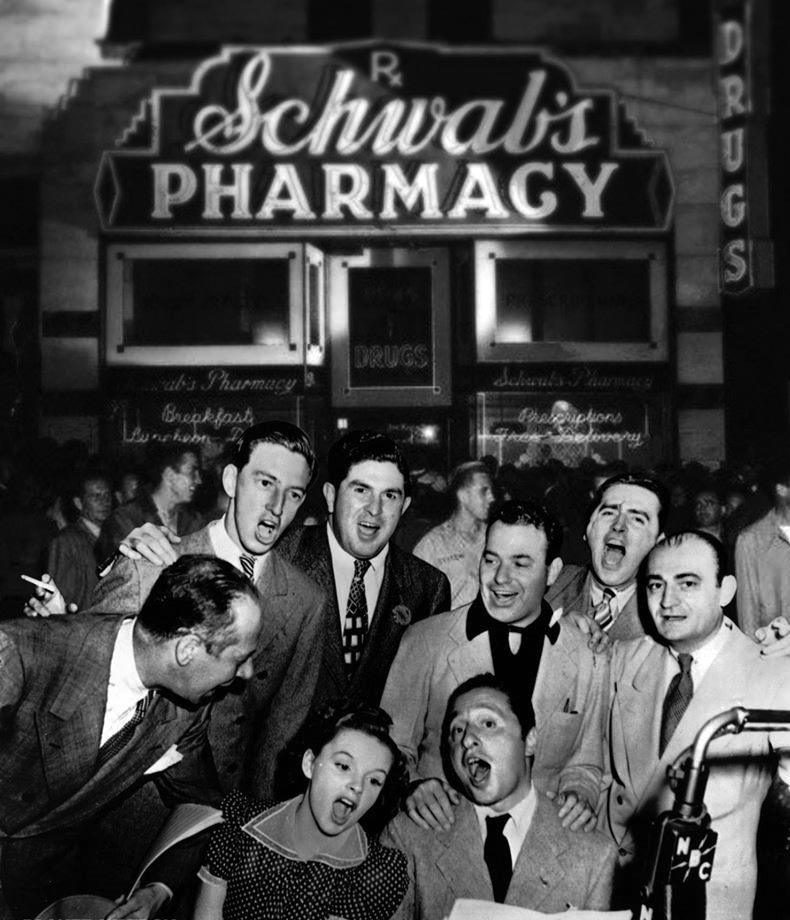 |
|
| (ca. 1939)* - Standing, Bert Lahr, Ray Bolger, MGM executive L.K. Sydney, E.Y. Harburg, Meredith Wilson, & publisher Harry Link. Judy Garland & Harold Arlen are at the piano. |
Historical Notes 1938 - Harold Arlen was working on a movie score for an upcoming film, The Wizard of Oz. He was having a difficult time composing a ballad for one particular scene. Ballads were usually love songs, but this scene was about a lonely farm girl longing for "a place where there isn't any trouble," and it had him stumped. He decided to take a break from writing and catch a movie at Grauman's Theater with his wife, Anya. He sat in the passenger seat with Anya at the wheel. They turned onto Sunset Blvd, heading East, when suddenly he touched her arm and asked her to pull over. Anya parked the car under the neon sign of Schwab's Pharmacy, as Harold scribbled the melody that just came to him. He rushed inside to call his writing partner, Yip Harburg, from the Schwab's payphone. "Yippers, can you meet me at my house in 10 minutes? I think I got a nugget." |
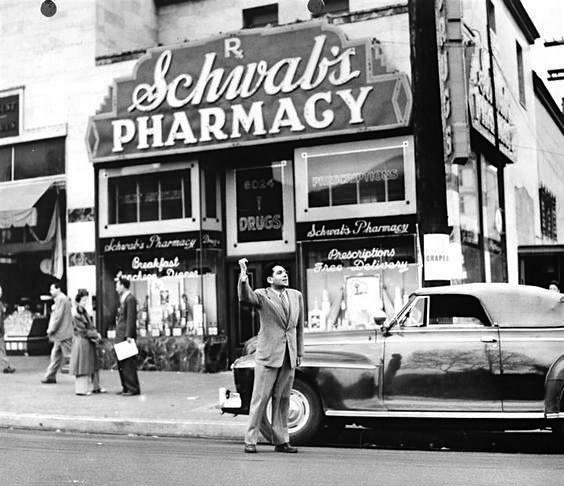 |
|
| (1940s)* - View showing Sidney Skolsky, a gossip columnist, in front of Schwab’s Pharmacy on Sunset Blvd. |
Historical Notes Sidney Skolsky, a syndicated Hollywood gossip columnist for the New York Daily News who was the first journalist to use the nickname "Oscar" for the Academy Award in print, made Schwab's famous in the 1930s. He used the drugstore as his office, and called his column in Photoplay, the premiere movie magazine in the U.S. at the time, "From A Stool At Schwab's". |
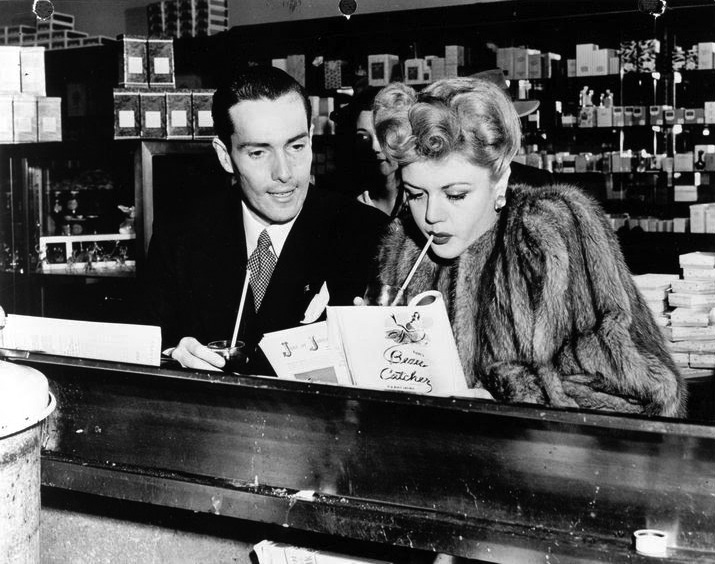 |
|
| (1945)* - Hurd Hatfield and Angela Lansbury hanging out at the counter of Schwab's Pharmacy and (maybe) reading reviews of their film "The Picture of Dorian Gray", which was released in March of that year. |
Historical Notes A persistent Hollywood legend has it that actress Lana Turner was "discovered" by director Mervyn LeRoy while at the soda counter at Schwab's. While the 16-year-old Turner was indeed discovered at a soda counter, the actual location was not Schwab's but another Sunset Boulevard establishment, the Top Hat Cafe, and the person who discovered her was not LeRoy but Hollywood Reporter publisher William Wilkerson. |
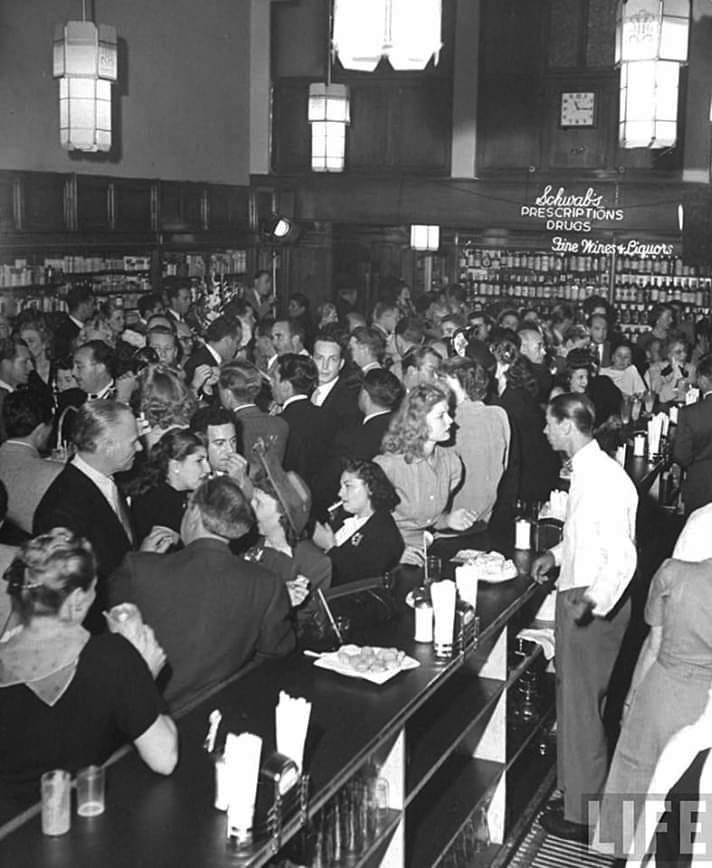 |
|
| (1948)* - Schwab's Pharmacy on Sunset Blvd on a Friday night. It was a hangout for Hollywood Stars and up--and-comers. Life Magazine Photo |
Historical Notes Schwab’s became an essential piece not only of Hollywood day-to-day living but of Hollywood lore. Open from early in the morning until past midnight, the place was a clubhouse, a headquarters, and a hearth fro up-and-comers, never-quite-ever-beens, rubberneckers, and strivers and schemers trying to pry a way into (sometimes back into) the movie business. |
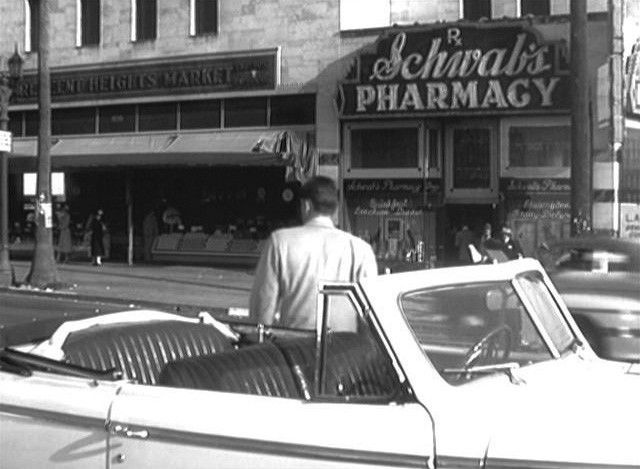 |
|
| (1950)* – William Holden waits for traffic to clear as he attempts to cross Sunset Blvd on his way to Schwab’s Pharmacy in this scene from the movie Sunset Boulevard. Crescent Heights Market is seen on the left. |
Historical Notes The 1950 film, Sunset Boulevard, stars William Holden as Joe Gillis, a struggling screenwriter, and Gloria Swanson as Norma Desmond, a former silent-film star who draws him into her demented fantasy world, where she dreams of making a triumphant return to the screen. Erich von Stroheim plays Max von Mayerling, her devoted butler, and Nancy Olson, Jack Webb, Lloyd Gough, and Fred Clark appear in supporting roles. Director Cecil B. DeMille and gossip columnist Hedda Hopper play themselves, and the film includes cameo appearances by leading silent-film actors Buster Keaton, H. B. Warner, and Anna Q. Nilsson. |
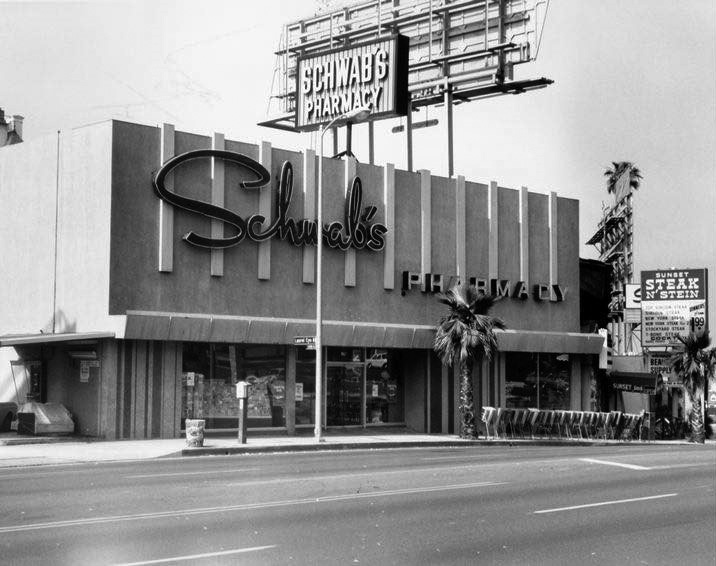 |
|
| (ca. 1960s)* – View showing Schwab's Pharmacy after it was completely rebuilt. Sunset Steak n’ Stein is on the right, where Googie’s used to be located. |
Historical Notes Over the years, Schwab’s became a popular local mini-chain, with locations at 6255 Hollywood Boulevard, 430 N. Roxbury Boulevard and 401 N. Bedford Drive. The Bedford Drive location, which had a special department and phone number reserved for the famous, was where Marilyn Monroe filled her prescriptions. One of her prescription bottles sold for $3,200 in 2014. |
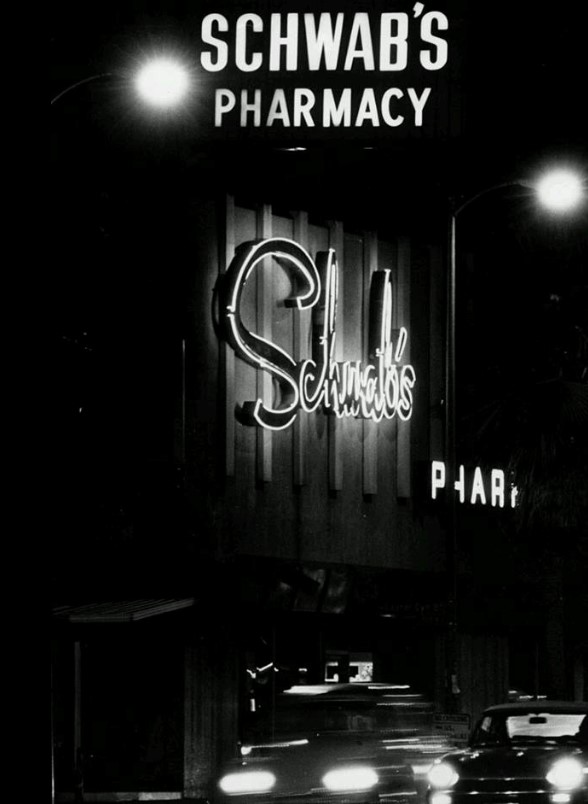 |
|
| (1980's)* - Nighttime view of Schwab's Pharmacy after it was enlarged and given a new facelift. |
Historical Notes Schwab's continued to be a popular hang-out well into the 1970s with luminaries like Cher, Linda Ronstadt and Diane Keaton frequenting the Hollywood hot spot. |
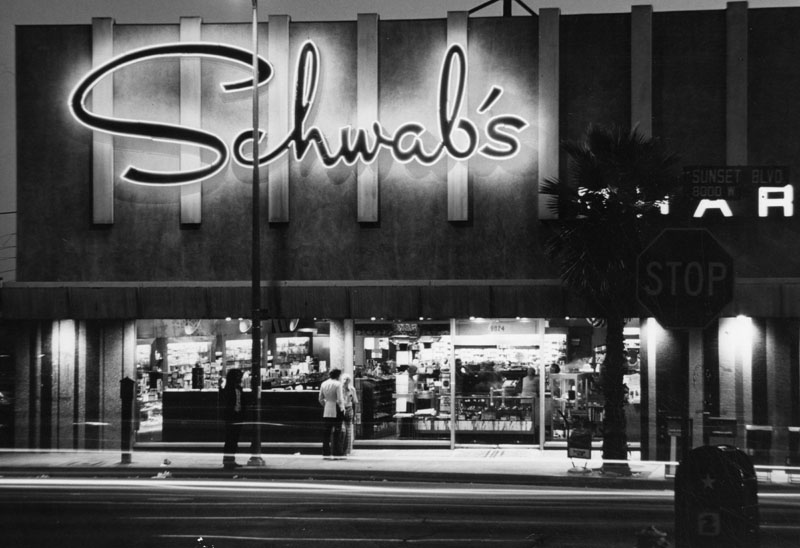 |
|
| (1980)* - Schwab's Pharmacy located at 8024 Sunset Boulevard, in West Hollywood. |
Historical Notes In the 1970s and early ’80s, a new set of celebrities began gracing the fountain with their presence, including Eric Estrada, Al Pacino, Sylvester Stallone, Goldie Hawn and Jerry Brown. In 1980, Jack Schwab passed away at age 75, and after five decades of service, the Schwab’s on Sunset Boulevard closed down. Leon Schwab stated that the closure was due to family reasons, but the truth was that the company was in financial distress. In 1983, everything that was not bolted down, from the stools and counters to the pharmacy’s famous Rolodex, was auctioned off to the highest bidder. The large red-and-blue neon sign that hung over the front door sold for $650.* It took the wrecking ball a couple of more years to knock down Schwab's, but in 1988 the building came down, making way for a large retail complex. |
* * * * * |
Googie's Coffee Shop
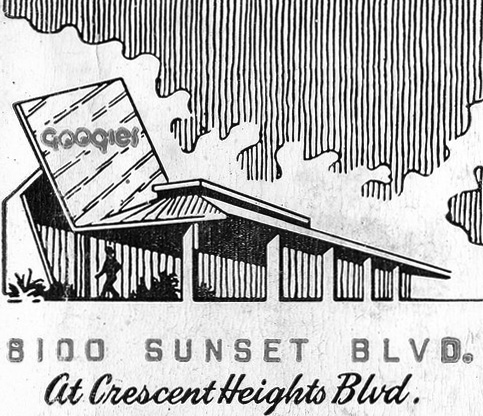 |
|
| (1950s)* - Matchbook cover image advertising Googie's Coffee Shop located at the SE corner of Sunset and Cresecent Heights boulevards. |
Historical Notes The origin of the name Googie dates to 1949, when architect John Lautner designed the West Hollywood coffee shop Googies, which had distinct architectural characteristics. The name "Googie" had been a family nickname of Lillian K. Burton, the wife of the original owner, Mortimer C. Burton. |
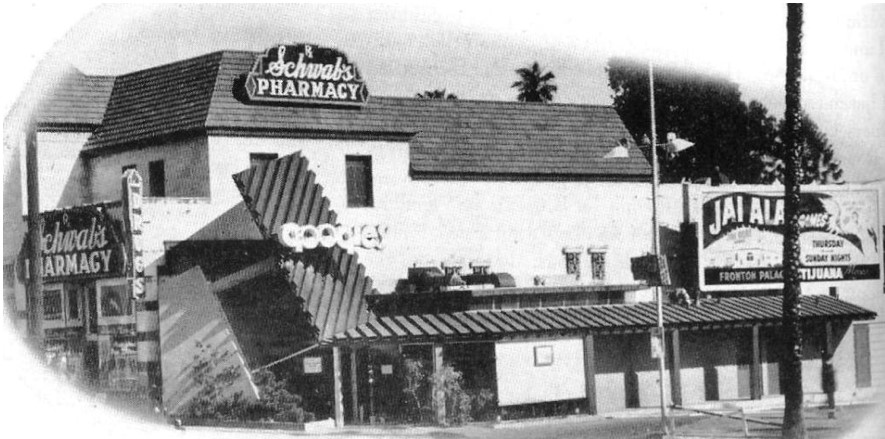 |
|
| (1950s)* - View showing Schwab’s Pharmacy and Googie’s Coffee Shop near the corner of Sunset Boulevard and Crescent Heights. Note the signboard on the right advertises the sport of Jai Alai at the Fronton Palace in Tijuana, Mexico. |
The Origins of Googie Architectrure Alan Hess, the author of Googie: Fifties Coffeeshop Architecture, traces Googie back to three Coffee Dan's restaurants designed by John Lautner in the early forties. "He selected the vaults and glass walls and trusses and angles of his buildings to fit the original, often unusual, concepts of space he favored," writes Hess. Lautner originated the style that would be refined and reinterpreted by many others. Unintentionally, he also gave the style a name when, in 1949, he designed Googie's Coffee Shop at the corner of Sunset Boulevard and Crescent Heights in Los Angeles. Professor Douglas Haskell of Yale was driving through Los Angeles when he and architectural photographer Julius Shulman came upon Googie's. "Stop the car!" Haskell yelled. "This is Googie architecture." While Haskell was dubious about the style, he made the name "Googie architecture" stick by using it in a 1952 article in House and Home magazine. |
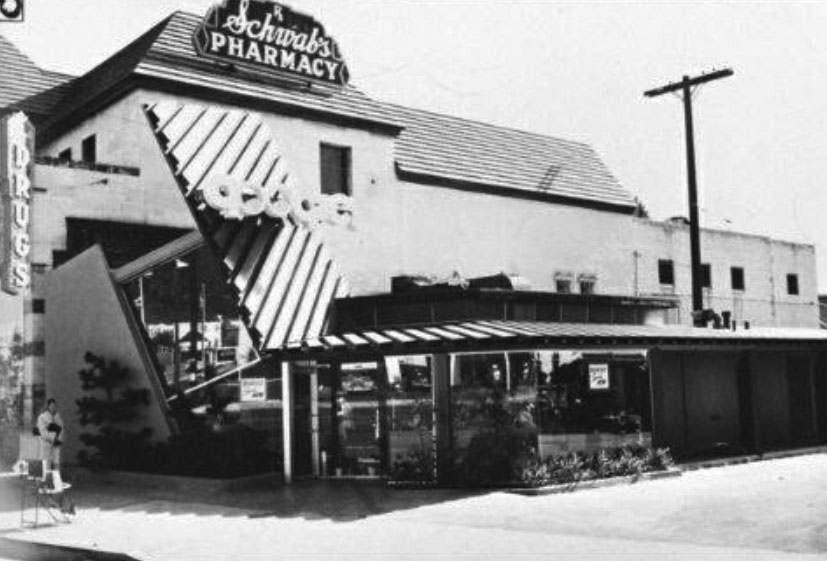 |
|
| (1952)* - Close-up view of Googie's Coffee shop and its neighbor Schwab’s Pharmacy located near the SE corner of Sunset and Crescent Heights. |
The Googie Look Although Googie buildings were often quite different from one another, Douglas Haskell noted that the style had certain rules: 1. It can look organic, but it must be abstract. "If it looks like a bird, it must be a geometric bird. It's better yet if the house had more than one theme: like an abstract mushroom surmounted by an abstract bird." 2. Ignore gravity altogether. "Whenever possible, the building must hang from the sky." 3. Multiple structural elements. Inclusion is the rule, rather than minimalism. New materials, including sheet glass, glass blocks, asbestos, plywood and plastic gave the architect a whole new palette to work with. Other innovations allowed steel and cement to be used in new ways. Suddenly, architects had more elbowroom for their dreams. A room made of plastic could look like a log cabin, a space ship, or almost anything. |
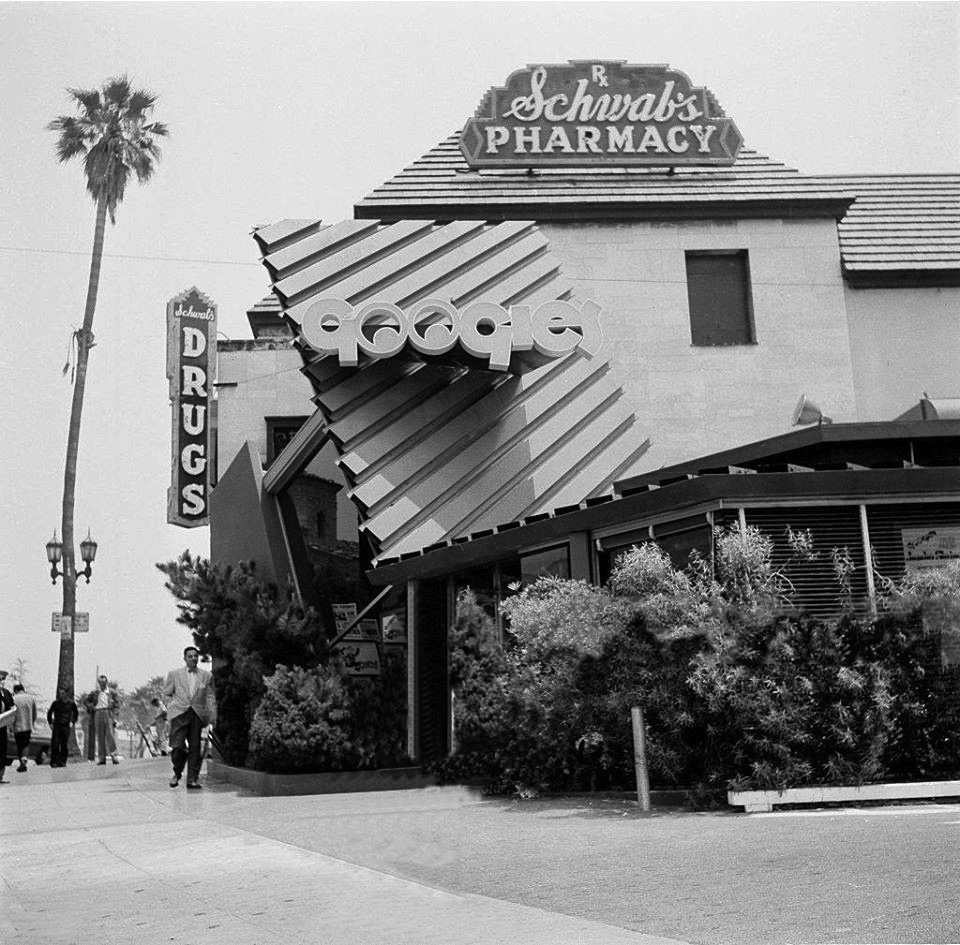 |
|
| (1954)^ – A man in a light sport coat and bow tie walks by Schwab’s Pharmacy and Googies Coffee Shop. Photo courtesy of Bruce Ablin |
Historical Notes Googie’s Coffee Shop was located next door to celebrated Schwab’s drug store, on the corner of Sunset and Crescent Heights Boulevards. It was all the rage among young, up and coming stars in 1950s Hollywood who went to table hop, not necessarily to eat. |
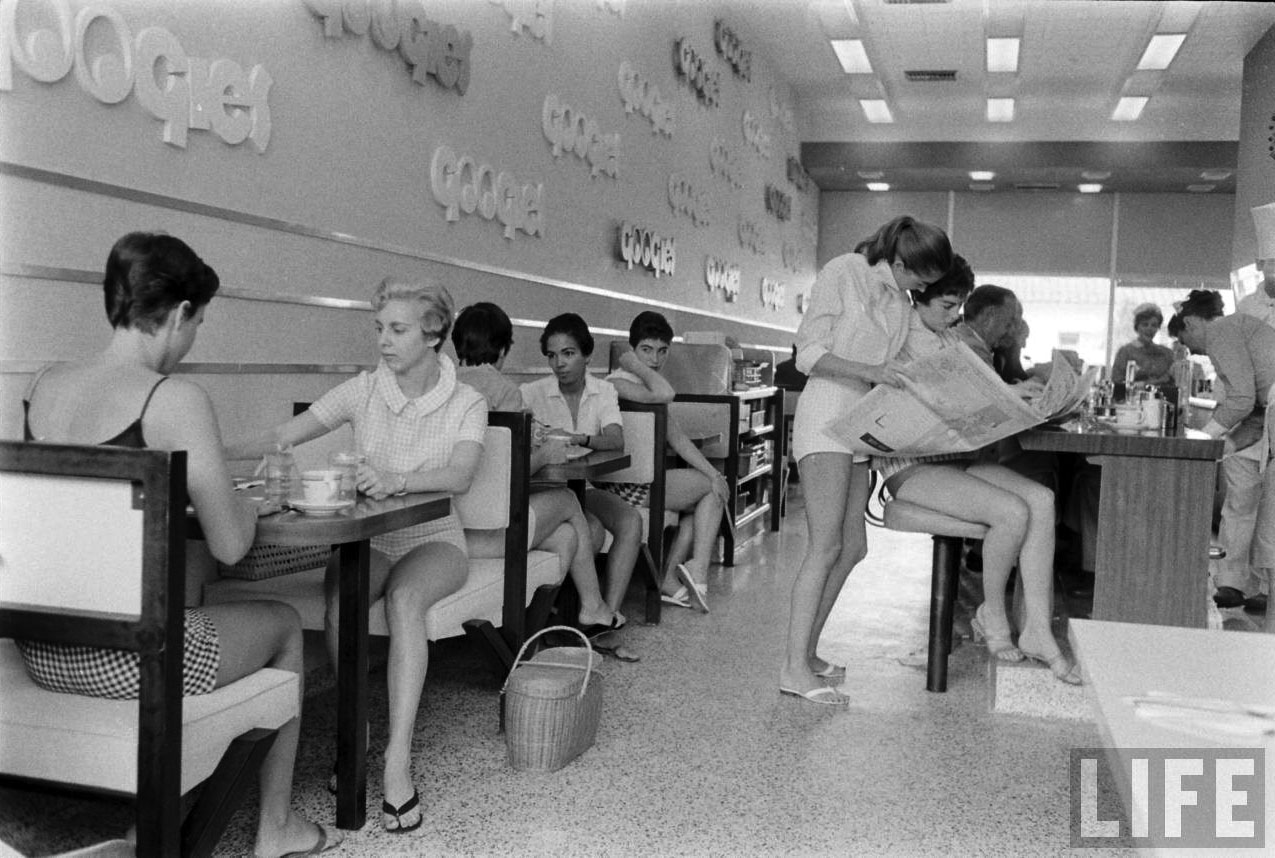 |
|
| (1950s)* - Interior view of Googie’s Coffee Shop whose quirky angles lent its name to a whole architectural style that became a distinctive addition to the Southern California landscape. Photo taken at the Googie’s located at 420 N Roxbury Drive, Beverly Hills, in the City National Bank building. Photo: Allan Grant, LIFE archives |
Historical Notes Googie captured the post-war high that made people feel that the future was now and they were living in it. As time passed, Googie came to reflect a very 1950s and ’60s view of what “the future” meant. |
 |
|
| (1950s)*- Shorts only at Googie's Coffee Shop. Photo taken at the Googie’s located at 420 N Roxbury Drive, Beverly Hills, in the City National Bank building. Photo: Allan Grant, LIFE archives |
Historical Notes Like most art forms that told a story or inspired with optimism, Googie went out of fashion in the mid-1960s. |
* * * * * |
Sunset and Crescent Heights
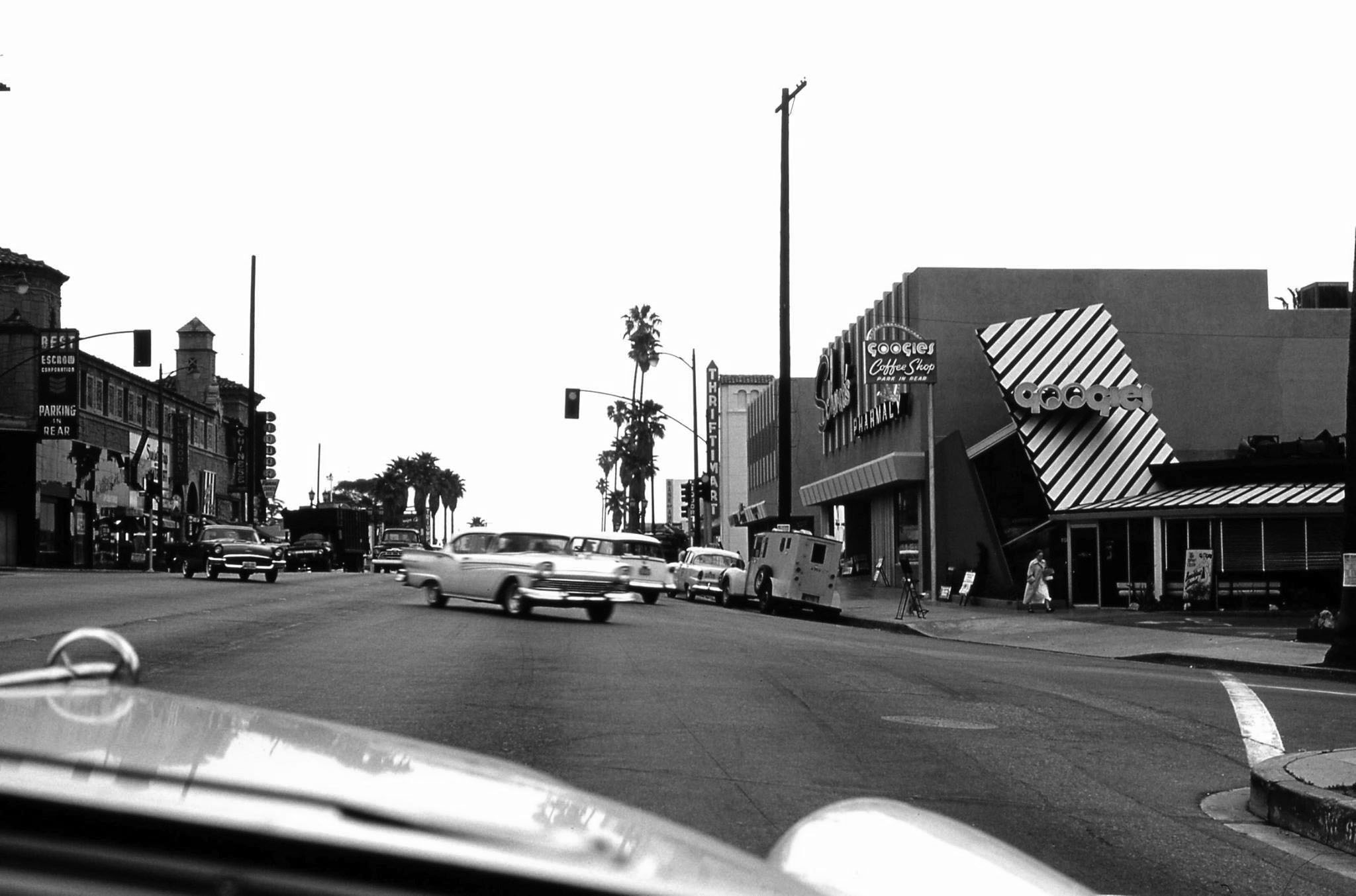 |
|
| (ca. 1957)* – View looking east on Sunset at Crescent Heights in West Hollywood as seen from the passenger seat of a long nose V8 bomb sight Buick. On the right is the original high style Googie's Coffee Shop and landmark Schwabs Drug Store. Photo courtesy of Kent Adamson and Richard Wojcik via Vintage Los Angeles |
Googie Architectrure In 1957, the intersection of Sunset and Crescent Heights boulevards was a lively Hollywood hotspot. The southeast corner featured Schwab's Pharmacy, a famed celebrity hangout, alongside Googie's Coffee Shop, John Lautner’s modernist landmark. Nearby, Crescent Heights Market and Pandora’s Box added to the area's eclectic charm. The mix of star-studded glamour, local commerce, and distinctive architecture—including possible remnants of the French Norman revival Sunset Medical Building—made this corner a quintessential snapshot of mid-century Tinseltown. |
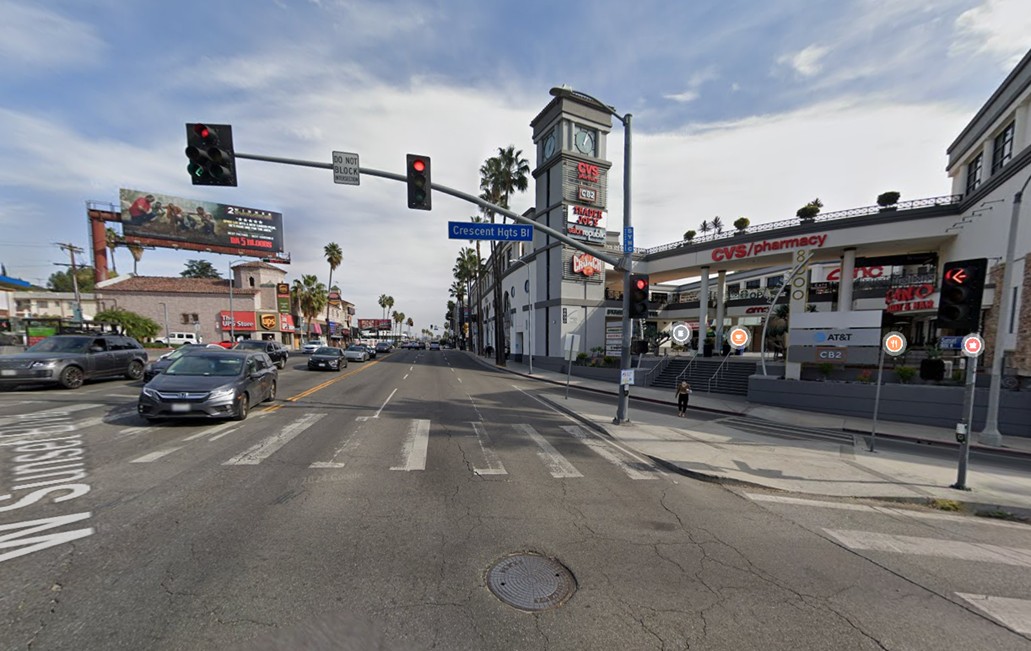 |
|
| (2021)* - Looking west on Sunset Boulevard at Crescent Heights Bouelvard with the 8000 Sunset Strip Shopping Center seenn on the southeast corner. |
Historical Notes The shopping center located at the southeast corner of Sunset Boulevard and Crescent Heights Boulevard is called 8000 Sunset Strip Shopping Center. It is a prominent retail and office complex in the West Hollywood area, featuring anchor tenants such as Trader Joe's, CVS, CB2, and Landmark Theatres. |
Then and Now
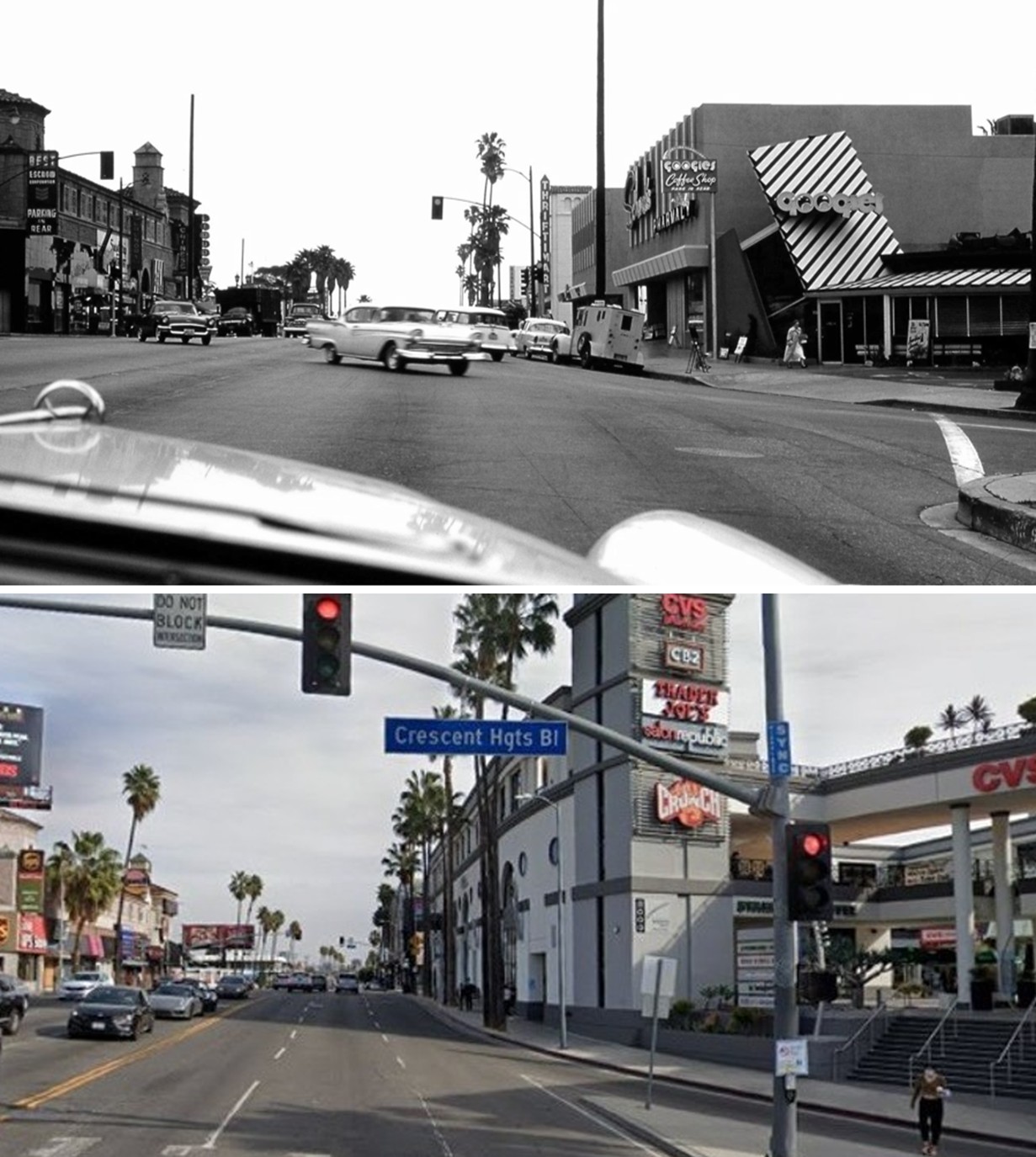 |
|
| (1957 vs 2021)* – A ‘Then and Now’ comparison looking east on Sunset Boulevard at Crescent Heights Boulevard. The southeast corner, once home to the iconic Googie's Coffee Shop and landmark Schwab’s Drug Store, is now occupied by the 8000 Sunset Strip Shopping Center. |
* * * * * |
West Hollywood
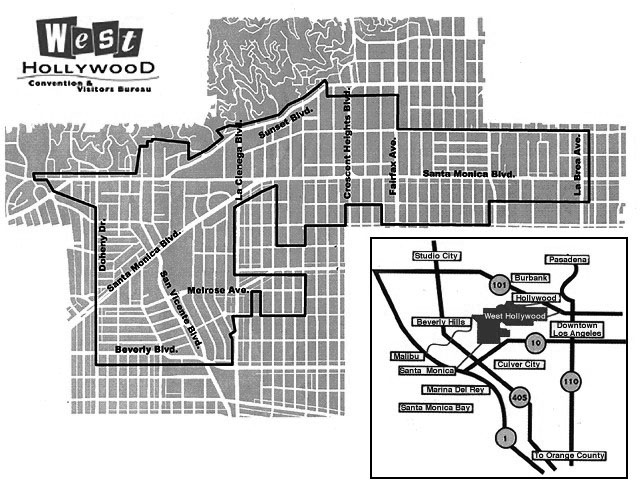 |
|
| (2016)* - Map of West Hollywood (WeHo). West Hollywood is bounded on the north by the Hollywood Hills neighborhood of Los Angeles, on the east by the Hollywood district of Los Angeles, on the southeast by the Fairfax district of Los Angeles, on the southwest by the district of Beverly Grove, and on the west by the city of Beverly Hills. |
Historical Notes West Hollywood, colloquially referred to as WeHo, was incorporated in 1984 and is home to the famous Sunset Strip. The irregular boundary of the town is featured in the city logo, and was largely formed from the unincorporated area that had not become part of the surrounding cities (Los Angeles and Beverly Hills). West Hollywood owes its existence to one of Southern California's first interurban electric railways, the Pasadena and Pacific. Assembled by Moses H. Sherman and his brother-in-law Eli P. Clark from failed and fragmentary predecessors, the Pasadena and Pacific connected the booming city of Los Angeles with the beach town of Santa Monica. Along the way, it crossed a sprawling coastal plain dotted with marshes, tar pits, and citrus groves. Today's Santa Monica Boulevard traces the railway's route across what was then called the Cahuenga Valley. |
* * * * * |
Early West Hollywood (Town of "Sherman")
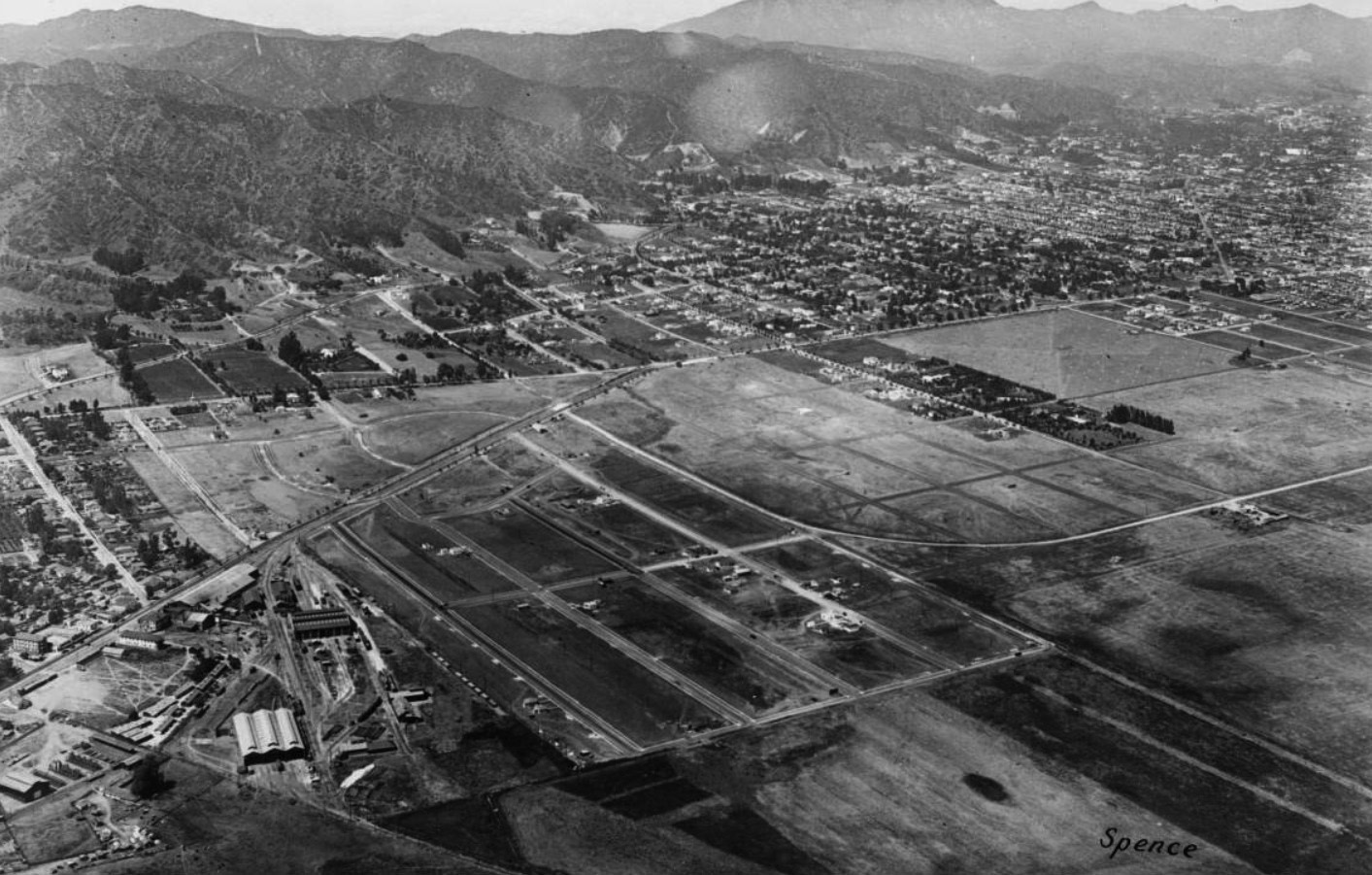 |
|
| (1922)* – Aerial view of Sherman (later West Hollywood) looking northeast with Santa Monica Boulevard running diagonally from lower-left to center, past La Cienega Boulevard, where it turns east and heads toward Hollywood (at the time Colegrove). The original settlement of Sherman is visible along the left edge of the photo, next to the rail yard. |
Historical Notes During the final decade years of the nineteenth century, the first large land development in what would later become West Hollywood—the town of "Sherman"—was established by Moses Sherman and his partners of the Los Angeles Pacific Railroad, an interurban railroad line which later became part of the Pacific Electric Railway system. Sherman became the location of the railroad's main shops, railroad yards, and "car barns". Many working-class employees of the railroad settled in this town. It was during this time that the city began to earn its reputation as a loosely regulated, liquor-friendly (during Prohibition) place for eccentric people wary of government interference. For years, farms and open fields separated the town of Sherman from the neighboring communities of Colegrove and Hollywood (an independent city from 1903 to 1910). Though connected by the tracks of the Pasadena and Pacific—later bounded on each side by paved roadways for motor cars and named Santa Monica Boulevard—it was not until the early 1920s that the growing Los Angeles metropolis met the street grid of Sherman. |
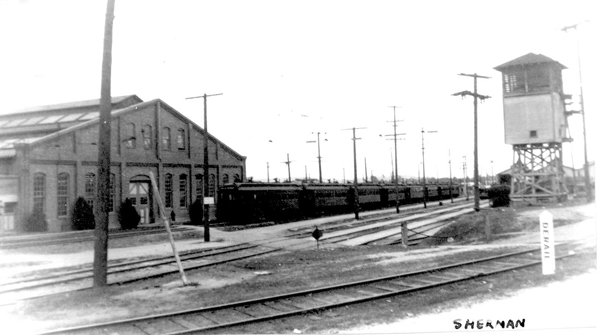 |
|
| (n.d.)* - View of the Pacific Electric's Sherman rail yard, current location of the Pacific Design Center. |
Historical Notes In 1896, Sherman and Clark built a rail yard and power plant at roughly the midpoint between Los Angeles and Santa Monica, where today's Santa Monica and San Vicente boulevards intersect. |
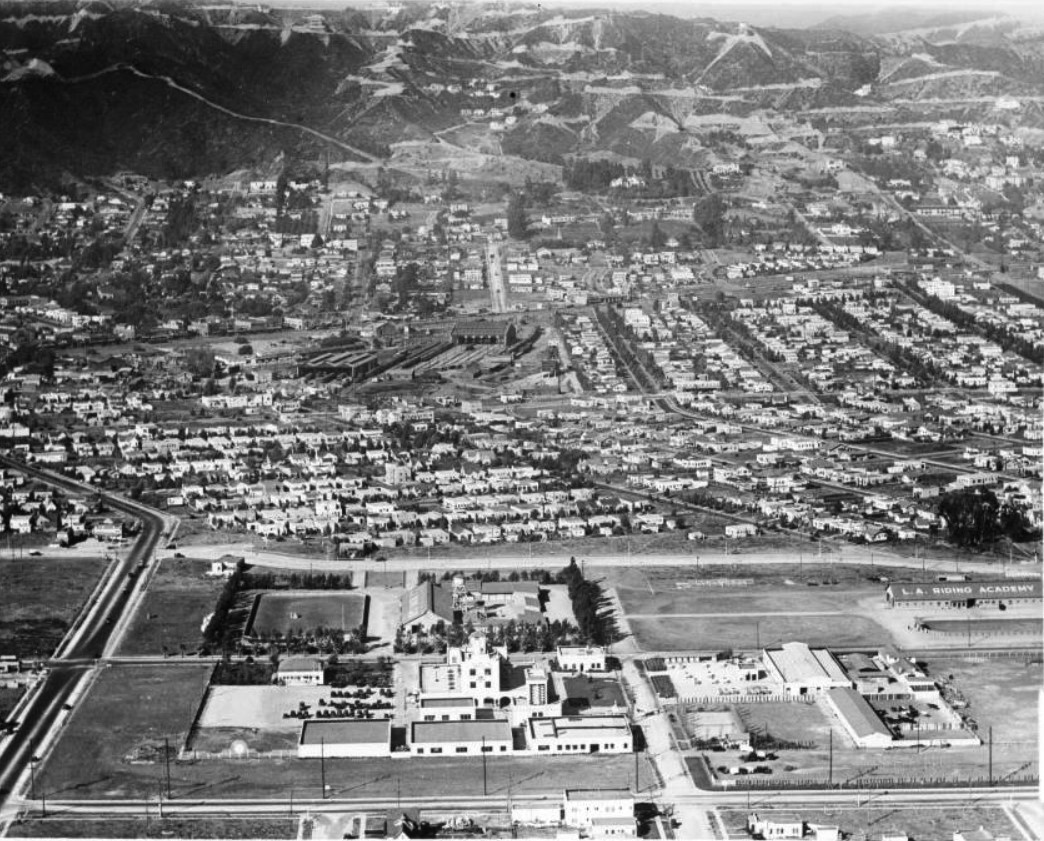 |
|
| (ca. 1928)* – Aerial view looking north showing West Hollywood (Sherman until 1925) with the Hollywood Hills seen in the background. What would become Beverly Boulevard runs horizontally at center of photo and Third Street is at bottom. Robertson Boulevard runs away from camera at left and dog legs up toward Santa Monica Boulevard. The Sherman train yard (upper center-left) sits near the intersection of San Vicente and Santa Monica boulevards. In the foreground is a large dirt arena and a stable housing the Los Angeles Riding Academy which is on property now occupied by Cedars-Sinai Medical Center. |
Historical Notes For many years, the area that is now the city of West Hollywood was an unincorporated area in the midst of Los Angeles. Because gambling was illegal in the city of Los Angeles, but still legal in Los Angeles County, the 1920s saw the proliferation of many casinos, night clubs, etc., along Sunset Boulevard (which starts in downtown Los Angeles and runs westward). These businesses were immune from the sometimes heavy-handed law-enforcement of the L.A. Police Department. In 1925, In a controversial decision, Sherman adopted "West Hollywood", "...a moniker pioneered earlier in the decade by the West Hollywood Realty Board" as its informal name, though it remained under the governance of Los Angeles County. |
 |
|
| (ca. 1931)* - Aerial view of West Hollywood looking northeast. The wide street running from lower-left to upper-right is Santa Monica Boulevard. In the right-center is the Sherman train yard where the Pacific Design Center stands today. |
Historical Notes Beginning in 1922, Sherman's population boomed. As the town's development began to merge with that of Hollywood, by then a part of the City of Los Angeles, some in both Sherman and the metropolis began speaking of annexation. Los Angeles promptly annexed several large but mostly vacant tracts surrounding Sherman; the 1,203-acre Fairfax district became part of Los Angeles with the unanimous approval of its 16 residents, and a 7-0 vote joined the 430-acre Melrose district with L.A. L.A. easily incorporated these vast tracts into its city limits without contention, but Sherman was an established community with an independent identity, and the issue of annexation divided Sherman's population and business interests. Realtors supported it, arguing that future development depended on access to Los Angeles' sewer and fire protection services. Sherman's Board of Trade and Chamber of Commerce opposed joining the city, however, fearful of increased property taxes. Ultimately the anti-annexationist forces prevailed. Instead of relying on L.A.'s utility connections and public services, Sherman financed construction of its own sewer system and relied upon the county for police and fire protection services. |
* * * * * |
Santa Monica Boulevard
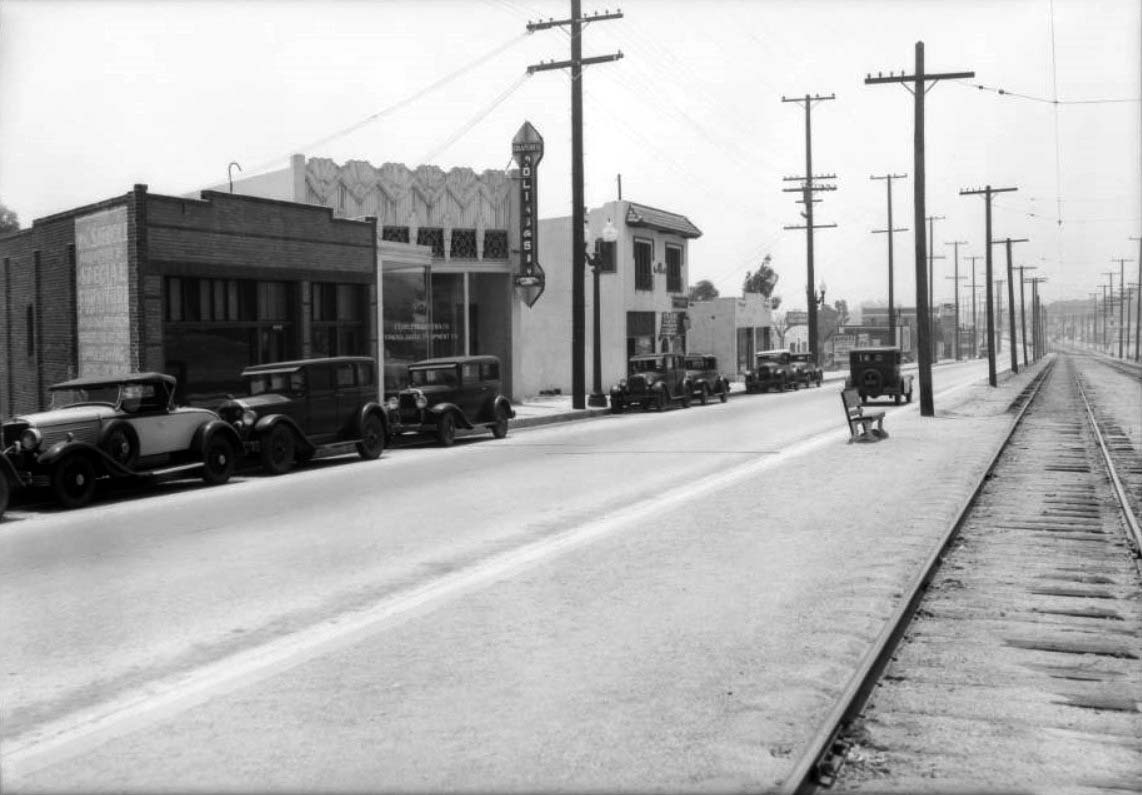 |
|
| (ca. 1933)* - View looking southwest on the 8500 block of Santa Monica Boulevard, between San Vicente and La Cienega boulevards, in West Hollywood. Railroad tracks run down the center of the street. |
Historical Notes The tracks running down the center of Santa Monica Boulevard became part of the Pacific Electric Railway in 1911 and carried red cars until 1954. They then remained largely unused for decades, serving the occasional Southern Pacific freight train through the 1970s. It was not until 1999 that the West Hollywood segment of the tracks were dug up and replaced by a landscaped median. Click HERE to see same view in 2016. |
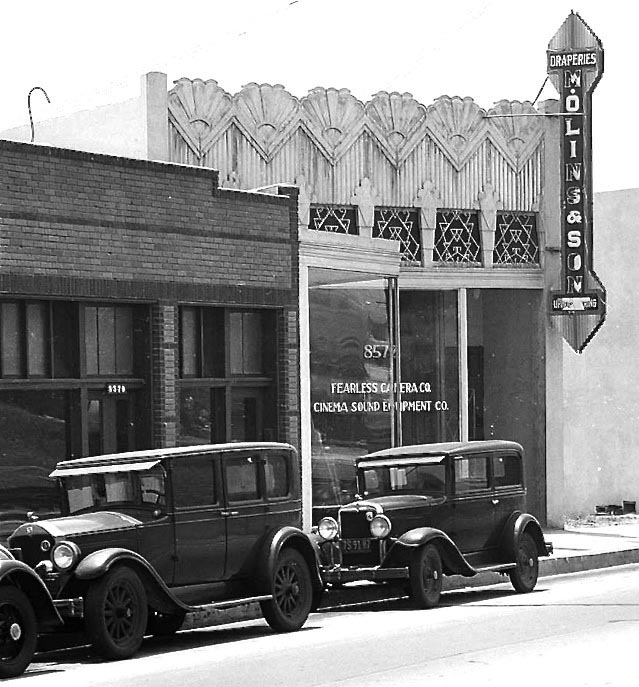 |
|
| (1933)* - Blow-up view of previous photo showing the Art Deco building at 8572 Santa Monica Boulevard with large sign reading: Molins & Son Draperies. Tenant also includes Fearless Camera Co. & Cinema Sound Co. |
* * * * * |
Santa Monica Blvd and Wesbourne Drive
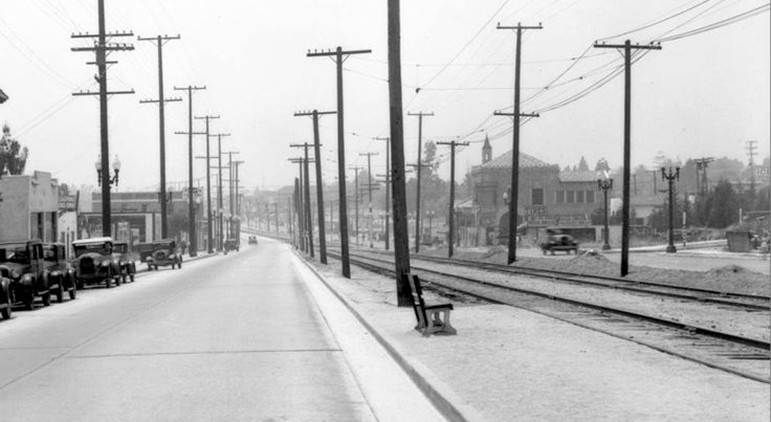 |
|
| (1933)* - View looking west on Santa Monica Boulevard toward Westbourne Drive. The building on the northwest corner (center-right) still stands. |
Historical Notes The transformation of Santa Monica Boulevard in West Hollywood involved a significant reconstruction project that took place from 1999 to 2001. This initiative was part of the city's efforts to revitalize the area after West Hollywood's incorporation in 1984. The project included the removal of 15,000 feet of abandoned Red Car tracks and 5,000 wooden ties from the median, which were remnants of the old rail system. The roadbed was completely replaced, and the area was enhanced with the planting of 1,200 new trees. Additionally, new medians and crosswalks were installed, and sidewalks were widened to create a more pedestrian-friendly environment. Upon completion in 2001, Santa Monica Boulevard was transformed into a beautifully landscaped urban thoroughfare, significantly improving its aesthetic appeal and functionality for both residents and visitors. |
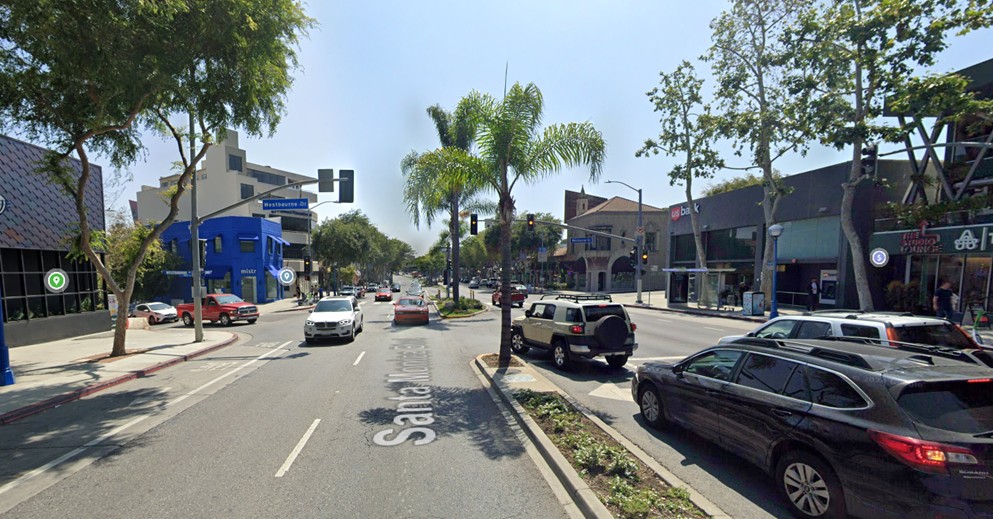 |
|
| (2024)* - View looking west on Santa Monica Boulevard toward Westbourne Drive. |
Then and Now
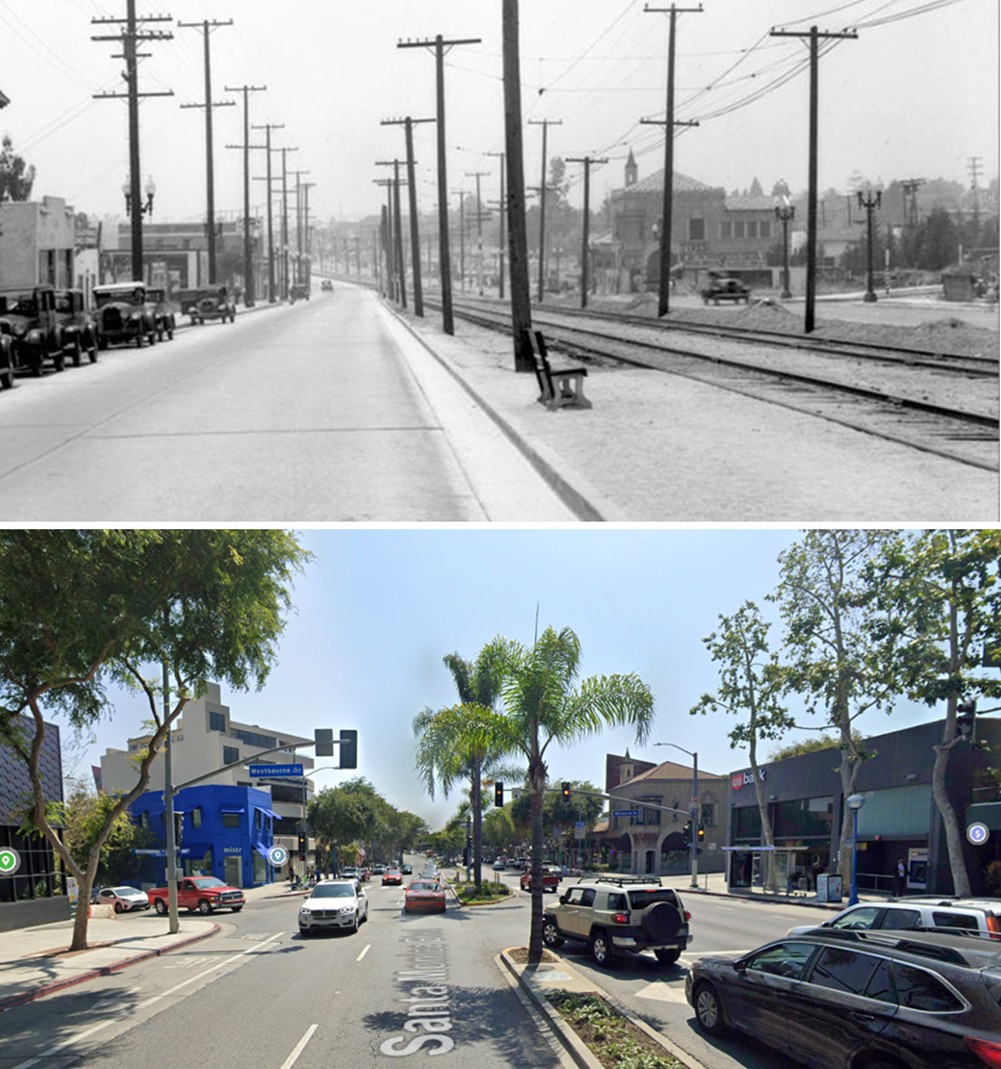 |
|
| (1933 vs. 2024)* – A ‘Then and Now’ comparison of Santa Monica Boulevard looking west toward Westbourne Drive in West Hollywood. The overhead power poles are gone, the streetcar tracks have been replaced by a landscaped center median, and the building on the northwest corner remains one of the few still standing. Photo comparison by Jack Feldman. |
Historical Notes The building on the NW corner of Santa Monica and Westbourne Drive (8701 Santa Monica Blvd) has some interesting arhitecutral features and history. Click HERE to see more. |
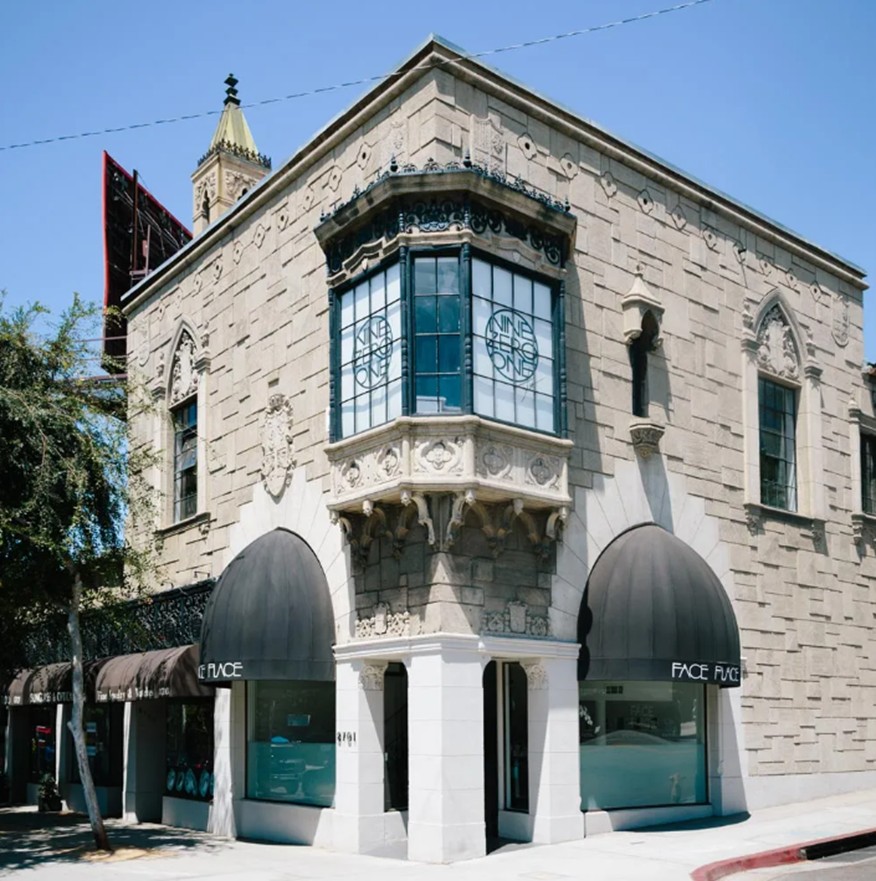 |
|
| (ca. 2024)* – Building on the northwest corner of Santa Monica Boulevard and Westbourne Drive. Photo by Tony Coelho. |
Historical Notes Located at 8701 Santa Monica Boulevard, this Spanish Gothic Revival-style building, designed by Morgan, Wall, and Clements, features a distinctive square tower with a hipped roof at its southeast corner. A small turret extends from the western facade, and the red clay tile roofs include decorative wrought iron brackets. The stucco-covered concrete exterior mimics rough stone blocks. Built in 1928, the structure stood at the eastern edge of West Hollywood’s growing business district as Santa Monica Boulevard expanded, connecting the area more closely to Hollywood. |
* * * * * |
Santa Monica and La Brea
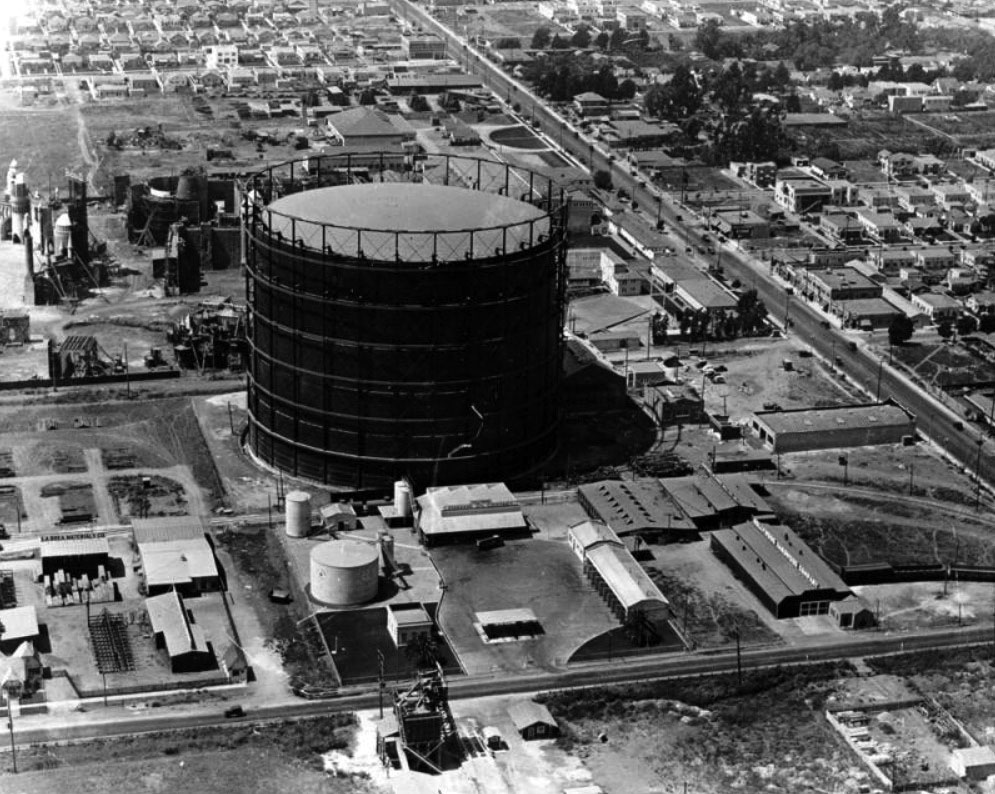 |
|
| (1920s)* – Aerial view looking West showing a “Gasometer” (Gas Storage Tank) located near the intersection of Formosa Ave and Romaine Street. La Brea runs across the bottom of photo. Santa Monica Boulevard runs diagonally from right-center to top center. Picford-Fairfanks Stuidos can be seen on the other side of Formosa Ave behind the tank. The SE corner of Formosa and Santa Monica Blvd (center-right) is where the iconic Formosa Cafe would be built. |
Historical Notes The huge tank seen above was installed by LA Gas and Electric Company which later evolved into Southern California Gas Company. These large tanks were known as "gas holders" (aka gasometers), and helped supply natural gas to the city. They rose or sank in height depending on the amount of gas being stored. |
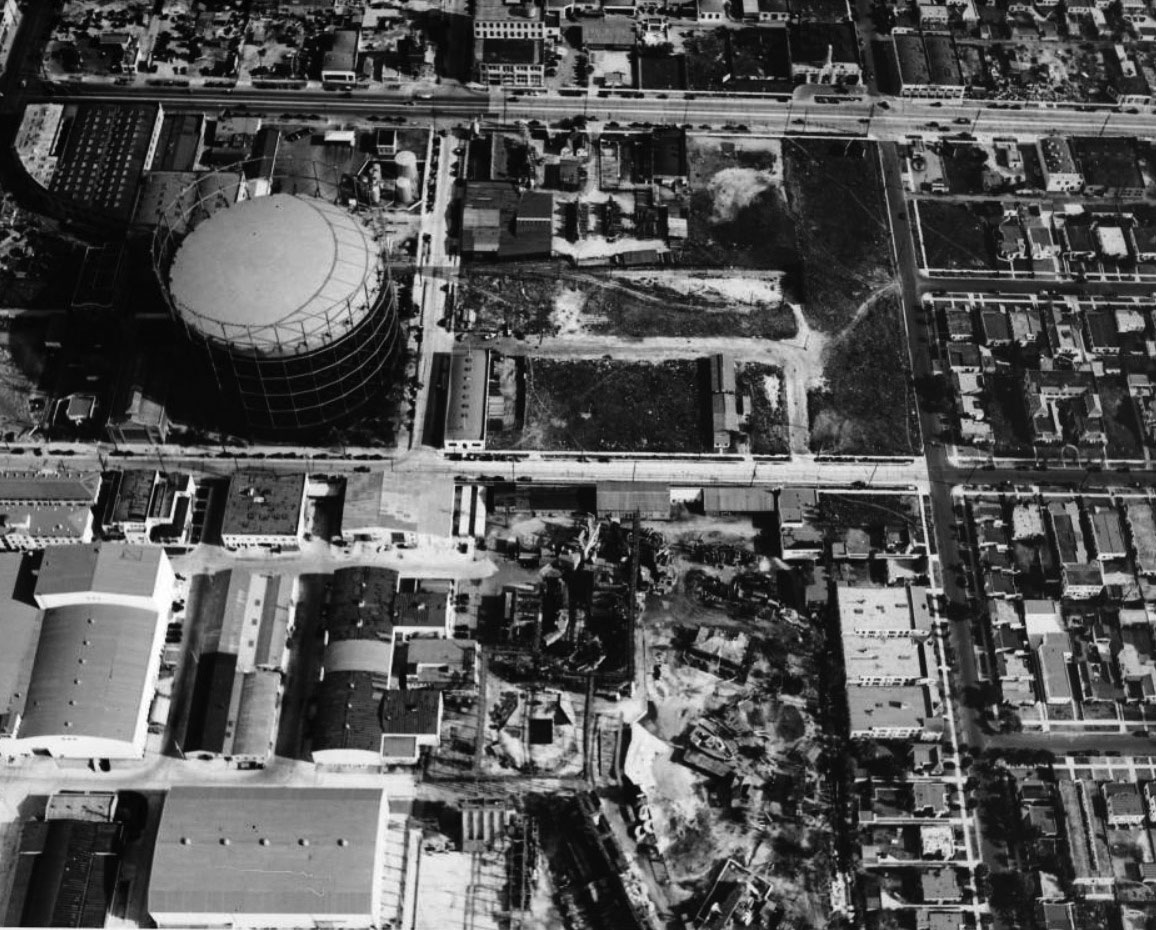 |
|
| (1937)* - Aerial view looking east, showing the same Gasometer at the southeast corner of Formosa Avenue and Romaine Street, with United Artists Studios visible in the foreground.Santa Monica Boulevard is on the left (out of view). The Formosa Cafe would be built to the north of the Gas Tank on the SE corner of Formosa and Santa Monica Blvd. |
Historical Notes The above Gasometer was dismantled in the mid-1970s. Click HERE to see more in Gasometers of Early Los Angeles. |
 |
|
| (1926)*# - View of the Pickford-Fairbanks Studios lot on Santa Monica Boulevard in West Hollywood, showing the nearby Gasometer towering in the background. |
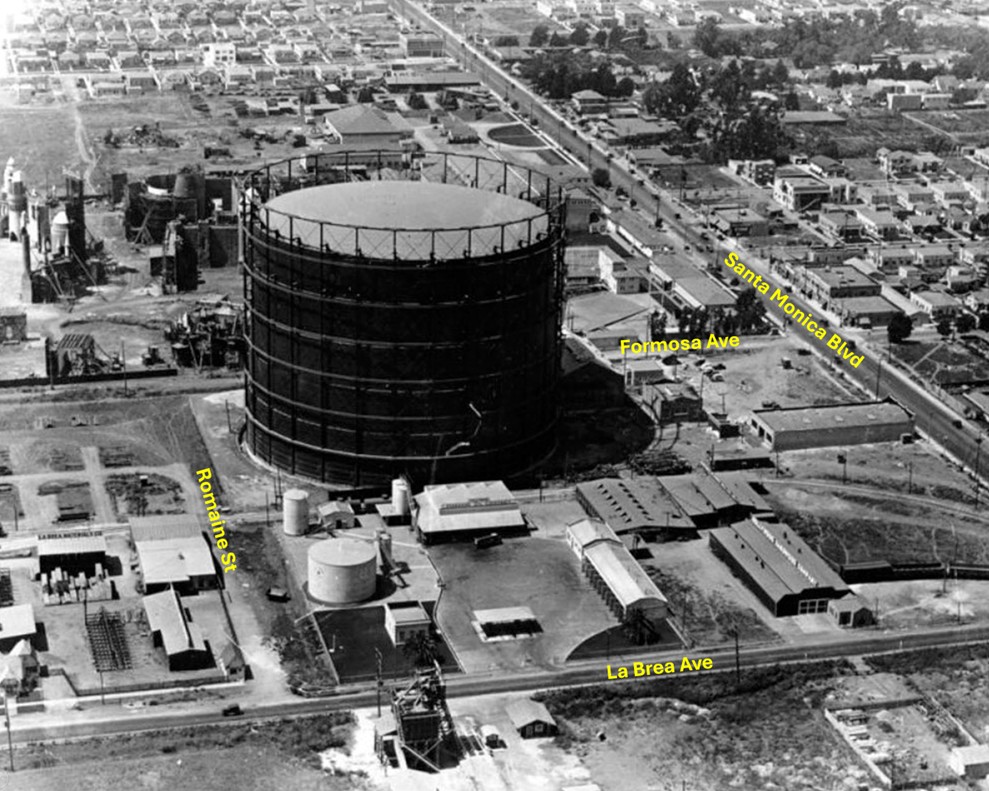 |
|
| (1920s)* – Aerial view looking West showing a “Gasometer” (Gas Storage Tank) located near the intersection of Formosa Ave and Romaine Street. La Brea runs across the bottom of photo. Santa Monica Boulevard runs diagonally from right-center to top center. Picford-Fairfanks Stuidos can be seen on the other side of Formosa Ave behind the tank. The SE corner of Formosa and Santa Monica Blvd (center-right) is where the iconic Formosa Cafe would be built. Annotated by Jack Feldman. |
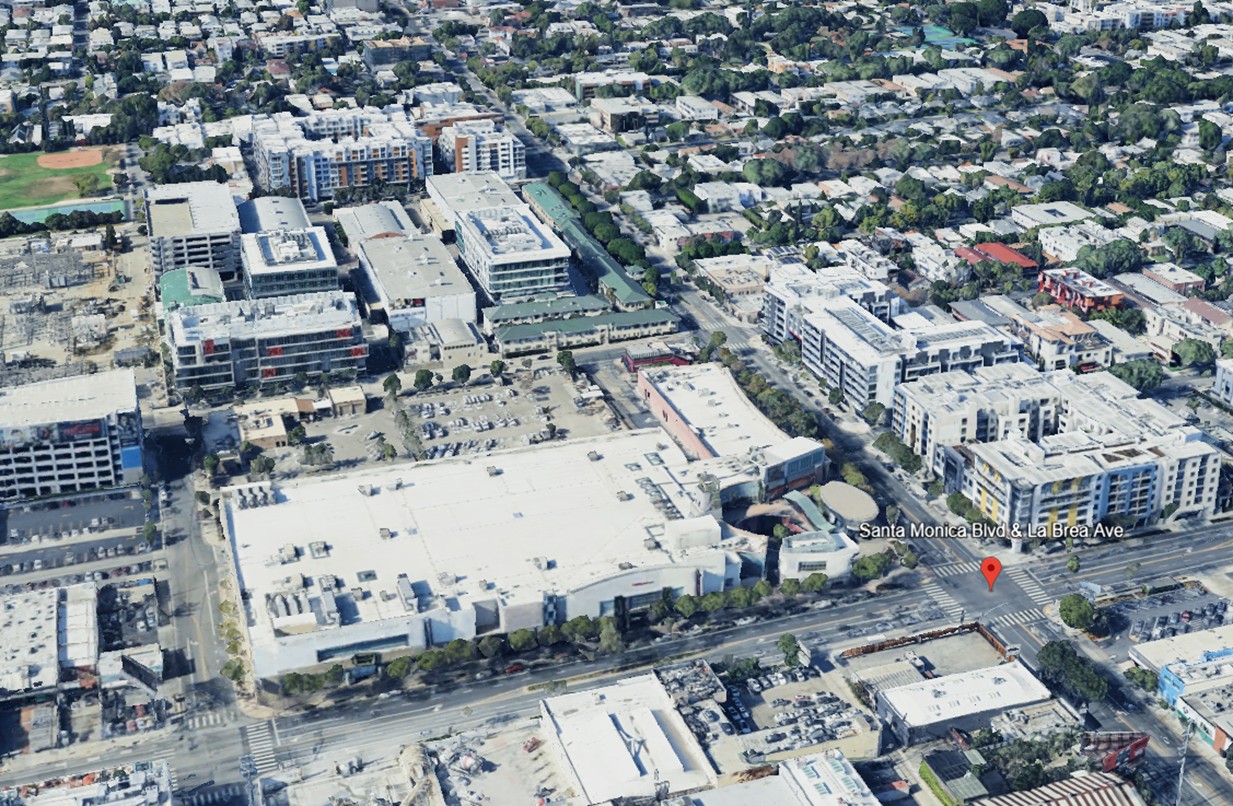 |
|
| (2023)* – Google Earth view looking west toward the area near the intersection of Formosa Avenue and Romaine Street, where the early Gasometer once stood. |
Then and Now
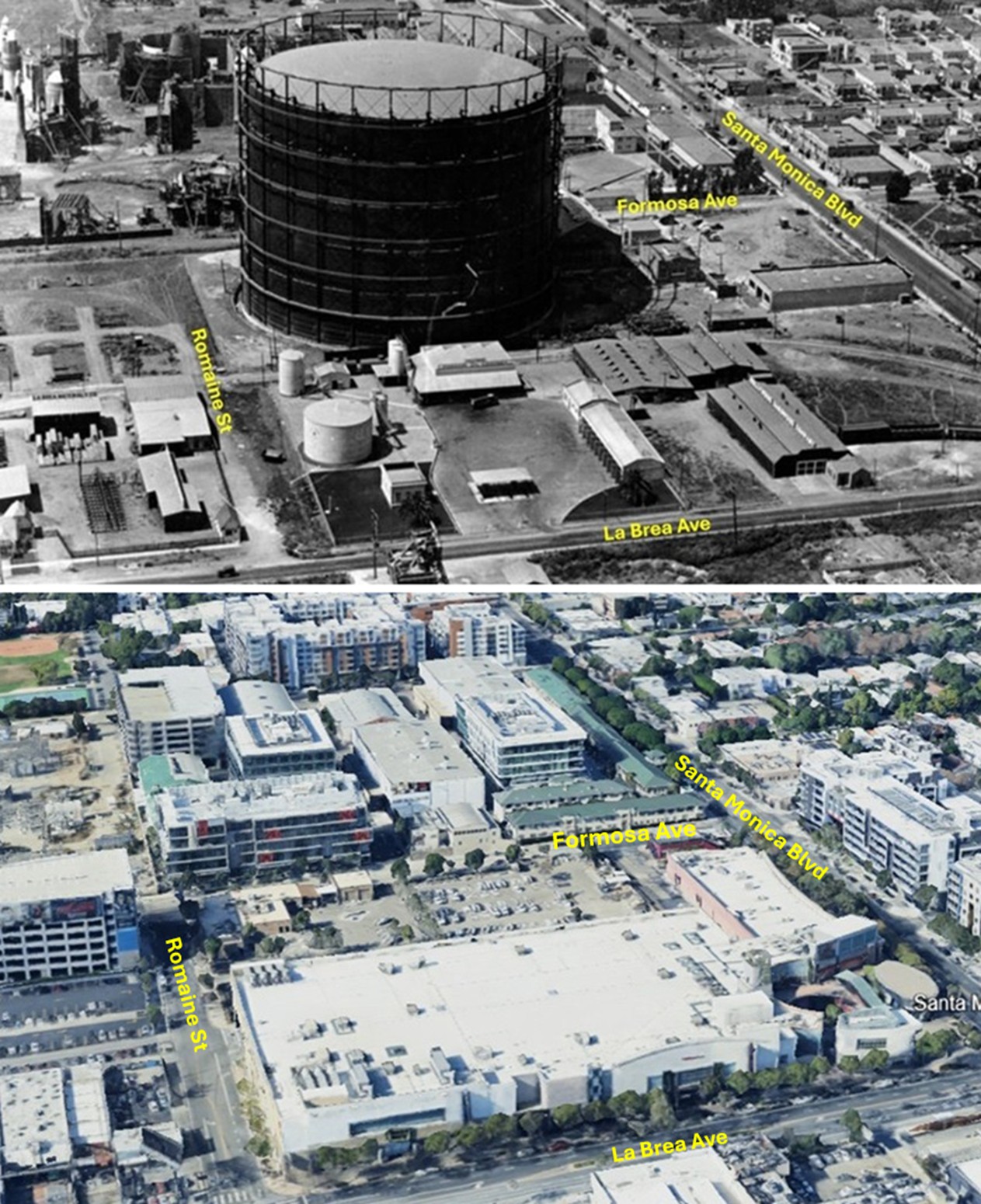 |
|
| (1920s vs. 2023)* – A ‘Then and Now’ aerial comparison looking west toward the southeast corner of Formosa Avenue and Romaine Street, where a Gasometer once stood. Today, a Southern California Gas Company facility occupies the site of the former gas tank, and to the east, the large building in the foreground is the West Hollywood Gateway shopping center, which fronts La Brea Avenue. Photo comparison by Jack Feldman. |
Historical Notes By the early 1970s, Gasometers were no longer needed as new pipelines from the gas fields of West Texas could meet all demands. Their removal was a great relief to fire officials, who had long worried about the potential disaster these tanks posed. |
* * * * * |
Pickford-Fairbanks Studios (later United Artists, Samuel Goldwyn, Warner Brothers, and "The Lot"
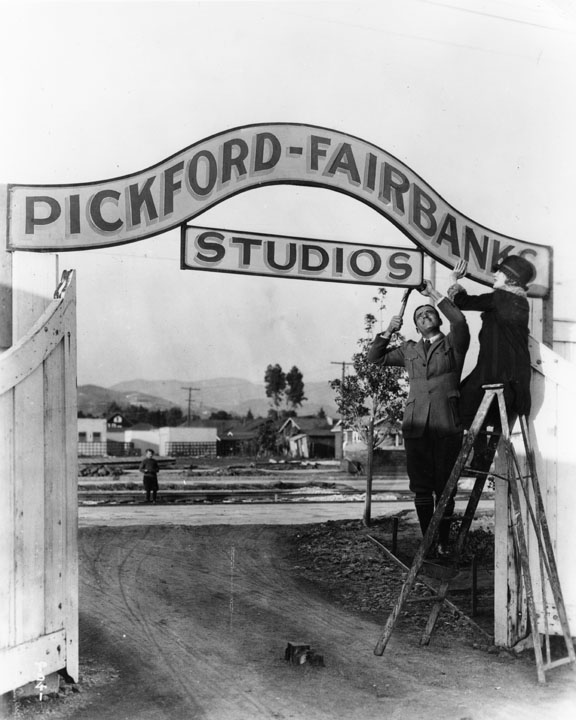 |
|
| (1922)^ - Mary Pickford and Douglas Fairbanks hang the entrance signs for their Pickford-Fairbanks Studios near the corner of Santa Monica Boulevard and Formosa Avenue in West Hollywood. |
Historical Notes When United Artists was formed in 1919 by Charlie Chaplin, Mary Pickford, Douglas Fairbanks, and D. W. Griffith, the founders never intended the company to be like a regular Hollywood studio. It started solely as a distribution company. Its mission was to release films made by independent producers, therefore it had no studio lot. However, many of the independent producers owned their own property, like the Charlie Chaplin Studio on Sunset Boulevard. The closest thing to a studio lot was the property owned by Pickford and Fairbanks on the corner of Santa Monica Boulevard and Formosa Avenue in Hollywood. The studio lot's address is now 1041 North Formosa Avenue. |
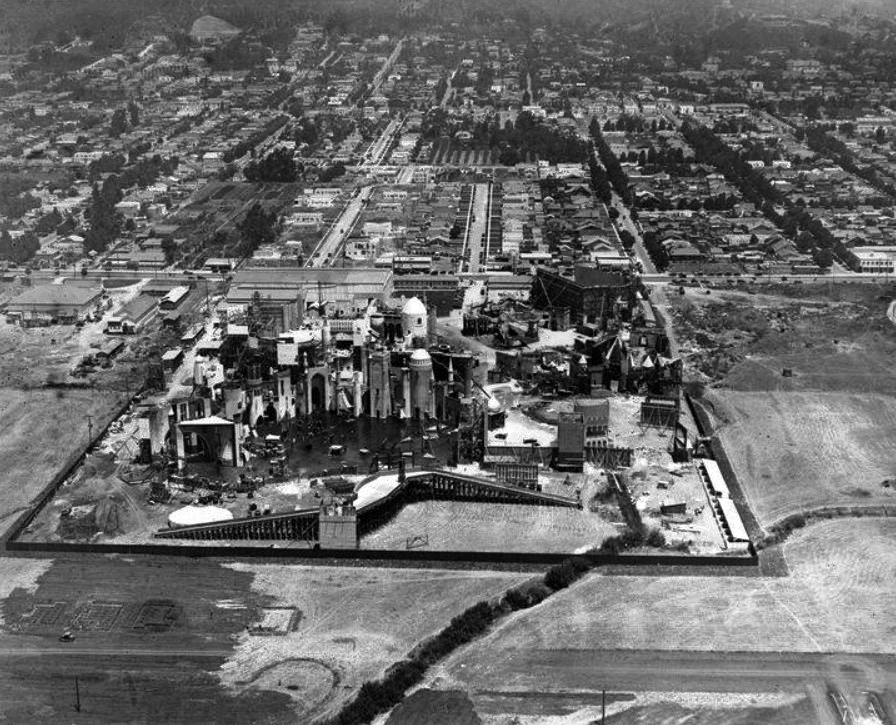 |
|
| (1923)* - Aerial view of the Pickford-Fairbanks Studios located at the corner Santa Monica Boulevard and Formosa Avenue, showing the amazing set for Douglas Fairbanks’ “Thief of Bagdad”. Note all the open land surrounding the studio. |
Historical Notes The 18-acre property on the corner of Santa Monica Boulevard and Formosa Avenue was originally owned by Jesse Durham Hampton, and then became known as the Pickford-Fairbanks Studio. As United Artists began to lure independent producers away from the major studios, many of the producers like Samuel Goldwyn and Joseph Schenck rented offices and stages on the property. In the early 1920s, the lot was renamed the United Artists Studio, though it was operated as a separate entity from United Artists the distribution company.* |
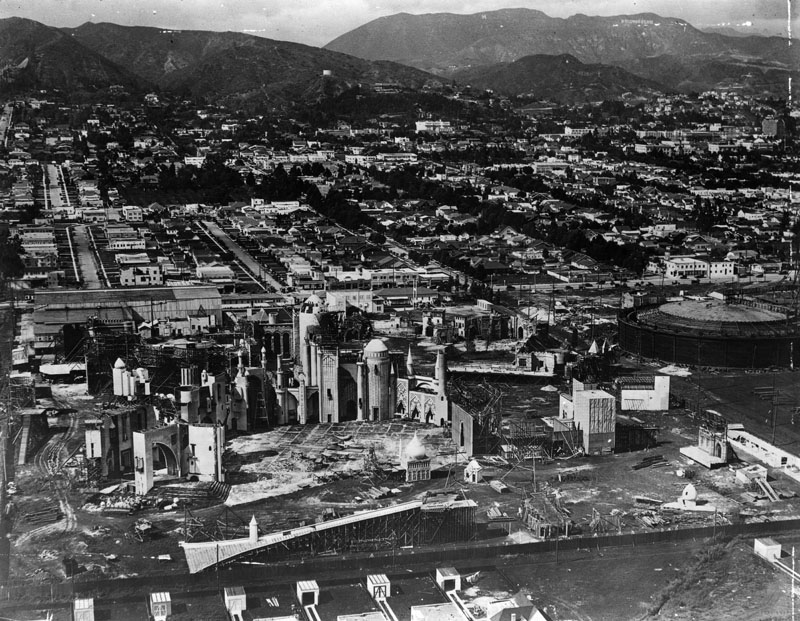 |
|
| (ca. 1924)* - Aerial view of the Thief of Bagdad set at the Pickford-Fairbanks Studios. The Studio was located at Santa Monica Blvd. and Formosa. The Hollywoodland Sign is seen in the distance (upper-right). Note the large circular structure at center-right. It is a gas holder (or Gasometer) which holds natural gas. |
Historical Notes Goldwyn and Schenck financed the expansion of the studio, creating an awkward ownership structure. Pickford and Fairbanks controlled the deed to the land, but Goldwyn and Schenck owned the actual facilities on the lot. In 1935 when Scheck left United Artists, Goldwyn took over his share. |
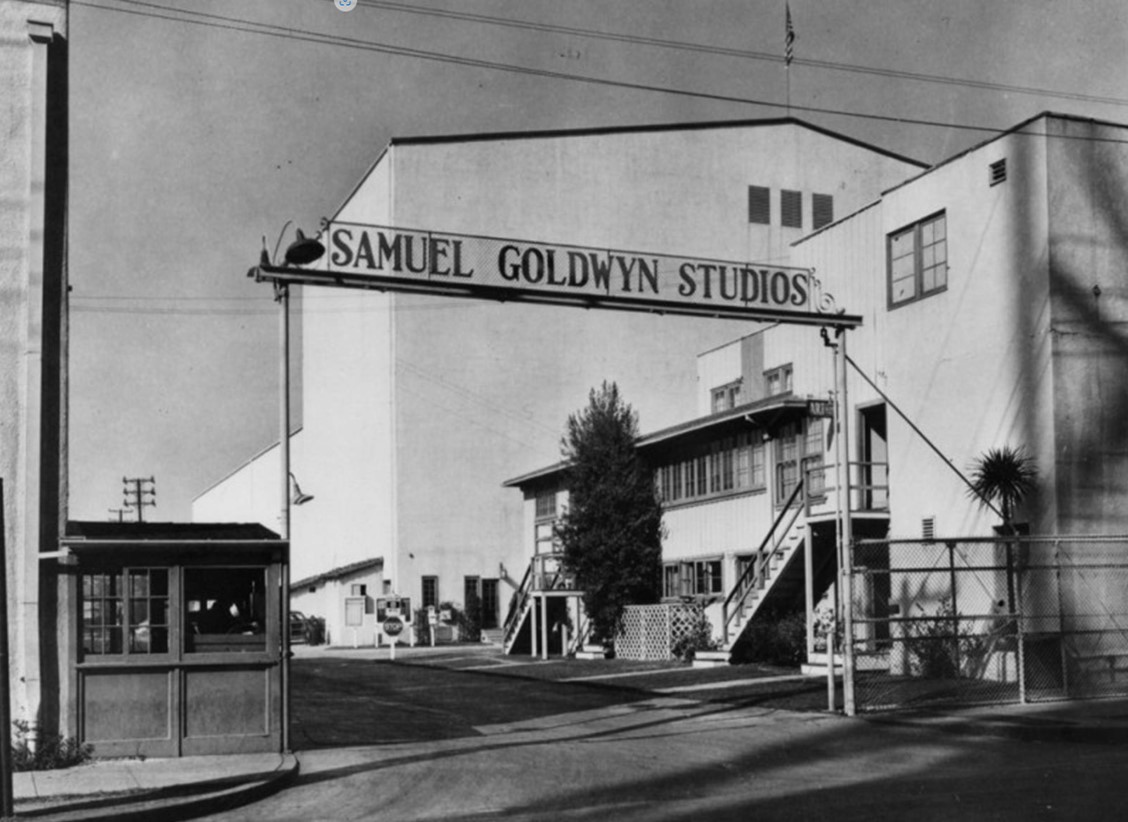 |
|
| (1948)* - The entrance to the Samuel Goldwyn Studios, located at 1041 North Formosa Avenue in Hollywood (previously Pickford-Fairbanks Studio). |
Historical Notes After Douglas Fairbanks died in 1939, leaving his share of the deed to Mary Pickford, Goldwyn sought to rename the lot "Samuel Goldwyn Studio." Pickford and Goldwyn fought over the name and ownership of the property until a court ordered that the lot be auctioned in 1955. James Mulvey, Goldwyn's most trusted business confidant and president of Samuel Goldwyn Inc., outbid Pickford for the property. The lot officially became Samuel Goldwyn Studio and remained so until Warner Brothers purchased the site in 1980.^ Warner Bros. sold the studio lot in 1999 and the name of this studio lot was changed to "The Lot." Across the street is the Formosa Cafe, a legendary Hollywood hangout. |
* * * * * |
Richfield Service Station - West Hollywood
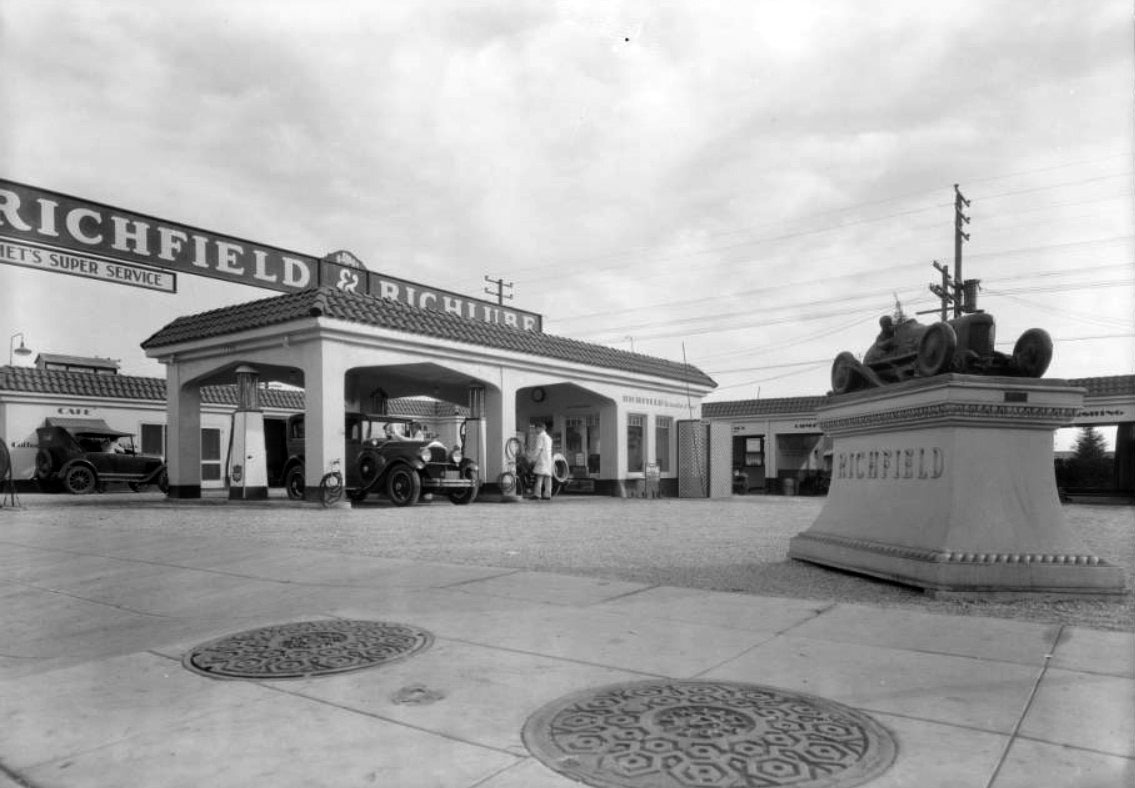 |
|
| (1929)^^ – Richfield Service Station at 7786 Santa Monica Boulevard, West Hollywood (2 blocks East of Fairfax). Note the pedestal-mounted racecar on the right. |
Historical Notes Gas Stations used to be called service stations ... they would rush to your car, check the water and oil, put air in your tires, wash your windows, and pump your gas. Click HERE to see more Early Views of LA Gas Stations. |
.jpg) |
|
| (1929)^^ - Closer view showing the pumps at the Richfield Service Station located on the southeast corner of Santa Monica Boulevard and Ogden Avenue in West Hollywood. Today, a parking lot occupies this space. |
Sunset Boulevard
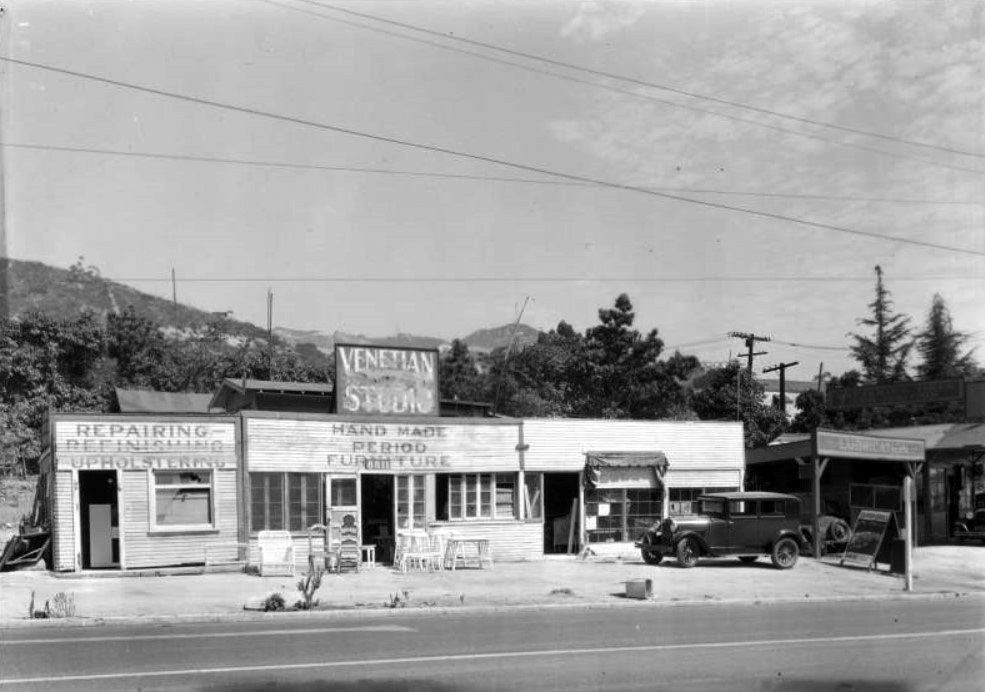 |
|
| (ca. 1935)^^ – View of the Venetian Studio Furniture Store located at 8811 Sunset Boulevard (north side of Sunset between Larrabee Street and Horn Ave). The clapboard store at center is a rundown structure with light-colored walls and a flat roof. Large rectangular windows can be seen along the front side of the building. Several tables and chairs are in front of the building. An early automobile can be seen parked at right near a service station. Legible signs include, from left to right: "Repairing Refinishing Upholstering", "Venetian Studio", "Hand Made Period Furniture", "Lubrication", "Batteries, Tires and Ignitions". This would become the future location of Tower Records (1970 - 2006). |
Historical Notes In Feb , 2022 the iconic Tower Records building was demolished. Here's the Tower building (8801 Sunset Blvd) history timeline |
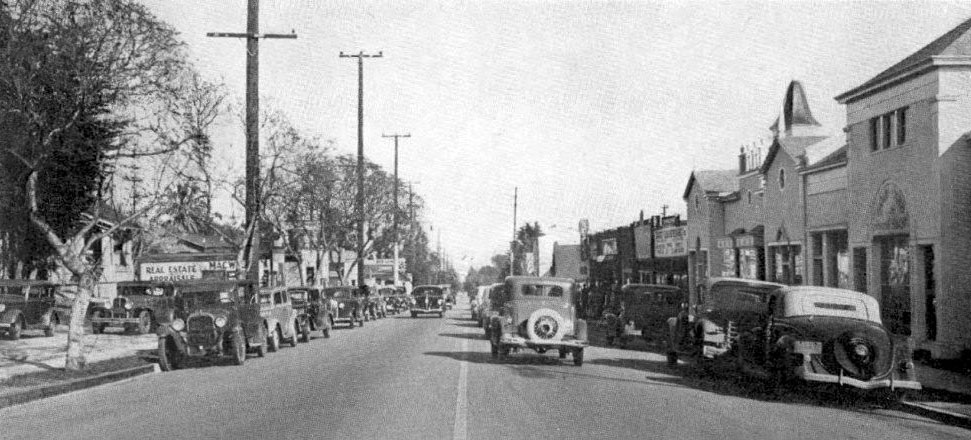 |
|
| (1936)#**# – View looking east along the 8800 block of Sunset Boulevard (San Vicente Blvd to Horn Ave). |
.jpg) |
|
| (1941)^.^ – Same view looking east along the 8800 block of Sunset Boulevard 5 years later, after the street was widened. Click HERE to see contemporary view. |
Sunset Tower
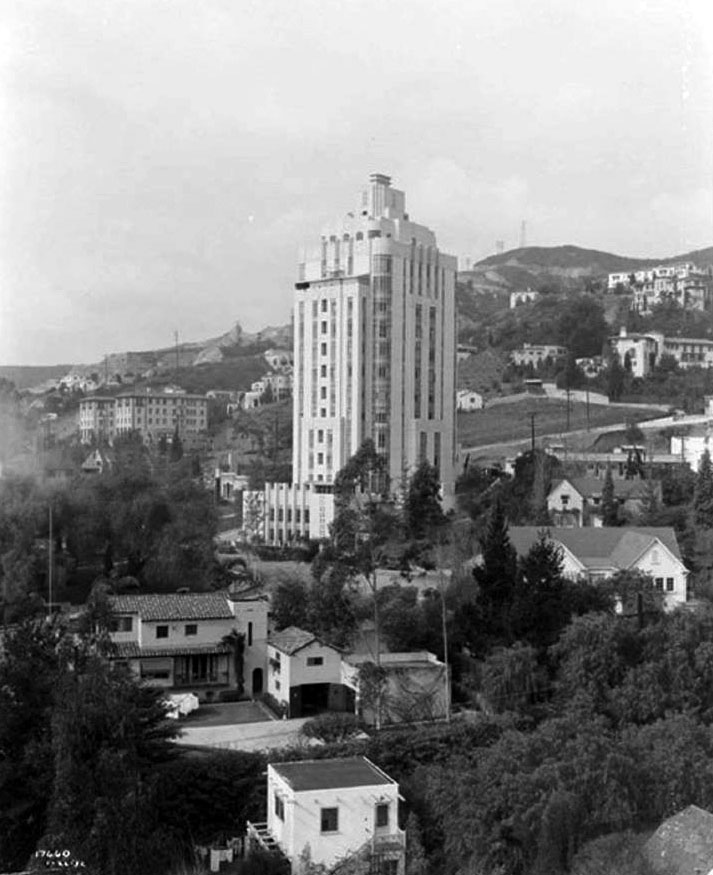 |
|
| (1932)* - View looking northwest showing the Sunset Tower Apartment Building located on Sunset Boulevard with the Hollywood Hills in the background. Note how the area around Sunset Boulevard is still largely residential. |
Historical Notes Designed in 1929 by architect Leland A. Bryant, opened in 1931, the Sunset Tower is considered one of the finest examples of Art Deco architecture in the Los Angeles area. In its early years, it was the residence of many Hollywood celebrities, including John Wayne and Howard Hughes.^ |
 |
|
| (1930s)^^ – View looking down toward the Sunset Tower through a Eucalyptus Tree. The Art Deco apartment building is located at 8358 Sunset Boulevard. |
Historical Notes The building was renamed the Sunset Tower Hotel in 2004, after going through several incarnations as the infamous St. James’s Club and The Argyle. Its dramatic setting and elegant Art Deco architecture, along with its proximity to famous restaurants and nightclubs of the 1930s and 1940s, contributed to its landmark status. |
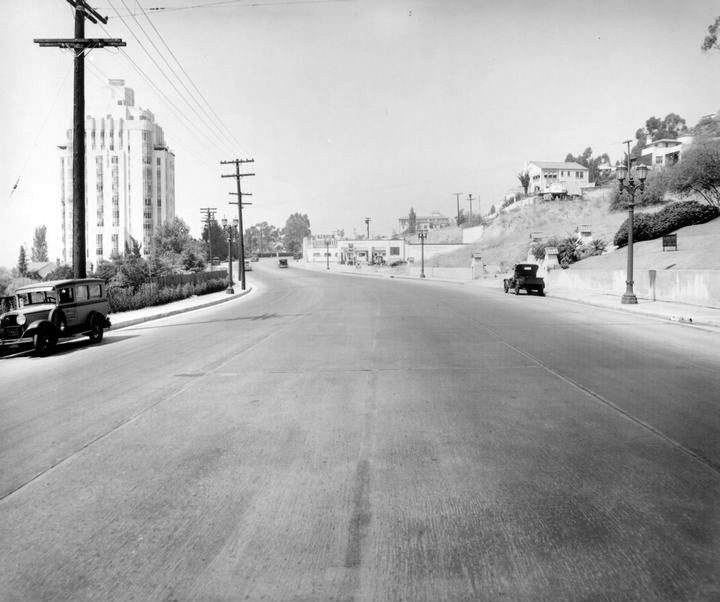 |
|
| (ca. 1930)***^ - View of the Sunset Strip in the early 1930s. The Sunset Tower Apartment Building is the tallest building in the area. Click HERE to see contemporary view. |
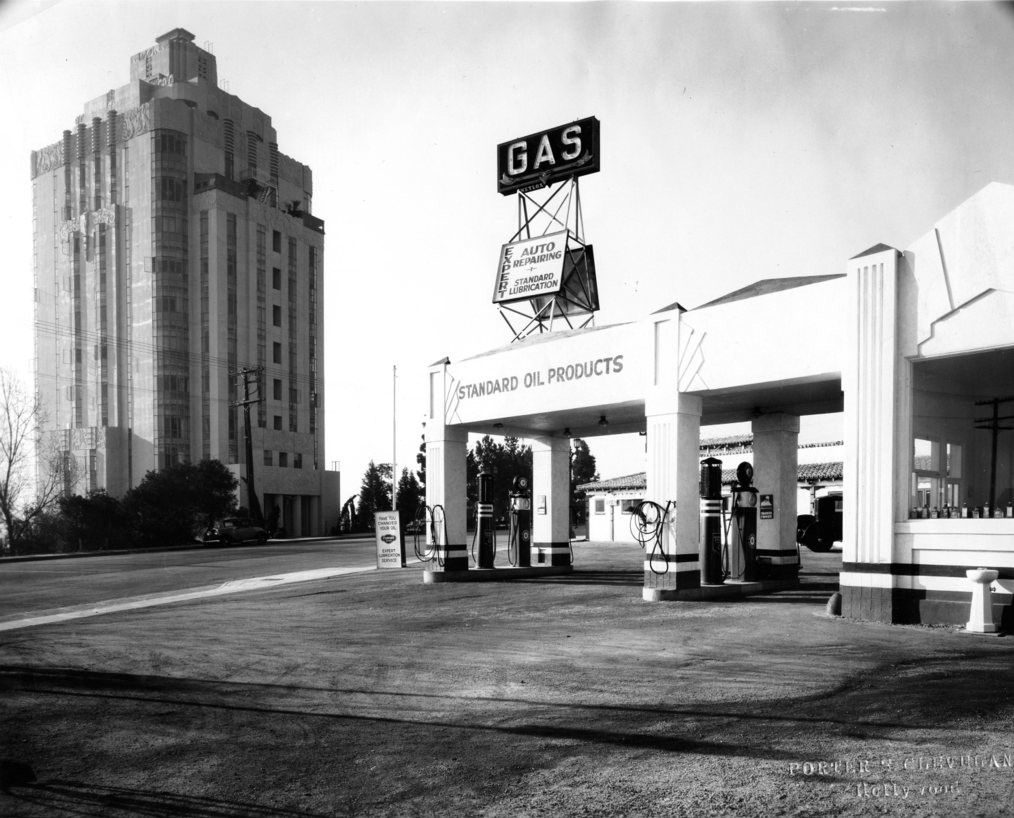 |
|
| (1933)^^ - Sunset Tower Apartments as seen from a gas station across the street. Built partly above and partly below the Strip, the Sunset Tower apartment building was the tallest thing going on the strip when it was built in 1931. |
Historical Notes Originally operated as a luxury apartment hotel, it was one of the first high-rise reinforced concrete buildings in California. When it was completed in August 1931 at a cost of $750,000, the Los Angeles Times reported: "What is described to be the tallest apartment-house in Los Angeles County, rising 15 stories or 195 feet, was completed last week at Kings Road and Sunset Boulevard by W.I. Moffett, general contractor, for E.M. Fleming, owner."^ |
Then and Now
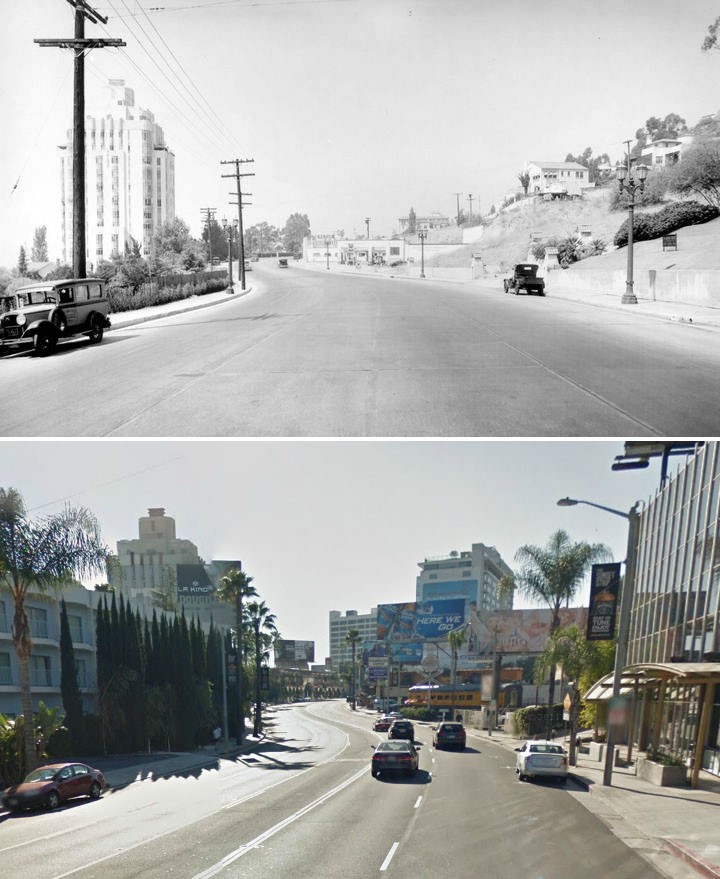 |
|
| (1931 vs 2014)* - The Art Deco Sunset Tower Apartments on the Sunset Strip - Then and Now |
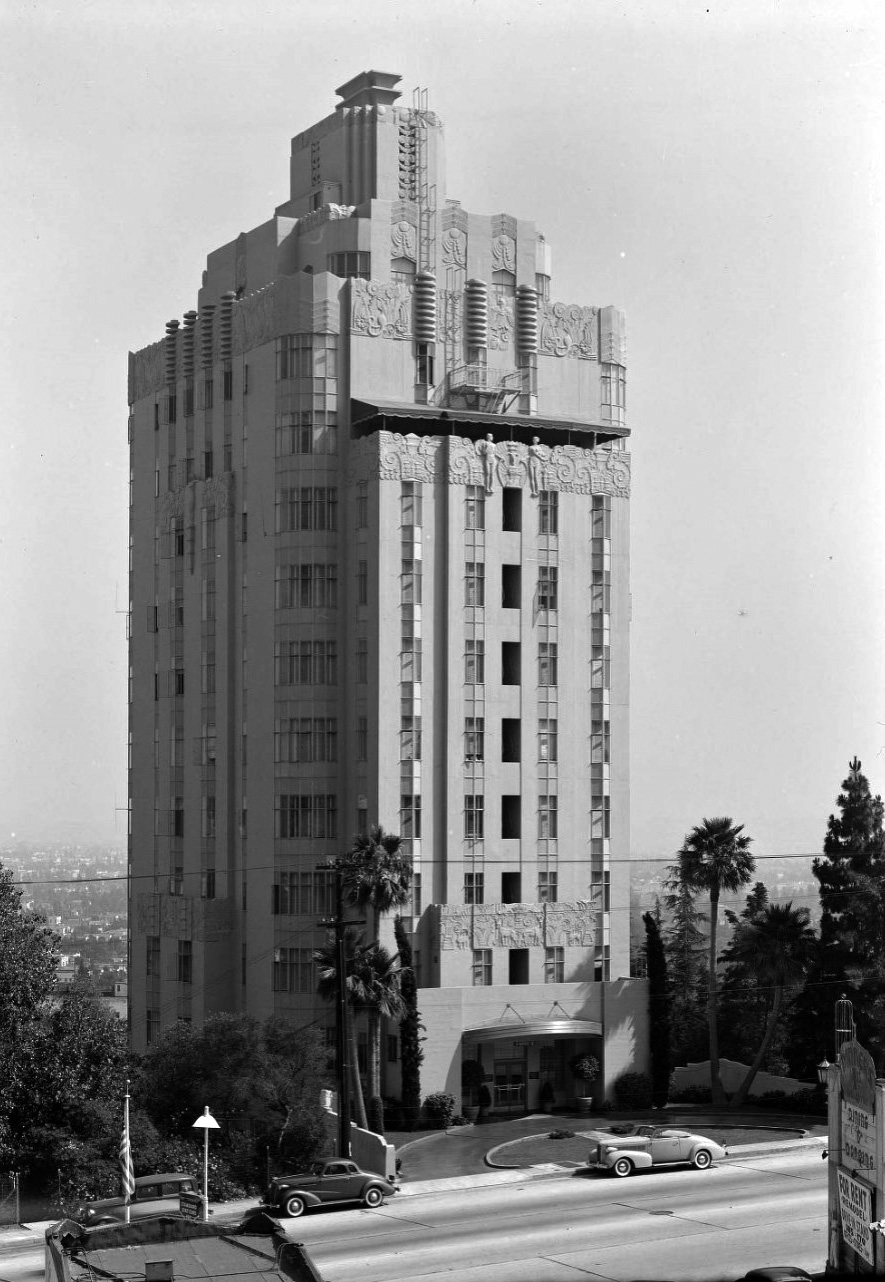 |
|
| (1939)^^ – Early model cars are parked on Sunset Boulevard in front of the Sunset Tower. |
Historical Notes In 1933, the Los Angeles Times ran an article about the trend toward luxurious penthouse apartments in the city and noted that Sunset Tower boasted the city's highest penthouse: "It is the highest in the city and due to the location of the fifteen-story structure that supports it, its tenants live on a level with the tower of the Los Angeles City Hall. Imagine the view!" ^ |
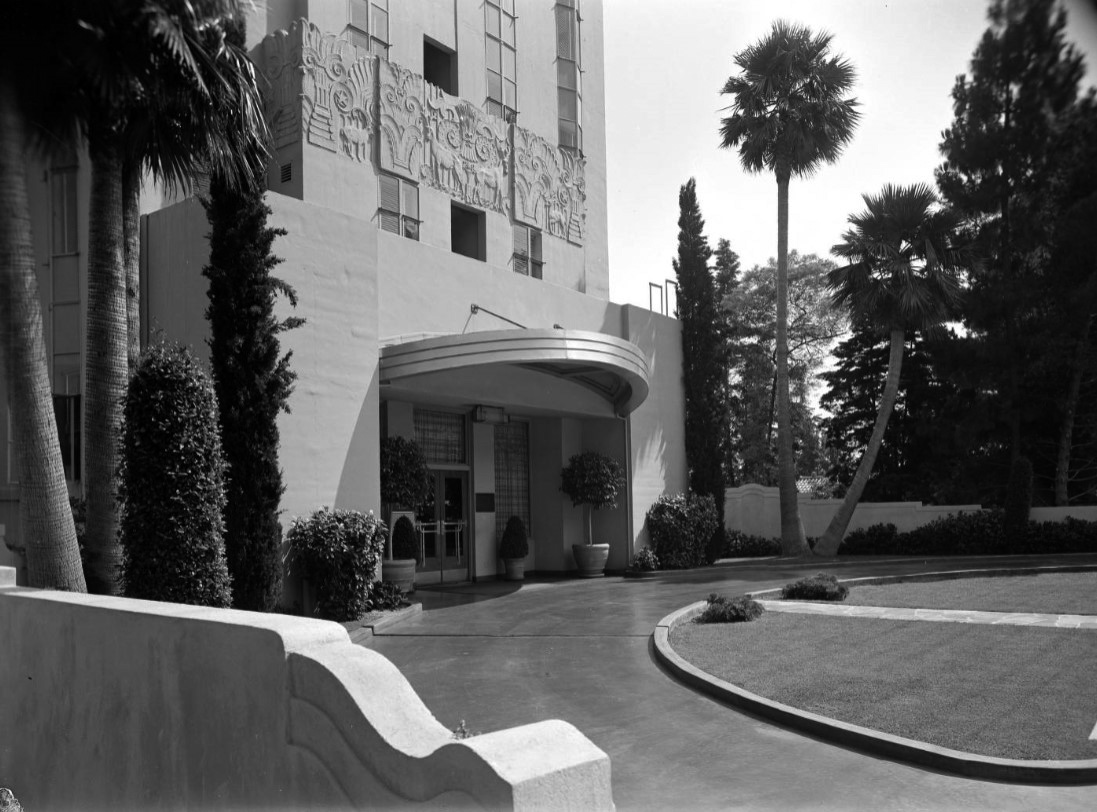 |
|
| (1939)^^ – Close-up view showing the front entrance of the Sunset Tower. |
Historical Notes Marketing the building to Hollywood celebrities, an advertisement in the February 1938 issue of the Screen Actors Guild magazine read: "Faultless in Appointment-The Ultimate in Privacy . . . Hollywood's Most Distinguished Address." |
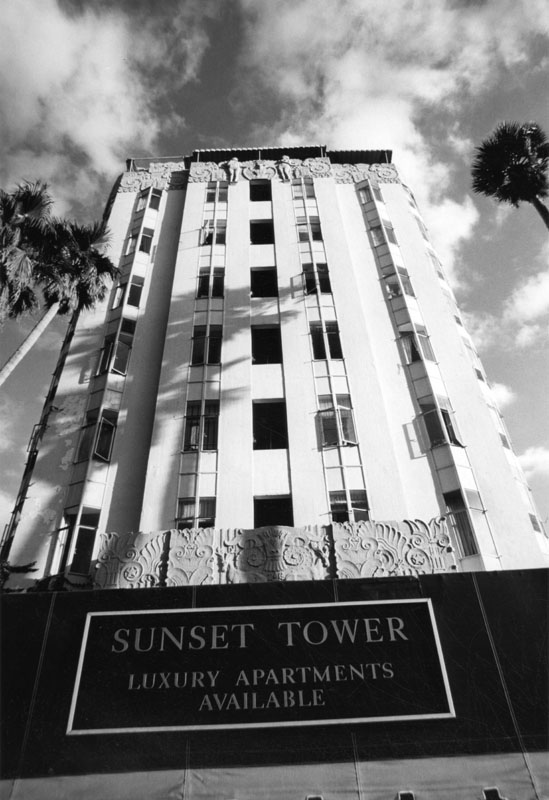 |
|
| (1930s)* - An Art Deco masterpiece, the Sunset Tower 'Luxury' Apartments, located at 8358 Sunset Boulevard. |
Historical Notes John Wayne, Howard Hughes, Frank Sinatra, Jerry Buss and novelist James Wohl lived in the penthouse at different times, and Hughes reportedly also rented some of the lower apartments for his girlfriends or mistresses. Other former residents include Clark Gable, Errol Flynn, Marilyn Monroe, Michael Caine, Quincy Jones, Roger Moore, Zsa Zsa Gabor, Billie Burke, Joseph Schenck, Paulette Goddard, Zasu Pitts, George Stevens, Preston Sturges, and Carol Kane.^ |
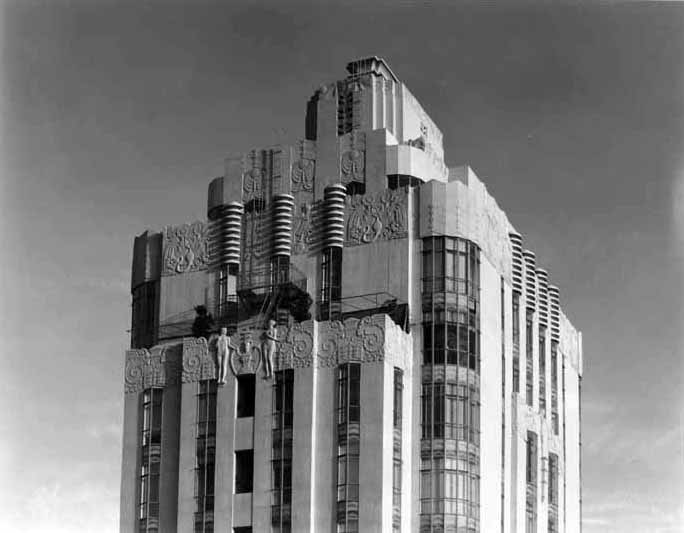 |
|
| (1936)* – The art deco Sunset Tower is considered one of the finest examples of the Streamline Moderne form of Art Deco architecture in Southern California. |
Historical Notes In their guide to Los Angeles architecture, David Gebhard and Robert Winter wrote that "this tower is a first class monument of the Zig Zag Moderne and as much an emblem of Hollywood as the Hollywood sign." It is situated in a commanding location on the Sunset Strip with views of the city and is decorated with plaster friezes of plants, animals, zeppelins, legendary creatures and Adam and Eve.^ |
 |
|
| (2009)^ – Close-up detail view showing the Zig-Zag design on the windows of the Art Deco Sunset Tower. Photo Courtesy of Alan M. Pavlik - 'Just Above Sunset'. |
Historical Notes The building is decorated with plaster friezes of plants, animals, zeppelins, mythological creatures and Adam and Eve. |
 |
|
| (2009)^ – Close-up detail view showing the bas-relief figures and Art Deco Zig-Zag design of the Sunset Tower. Photo Courtesy of Alan M. Pavlik - 'Just Above Sunset'. |
Historical Notes Architect Leland Bryant specialized in luxury apartments, but the Sunset Tower was his crowning achievement. His work was predominantly in Period Revival, but with this building he proved that he was equally adept with the then contemporary Deco style.* |
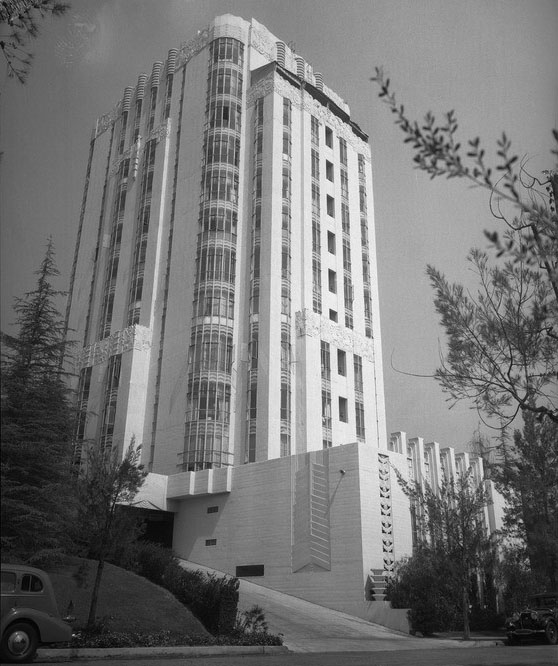 |
|
| (1940s)* – View looking up at the Sunset Tower Apartments from the De Longpre Avenue side of the building. |
Historical Notes To attract a demanding clientele, the Sunset Tower incorporated the latest in both technology and design. There were modern conveniences, like outlets in every bathroom for electric shavers, and the windows were made larger to take advantage of the spectacular views.* |
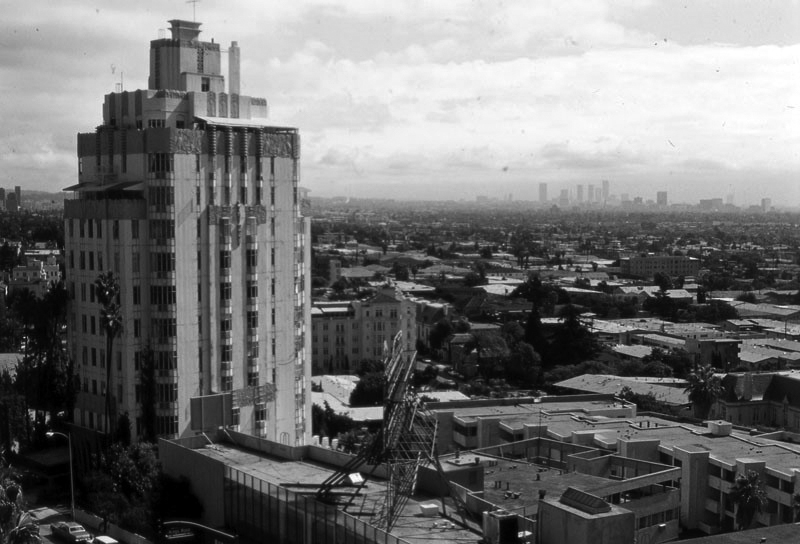 |
|
| (1979)* - Looking out upon West Hollywood from a balcony at the Sunset Hyatt Hotel (later Andaz West Hollywood), showing the neighborhood and the iconic Sunset Tower; Downtown Los Angeles is partially visible through the haze on the right. |
Historical Notes After a period of decline in the early 1980s, the building was renovated and has been operated as a luxury hotel under the names The St. James's Club, The Argyle, and most recently the Sunset Tower Hotel. |
 |
|
| (2005)*^ – View showing the Sunset Tower Hotel located at 8358 Sunset Boulevard in West Hollywood. Photo by Carol M. Highsmith via Wikipedia |
Historical Notes The building was saved from deterioration and possible demolition when it was purchased in 1985 from architect David Lawrence Gray, FAIA by Peter de Savary who promised to "lovingly restore" the building to its former glory by spending $25 million to convert the building into the first American branch of his luxury hotel chain, the St. James's Club. The Lancaster Group purchased the hotel from de Savary in 1992, renaming it the Argyle. In 2004, Jeff Klein purchased the hotel. Klein hired designer Paul Fortune to renovate the hotel, adding more modern amenities, and restored its original name.^ |
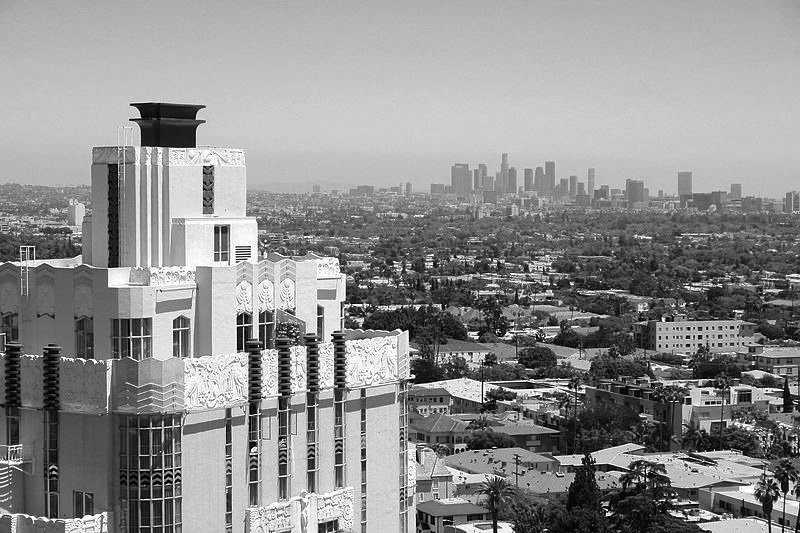 |
|
| (2011)^ - Sunset Tower, 8358 Sunset Blvd in West Hollywood, with the Downtwon LA skyline in the background. Photo by Mike Jiroch via Wikipedia |
Historical Notes The Sunset Tower building was listed on the National Register of Historic Places in 1980. In the 1990's the Sunset Tower Hotel was known as the Argyle Hotel. Before that it was known as the St. James Club and Hotel, a grand 13 story, the Strip's 1st high-rise (built in 1931), and one of Hollywood 's best examples of Art Deco design. Virtually every star in Hollywood stayed here at one time or another. It was a favorite of Howard Hughes, who kept a number of suites here fore his various girlfriends; other guest included Clark Gable, Jean Harlow, Marilyn Monroe, Frank Sinatra and John Wayne (who is said to have kept a cow on the balcony outside his penthouse suite for fresh milk). |
* * * * * |
Club Casanova
 |
|
| (ca. 1936)* - View of Sunset Boulevard in the city of West Hollywood showing the Casanova Club located at 8383 Sunset Blvd. A large castle-like tower can be seen in the distance (center-top). This is the famous Chateau Marmont Hotel, located at 8221 Sunset Blvd. |
Historical Notes Sunset Boulevard, a long winding thoroughfare that begins in downtown Los Angeles and runs westward over 20 miles, ends at the Pacific Ocean near Malibu. The best-known portion of the boulevard is the mile and a half stretch between Hollywood and Beverly Hills, known as "The Sunset Strip".* The Chateau Marmont Hotel was a great castle on the hill inspired by the architecture of the Loire Valley in France was built in 1927, opened in 1929 as an apartment house, and was changed to a hotel in 1931, becoming the "Hotel to the Stars".* |
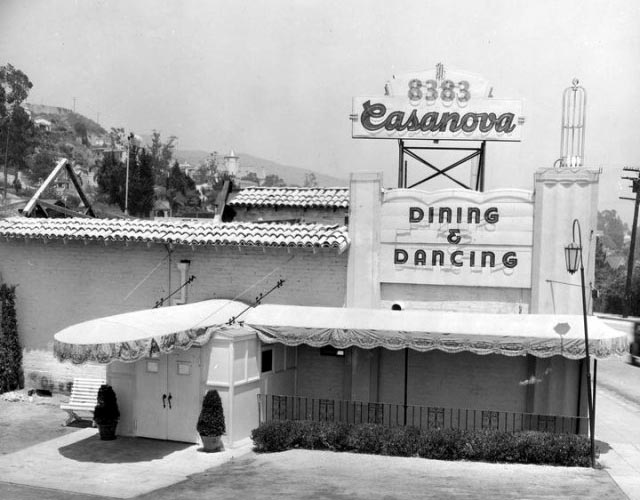 |
|
| (ca. 1936)**## – Close-up view showing the Club Casanova located at 8383 Sunset Boulevard on the Sunset Strip. |
Historical Notes The Club Casanova opened in August 1936 and lasted only 16 months. In 1937, it became U-Gene’s Bagdad Café, then two years later, Bow’s Inn. Today, the Saddle Ranch Chop House stands at this location, on the N/E corner of Sunset and N. Kings Rd. |
Players Nightclub
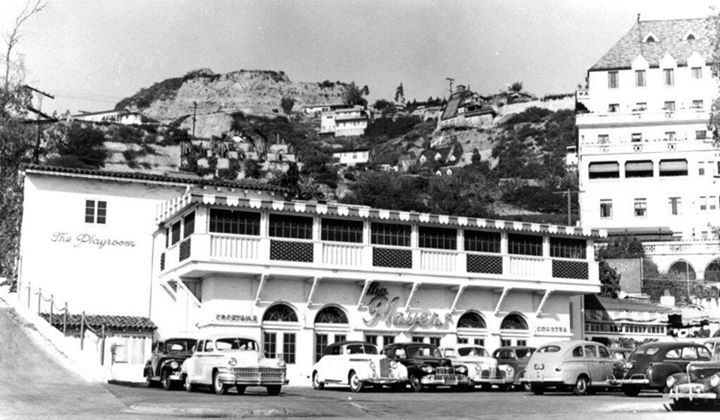 |
|
| (ca. 1940)** - View showing the Players Nightclub at 8225 Sunset Boulevard, opened by director Preston Sturges during the Summer of 1940. The Chateau Marmont Hotel is on the right. |
Historical Notes In 1940 Preston Sturges, successful Hollywood writer and director, opened Players Nightclub. Stars and writers made it their home base. Humphrey Bogart, Dorothy Parker, Robert Benchley, George S. Kaufman (writer of several Marx Brothers movies), and Donald Ogden Stewart (screenwriter of 1938’s Marie Antoinette and 1940’s The Philadelphia Story) all got smashed on The Players’ drinks, which were said to be the most potent in town. Barbara Stanwyck (Sturges’ leading lady in The Lady Eve), Orson Welles (who stayed next door at the Chateau Marmont when he first came to Hollywood), Joel McCrea (who starred in three of Sturges’ pictures), Rudy Vallee, director William Wyler, and writer William Faulkner were all regulars at their friend’s establishment. Multi-millionaire Howard Hughes became a regular guest. He often dined on the top floor, frequently preferring to eat alone.* |
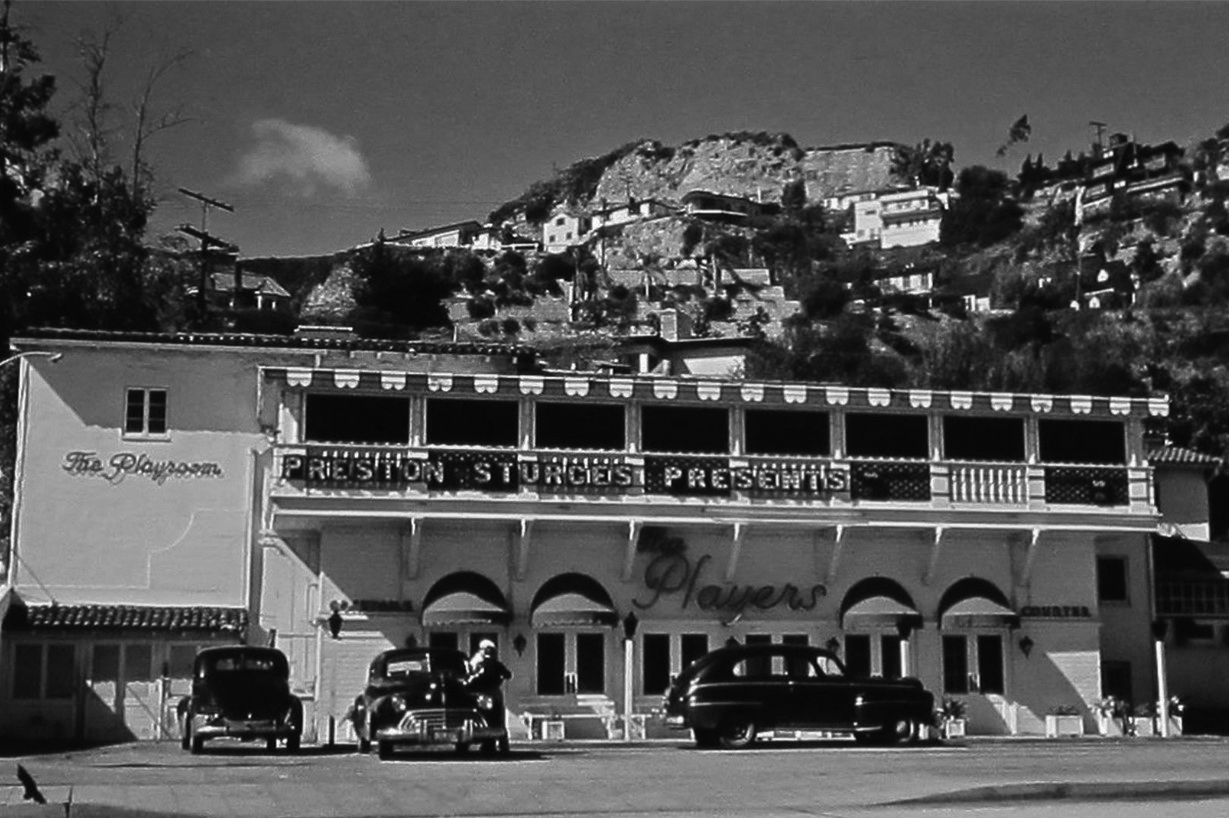 |
|
| (1940s)^#^^ - Closer view of Players Nightclub on the Sunset Strip with homes perched on hillside in the background. Sign on front balcony reads: "Preston Sturges Presents" |
Historical Notes At its peak during WWII, The Players was a three-level extravaganza with a restaurant on each floor. There was a barbershop on the mezzanine level. Sturges also built a dinner theatre/dance floor with a revolving, hydraulic stage. Later still, he added a burger stand for the tourist trade.* |
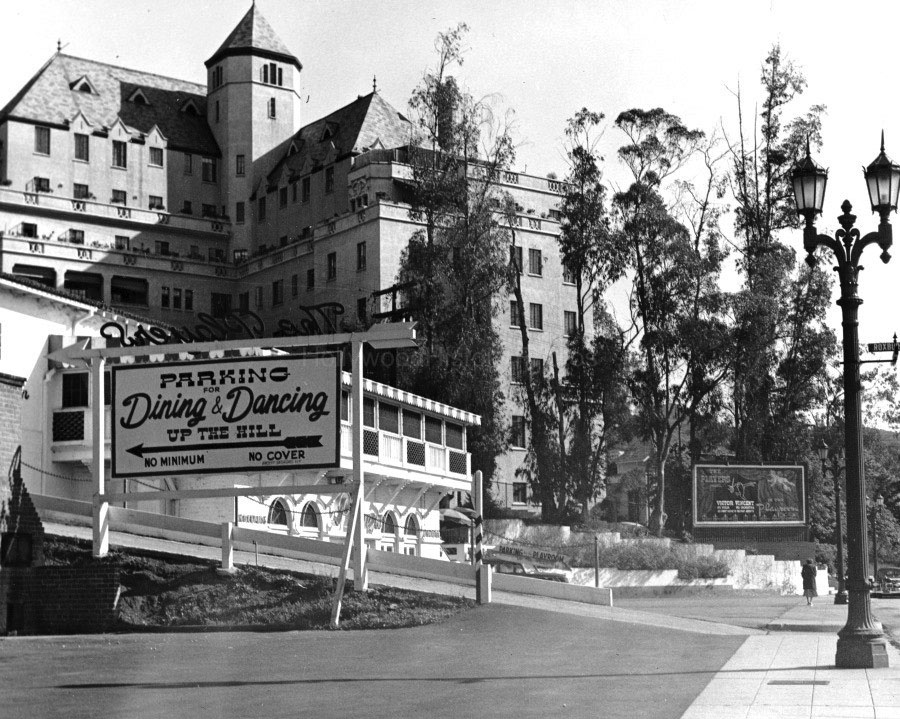 |
|
| (ca. 1940)** – View showing the Chateau Marmont with the Players Nightclub seen in the left foreground. Note the ornate street light on the right. These were called ‘Metropolitan’ streetlights found mostly in Hollywood. |
Historical Notes The Players never broke even and, by 1953, the burger stand was the only part of The Players still open for business.* |
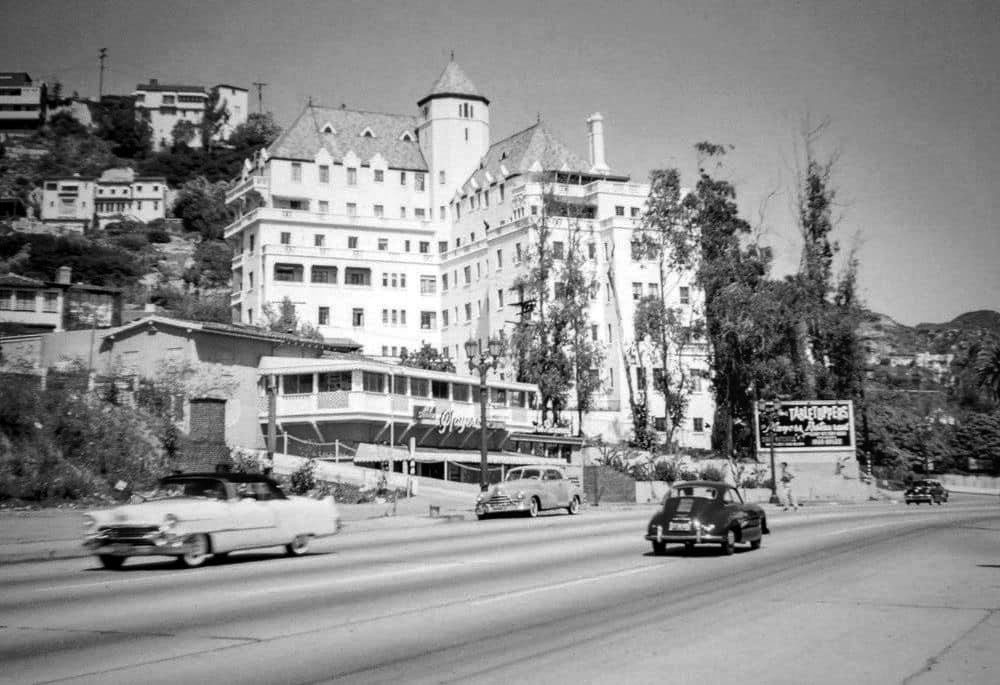 |
|
| (ca. 1957)^ – A Cadillac and Porsche drive by the Players Nightclub at 8225 Sunset Boulevard with the Chateau Marmont in the background. |
Historical Notes Player’s Club didn't make it past the late 1950s. It later became the Imperial Gardens, the Roxbury and Miyagi's. In 2012 Harry Morton, oil-slick heir of Hard Rock Café founder Peter Morgan, chose the site for the second location of his Mexican restaurant chain The Pink Taco. During renovations his work crews discovered the revolving stage, the dance floor and the infamous secret tunnel connecting to the Chateau Marmont.^ |
Then and Now
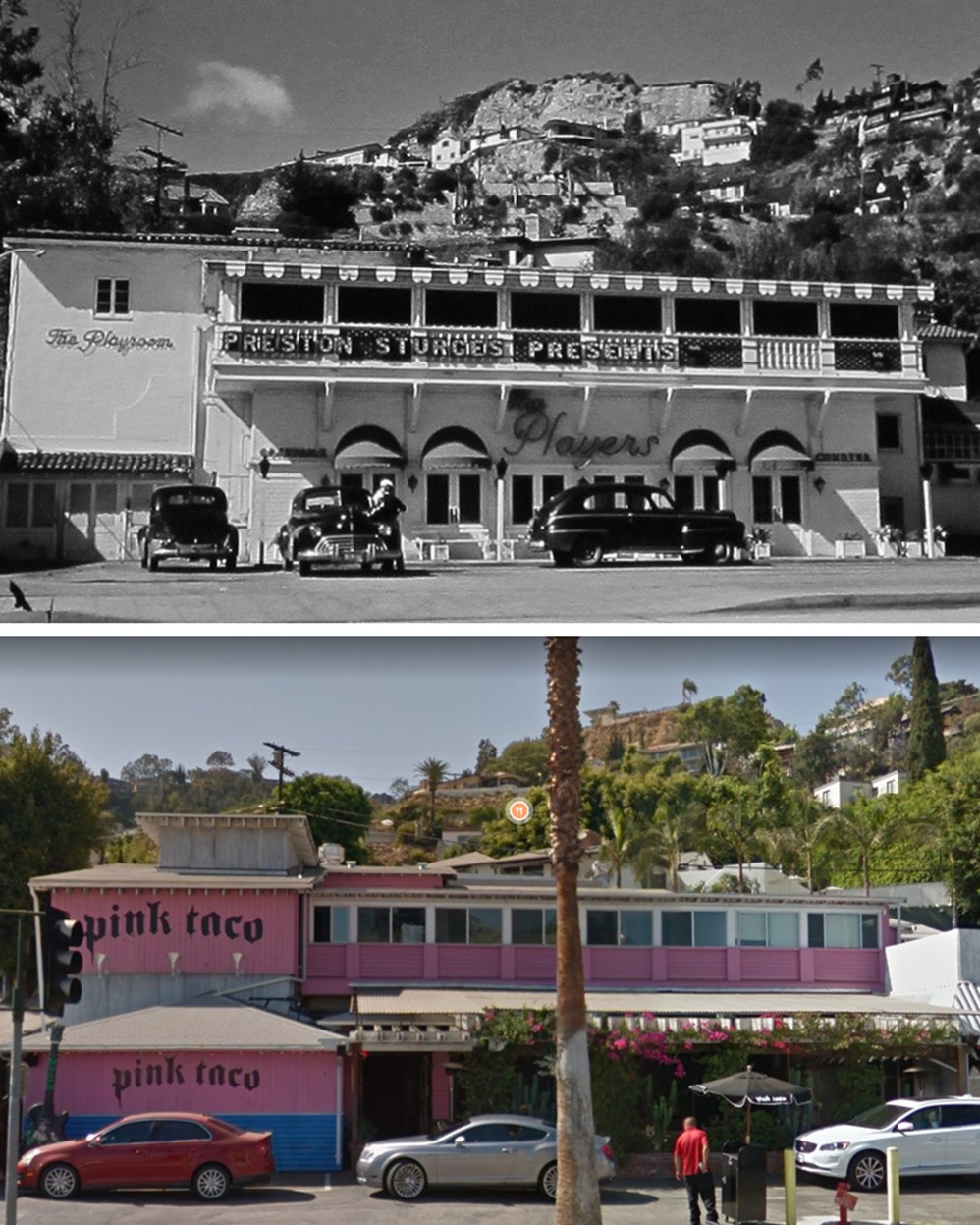 |
|
| (1940s vs. 2016)* – Players Nightclub on the Sunset Strip, now a Pink Taco Restaurant located at 8225 Sunset Boulevard. |
Chateau Marmont Hotel
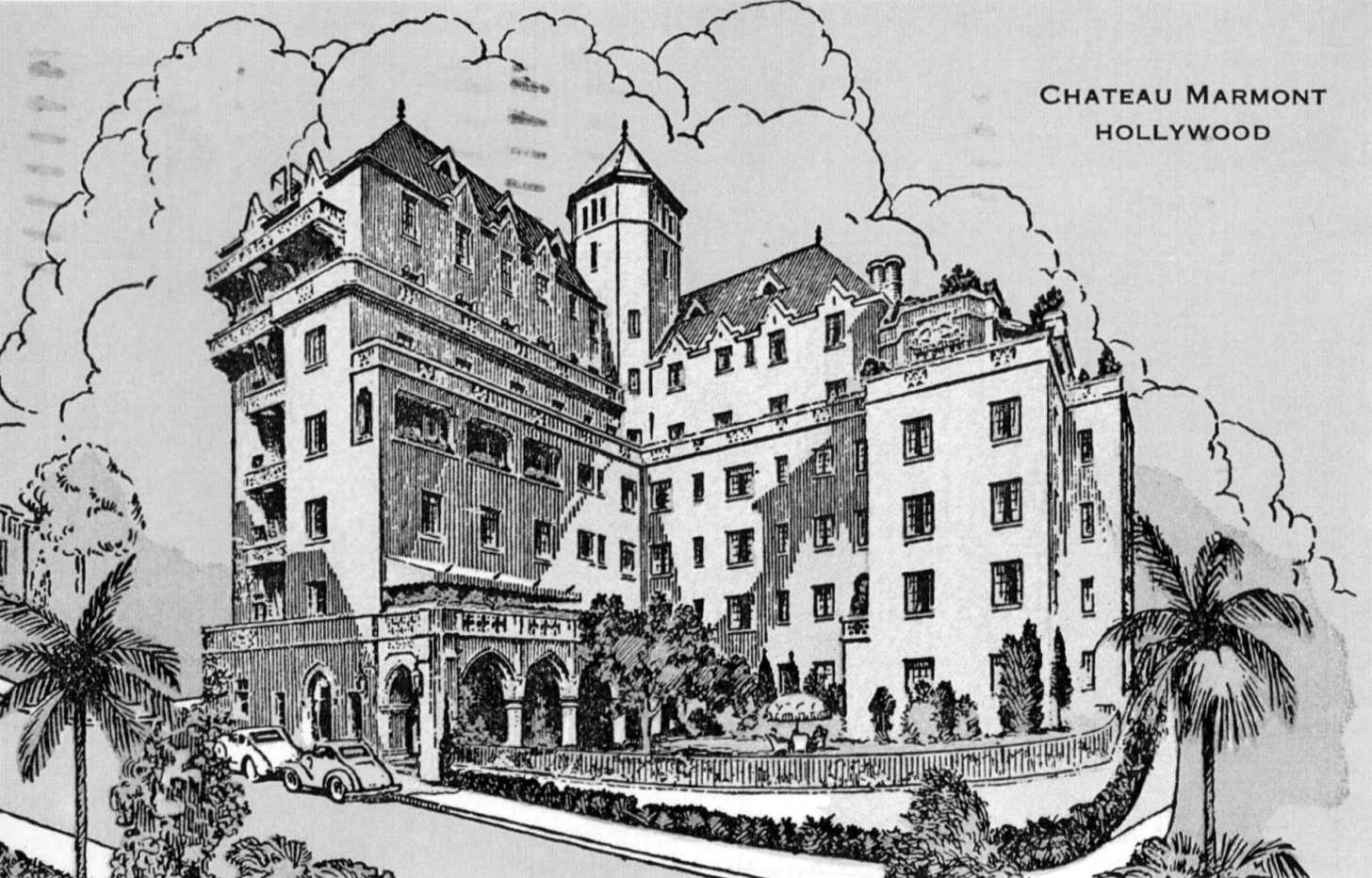 |
|
| (1930s)* – Postcard image of the Chateau Marmont in West Hollywood. |
Historical Notes In 1926 Fred Horowitz, a prominent Los Angeles attorney, chose the site at Marmont Lane and Sunset Boulevard to construct an apartment building. Horowitz had recently traveled to Europe for inspiration and returned to California with photos of a Gothic Chateau along the Loire River. In 1927 Horowitz commissioned his brother-in-law, European-trained architect Arnold A. Weitzman, to design the seven-story, L-shaped building based on his French photos. When deciding upon a name for the building, Chateau Sunset and Chateau Hollywood were rejected in favor of Chateau Marmont, a name conceived by the small street running across the front of the property.* |
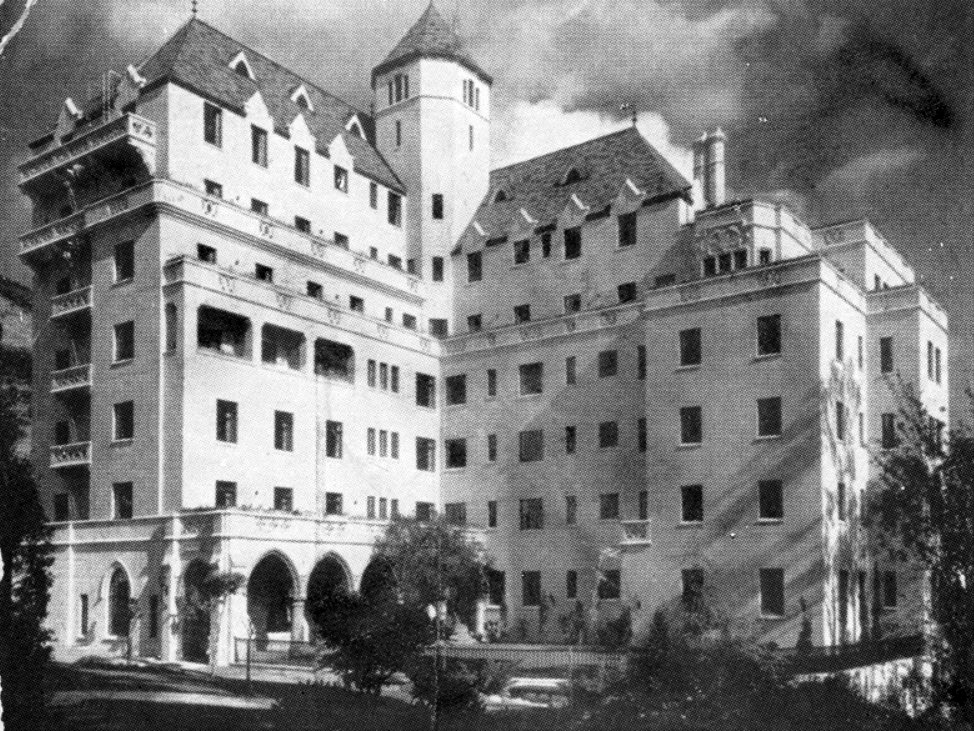 |
|
| (1940s)* – Photo showing the Chateau Marmont Hotel located at 8221 Sunset Boulevard. |
Historical Notes On February 1, 1929, Chateau Marmont opened its doors to the public as the newest residence of Hollywood. Local newspapers described the Chateau as “Los Angeles’s newest, finest and most exclusive apartment house ... superbly situated, close enough to active businesses to be accessible and far enough away to insure quiet and privacy.” Due to the high rents and inability to keep tenants for long-term commitments during the depression, Fred Horowitz chose to sell the apartment building to Albert E. Smith for $750,000 in cash. The following year, Chateau Marmont was converted into a hotel. The apartments became suites with kitchens and living rooms. The property was also refurbished with antiques from depression-era estate sales.* |
 |
|
| (ca. 1940)** – View showing the Chateau Marmont with the Players Nightclub seen in the left foreground. Note the ornate street light on the right. These were called ‘Metropolitan’ streetlights found mostly in Hollywood. |
Historical Notes There existed a secret tunnel connecting the Players Club to the Chateau Marmont. |
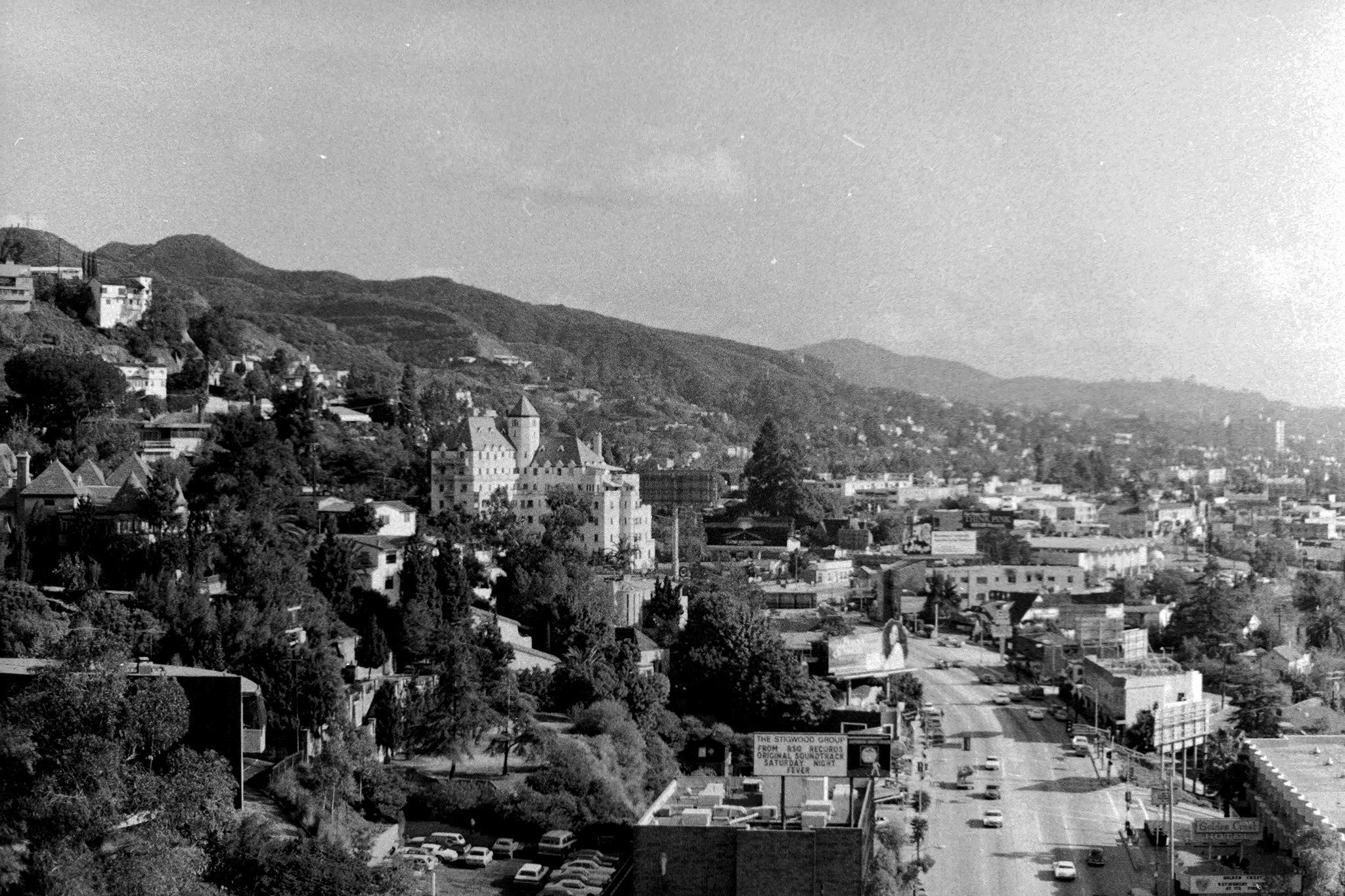 |
|
| (1977)^.^ – View looking east on the Sunset Strip showing the beautiful Chateau Marmont standing out like a castle in the Hollywood Hills. Photo courtesy of Jeff Katz |
Historical Notes Designed and constructed to be earthquake proof, Chateau Marmont survived major earthquakes in 1933, 1953, 1971, 1987 and 1994 without sustaining any major structural damage. Nine Spanish cottages were built next to the hotel in the 1930s and were acquired by the hotel in the 1940s. Craig Ellwood designed two of the four bungalows in 1956, after he completed Case Study Houses.* |
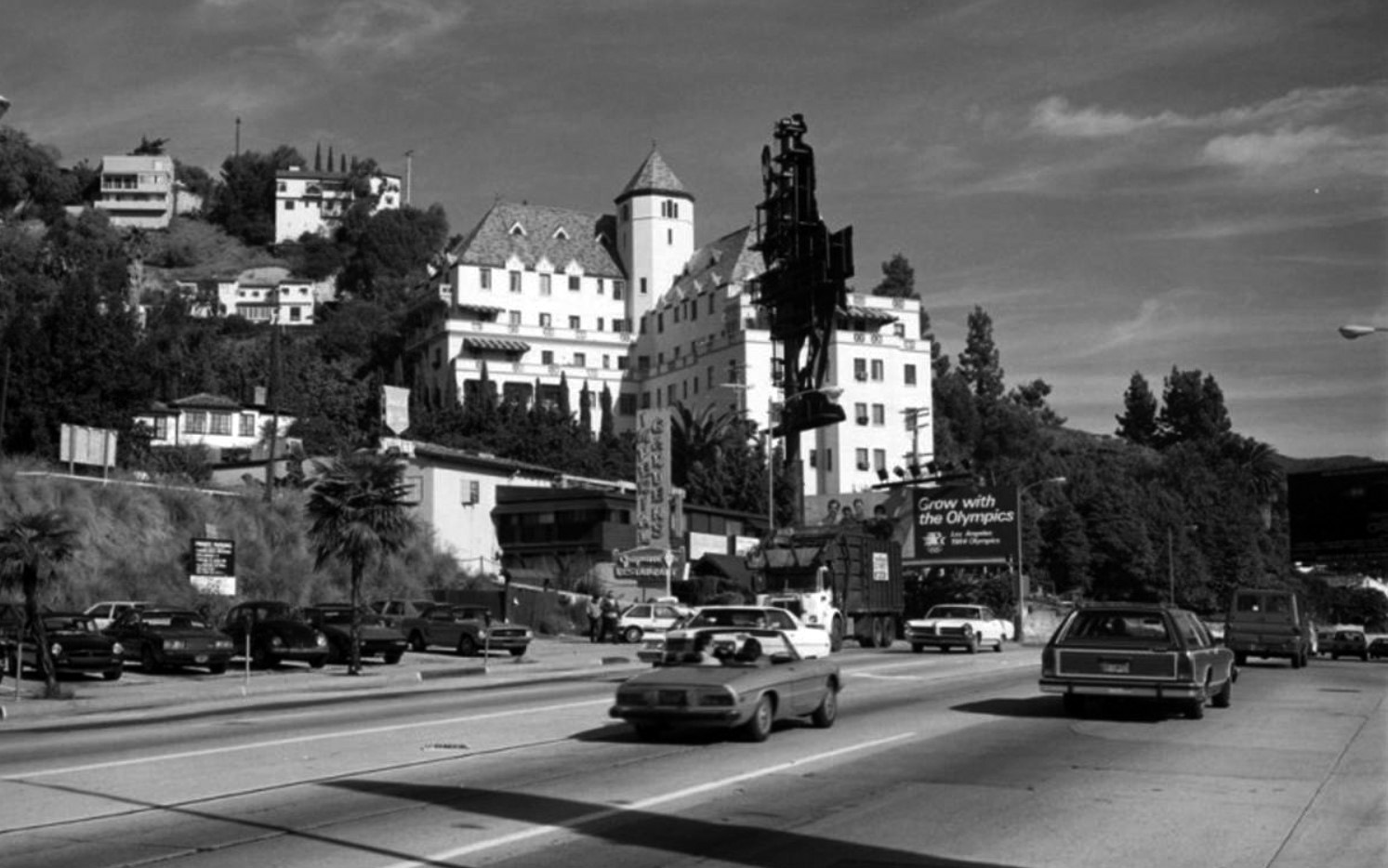 |
|
| (1983)* - The Chateau Marmont Hotel, inspired by the architecture of the Loire Valley in France, and the Imperial Gardens Japanese Restaurant are shown above Sunset Blvd. There is a billboard advertising the 1984 Olympic Games to be held in Los Angeles. The back of the Marlboro Man sign can also be seen. |
Historical Notes With its external appearance of a castle or Gothic fort, combined with its residential past, incredibly thick walls, discreet entry, and highly protective staff who treated guests like members of the family, the Chateau Marmont became the ideal hideout. European guests found the architecture familiar and comforting, sexual outsiders felt accepted, the emotionally shy were shielded, and anyone else with a reason to hide simply blended into the woodwork—from the start there was the feeling of a shared sensibility. Greta Garbo felt comfortable here, as did Howard Hughes.^ |
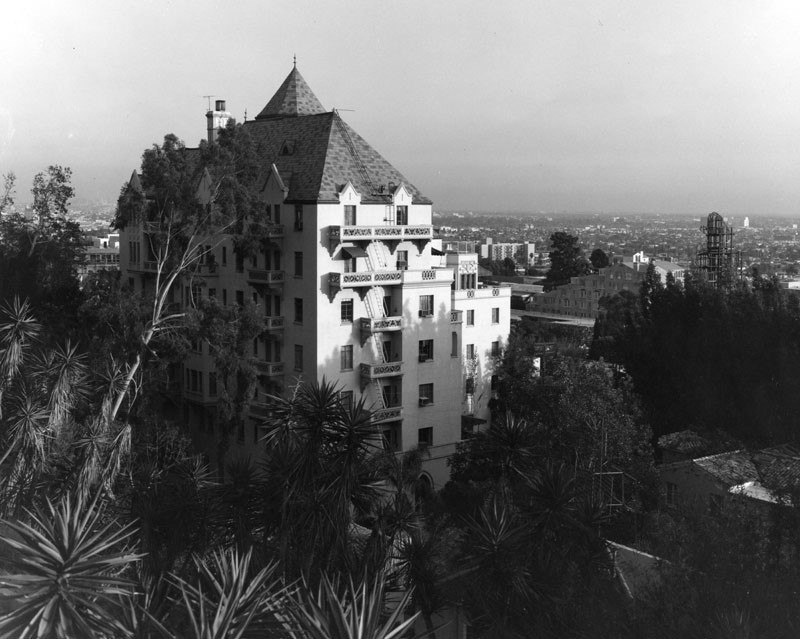 |
|
| (ca. 1995)* – View of the Chateau Marmont Hotel as seen from the Hollywood Hills looking southeast. |
Historical Notes Members of Led Zeppelin rode their motorcycles through the lobby in the 1960s. On March 5, 1982, comedian John Belushi died from a speedball injection in Bungalow No. 3. On January 23, 2004, photographer Helmut Newton, who lived at the hotel, lost control of his Cadillac and crashed into the driveway wall. He was killed. There is a commonly-denied and non-denied story that Benicio Del Toro and Scarlett Johansson hooked up in the elevator the night before the 2004 Oscars.^ |
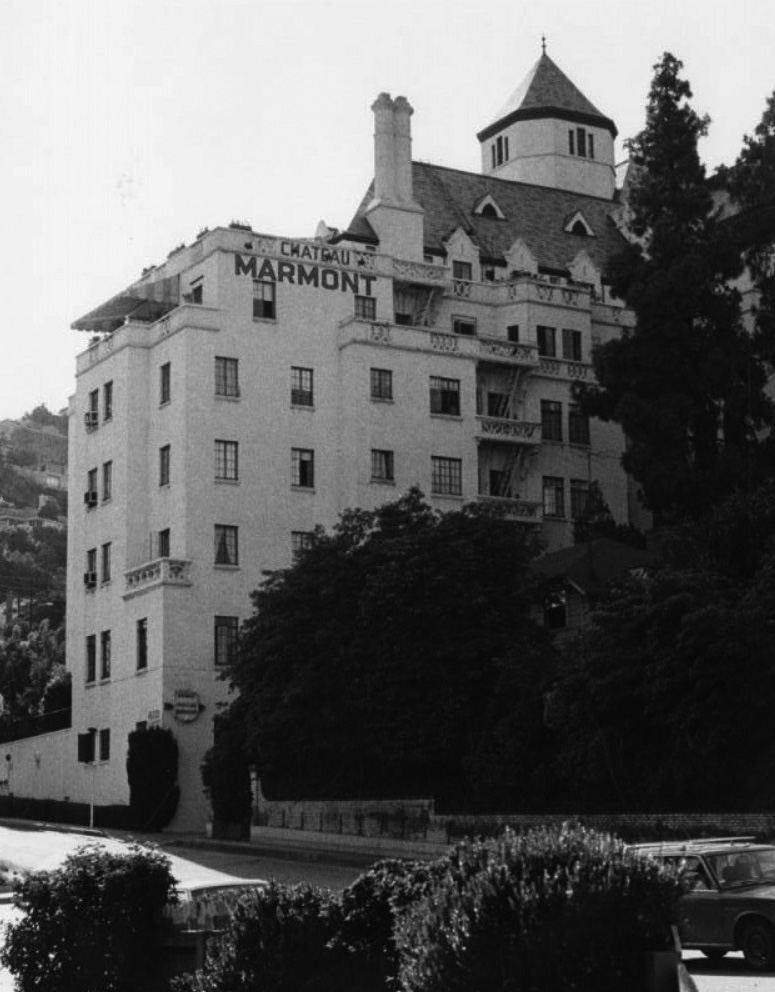 |
|
| (ca. 1984)* - Chateau Marmont, one of the most famous buildings in the Hollywood area. Located on the Sunset Strip in West Hollywood, it has hosted some of the world's greatest entertainment figures and members of many royal families as well. The architecure incorporates French and Spanish-style elements throughout. Photo by Roy Hankey |
Historical Notes Lindsay Lohan shacked up at the Chateau in the midst of her (first) drunk driving scandal. During her public meltdown phase, in September 2007, Britney Spears was temporarily banned from the Chateau for smearing her face with food, disgusting fellow diners. Lohan was finally banned in 2012 (she’d been living in Suite No. 33) after racking up a $46,350.04 tab on stuff like cigarettes, candles, iPhone chargers, and copies of Architectural Digest.^ |
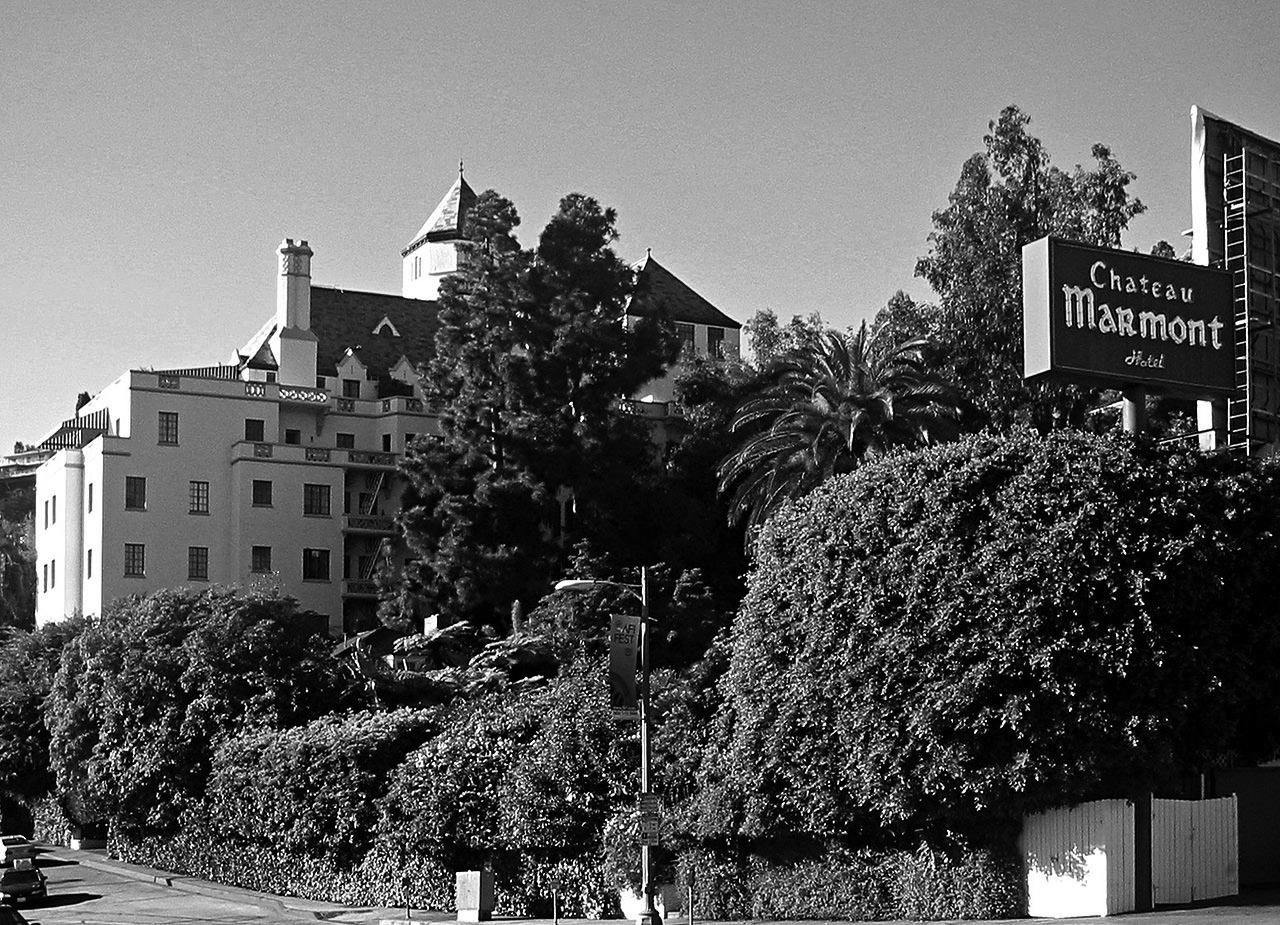 |
|
| (2006)* - View showing the Chateau Marmont Hotel located on the Sunset Strip, 8225 Marmont Lane and 8221 Sunset Boulevard. Photo by Gary Minnaert / Wikipedia |
Historical Notes When celebrities visiting Los Angeles want to be seen, they often go to the Beverly Hills Hotel. When they wish to keep out of the limelight they often stay at the Marmont. |
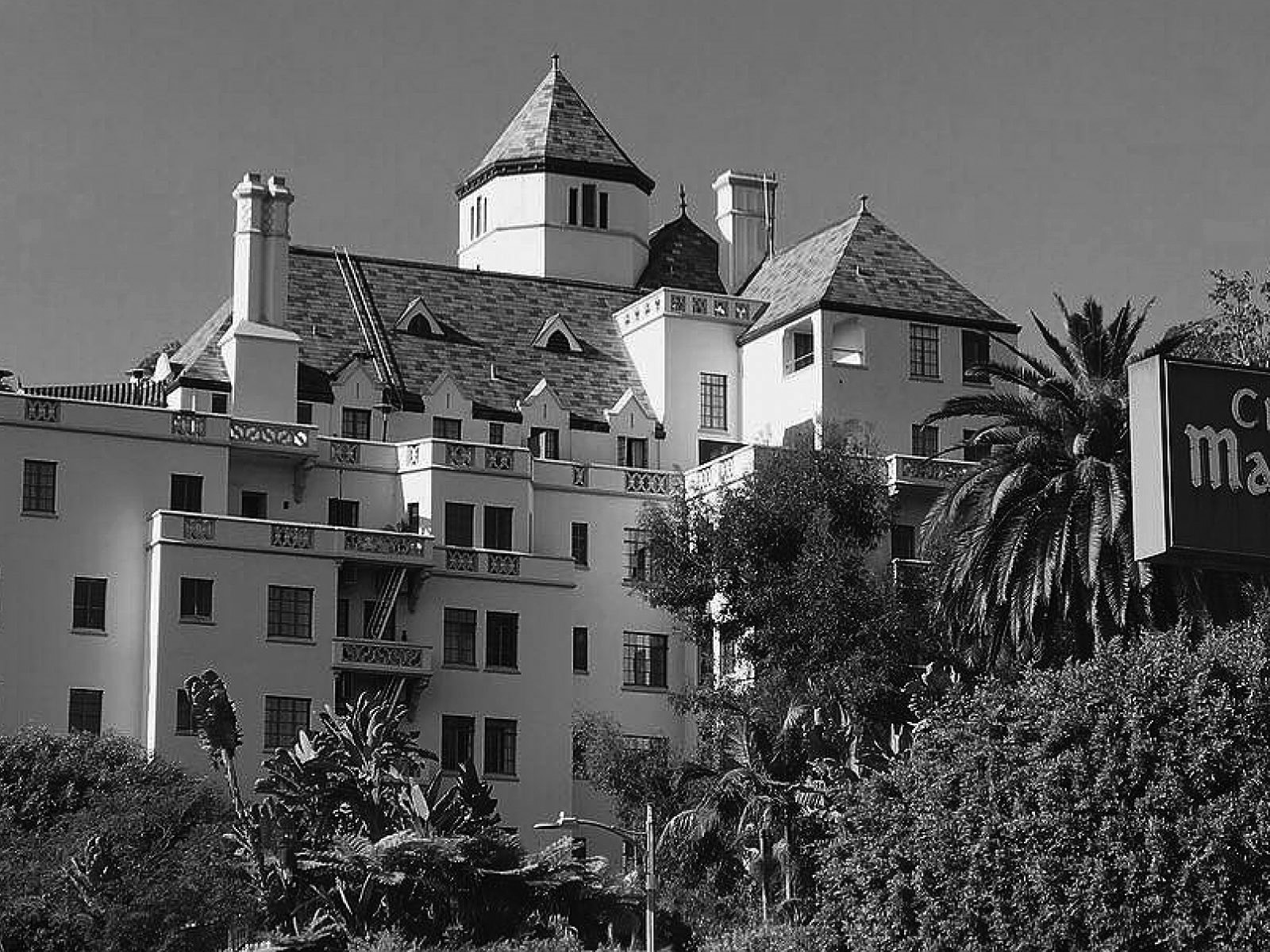 |
|
| (ca. 2019)^ – Close-up view of the Chateau Marmont on the Sunset Strip as it appears today. |
Historical Notes In 1976, Chateau Marmont was dedicated LA Historic-Cultural Monument No. 151 (Click HERE to see complete listing). |
Club Seville
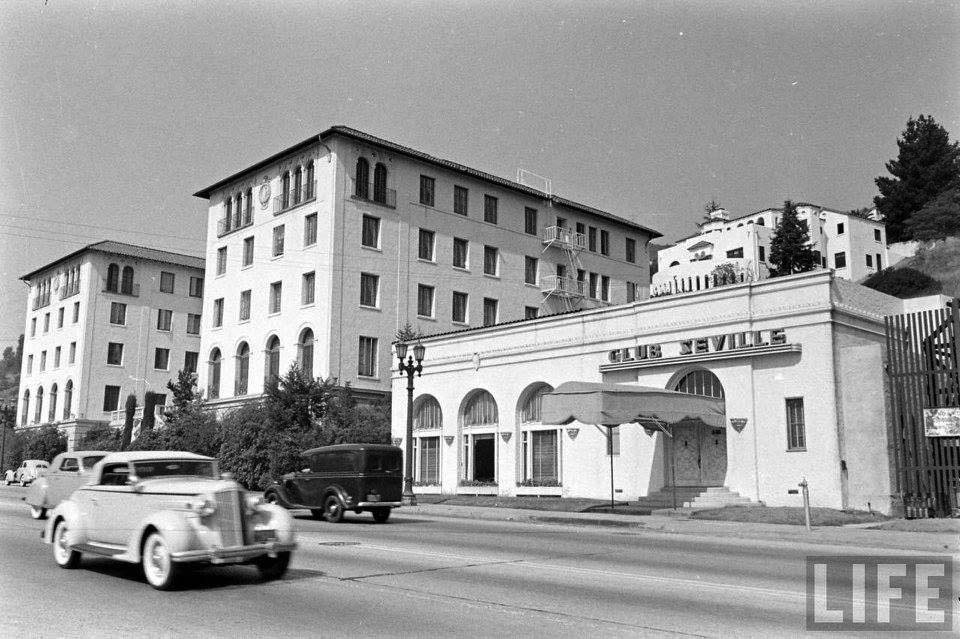 |
|
| (ca. 1938)#**# – Life Magazine photo showing Club Seville (later Ciro's and today The Comedy Store) located at 8433 Sunset Boulevard. To its left is the Hacienda Park Apartments (built in 1927). |
Historical Notes The Club Seville opened New Year’s Eve 1935 and featured a crystal dance floor with subsurface fish, fountains and colored lights in its Crystal Marine Room. In 1940, the building got a face-lift and became known as Ciro’s Nightclub (1940 – 1957). Click HERE for contemporary view. |
Ciro's Nightclub
.jpg) |
|
| (ca. 1940)^#*#^ – Panoramic view showing Ciro’s Nightclub located at the T-intersection of Sunset Boulevard and N. Olive Drive. |
Historical Notes Ciro's (later known as Ciro's Le Disc) was a nightclub in West Hollywood located at 8433 Sunset Boulevard, on the Sunset Strip. It opened in January 1940 by entrepreneur William Wilkerson. Herman Hover took over management of Ciro's in 1942 until it closed its doors in 1957. Co-founder Wilkerson also opened Cafe Trocadero, in 1934, and the restaurant La Rue, both on the Strip, and later originated The Flamingo in Las Vegas, only to have control of the resort wrested from his control by mobster Benjamin "Bugsy" Siegel.*^ |
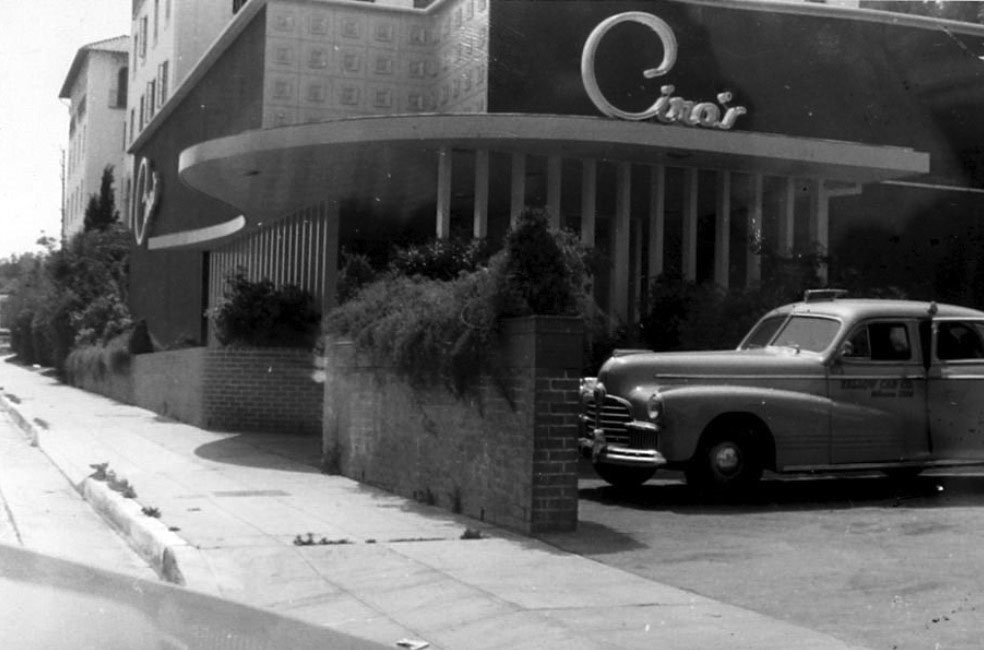 |
|
| (1942)^##* – View showing the entrance to Ciro's Nightclub with a Yellow Cab Co. taxi (’42 Pontiac) in the parking lot. |
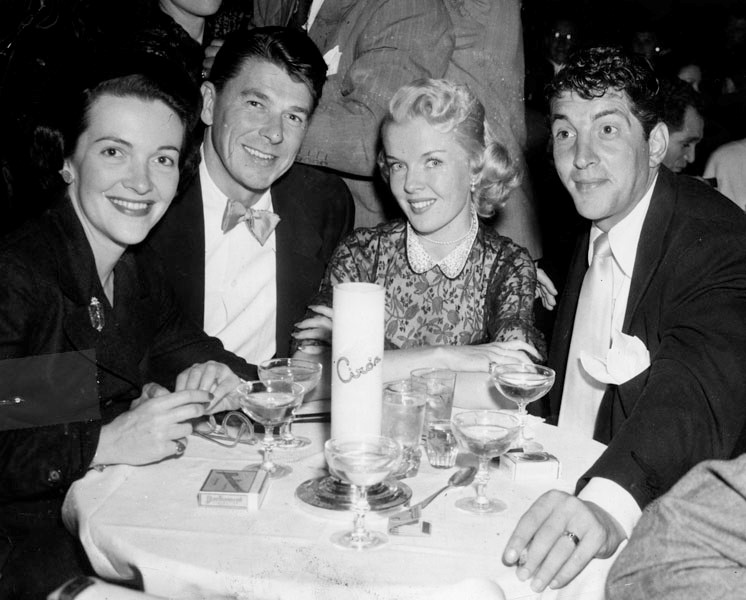 |
|
| (1952)* - Celebrating the upcoming marriage of Nancy Davis (left) to Ronald Reagan, are Jeanne (Biegger) Martin and Dean Martin (right) at Ciro's Nightclub on the Sunset Strip on February 23, 1952. Ain't that a kick in the head! |
Historical Notes Ciro's combined a luxe baroque interior and an unadorned exterior and became a famous hangout for movie people of the 1940s and, 1950s. It was one of "the" places to be seen and guaranteed being written about in the gossip columns of Hedda Hopper, Louella Parsons and Florabel Muir.*^ |
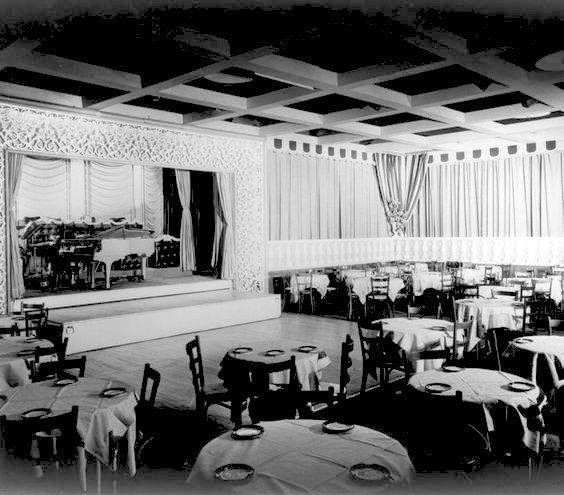 |
|
| (1950s)#**# – Interior view of Ciro’s Nightclub showing tables, dance floor, and stage. High caliber performers appeared here which drew in the top Hollywood celebrities. |
Historical Notes Among the galaxy of celebrities who frequented Ciro's were Marilyn Monroe, Humphrey Bogart and Lauren Bacall, Frank Sinatra, Ava Gardner, Sidney Poitier, Anita Ekberg, Lucille Ball and Desi Arnaz, Joan Crawford, Betty Grable, Marlene Dietrich, Ginger Rogers, Ronald Reagan, Dean Martin, Mickey Rooney, Cary Grant, George Raft, George Burns and Gracie Allen, Judy Garland, June Allyson and Dick Powell, Mamie Van Doren, Jimmy Stewart, Jack Benny, Peter Lawford, and Lana Turner (who often said Ciro's was her favorite nightspot) among many others. During his first visit to Hollywood in the late 1940s, future President John F. Kennedy dined at Ciro's.*^ |
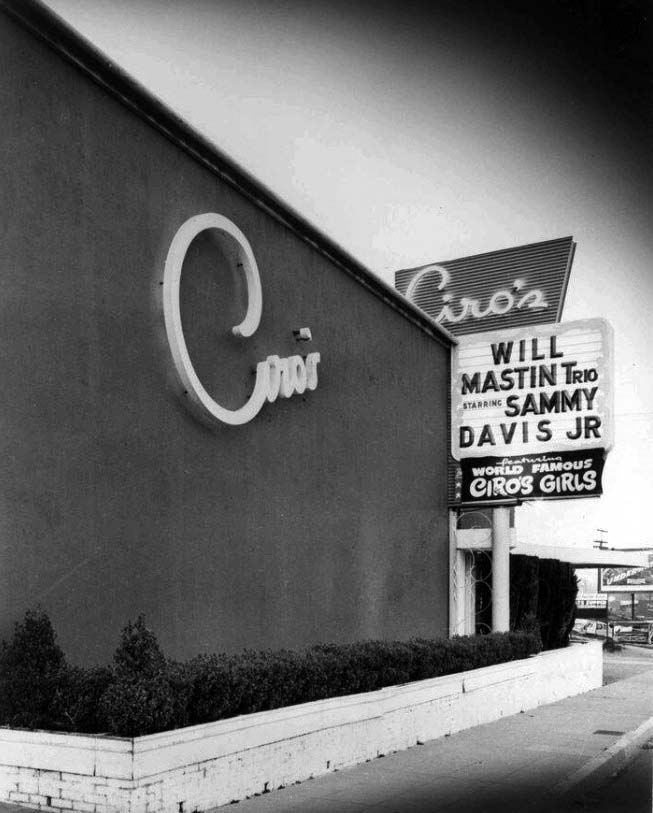 |
|
| (1950s)##^* - View showing the front of Ciro's Nighclub. Marquis reads: "Will Mastin Trio starring Sammy Davis Jr. featuring the World Famous Ciro's Girls." |
 |
|
| (1954)*^#^* - Night view showing Ciro's Nightlcub. Billboard reads: Nat King Cole |
Historical Notes In the 1960s, Ciro's became a Sunset Strip rock and roll club, and was the only major venue on the Strip to make such a transition while keeping its original name. The Byrds got their start there in 1964. Accounts of the period (reproduced in the sleeve notes to The Preflyte Sessions box set) describe a "church-like" atmosphere, with interpretive dancing. The club also served as the host during the recording of the 1965 Dick Dale album "Rock Out With Dick Dale: Live At Ciro's" The site of Ciro's became Art Laboe's circa 1970 and the The Comedy Store in 1972.*^ |
Art Laboe's
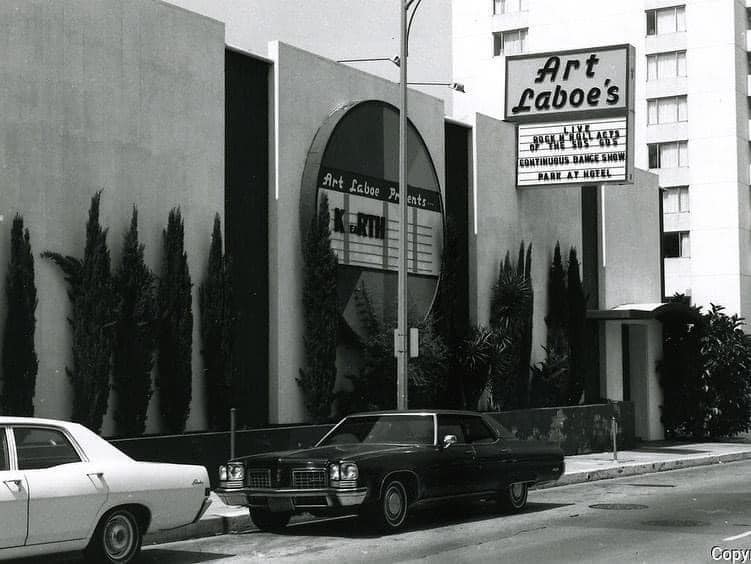 |
|
| (ca. 1970)* - 8433 Sunset Boulevard - After Ciro’s and before The Comedy Store. |
The Comedy Store
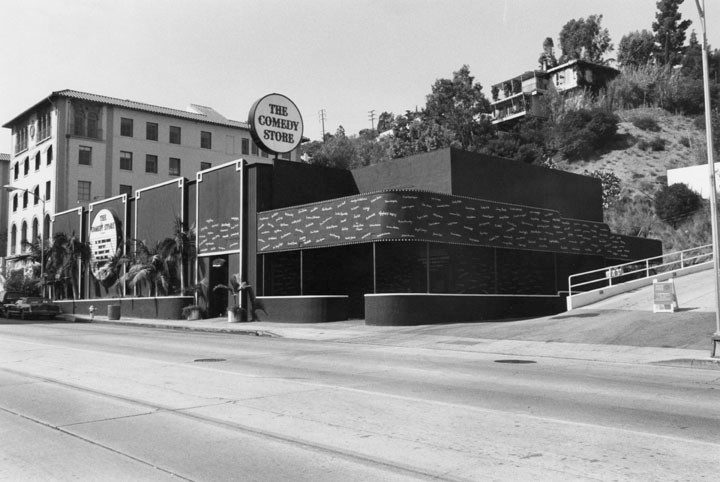 |
|
| (1991)* - Picture taken from across the street showing The Comedy Store on the Sunset Strip. At one time this was Ciro's Nightclub. |
Historical Notes The Comedy Store was opened in April 1972 by comedians Sammy Shore and Rudy DeLuca. The building was formerly the home of Ciro's, a popular Hollywood nightclub owned by William Wilkerson, and later a rock and roll venue, where The Byrds were discovered in 1964. When the venue reopened as The Comedy Store in 1972, it included a 99-seat theatre, where Johnny Carson was one of the first comics to perform. As a result of a divorce settlement, Sammy Shore's ex-wife Mitzi Shore began operating the club in 1973, and she was able to buy the building in 1976. She immediately renovated and expanded the club to include a 450-seat main room.*^ |
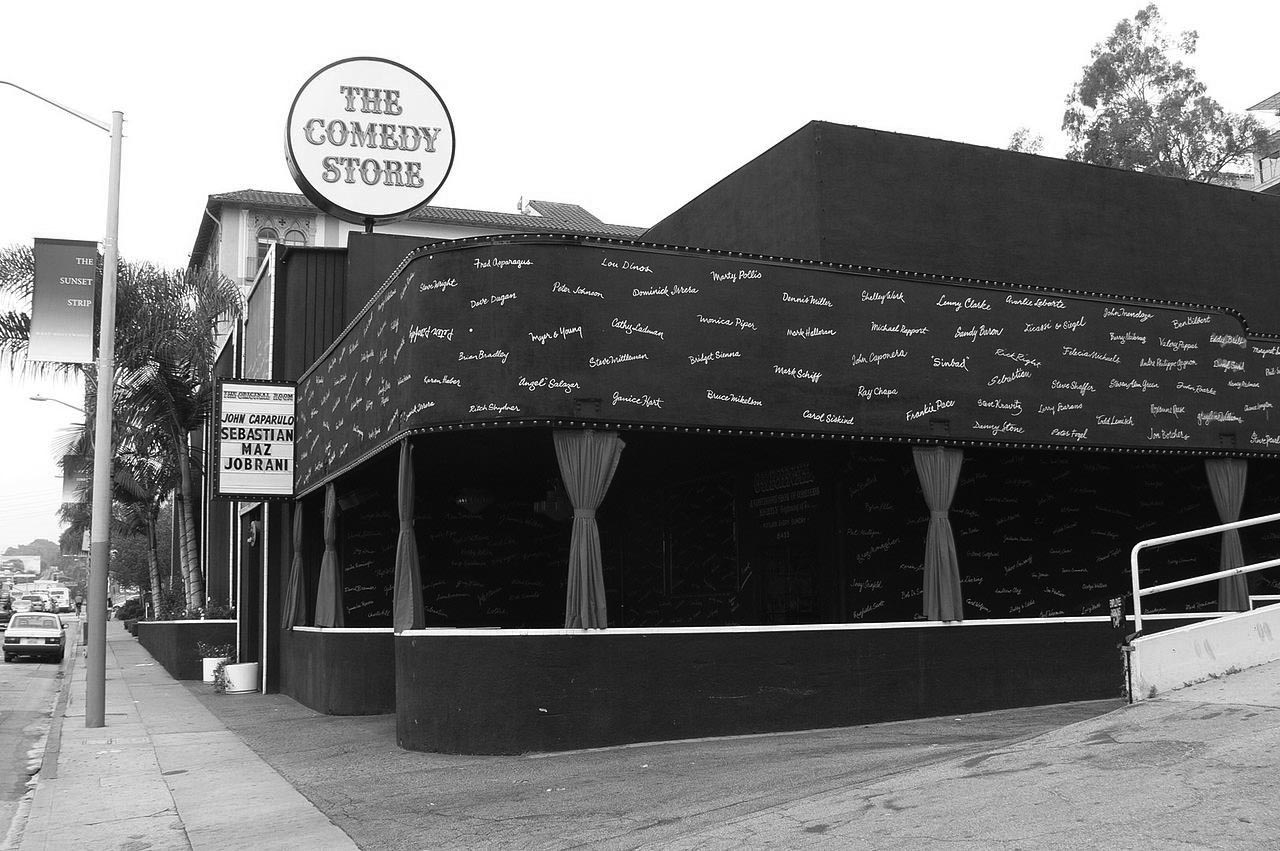 |
|
| (2006)*^ - Close-up view showing The Comedy Store, 8433 W. Sunset Blvd., West Hollywood. Photo by Mike Dillon |
Historical Notes The Comedy Store has featured performances from every important comedian. The names of its headliners are vaunted on its outside walls. This was once the site of Ciro’s, one of Hollywood’s most popular nightclubs during the 1940s and 1950s. The building is supposedly haunted. TV’s “Access Hollywood” once brought in a psychic, billed her as a “spiritual journalist,” and had her talk about angry mobsters still supposedly trapped in the building’s basement. ^^+ |
Mocambo Nightclub
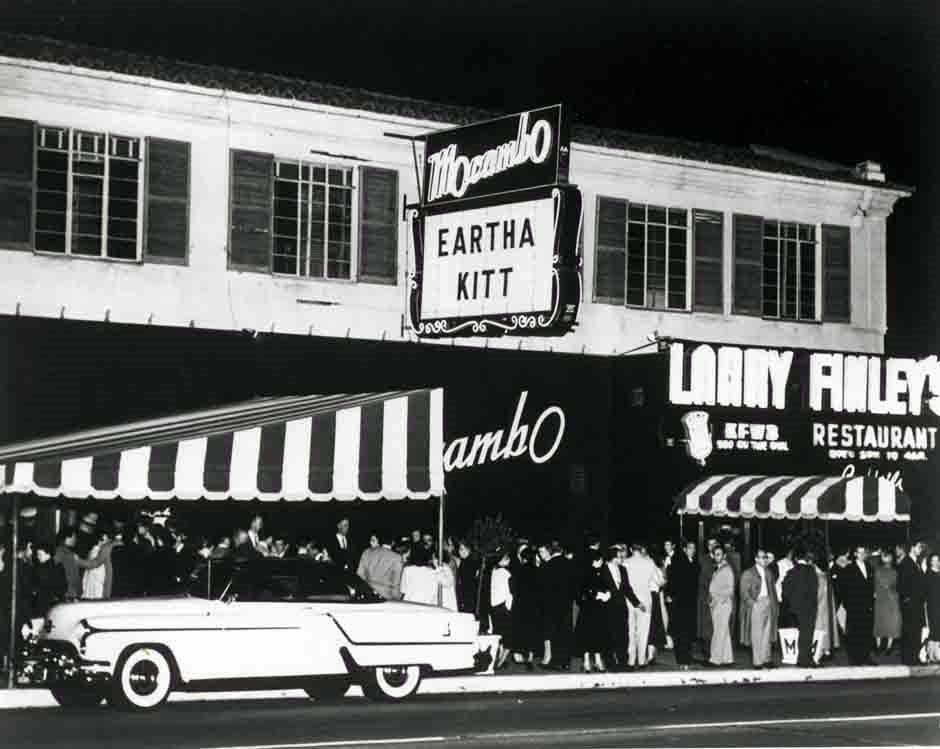 |
|
| (ca. 1952)**## – View showing the famous Mocambo Nightclub at 8588 Sunset Boulevard on the Sunset Strip. It opened in January 1941 and was one of the biggest and most famous of the Sunset Strip club through the 40s and 50s. It’s shown here when Eartha Kitt was the headliner. |
Historical Notes The Mocambo opened on January 3, 1941, and became an immediate success. It was owned by Charlie Morrison and Felix Young. The club's Latin American-themed decor designed by Tony Duquette cost $100,000 (equivalent to $1,663,801 in 2017). Along the walls were glass cages holding live cockatoos, macaws, seagulls, pigeons, and parrots. With big band music, the club became one of the most popular dance-till-dawn spots in town. On any given night, one might find the room filled with the leading men and women of the motion picture industry. In 1943, when Frank Sinatra became a solo act, he made his Los Angeles debut at the Mocambo. On March 15, 1955 Ella Fitzgerald opened at the Mocambo, after Marilyn Monroe lobbied the owner for the booking. The booking was instrumental in Fitzgerald's career. The incident was turned into a play by Bonnie Greer in 2005.*^ |
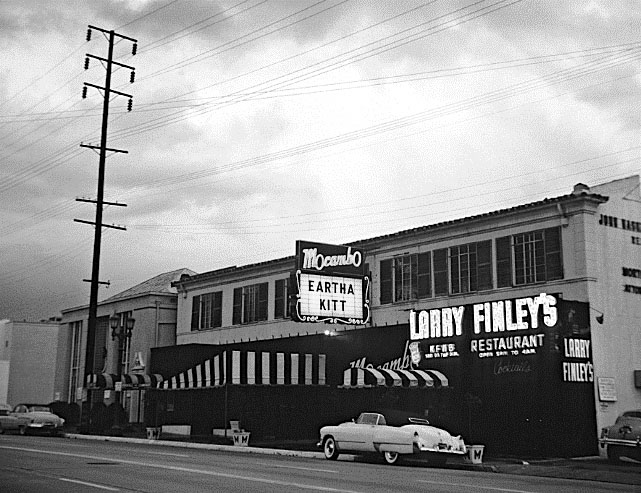 |
|
| (ca. 1952)**## - Daytime view of Mocambo Nightclub on the Strip. |
Historical Notes Among the many celebrities who frequented the Mocambo were Clark Gable and Carole Lombard, Humphrey Bogart and Lauren Bacall, Errol Flynn, Charlie Chaplin, Elizabeth Taylor, Judy Garland, Henry Fonda, Lana Turner, Ava Gardner, Bob Hope, James Cagney, Sophia Loren, Janet Leigh and Tony Curtis, Natalie Wood and Robert Wagner, Grace Kelly, Debbie Reynolds and Eddie Fisher, Howard Hughes, Kay Francis, Marlene Dietrich, Theda Bara, Tyrone Power, Jayne Mansfield, John Wayne, Ben Blue, Ann Sothern, and Louis B. Mayer. Myrna Loy and Arthur Hornblow, Jr. celebrated their divorce there. The club's main stage was replicated on the TV series I Love Lucy as the "Tropicana" Club. Lucille Ball and Desi Arnaz were frequent guests at the Mocambo and were close friends of Charlie Morrison. Early in 1957, club operator and co-owner Charlie Morrison died at his Beverly Hills home. The Mocambo remained in business for one final year, before closing its doors on June 30, 1958. The building was then sold, reopened as a supper club called The Cloister, and eventually demolished.*^ |
* * * * * |
The Strip
 |
|
| (n.d.)#**# - A wall decoration in Disney Hollywood Studios Florida showing a map of West Hollywood in the 1930s. Highlighted names along "The Strip" include: Chateau Marmont, Garden of Allah, Sunset Tower, Clovera Club, La Maze, Villa Nova, Little Hungary, The Cock and Bull, Trocadero, Ted Snyder, Phil Selznick, Ray Hallers and Eddie Cantor*. |
Historical Notes *Eddie Cantor, born Edward Israel Iskowitz, was a comedian, dancer, singer, actor, and songwriter. He is also known for being the second president of the Screen Actors Guild, serving from 1933 to 1935. He invented the title "The March of Dimes" for the donation campaigns of the National Foundation for Infantile Paralysis, which was organized to combat polio. It was a play on the The March of Time newsreels popular at the time. He began the first campaign on his radio show in January 1938, asking listeners to mail a dime to President Franklin D. Roosevelt. At that time, Roosevelt was the most notable American victim of polio. Other entertainers joined in the appeal via their own shows, and the White House mail room was deluged with 2,680,000 dimes—a large sum at the time.*^ |
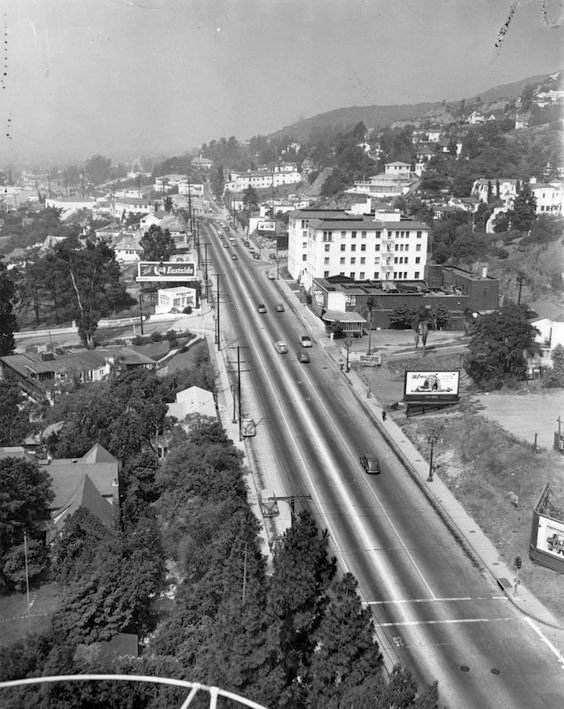 |
|
| (1949)*– View looking down upon the Sunset Strip from the roof of the Sunset Tower. On the right, that's Ciro's Nightclub (now The Comedy Store) and the Coronet Apartments (originally the Hacienda Park Apartments and now the Piaza del Sol office building). Just beyond them, the building that housed the Clover Club can be seen. Note that, across the street from Ciro's, on the southeast corner of Olive and Sunset, is the home that is now the House of Blues. Closer in may be the roof of a house owned by John Barrymore in the 1930s. |
Historical Notes The Hacienda Park Apartments (renamed Coronet Apartments in late 1930s) was built in 1927 and operated initially as a luxury apartment building catering to the entertainment business. In the 1930s, it became the "most famous brothel in California." The building declined in prestige in the 1950s and 1960 and was acquired by rock star Rod Stewart in the 1970s. After Stewart's plans to redevelop the building as a luxury hotel ended in a legal dispute, the building was nearly destroyed in a 1983 fire that was found to be of suspicious origin. Since 1986, it has been known as the Piazza del Sol, and it now houses the offices of several production companies, including Miramax Films. The restaurant Katana, co-owned by Ryan Seacrest and Tori Spelling and described by Newsweek as "so hip it hurts," also operates at the building.*^ A check of the Piazza del Sol’s listing in the National Register reveals a quirk in the record. The Register shows its original name as Hacienda Arms Apartments, not the Hacienda Park Apartments – a name that in 1927 connected the building to the neighborhood around it, Hacienda Park. It’s by no means a fatal error, and the rest of the information appears to be correct, but this small mistake has been magnified over the years – picked up and repeated in dozens of articles and books, including, for example, the headline of the building’s Wikipedia page.* |
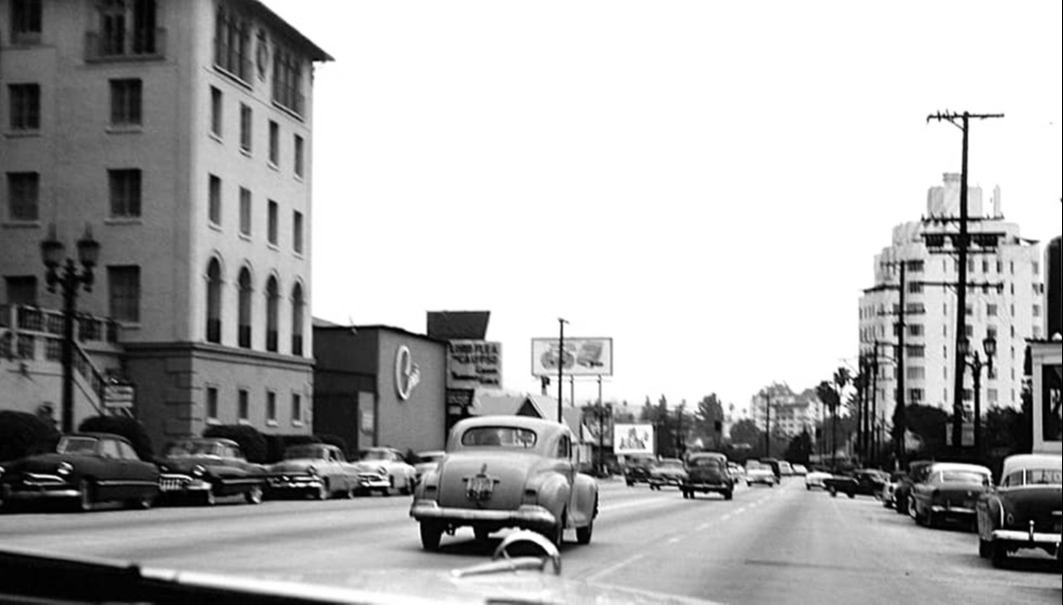 |
|
| (1950)* – Looking east on the 8400 block of Sunset Strip in front of the Coronet Apartments (today Piazza del Sol) and Ciro’s Nightclub (today The Comedy Store). On the right can be seen the 1931-built Art Deco Sunset Tower Apartments. |
Then and Now
 |
|
| (1950 vs 2022)* – Looking east on the 8400 block Sunset Strip in front of the Coronet Apartments (today Piazza del Sol) and Ciro’s Nightclub (today The Comedy Store). In lower photo can be seen the famous 1963-built Continental Hyatt House (east of The Comedy Store). |
 |
|
| (1957)* - Night view looking west along 'The Strip' from the roof of the Sunset Tower. The empty lot at the lower-right sits on the NW corner of Sunset and N. Kings Road. In 1963, the 14-story Gene Autry Hotel would be built here. In the 70s it would evolve into the legendary Hyatt on Sunset where touring rock bands often stayed. In the distance, center-top, stands the Coronet Apartments. |
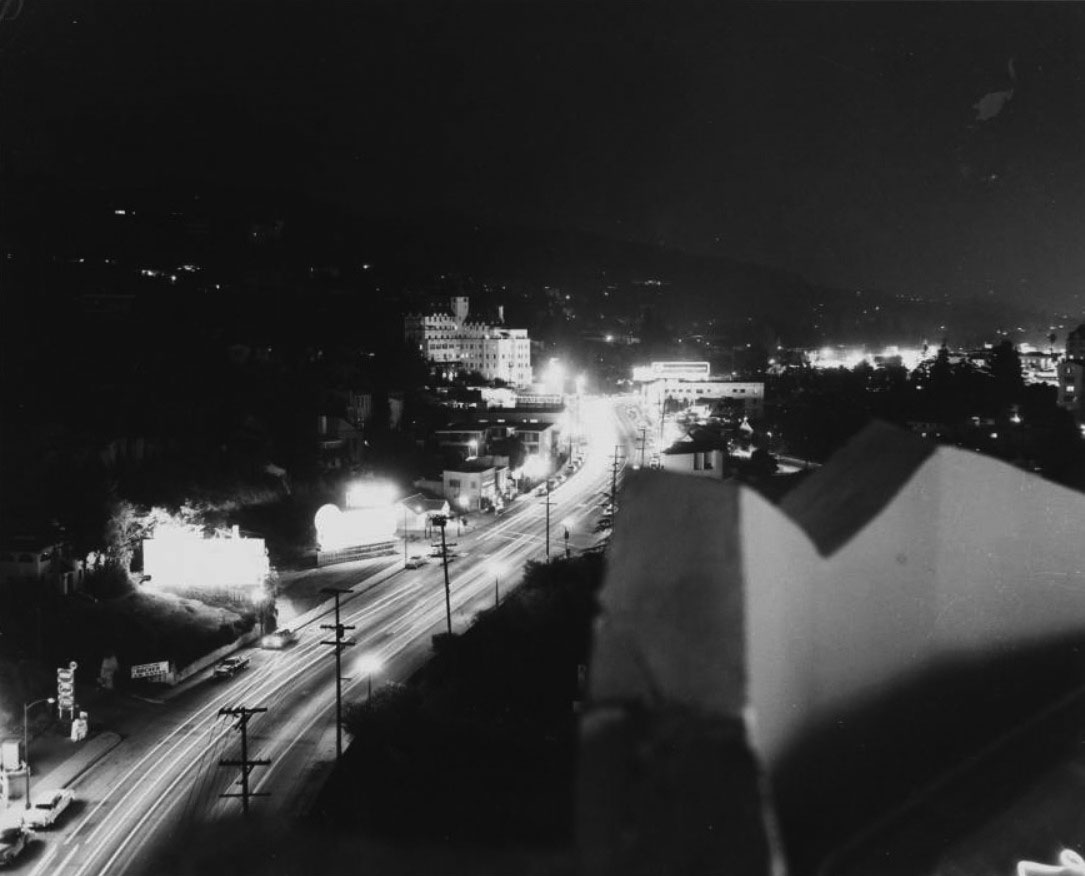 |
|
| (1957)^^ – Atmospheric shot looking northeast along 'The Strip' from the roof of the Sunset Tower, with the Chateau Marmont Hotel seen in the distance. |
Cafe Trocadero
 |
|
| (ca. 1936)* - Exterior view of the famous Cafe Trocadero located on the Sunset Strip. A second sign below the nightclub name reads, "Phil Ohman's Music." |
Historical Notes The Cafe Trocadero was the center of jitterbug in the 1930s. A black tie French-inspired supper club, the original Trocadero, now demolished, was considered the jewel of the Strip in the 1930s and became synonymous with stars, starlets, movie producers, and fun.*^ |
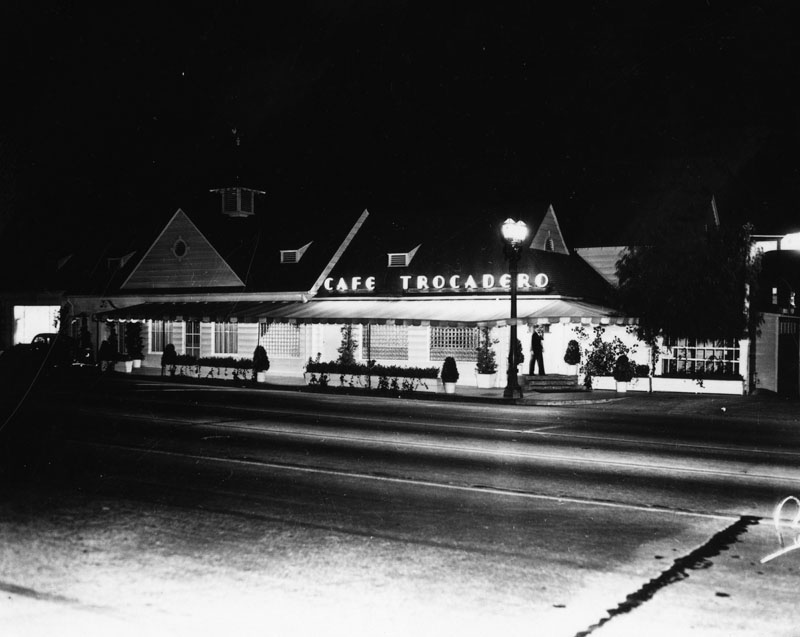 |
|
| (ca. 1937)* - Night view of the Cafe Trocadero, located at 8610 Sunset Boulevard in what is now West Hollywood. |
Historical Notes Originally known as the La Boheme from 1929 to 1933, the Café Trocadero was opened by William R. Wilkerson in 1934. Wilkerson was the successful publisher of The Hollywood Reporter who also owned other nightclubs nearby on the Sunset Strip like Ciro's and LaRue.*^ |
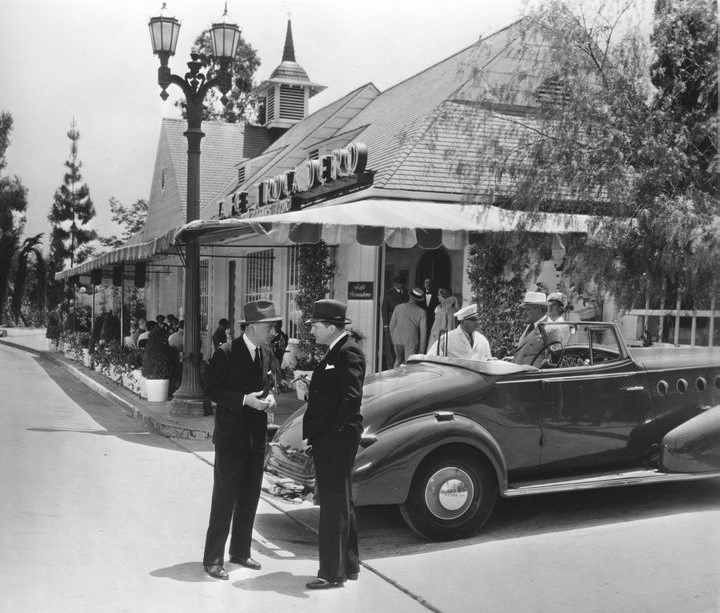 |
|
| (1936)* - Patrons at the Cafe Trocadero before the nightclub was remodeled. Note how the awnings drape around the post of the ornate dual-lamp streetlight. Click HERE to see more in Early Views of LA Streetlights. |
Historical Notes Among the celebrities who frequented the Trocadero were Fred Astaire, Bing Crosby, Cary Grant, Myrna Loy, Jackie Gleason, Henry Fonda, Judy Garland, Lucille Ball, Desi Arnaz, Jean Harlow, and Norma Shearer. The Trocadero was featured in the 1937 movie A Star is Born starring Janet Gaynor and Fredric March.*^ |
 |
|
| (1936)* - Patrons at the Cafe Trocadero before the nightclub was remodeled. Note how the awnings drape around the post of the ornate dual-lamp streetlight. Image enhancement and colorization by Richard Holoff. |
Historical Notes The streetlights seen above are known as 'Metropolitan Streetlights', predominately found in Hollywood. Click HERE to see more in Early Views of LA Streetlights. |
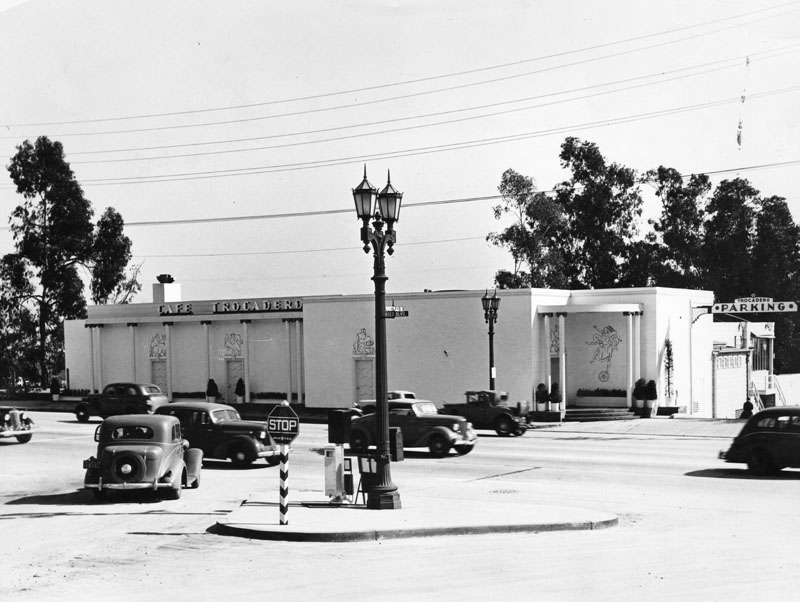 |
|
| (1938)* - Exterior view of the Cafe Trocadero shortly after it underwent extensive remodeling. Note the art designs on the wall and above each of the doors. |
Historical Notes The building was remodeled in 1938 by new owners Bugsy Siegel and Mickey Cohen. |
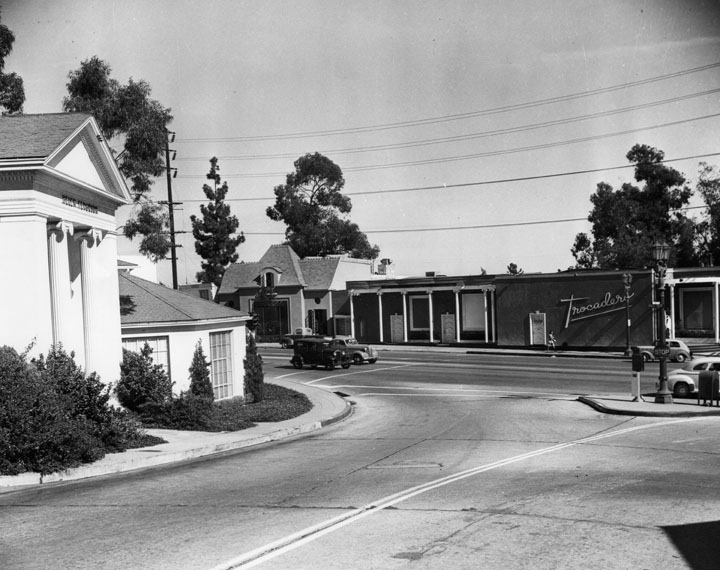 |
|
| (ca. 1945)* - Exterior view of Cafe Trocadera as seen from where Sunset Plaza Drive (foreground) meets Sunset Boulevard. |
Historical Notes After years of serving as one of Hollywood's best evening destinations, the "Troc" closed in 1946.* Today, a "new" Trocadero stands as a nightclub at 8610 Sunset Boulevard on the Sunset Strip. |
Sunset Plaza
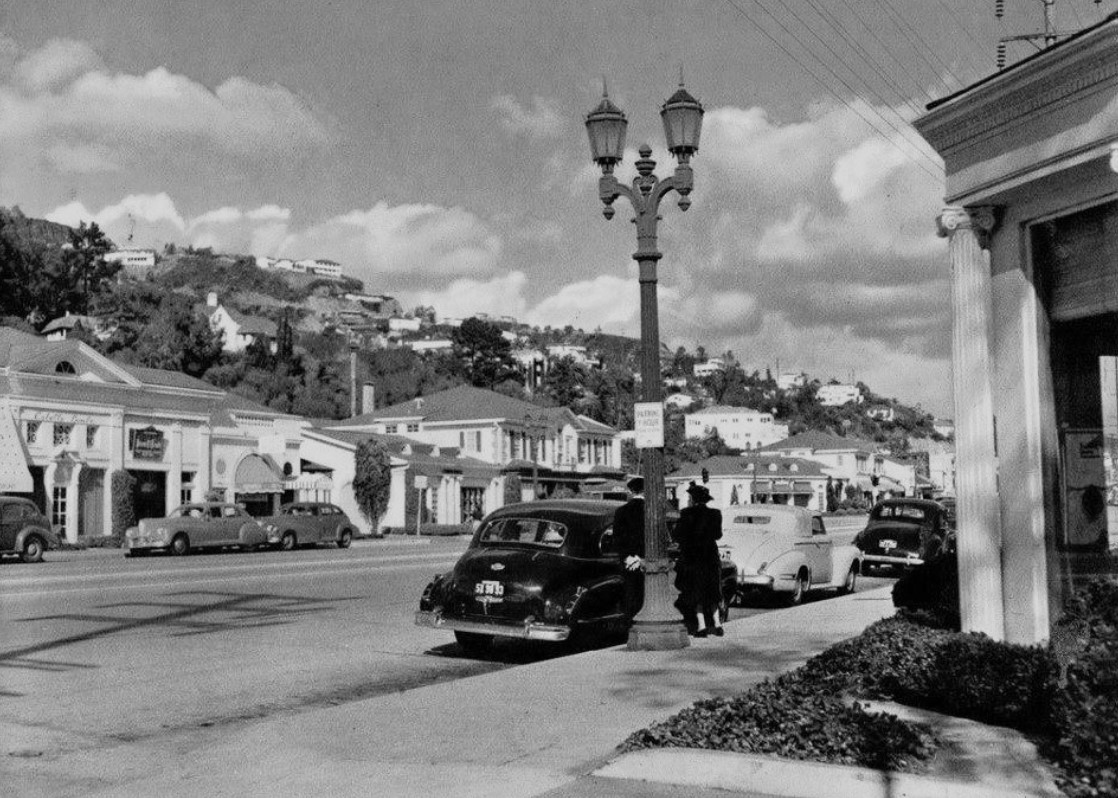 |
|
| (1946)* - View looking east of Sunset Plaza located on the 8600 block of W. Sunset Boulevard, West Hollywood |
Historical Notes Opened in 1924, Sunset Plaza was the first commercial development on the Sunset Strip. Today it is an exclusive shopping complex that draws an A-list clientele to its designer boutiques and chic sidewalk cafes and restaurants. The Sunset Plaza is located on both sides of Sunset Boulevard between La Cienega and San Vicente at Sunset Plaza Drive. |
1940s.jpg) |
|
| (1940s)*– View looking north on Sunset Plaza Drive from Sunset Boulevard. A Christmas tree stands on the island in the middle of Sunset Plaza. A sign below the tree reads, "Sunset Plaza - Merry Christmas". |
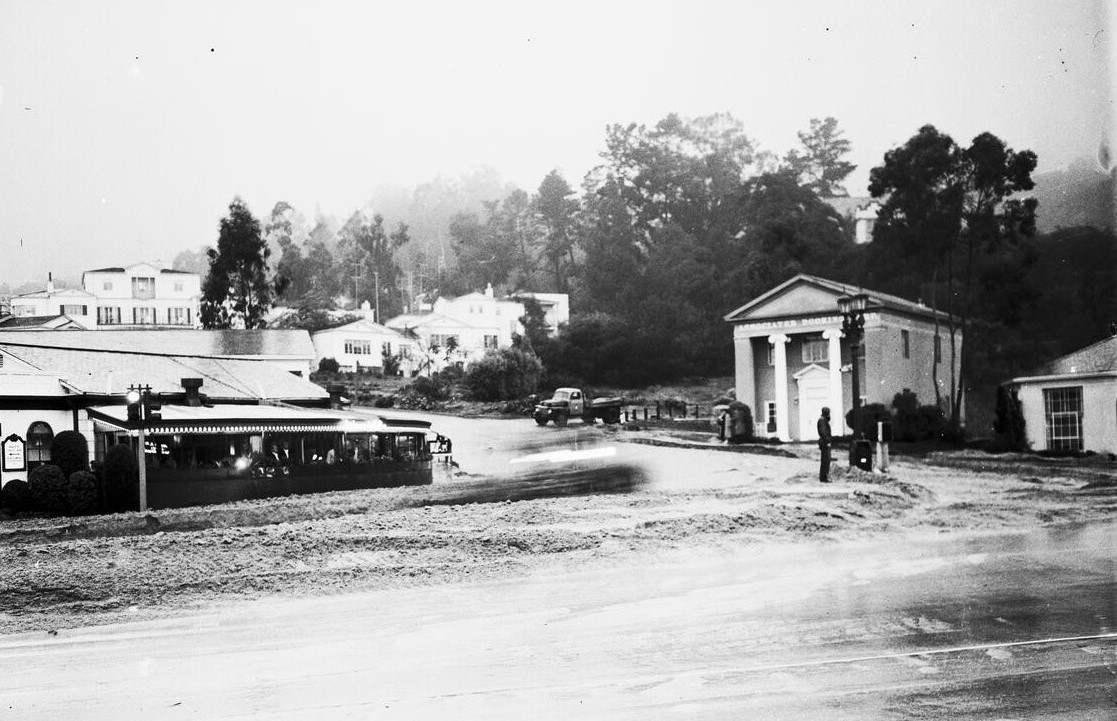 |
|
| (1952)* - Sunset Boulevard at Sunset Plaza Drive after a storm. Photo date: March 15, 1952. |
 |
|
| (2016)* - View looking north showing the intersection of Sunset Plaza Drive and Sunset Boulevard as it appears today. |
Then and Now
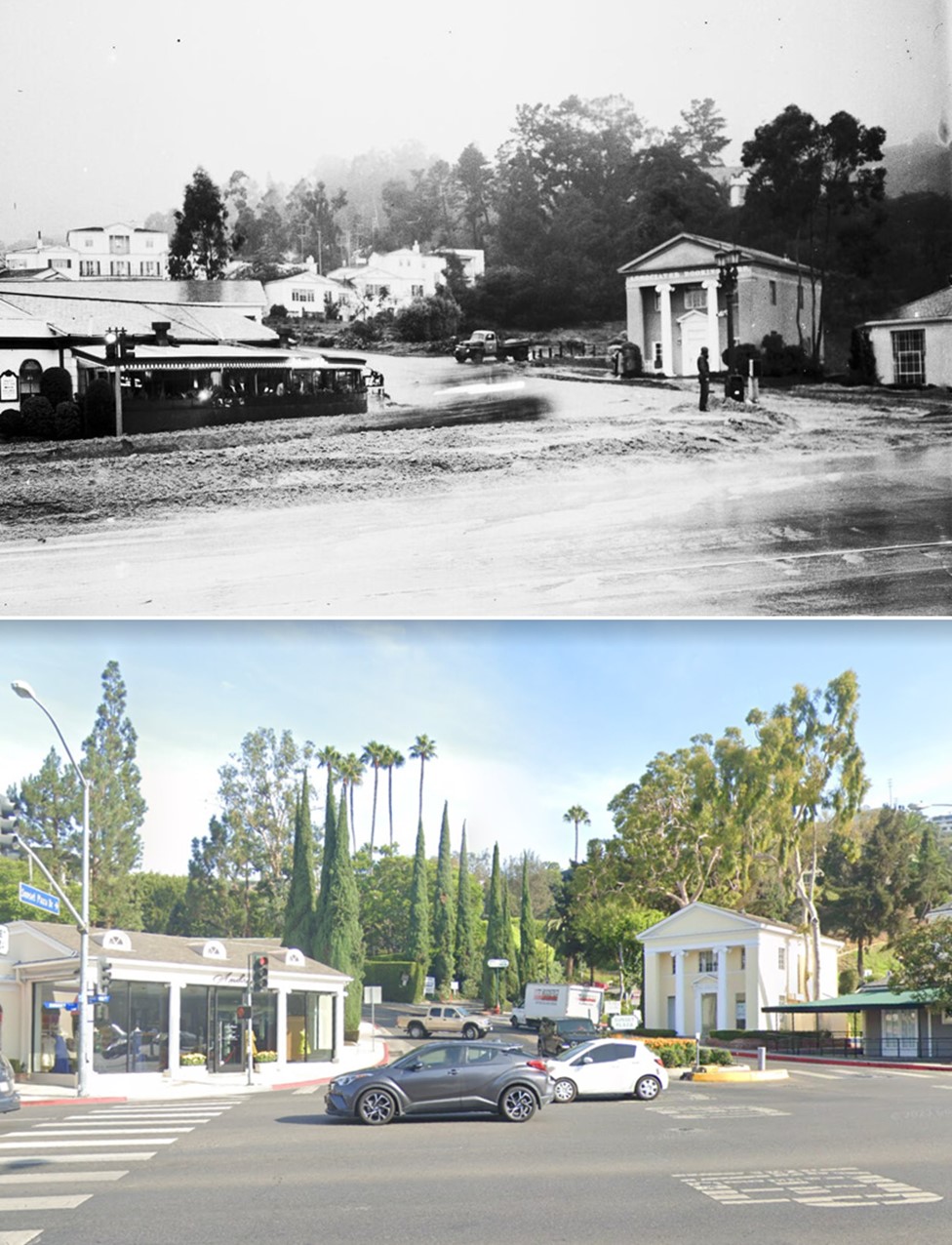 |
|
| (1952 vs 2022)* - Sunset Boulevard at Sunset Plaza Drive. |
Then and Now
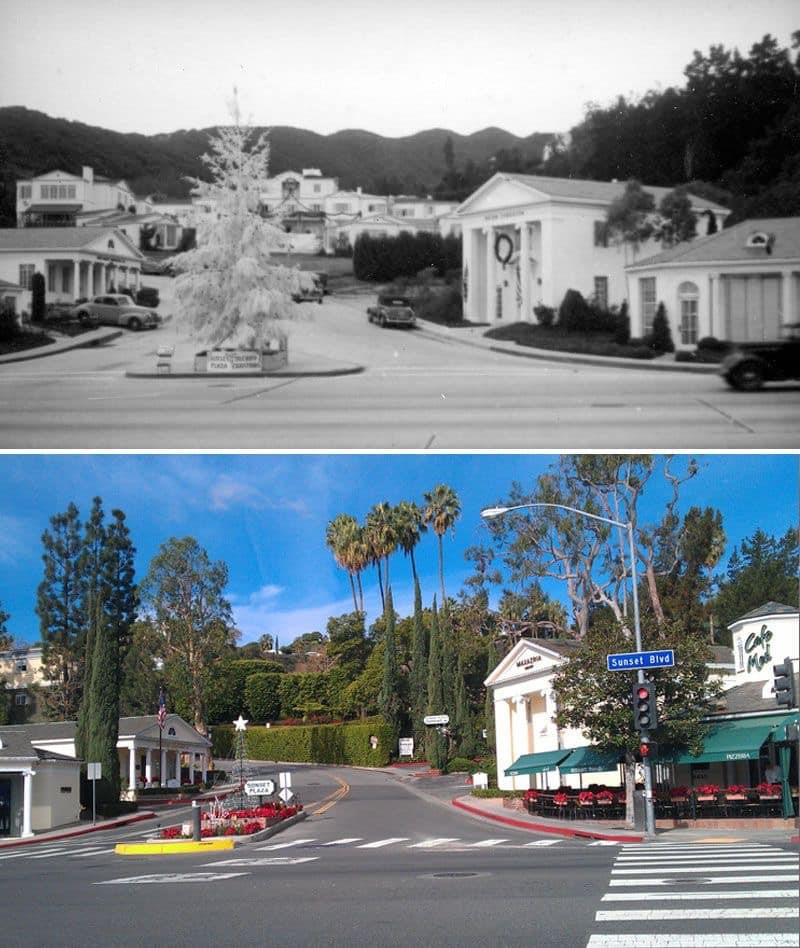 |
|
| Then and Now |
Wil Wright's Ice Cream
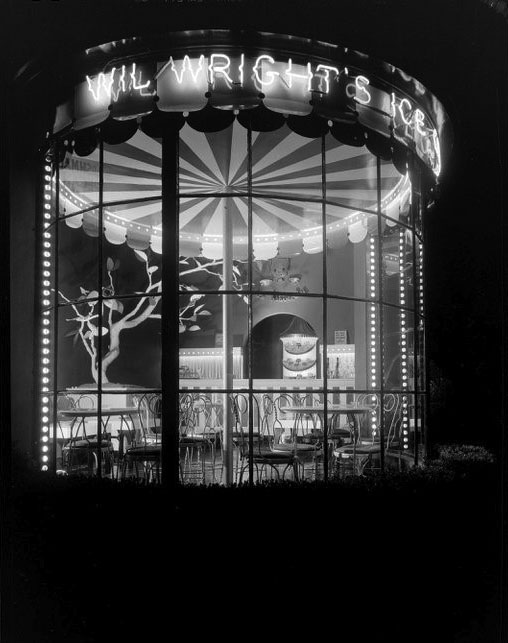 |
|
| (1950)^.^ - Wil Wright's Ice Cream located at 8651 Sunset Boulevard at Sunset Plaza. This is currently a display window for a women's clothing store (Michale Nusskern) |
Historical Notes Wil Wright’s was a chain of ice cream parlors that dotted the Southern California landscape up until the mid-seventies. In addition to the West Hollywood location, they could be found in Beverly Hills (corner of Beverly Drive and Charleville), Westwood Village (corner of Glendon and Lindbrook), Pacific Palisades (San Vicente), Sherman Oaks (corner of Ventura and Van Nuys Blvd). They were the perfect place to take a date after the movie. The delicate pink and red decor and little marble tables and wire-frame chairs made you feel like you were seated inside a Valentine’s Day card. |
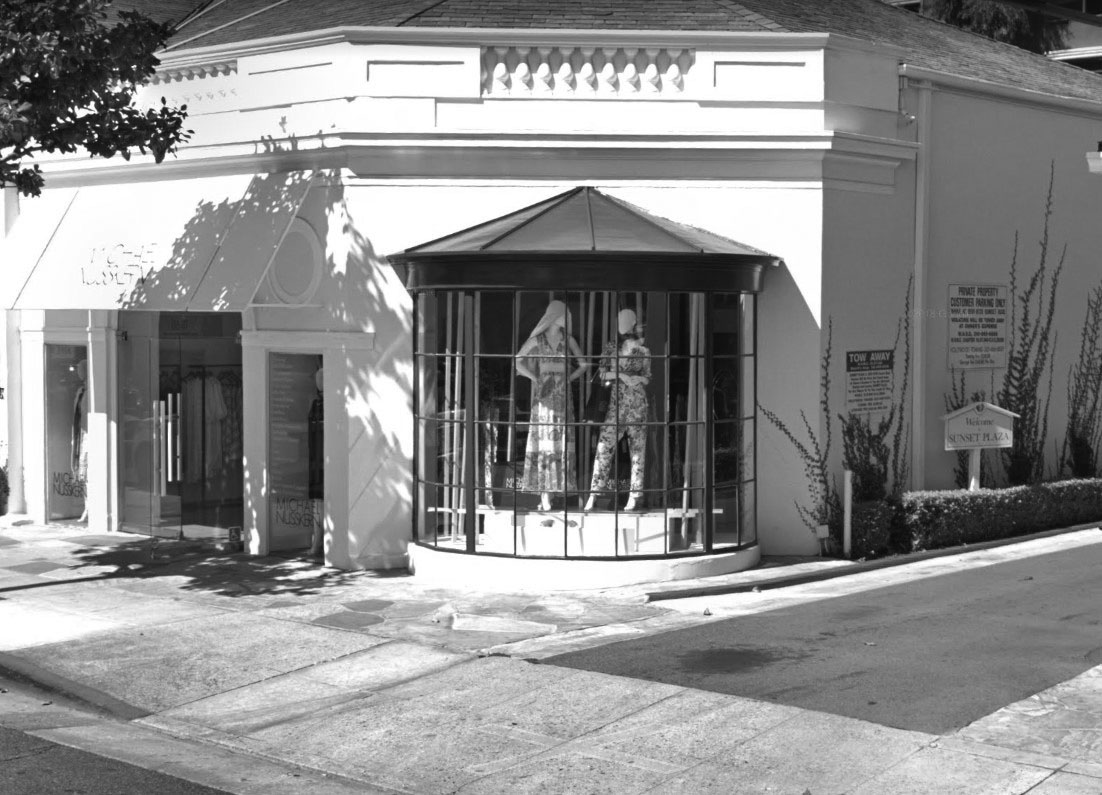 |
|
| (2018)^^- View showing window display of Michale Nusskern clothing store, previous location of Wil Wright's Ice Cream. |
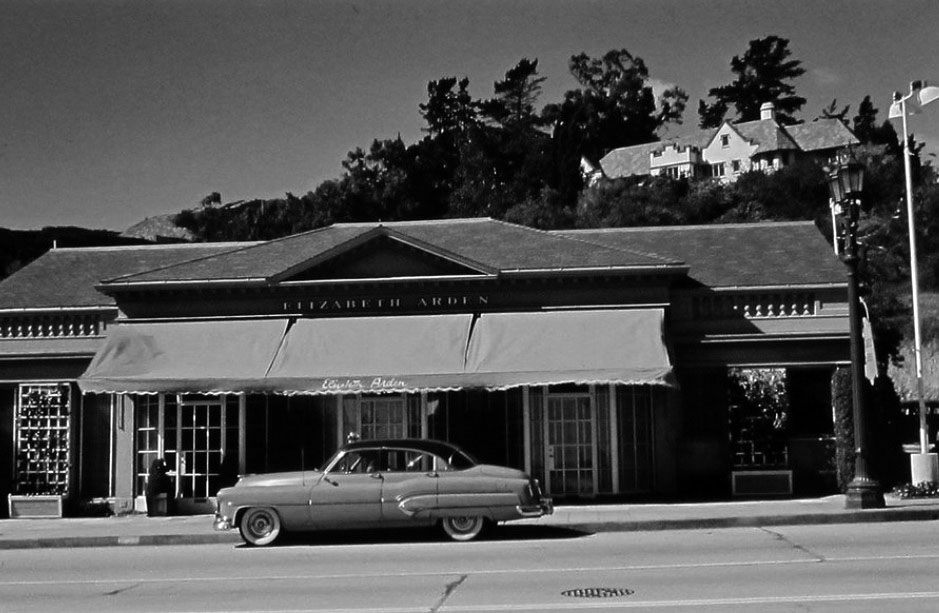 |
|
| (ca. 1955)^##* - View showing a car parked in front of Elizabeth Arden at Sunset Plaza. |
Historical Notes Florence Nightingale Graham (1878 – 1966), who went by the business name Elizabeth Arden, was a Canadian American businesswoman who founded what is now Elizabeth Arden, Inc., and built a cosmetics empire in the United States. By 1929 she owned 150 upscale salons across the United States and Europe. Her 1000 products were found in the luxury market in 22 countries. She was the sole owner, and at the peak of her career, she was one of the wealthiest women in the world.*^ |
Pupi's Bakery and Sidwalk Café
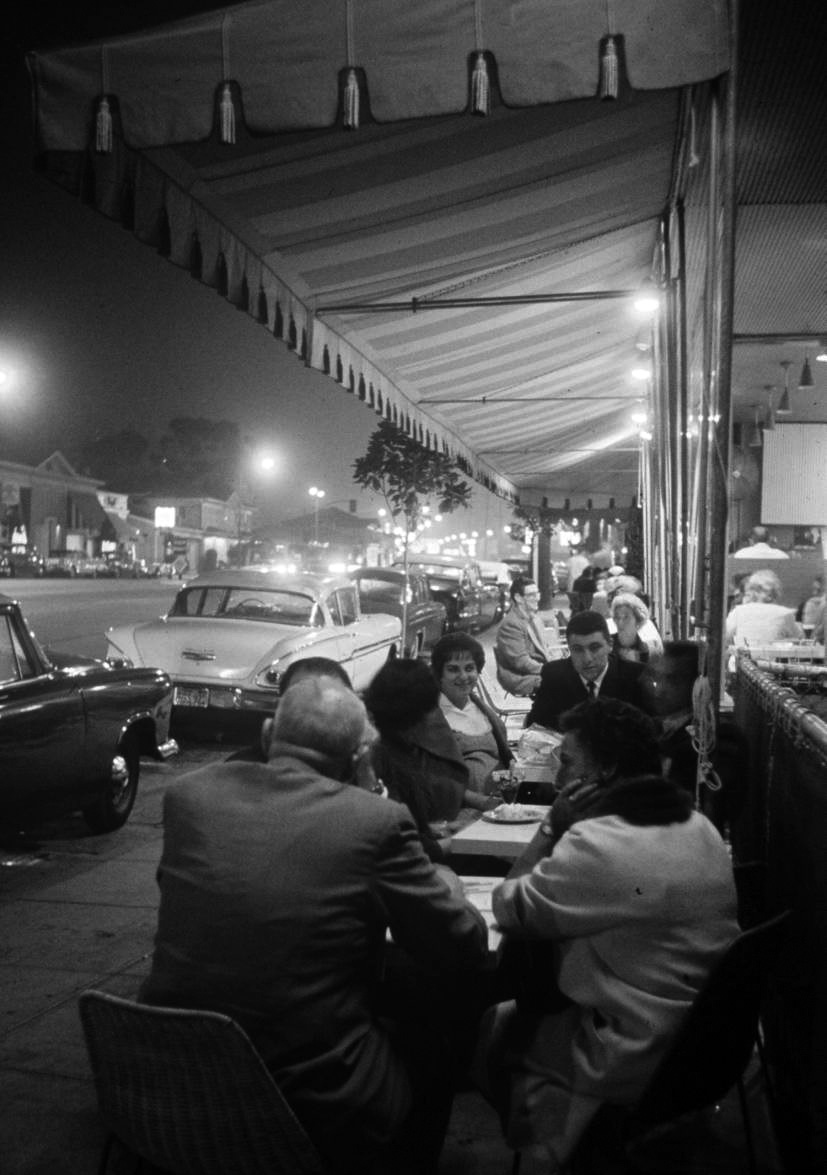 |
|
| (ca. 1958)* – Pupi’s Bakery and Sidwalk Café located on the Sunset Strip near the Sunset Plaza |
Historical Notes Pupi’s, which opened in the mid- to late 1950s, sat on the south side of the Sunset Strip, in the historically upscale portion known as Sunset Plaza. It had a striped awning over sidewalk tables, but the little flagstone patio was the real attraction, along with some Perspex that blocked the wind coming up from the great sweep that separated its patrons from the wider Los Angeles Basin below.^ |
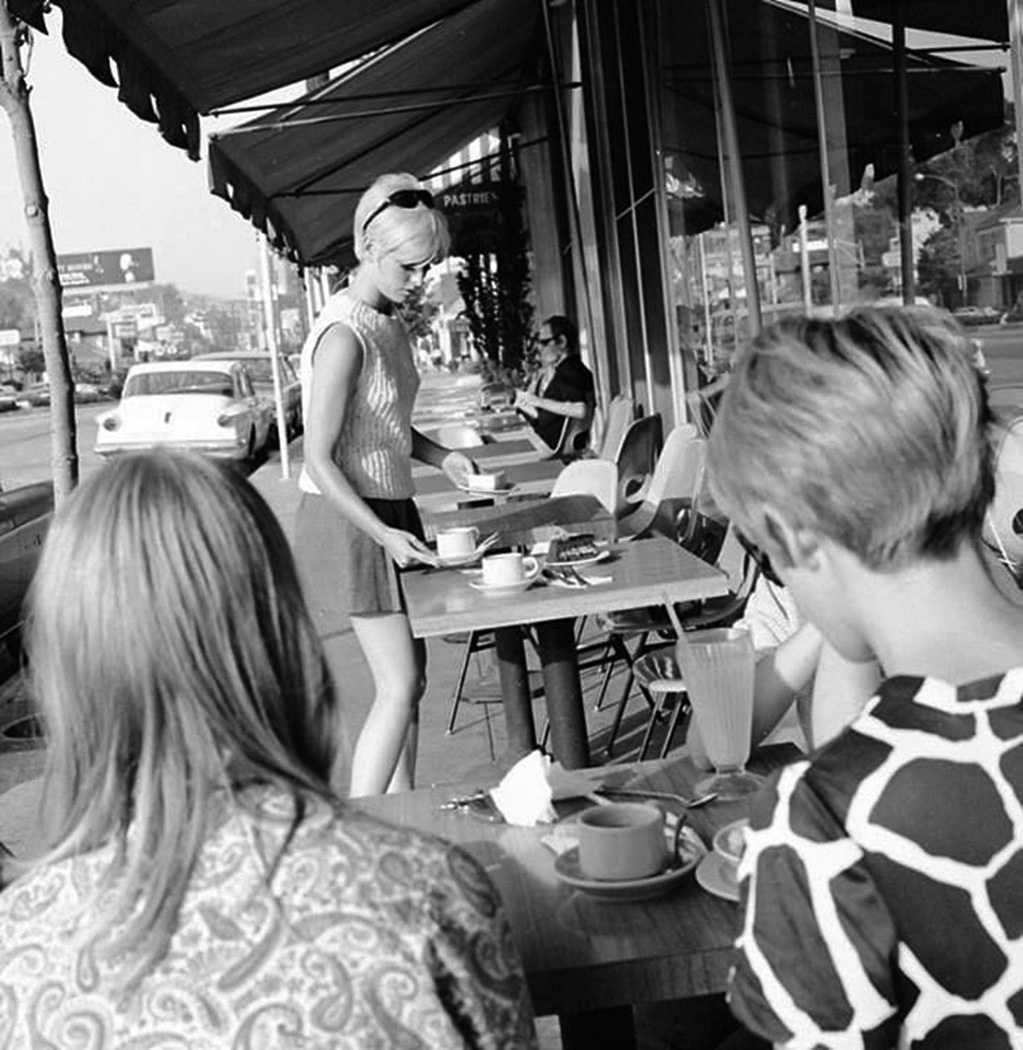 |
|
| (1967)* - Pupi's Bakery and Café located at 8710 Sunset Boulevard...just west of Sunset Plaza. |
Historical Notes Nothing like sitting at the outside tables and wathcing everyone walk by including some famous movie stars. |
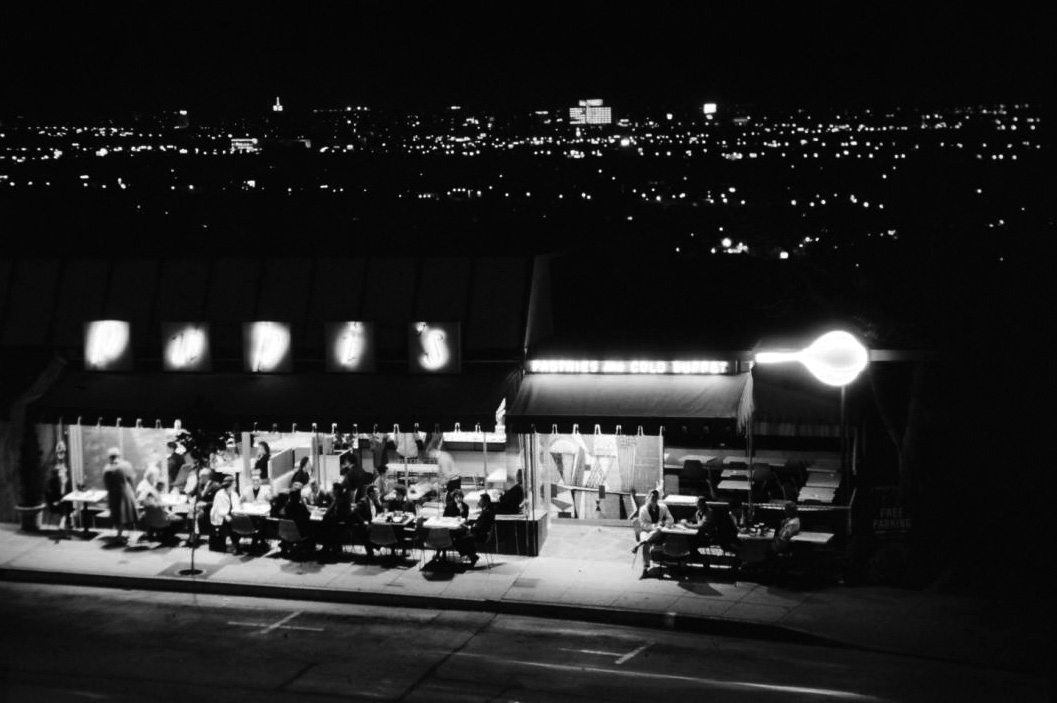 |
|
| (ca.1973)* - Nighttime panoramic view of Pupi's Bakery and Café with the city lights in the background. Life Magazine |
Historical Notes Pupi’s is where Jack Nicholson flew into one of his storied rages one night, quarreling with a waitress and threatening to kick in a pastry cart. That is the incident Carole Eastman said she drew on when she wrote the famous “no substitutions” scene for Bobby Dupea (Jack’s character) in Five Easy Pieces.^ |
Sunset Plaza
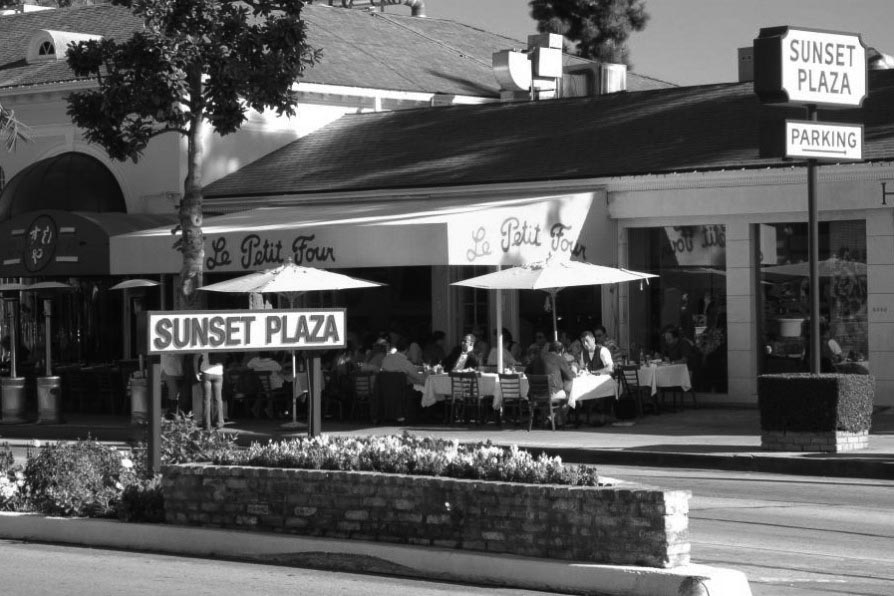 |
|
| (2011)#+++ – View showing people dining at the Le Petit Four Restaurant on the Sunset Strip in the Sunset Plaza of West Hollywood. |
Historical Notes Today, the Sunset Plaza is a two-block cluster of hip outdoor cafes, boutiques, hair salons, and other stores whose prices rival those of Rodeo Drive’s. It is one of the best people watching places in West Hollywood. ^^+ |
.jpg) |
|
| (2016)^++ – View looking east on Sunset Boulevard at Sunset Plaza showing people dining at Le Petit Four seen in the foreground. |
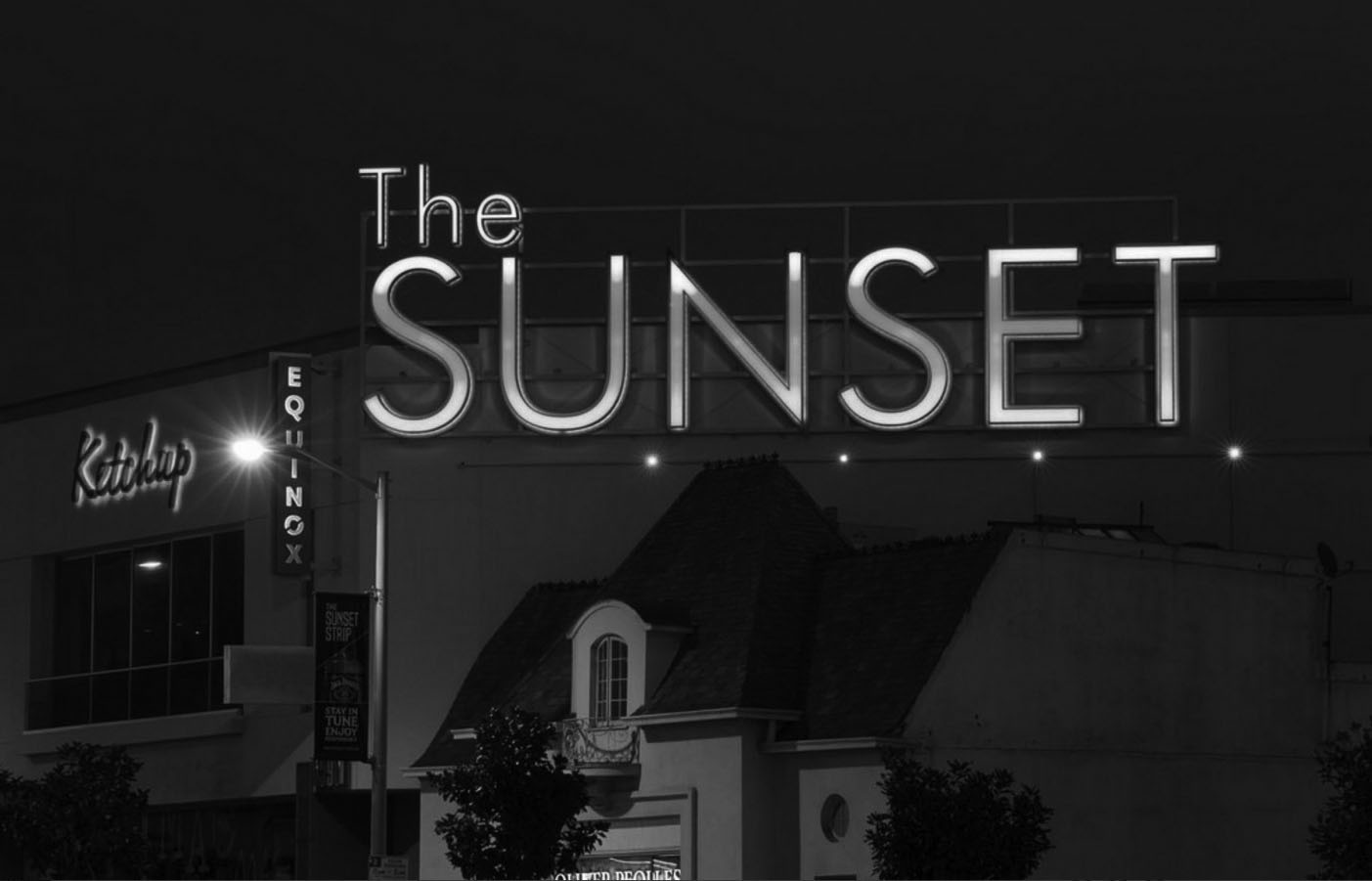 |
|
| (2010)+#+# - A landmark of a sign for the eastbound driver, The Sunset glows like its namesake with a rainbow of plastic-faced, LED lighting. Photo by Joshua Barash. |
Villa Nova Restaurant
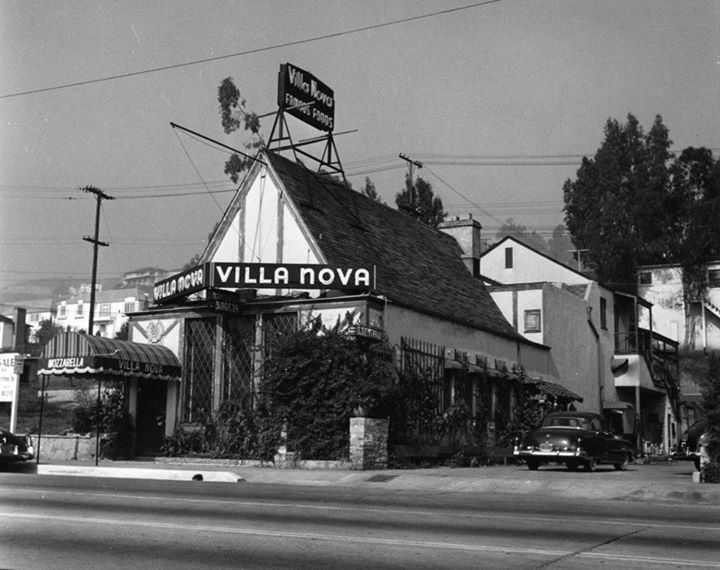 |
|
| (1953)* - View of the Villa Nova Restaurant located at 9015 Sunset Boulevard on the Strip. Photo: Vintage Los Angeles. |
Historical Notes This restaurant was originally called the Mermaid Cafe built in the late 1920's. In 1933 it premiered as The Villa Nova and taken over by film director Vincente Minnelli and silent film actor-director Allen Dale. Marilyn Monroe went on her first blind date with Joe DiMaggio here in 1953 and Vincent proposed to Judy Garland at the Villa Nova in 1945. When Elmer Valentine, Lou Adler and Mario Maglieri took it over in 1972, they originally wanted to call it "Over The Rainbow" in their honor - but the city would not allow the sign to reach a certain height, so they shortened it to, "The Rainbow". |
Rainbow Bar and Grill
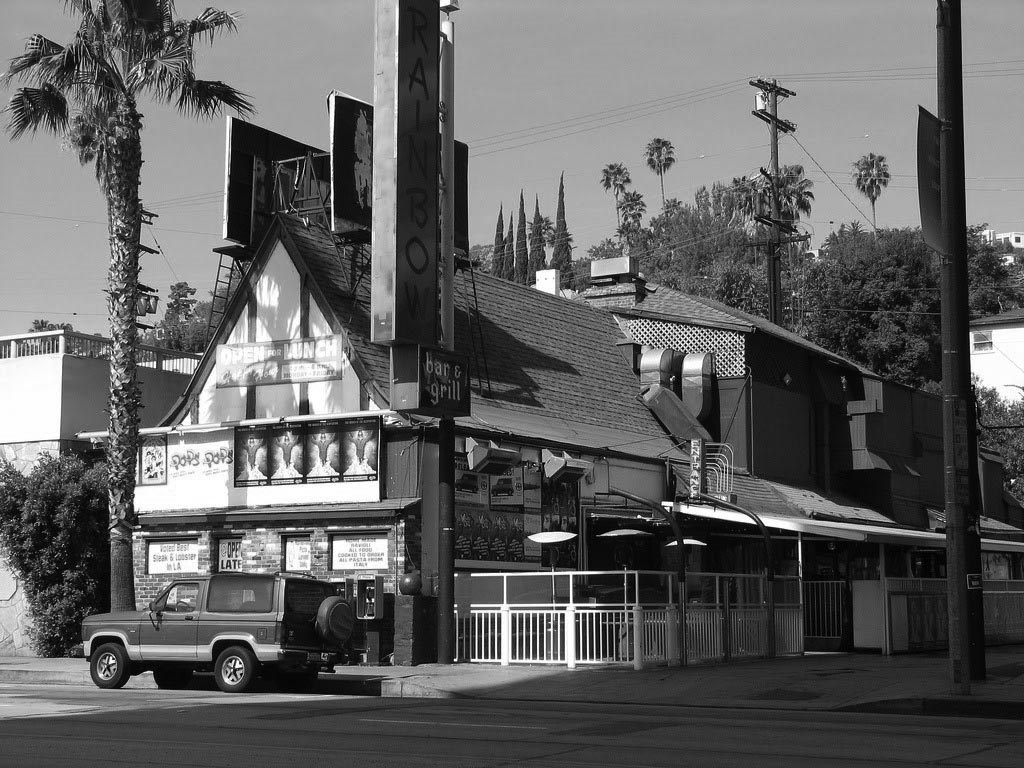 |
|
| (2011)^^## – View showing the Rainbow Bar and Grill (previously the Villa Nova) located on the Sunset Strip in West Hollywood. |
Historical Notes The Rainbow Bar and Grill was founded in early 1972 by Elmer Valentine, Lou Adler, Mario Maglieri and others, opening on April 16, 1972, with a party for Elton John. At the time, the word "rainbow" signified peace and freedom. It quickly became known as a hangout for celebrities of all types. John Belushi ate his last meal (lentil soup) at table No. 16.^ |
 |
|
| (ca. 1980)* – View looking west on Sunset Boulevard showing the Rainbow Bar and Grill (previously the Villa Nova) at center of photo. Bank of America and Gazzarri's Nightclub are on the left with The Roxy at lower-right. |
Historical Notes The Rainbow became known as a hangout for rock musicians and their groupies. Notable regulars at the Rainbow in this period include Keith Moon, Alice Cooper, Micky Dolenz, Harry Nilsson, John Lennon, Ringo Starr, and Neil Diamond. Elvis Presley was known to have occasionally visited the Rainbow. The group of musicians calling themselves the Hollywood Vampires made the Rainbow their home away from home in the mid-1970s. In the last two decades of his life, Motörhead frontman Lemmy was a daily fixture at the Rainbow whenever the band was not on tour, and often played a video poker machine at the end of the bar table.^ |
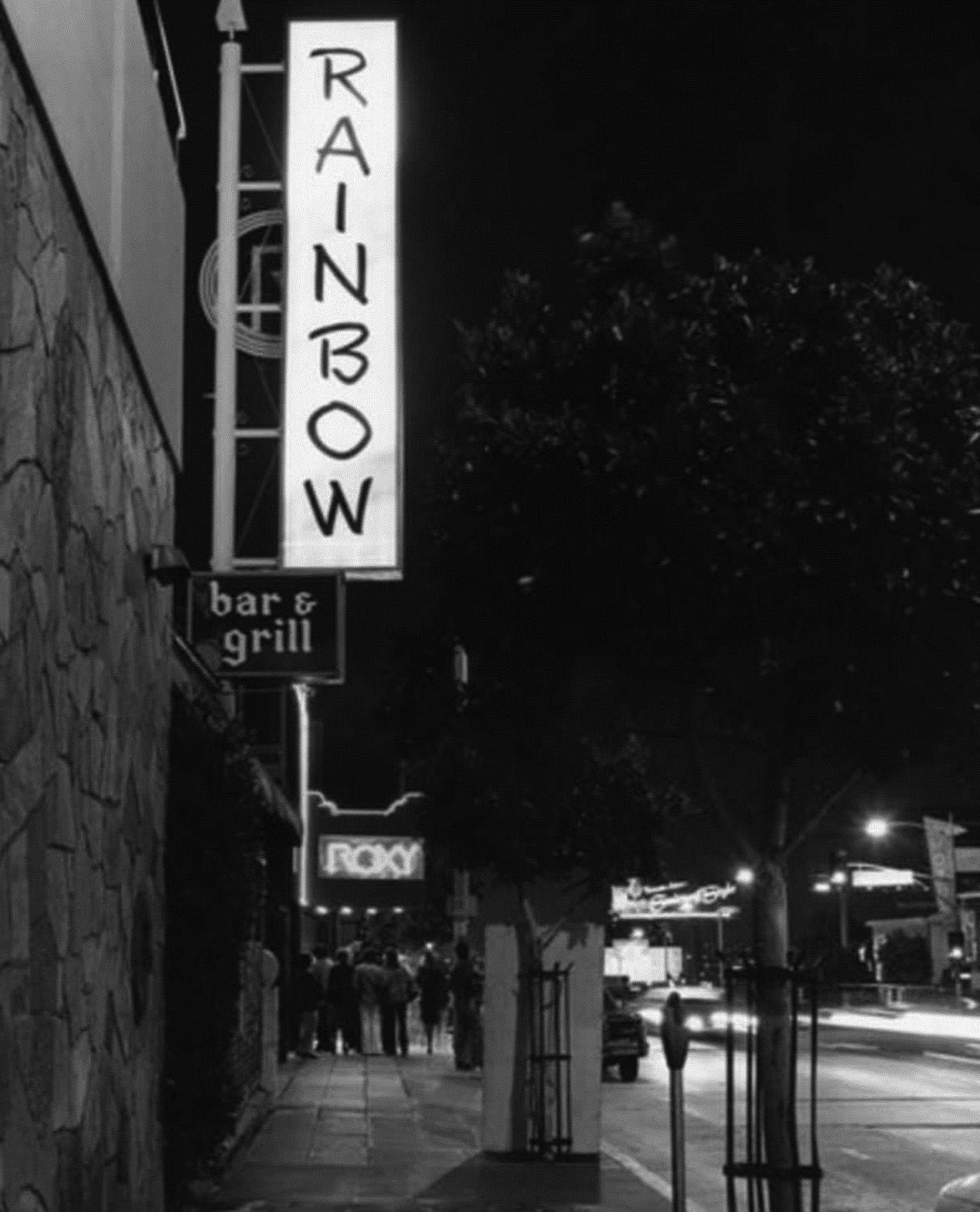 |
|
| (1980)* - The Rainbow Bar & Grill with The Roxy next door. West Hollywood |
Historical Notes Los Angeles songwriter Warren Zevon referenced the scene at the Rainbow in the last verse of his 1976 song "Poor Poor Pitiful Me". The musical group Rainbow was named after this club.^ |
Roxy Theatre
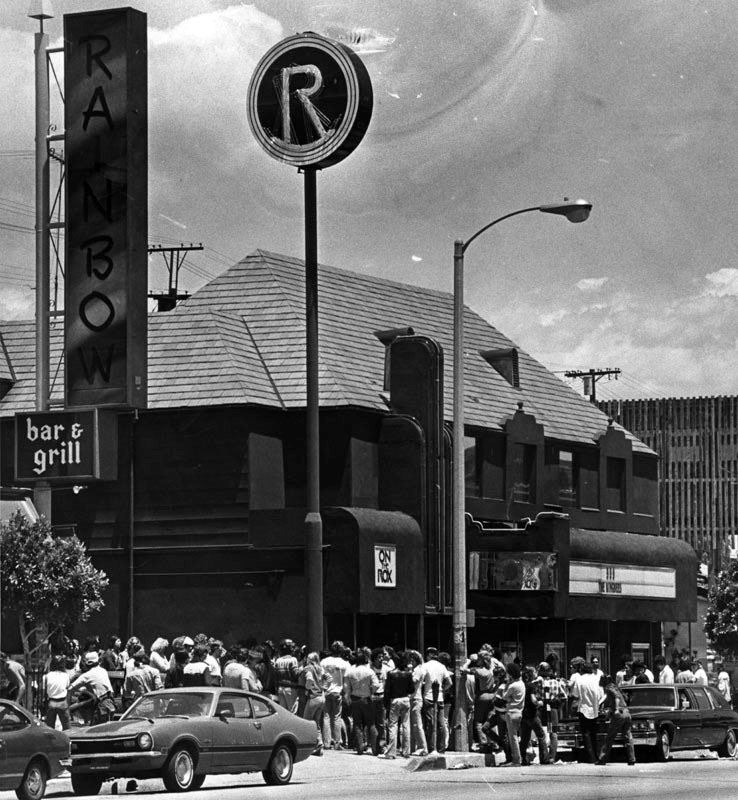 |
|
| (1980)* - A long line of customers wait on the sidewalk outside the Roxy to get in a see a live rock show. The sign for the neighboring restaurant, Rainbow Bar & Grill, is visible on the left. |
Historical Notes The Roxy was opened on September 23, 1973, by Elmer Valentine and Lou Adler, along with original partners David Geffen, Elliot Roberts and Peter Asher. They took over the building previously occupied by a strip club owned by Chuck Landis called the Largo. (Adler was also responsible for bringing the stage play The Rocky Horror Show to the United States, and it opened its first American run at The Roxy Theatre in 1974, before it was made into the movie The Rocky Horror Picture Show the next year. *^ |
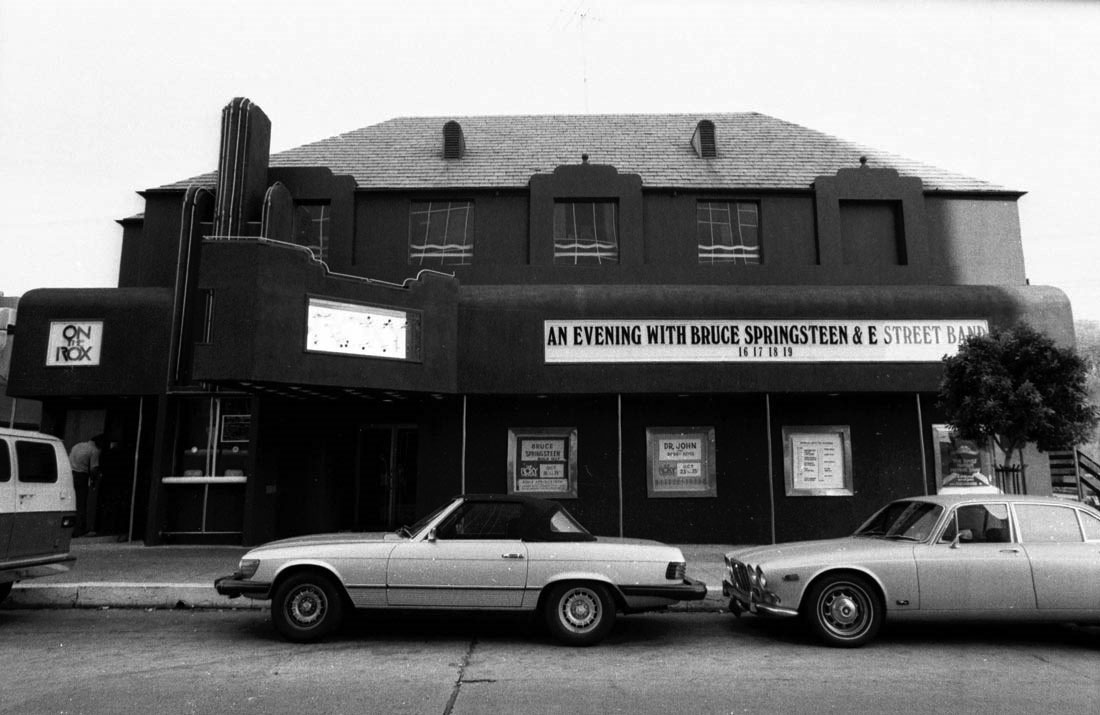 |
|
| (1975)^+++ – Front view of the Roxy Theatre at 9009 W. Sunset Boulevard. Billboard reads: “An Evening with Bruce Springsteen & E Street Band” |
Historical Notes Neil Young and his band The Santa Monica Flyers played the Roxy for the first week it was open. Only three months later, the original Genesis lineup with Peter Gabriel played several consecutive days at the Roxy, a run that some band members and many fans consider to be amongst their finest performances (due partially to the intimate atmosphere and good acoustics of the venue, as well as the legendary reputation of "Hollywood" amongst performers around the world). Paul Reubens, then a struggling comedian, introduced his Pee-wee Herman character in a raunchy revue here in 1981 that included other aspiring comics including Phil Hartman and Elayne Boosler. *^ |
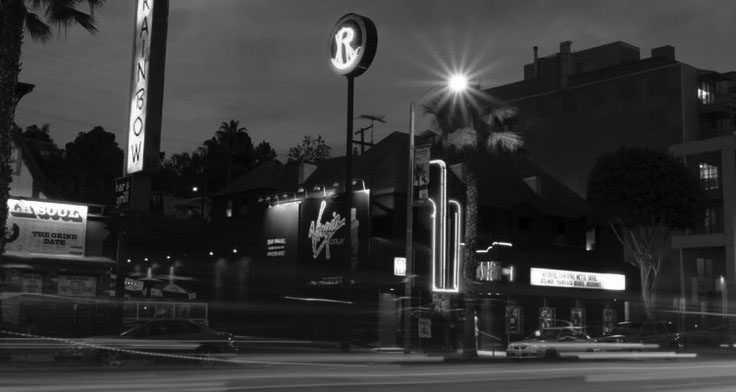 |
|
| (n.d.)#* – Nighttime view of the Roxy Theatre with the Rainbow Bar and Grill on the left. |
Historical Notes The small On the Rox bar above the club has hosted a wide variety of debauchery in its history. The bar was a regular hangout for John Lennon, Harry Nilsson, Alice Cooper and Keith Moon during Lennon's "lost weekend" in 1973-74 and hosted parties arranged by Heidi Fleiss in the 1980s. *^ |
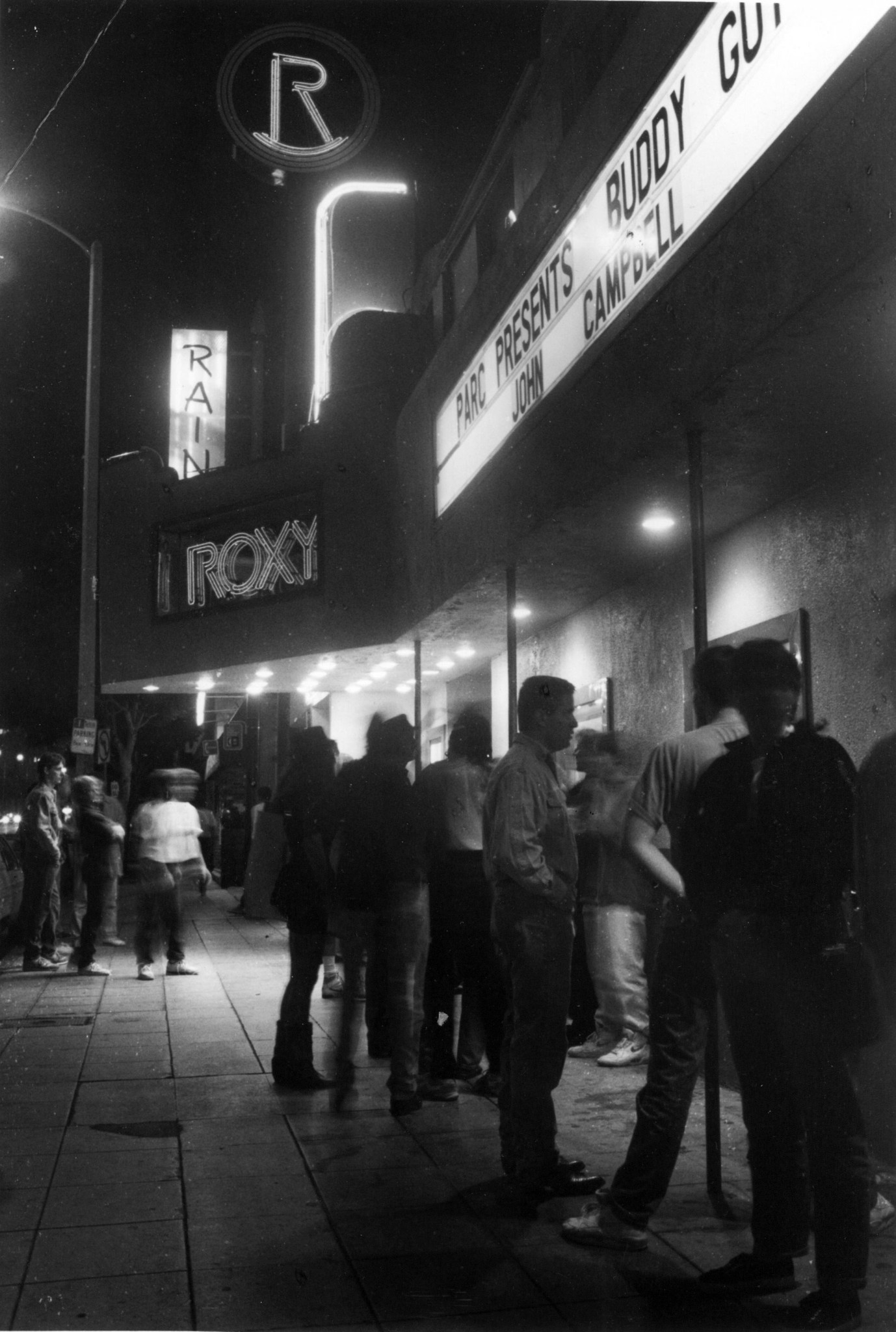 |
|
| (1991)^^# - People gather outside the Roxy Theater on the Sunset Strip, 9009 Sunset Boulevard. (Mike Meadows / Los Angeles Times) |
Historical Notes The Roxy Theatre/Nightclub with a capacity of 500 is owned by Lou Adler and Nic Adler. *^ |
* * * * * |
Sunset Blvd, Doheny Rd, and Corey Ave
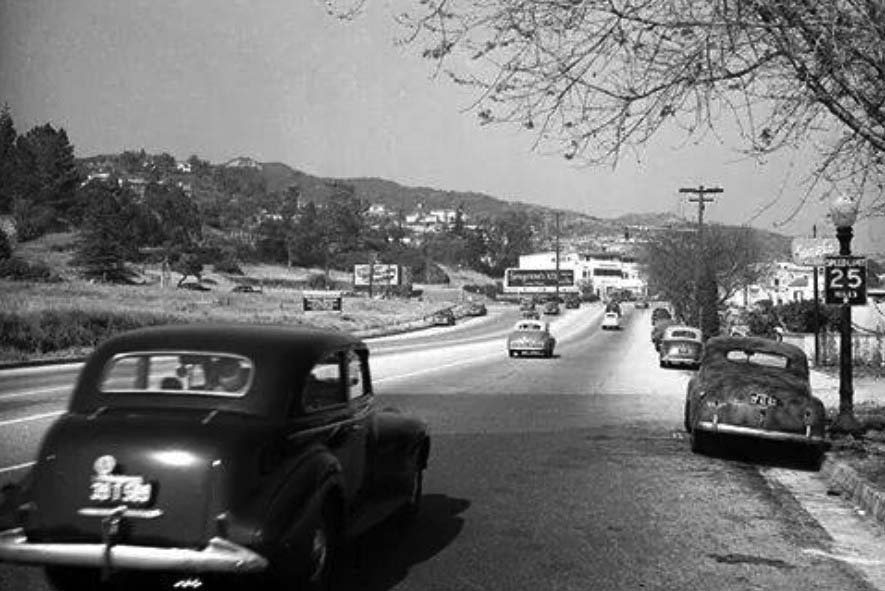 |
|
| (1938)##^* - View looking northeast on Sunset toward Doheny Road and Cory Avenue. Doheny Road branches off to the left at the black billboard. The white building at center is still standing. Luckman Plaza now occupies the block to the right. |
Historical Notes Doheny Road and Doheny Drive, named after the early 20th Century oil tycoon – Edward L. Doheny, is a north–south thoroughfare mostly through Beverly Hills and West Hollywood. It starts a few blocks south of Pico Boulevard in the city of Los Angeles, and travels northwards, crossing Wilshire Boulevard, Santa Monica Boulevard, and other east/west streets, and ends after crossing Sunset Boulevard. |
 |
|
| (1940s)* – View looking northeast on Sunset Boulevard at Cory Avenue (runs to the right) and Doheny Road (runs to the left). The Berman Furs Building can be seen in the distance, where Sunset turns west. Click HERE for contemporary view. |
Berman Furs Building
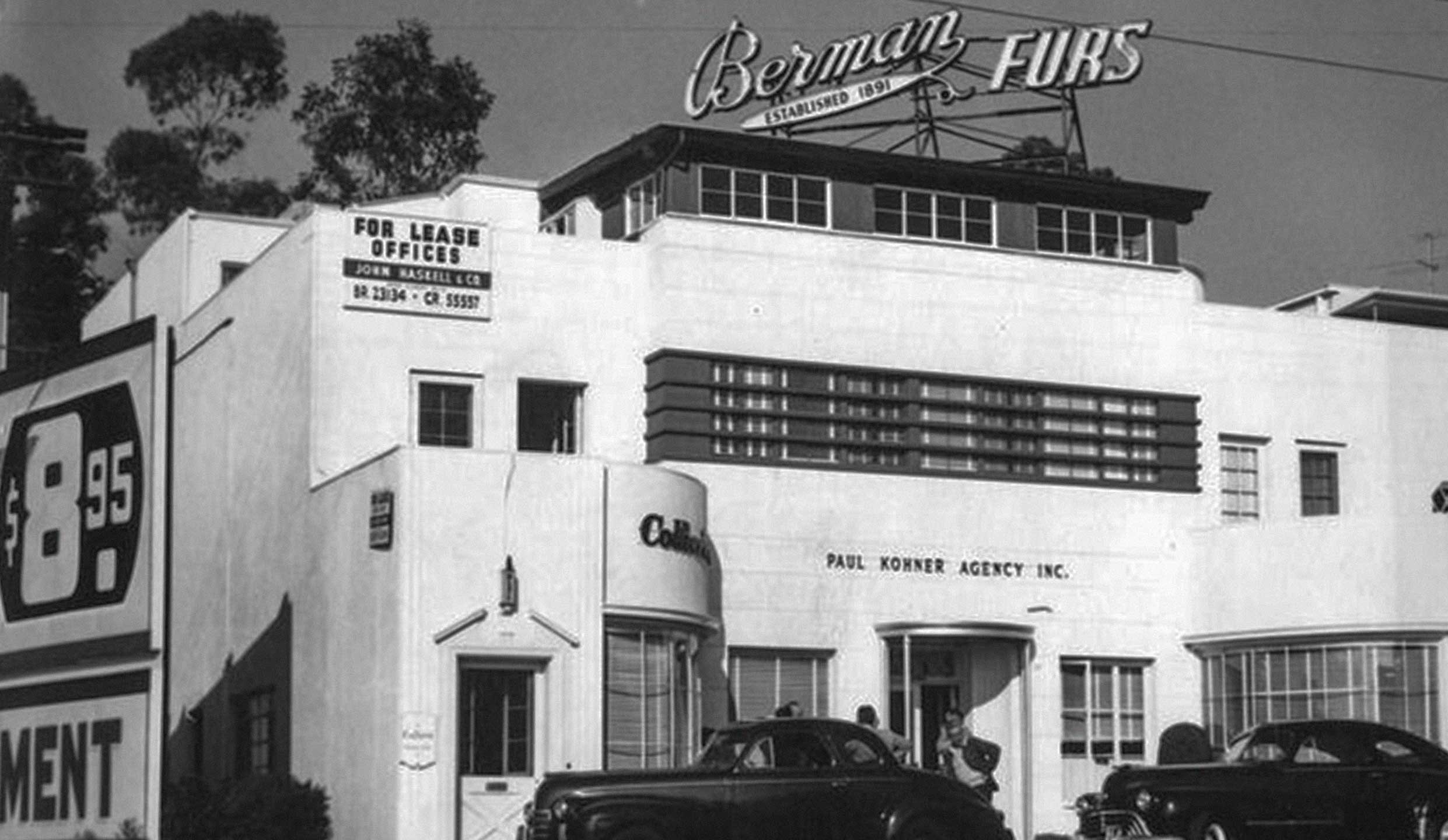 |
|
| (1936)* – View showing the Paul Williams designed Berman Furs Building located at 9169 Sunset Blvd |
Historical Notes This streamline-moderne/classical building was designed by architect Paul Williams for the Berman Fur Company in 1936. Filmaker Hal Roach briefly had a jewelry business on the ground floor. It later housed the offices of agent Paul Kohner. |
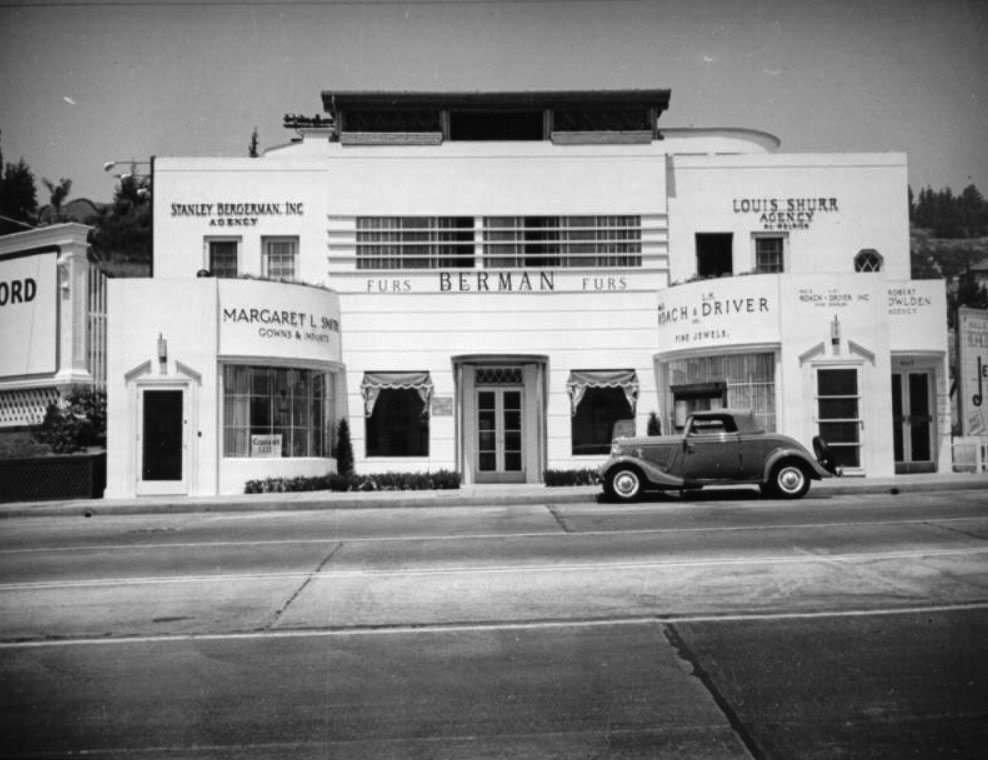 |
|
| (ca. 1937)* - View showing the Berman Furs Building as seen from across Sunset Blvd. The building still exists today. Click HERE for contemporary view. |
* * * * * |
Sunset and Doheny Road
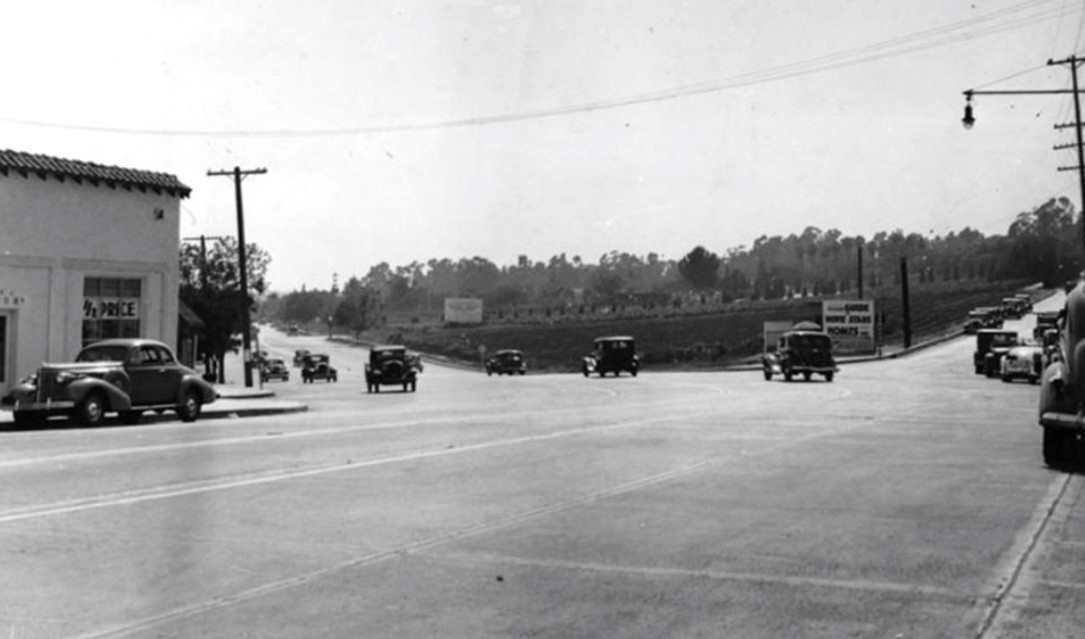 |
|
| (ca. 1938)* – View looking west on Sunset Boulevard with Doheny Road running to the right and Cory Avenue running south (out of view). |
Then and Now
 |
|
| (1938 vs. 2018)* – View looking west on Sunset Boulevard with Doheny Road running to the right and Cory Avenue running south (out of view). Photo comparison by Jack Feldman. |
* * * * * |
Bit of Sweden Smorgasbord
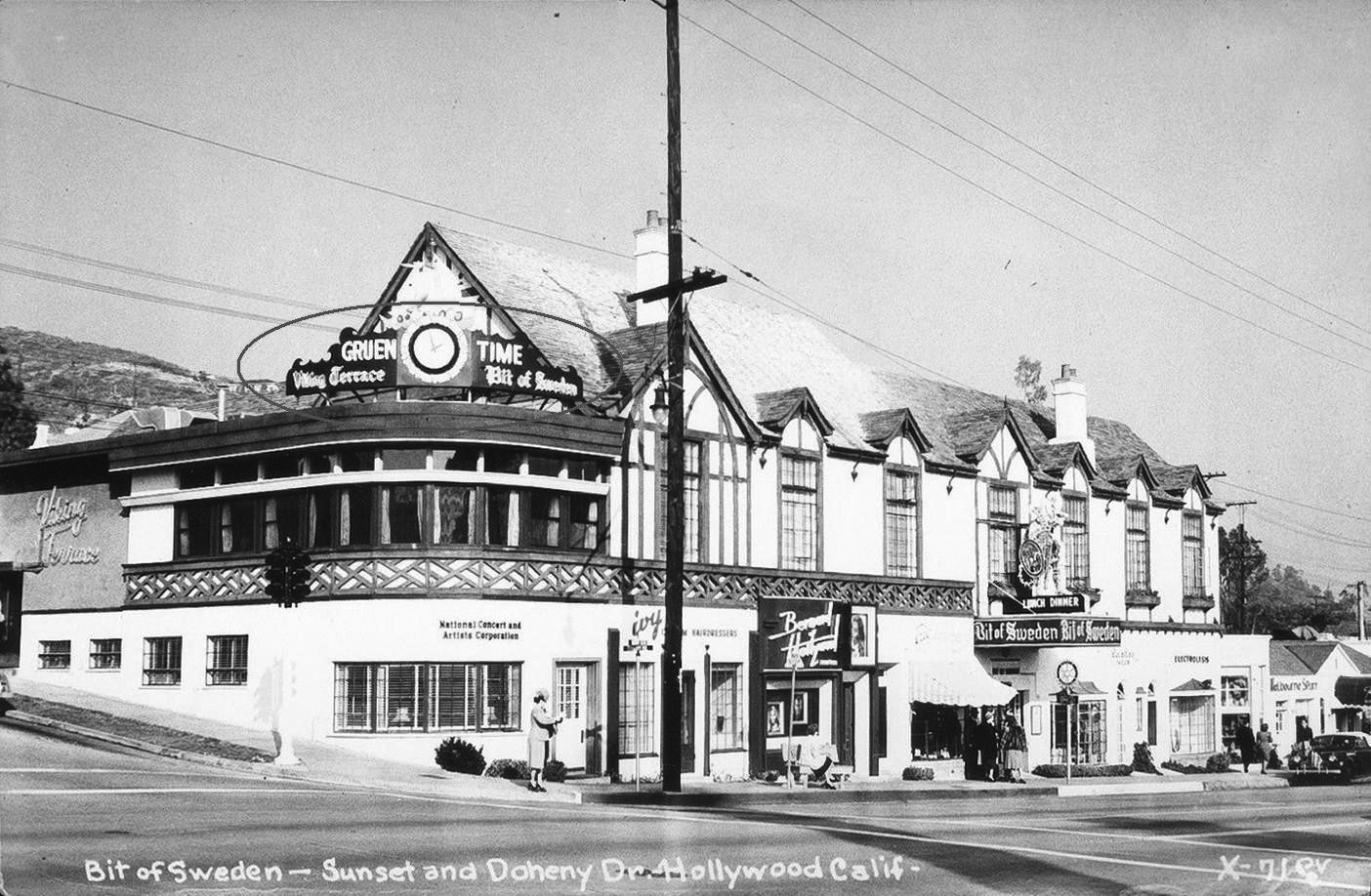 |
|
| (ca. 1936)* – Postcard view showing the Bit of Sweden Smorgasbord Restaurant located on the N/E corner of Sunset Boulevard and Doheny Drive. |
Historical Notes The word “smorgasbord” is something we take for granted these days, but back in 1936 when a Swedish restaurant called ‘Bit of Sweden’ opened at the corner of Sunset Boulevard and Doheny Drive, it introduced the concept of the smorgasbord to curious Angelinos. |
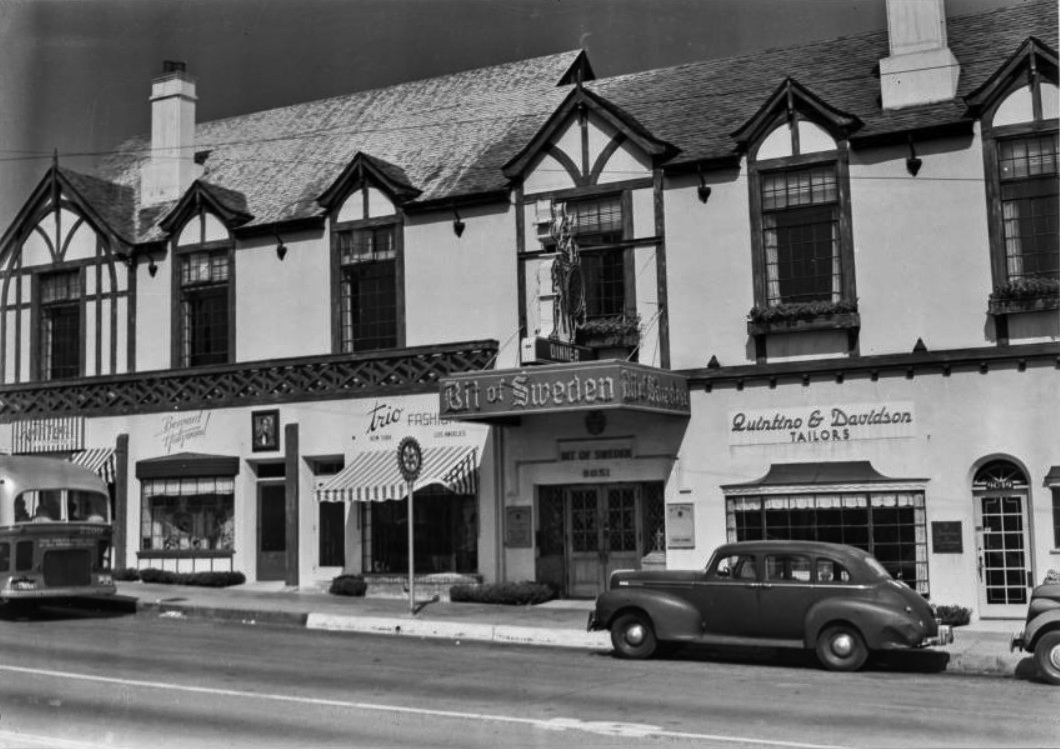 |
|
| (1940s)* - View of the Bit of Sweden Restaurant located at 9051 Sunset Boulevard in West Hollywood with Quintino & Davidson Tailors, Trio Fashions, Bernard of Hollywood, and other shops next door. |
* * * * * |
Sunset and Hilldale
 |
|
| (1936)* – View looking toward the northwest corner of Sunset Boulevard and Hilldale Avenue, with a man carrying a bag walking in the foreground. Photo by Herman Schultheis. |
Historical Notes A furniture store occupies the corner space at 8947 Sunset Boulevard. In the 1930s, this section of Sunset was experiencing a boom and transformation into the glamorous "Sunset Strip." The area was characterized by low-slung buildings in various architectural styles, including colonial-revival, Mediterranean, Normandy, Spanish-colonial, Tudor, and streamline-moderne. |
 |
|
| (2024)* – Looking across the street toward the northwest corner of Sunset Boulevard and Hilldale Avenue. |
Historical Notes Today, the 8900-9000 block of Sunset Boulevard has evolved significantly. While some historic buildings may remain, they have been repurposed or renovated. The area continues to be a popular destination for entertainment, dining, and nightlife, though with a different character than its 1930s heyday. The transformation of this block reflects the broader changes in the Sunset Strip over the decades, evolving from a playground for Hollywood's elite in the 1930s to a more diverse, modern urban landscape today. |
Then and Now
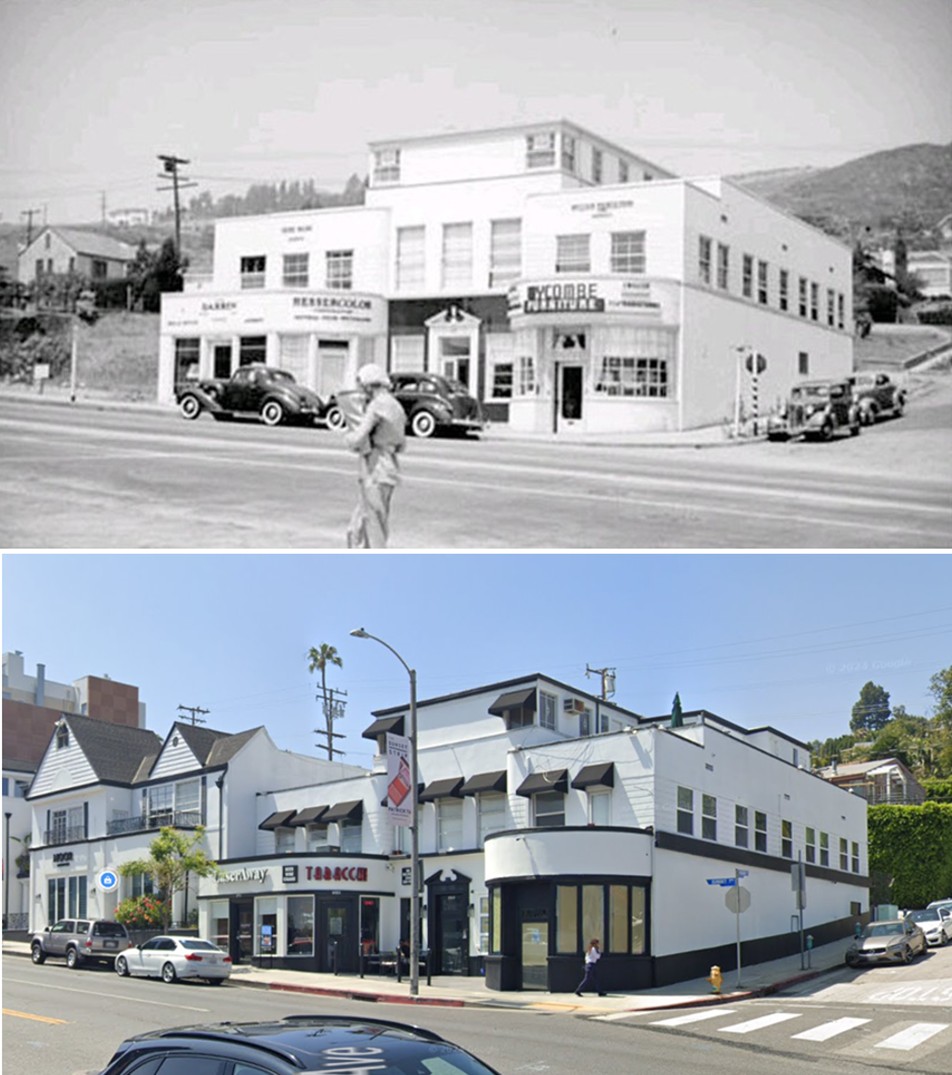 |
|
| (1936 vs. 2024)* - A 'Then and Now' comparison of the northwest corner of Sunset Boulevard and Hilldale Avenue. Photo comparison by Jack Feldman. |
* * * * * |
Simon's Drive-in (later Dolores Drive-in)
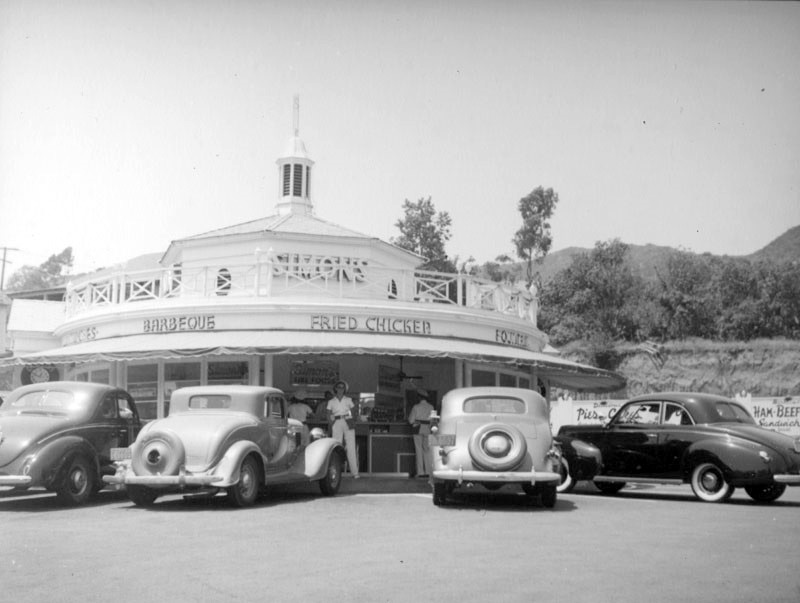 |
|
| (ca. 1938)* - Cars circle this colonial style Simon's, located at 8801 Sunset Boulevard at the corner of Horn Avenue in West Hollywood. The drive-in features fried chicken, barbecue. |
Historical Notes This was a Simon’s Drive-in from 1935 until 1945 when Dolores Drive-in took over. It became Jack’s on the Strip Drive-in sometime in the 1950s. The building stood until the mid-1960s when it was demolished to make way for a succession of music stores, Muntz Stereo and then Tower Records (1971). Click HERE to see more Early Views of LA Drive-in Restaurants. |
Dolores Drive-in (previously Simon's Drive-in)
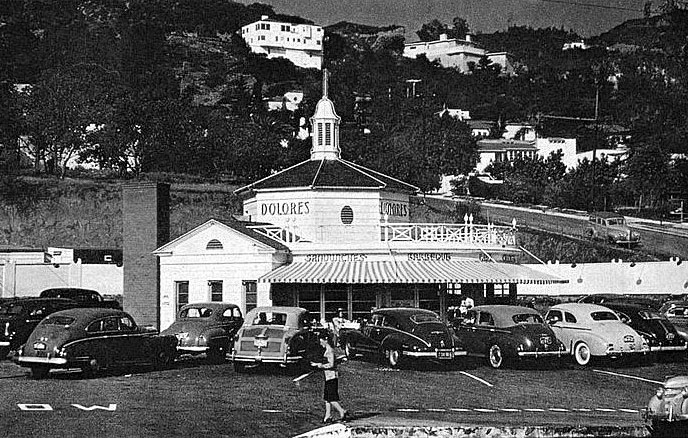 |
|
| (ca. 1945)* – View showing Dolores Drive-in Restaurant located at 8801 Sunset Boulevard, previously a Simon's Drive-in (1935 - 1945). |
Historical Notes The Strip’s lone drive-in restaurant at the time, it was originally occupied by a branch of the Simon’s chain. The understated colonial-style building was markedly different that the orbit-shaped, neon-ringed Art Deco Simon’s further east at 6760 Sunset Blvd. near Hollywood High School. It opened as Dolores Drive-in here about 1945, its first Los Angeles location. |
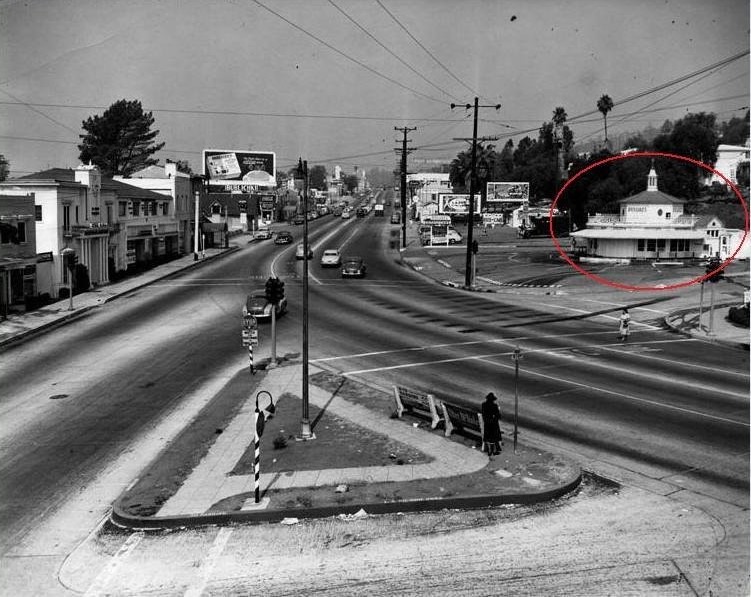 |
|
| (1940)* – Looking west on Sunset Boulevard where it forks with Holloway Drive. Dolores Drive-in is seen on the right, N/W corner of Sunset and Horn Ave. |
Historical Notes Dolores would only last until the 1950s when it became Jack’s on the Strip Drive-in. The building stood until the mid-1960s when it was demolished to make way for a succession of music stores, Muntz Stereo and then Tower Records (1971). Click HERE to see more Early Views of LA Drive-in Restaurants. |
Muntz Stereo
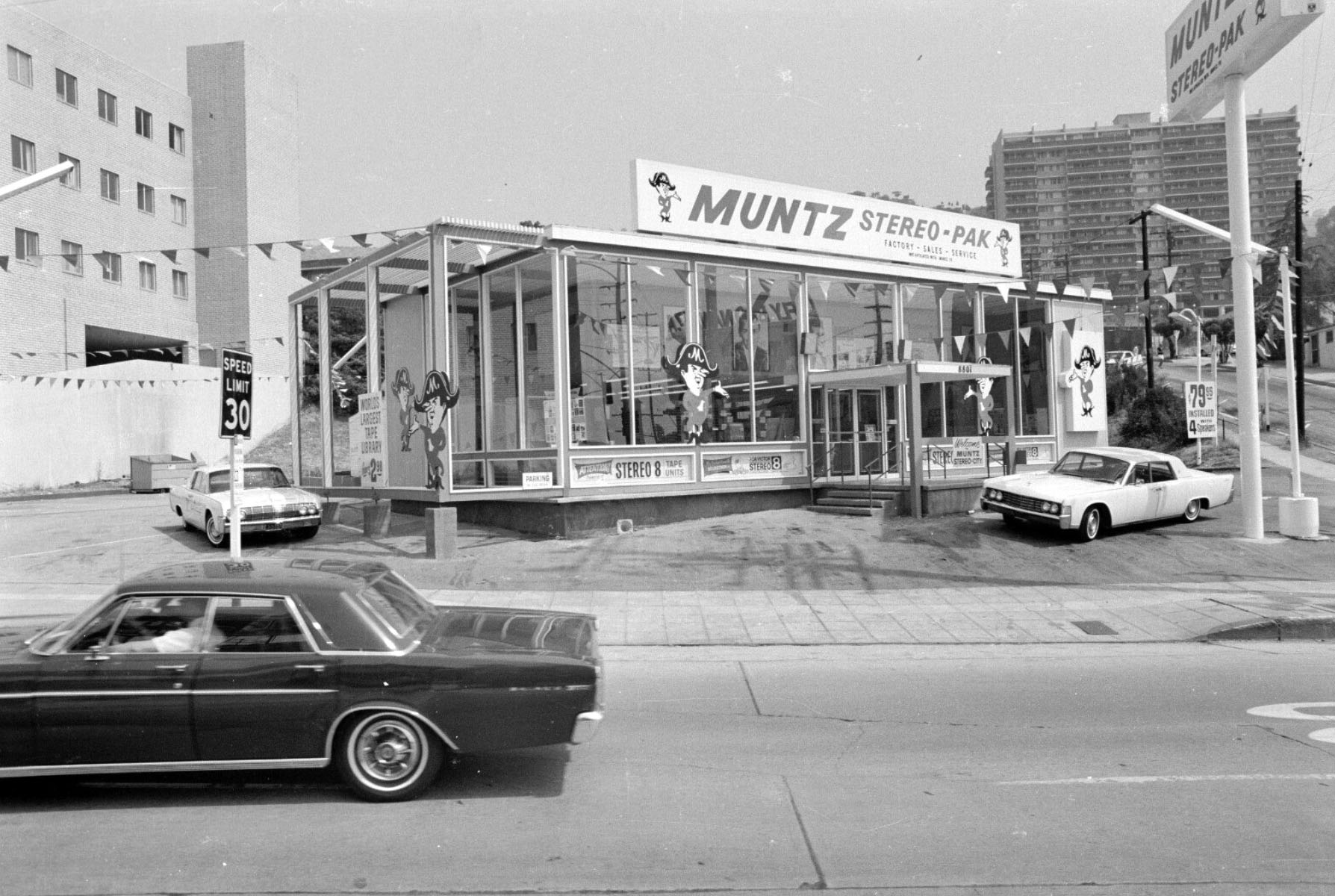 |
|
| (1966)* – Muntz Stereo located at 8801 Sunset Boulevard, previously the site of Dolores Restaurant. From Ed Rushca’s 12 Sunsets. |
Historical Notes The original Dolores Diner is behind the building. Muntz used that space for his car stereo installations. This building was originally built as a model used to sell the condos in the Shoreham building in 1961. Budget Rent-A-Car took it over, and then Muntz added that framing extenstion on the west side of the building. The above building was a music store and showroom for "Madman" Muntz's Stereo Paks, the first successful car stereo system "and a popular hangout for teenagers in the '60s." (In addition to inventing 4-tracks, Muntz popularized the nickname "TV" for television. Tower Records moved into the building in 1971. |
* * * * * |
Café La Maze
.jpg) |
|
| (1937)^***^ – View of the Café La Maze, located at 9039 Sunset Boulevard. The popular restaurant had a lounge area called The Key Club. |
Historical Notes In 1935, Marcel Lamaze, founded the original Café La Maze on Sunset Boulevard. Marcel was a legendary and influential Restaurateur & Maître D in the Los Angeles area during the Golden Age of Hollywood. The Hollywood location was a Movie Star Hangout, where Marcel was well connected with the movie star crowd. Marcel was known to be a good friend of Jimmy Durante and loved to Play Poker with the Marx Brothers.^**^ |
.jpg) |
|
| (ca. 1937)##^* – View looking southeast toward the south side of Sunset Boulevard from the front entry to the Café La Maze. Across the street can be seen the Crosby Building at right, home to the Finlandia Baths. |
Historical Notes In the 1940s the Café La Maze would become Sherry's Restaurant. |
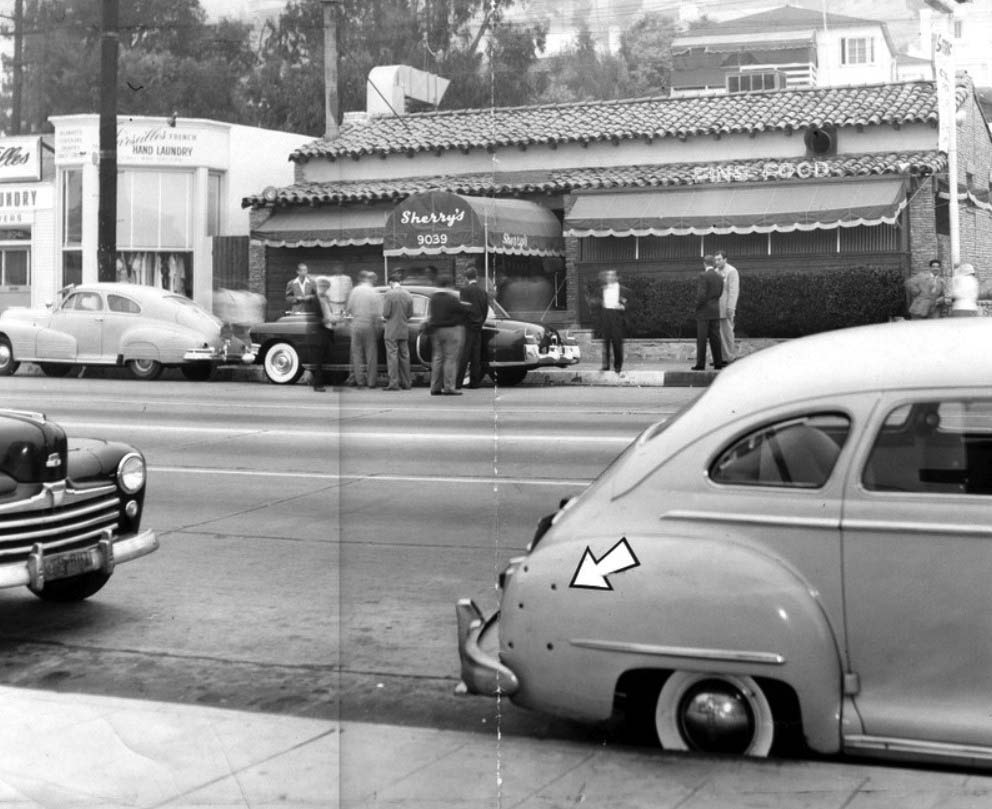 |
|
| (1949)^^ - View showing Sherry's Restaurant (previously Café La Maze) located at 9039 Sunset. A group of men surround a car in front of the restaurant that was the scene of a shooting. An arrow points to bullet holes in the rear fender of a car parked across the street. |
Historical Notes During the 1940s Sherry’s was popular with L.A.’s mafia element. On July 20, 1949 gangster Mickey Cohen and 3 others were ambushed at 3:45 a.m. in front of the restaurant on the Sunset Strip. Mickey's car drove up to the curb and gunmen (hiding across the street under an advertising sign – out of view) opened fire with shotguns. The gunmen then sped away in a gray auto, tossing out the guns a block away. Mickey was the least seriously wounded.*# Sherry’s later became the famous rock club Gazzari’s on the Strip. |
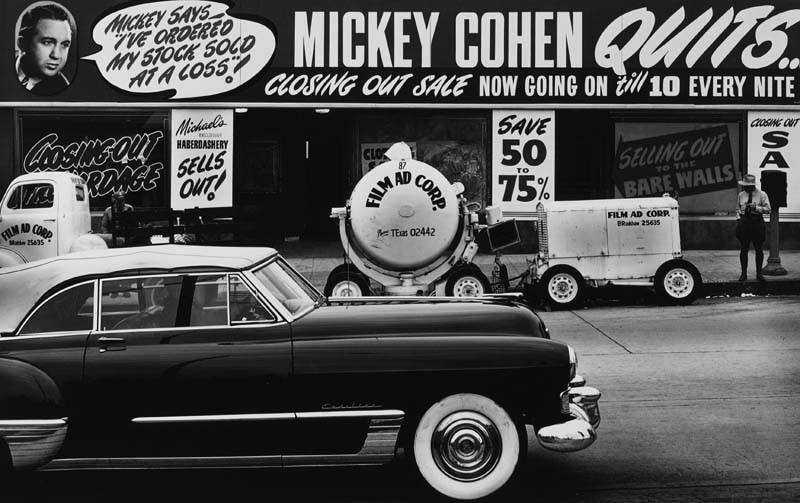 |
|
| (1950)* – View showing a 1949 Cadillac Series 62 Convertible Coupe heading west on Sunset Boulevard. There is a closing out sale at Mickey Cohen men’s clothing store on the south side of Sunset. |
Historical Notes Mickey Cohen was a well-known mobster with close ties to the Mafia (circa 1940s.) As a front, Cohen operated a men’s clothing store at 8804 Sunset Blvd (on the Strip). His office was in the back of the store where he took care of…ahem…“business.” Cohen always insisted he was simply a small businessman selling men’s clothes. Apparently even Cohen gave up pretending when he closed his store in January 1950. |
Gazzarri's
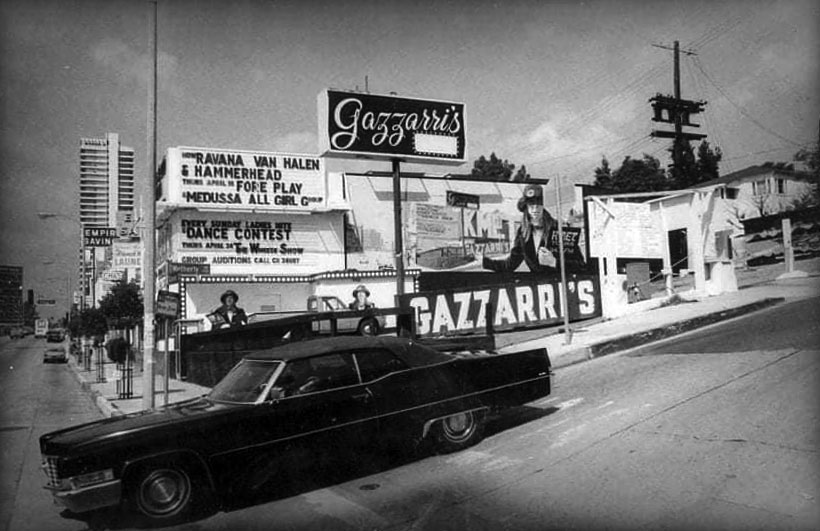 |
|
| (1974)* – A Cadillac convertible drives by Gazzarri’s Nightclub, located on the NW corner of Sunset and Wetherly Drive, where Van Halen is one of the featured groups. Photo courtesy of BraveWords |
Historical Notes Gazzarri's nightclub on the Sunset Strip was most notable as the location where The Doors and Van Halen were featured house bands for long stretches before being discovered. It was also the LA club featured in Huey Lewis and the News MTV video for their hit "The Heart of Rock and Roll." |
.jpg) |
|
| (1970s)^ - View of Gazzarri’s on the Strip (previously Sherry's Restaurant and the Café La Maze). Marquis reads: Dance Contest – Real Don Steele Show |
Historical Notes Gazzarri's reached its peak of popularity in the late 1960s, featuring Jim Morrison's young new group, along with other LA talent such as The Bobby Fuller Four, Buffalo Springfield, and The Walker Brothers. It then achieved major LA relevance again in the late 70's, featuring the David Lee Roth-led Van Halen nightly for months on end, and then into the 1980s thru the early 90's as one of the top LA glam metal nightclubs. It was owned and operated by the "Godfather of Rock and Roll", Bill Gazzarri. Gazzarri himself was known for dressing up as a Chicago-style gangster and frequenting the club on performance nights. Located near the corner of Doheny and Sunset Boulevard in West Hollywood, and just several dozen yards from both the Rainbow Bar and Grill and The Roxy Theatre, Gazzarri's became famous as a launching pad for future rock and roll stars.* |
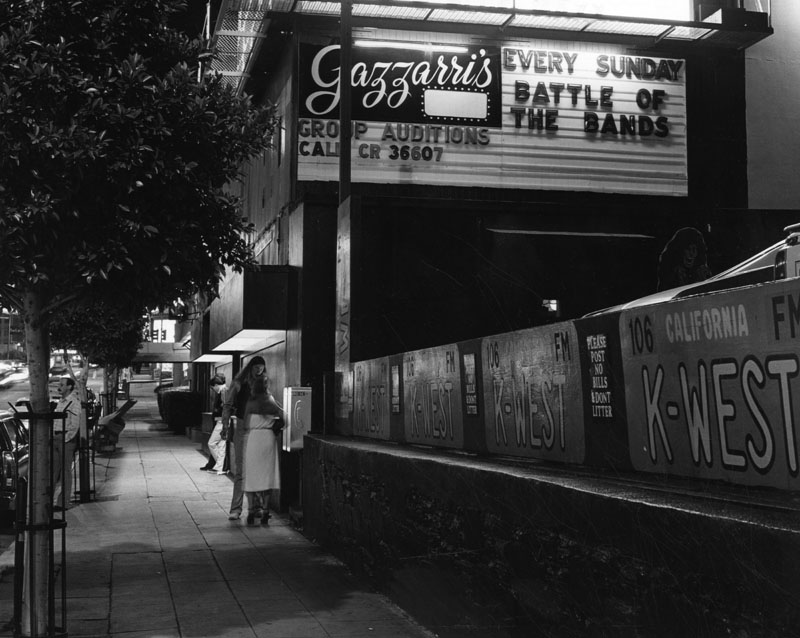 |
|
| (1980)* - Exterior view of Gazzarri's nightclub on the Sunset Strip, with a sign which reads, "Every Sunday battle of the bands." |
Historical Notes Bill Gazzarri died in 1991 and the club closed down in 1993. In 1994, the building suffered irreparable damage from the Northridge earthquake. It was torn down in 1995 and a new club called Billboard Live was built on the former Gazzarri's site. It opened in 1996. Billboard Live became The Key Club in 1998 (which was the lounge name of the original Café La Maze).* |
* * * * * |
Mammy Louise's Bayou
 |
|
| (ca. 1935)**## – Life Magazine photo showing Mammy Louise’s Bayou, a restaurant located at 8711 Sunset Boulevard. |
Historical Notes The restaurant was run by a black woman named Louise Brooks but owned by Phil Selznick, who was David O. Selznick’s uncle. He also took over the It Café on Vine Street from Clara Bow, and Club Versailles at 8590 Sunset, which was rumored to be a front for Bugsy Siegel and later became Mocambo. Something dodgy was going on because Mammy Louise’s Bayou was raided in the fall of 1938 and subsequently went under. Its next incarnation was an upscale lesbian bar called Cafe Internationale. Today the building, after a major renovation, has been converted into a furniture store. Click HERE for contemporary view. |
* * * * * |
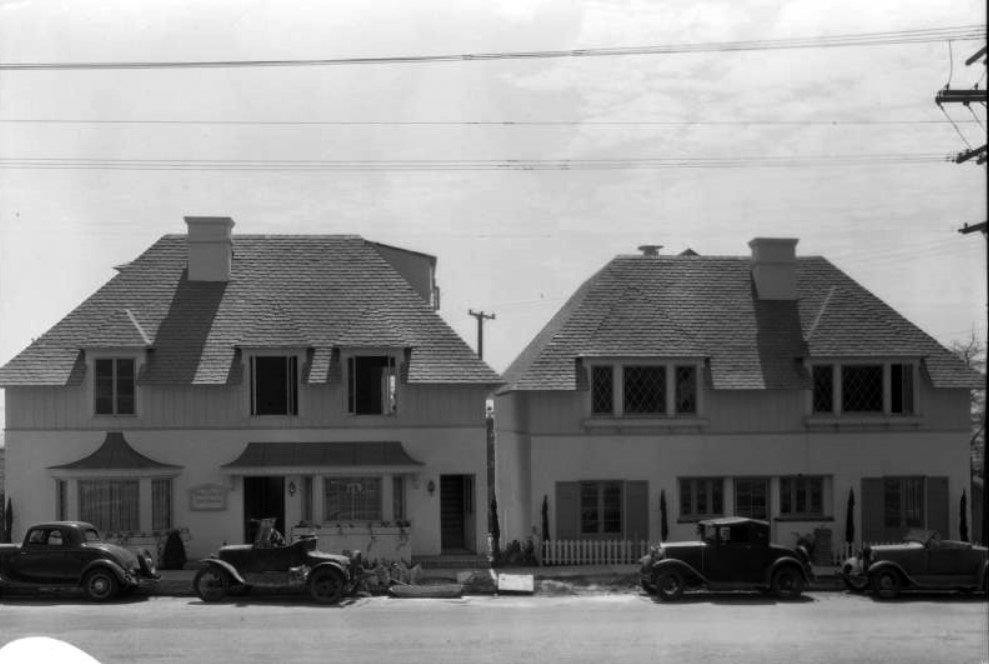 |
|
| (ca. 1935)^^ - View of the offices of Hoffman-Schlager, Inc. and David C. Werner, Inc. at 8776 Sunset Boulevard with early-model automobiles parked in front. |
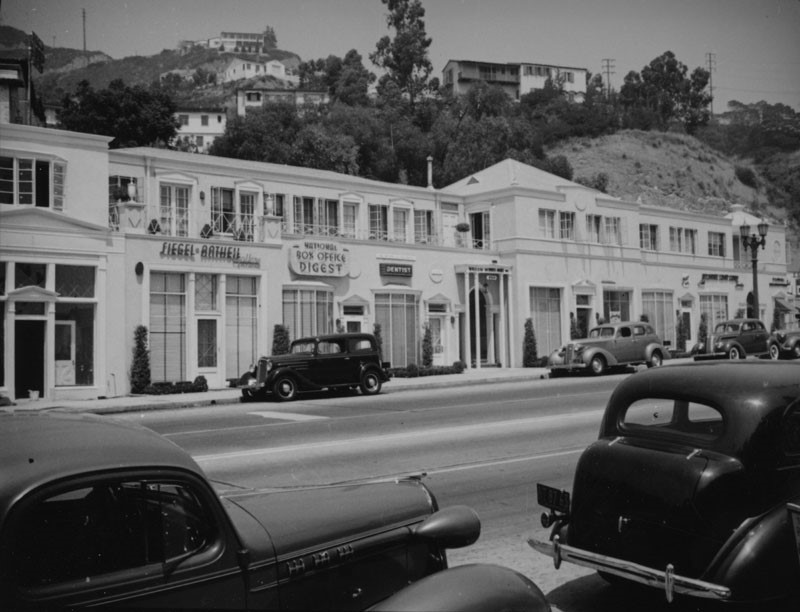 |
|
| (ca. 1938)* - Photo taken from across the street showing a large 2-story commercial building located along Sunset Blvd. in the city of West Hollywood. Some identifiable businesses calling this colonial-looking building home are: "Siegel & Bathiel Gallery", "National Box Office Digest", and a dental office, among others. |
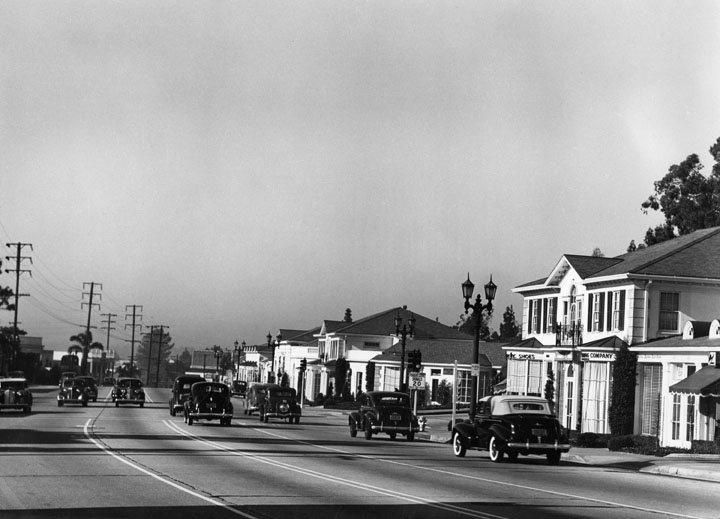 |
|
| (1939)* - Sunset Strip looking north-west, west of La Cienega. |
Then and Now
 |
|
| (ca. 1939)* - View looking toward the SE corner of Sunset Blvd and Carol Drive. Cars are parked in front of a row of shops on the 9100 block of Sunset; a sign for a florist is seen on the far left. Doheny is on the far left out of view. |
Historical Notes In the 80s and 90s these buildings (as well as the office buildings on the east side up to Doheny) all comprised the headquarters of Geffen Records. |
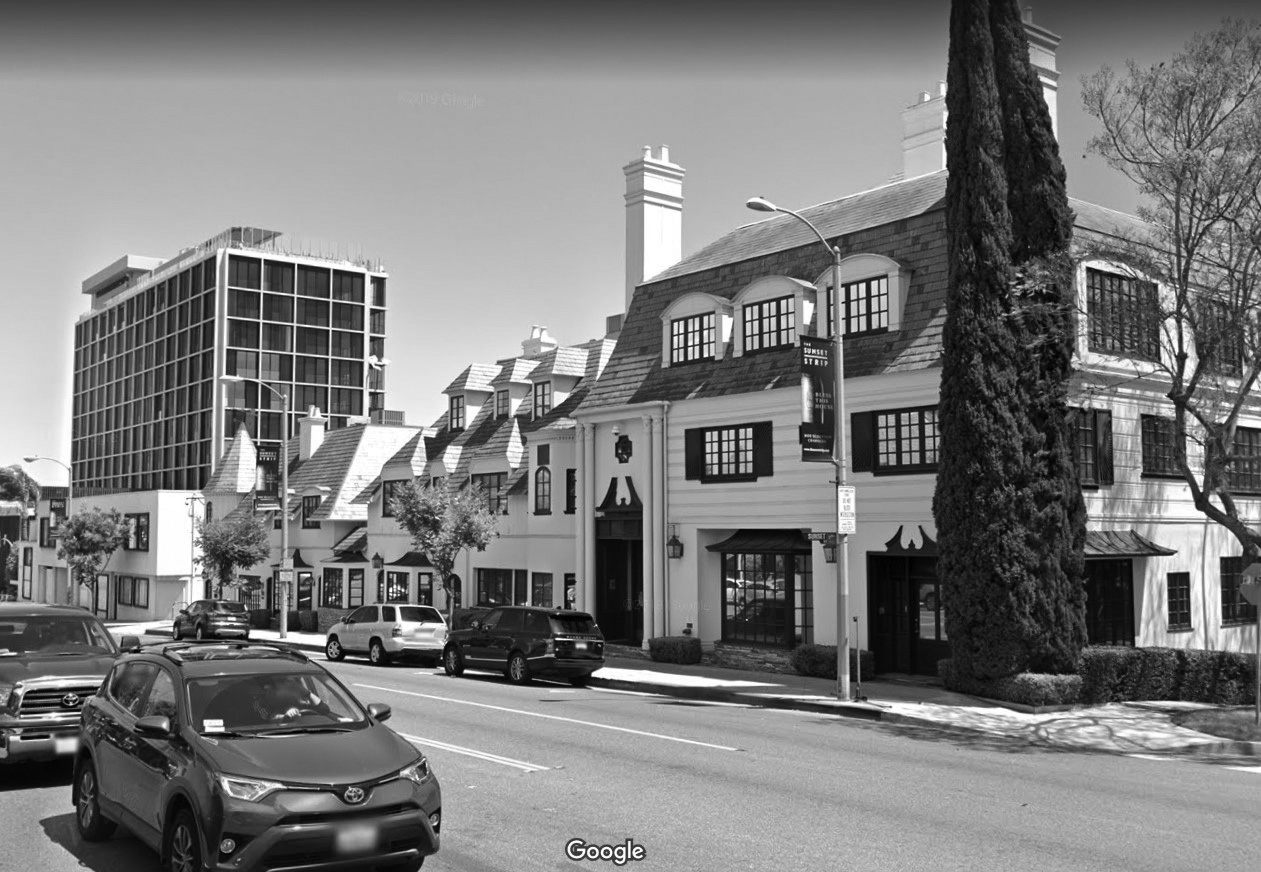 |
|
| (2019)** - View showing the 9100 block of Sunset Boulevard as it appears today. |
Then and Now
 |
|
| (1936)#**# – View of the 9100 block of the Sunset Strip showing a couple of charming tudor-style office buildings which still stand today. View is looking southwest. |
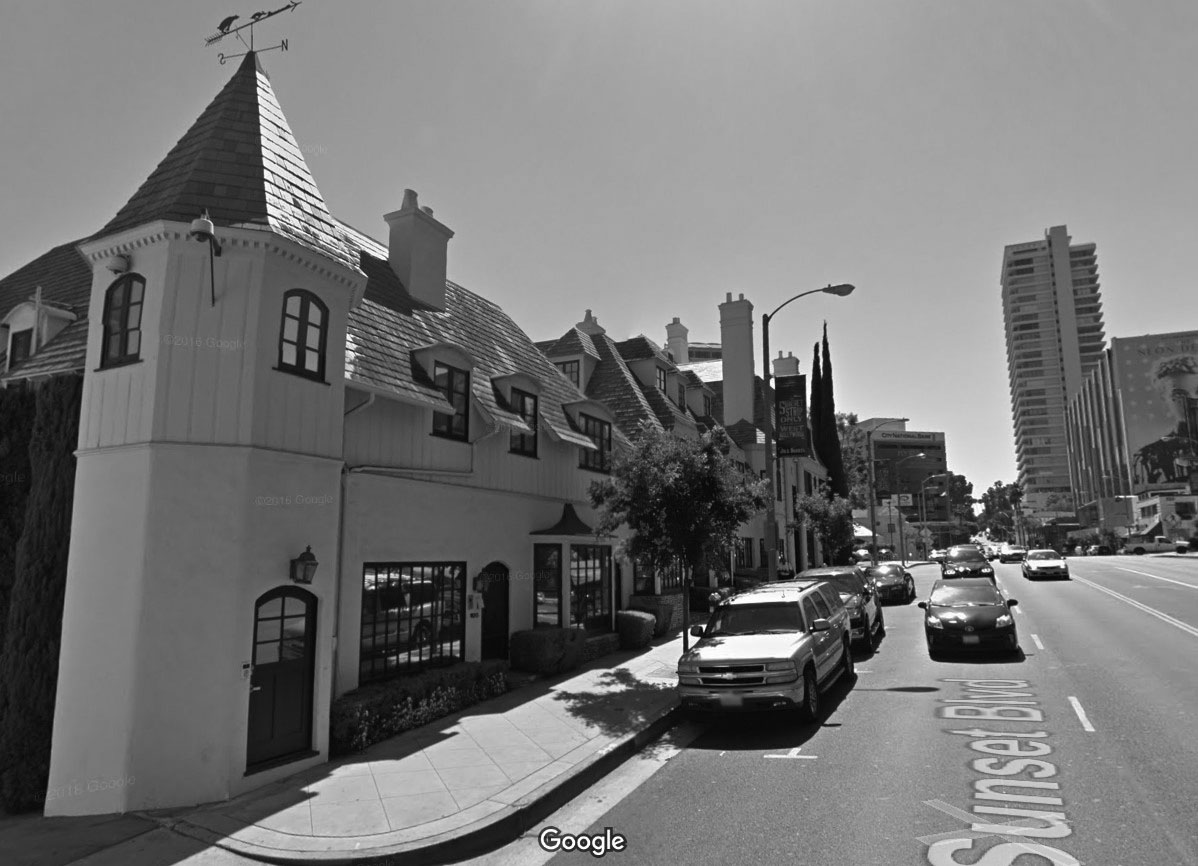 |
|
| (2016)*### – Google Street View looking west on Sunset Boulevard showing the 9100 block of the Sunset Strip. |
Finlandia Baths
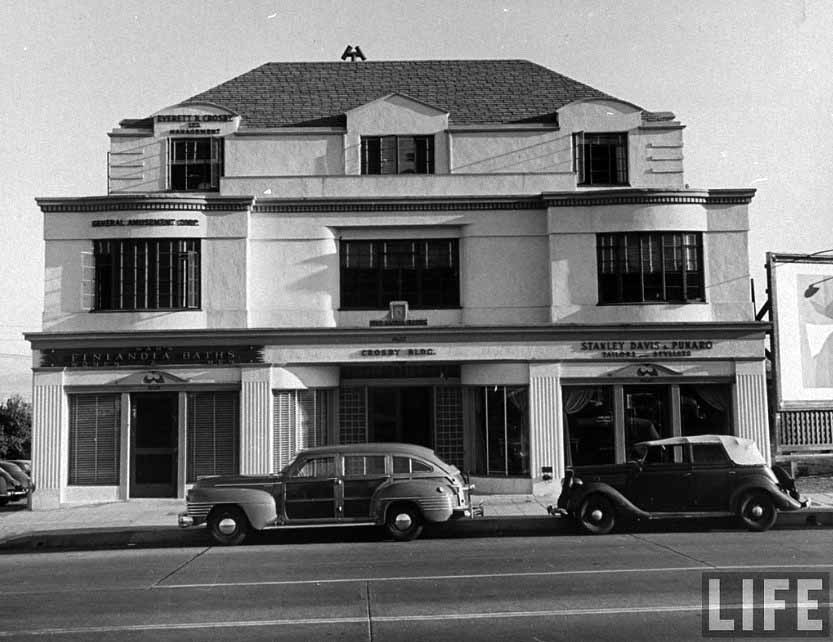 |
|
| (1946)^##* - Exterior view of the Crosby Building, located at 9028 Sunset Boulevard. The entrance to the famous (or infamous) Finlandia Baths can be seen on the left. |
Historical Notes The Finlandia Baths were downstairs in the basement of the Crosby Building where a virtual who's who of closeted gay and straight male stars went for a bake or to rub the kinks out or have them rubbed out, as the case may be. Regulars apparently included Kirk Douglas, Cornel Wilde, Humphrey Bogart, Tony Curtis, Hugh O'Brien, Rock Hudson and the Crosby brothers and many others. The building is still there albeit somewhat folded, spindled and mutilated but the bones are still good and still visible. Finlandia Baths have predictably morphed into a tattoo parlor. |
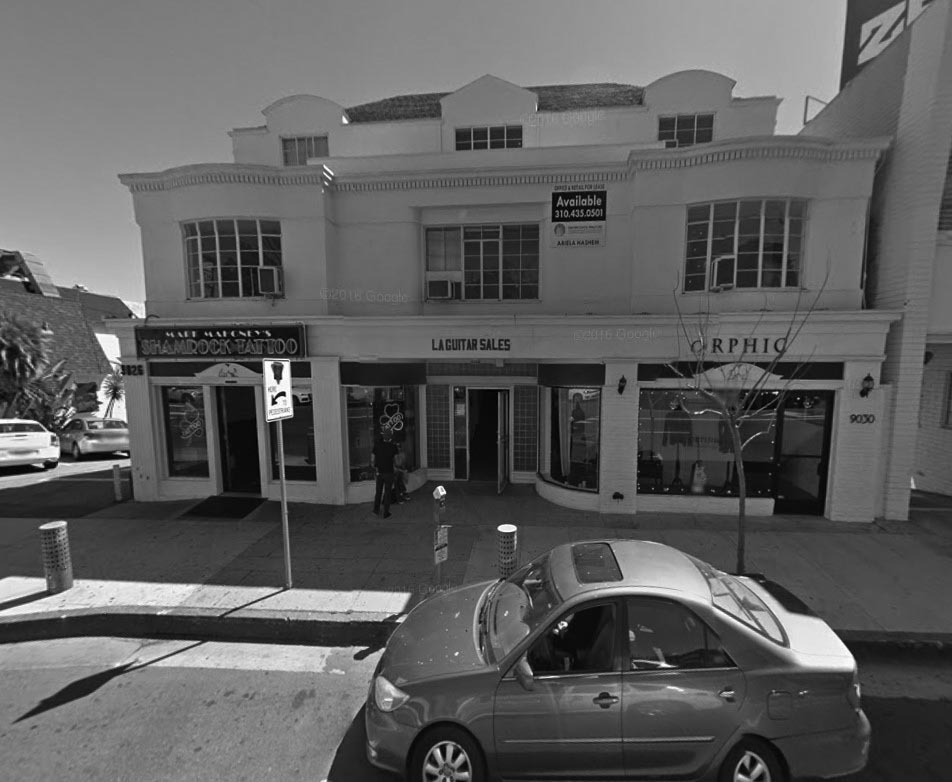 |
|
| (2015)* – Google Street View showing the Crosby Building as it appears today. Tenants include: Shamrock Tattoo, LA Guitar Sales, and Orphic. |
Santa Monica and Doheny
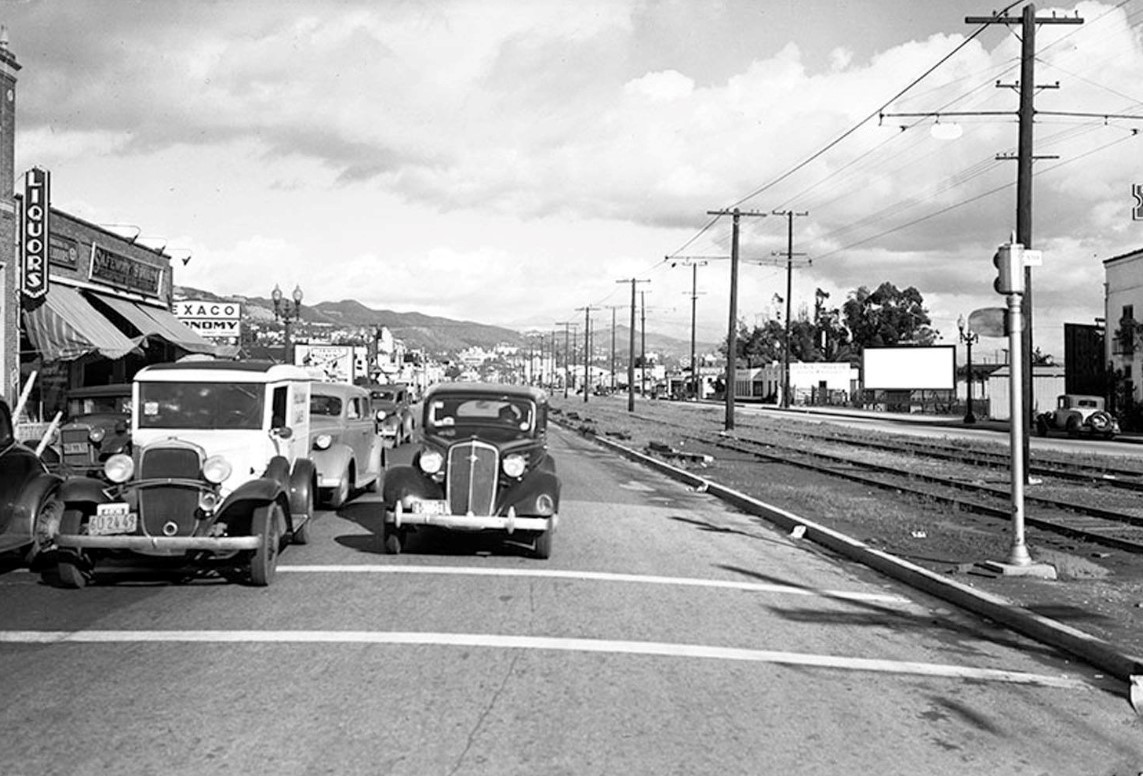 |
|
| (1937)* - View looking east on Santa Monica Boulevard (Historic Route 66) from Doheny Drive. Note the tracks running down the center of Santa Monica Boulevard. |
Historical Notes The tracks running down the center of Santa Monica Boulevard were part of the Pacific Electric Railway since 1911 and carried red cars until the 1950s. They then remained largely unused for decades, serving the occasional Southern Pacific freight train through the 1970s. It was not until 1999 that the West Hollywood segment of the tracks were dug up and replaced by a landscaped median.^ |
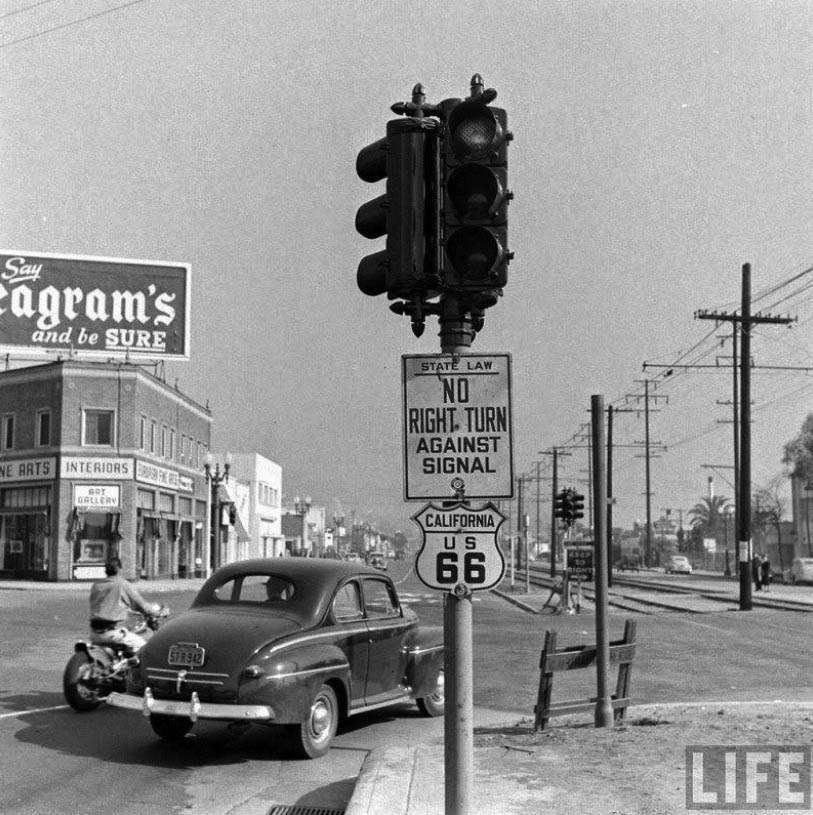 |
|
| (1948)* – View looking east on Santa Monica Boulevard (Historic Route 66) at N. Doheny Drive. |
Historical Notes That brick building on the left is still there and billboards STILL advertise on top of it. The Troubadour would eventually become that second white building. And check out the railroad tracks in the middle of the road! |
 |
|
| (1964)* - Looking west along the railroad tracks on Santa Monica Boulevard, with Doheny Drive visible in the distance. These men are reportedly picking up old ties from the second track, which was removed from service to be used for the trolley museum in Perris. The other set of tracks remained in place, though unused, until the mid-1980s. The sign for the Troubadour Nightlclub is just above and behind the pick-up truck. Photo courtesy of Alison Martino / Vintage Los Angeles. |
Historical Notes The tracks were used by the old Red Line cars. They ran from Gardner up Santa Monica Boulevard through West Hollywood, Beverly Hills, and Los Angeles to the city of Santa Monica. After the demise of the Red Cars, Southern Pacific continued to run a short train to maintain its claim to the right of way, even after it stopped transporting wheat and other supplies to the former Wonder Bread Bakery in Beverly Hills. (On warm summer evenings, the aroma of baking bread would waft over the area.) After West Hollywood incorporated in 1984, one of the first improvement projects the new city planned was removal of the tracks, narrowing of the median, extensive landscaping, and widening of the sidewalks along the length of the boulevard within its limits. |
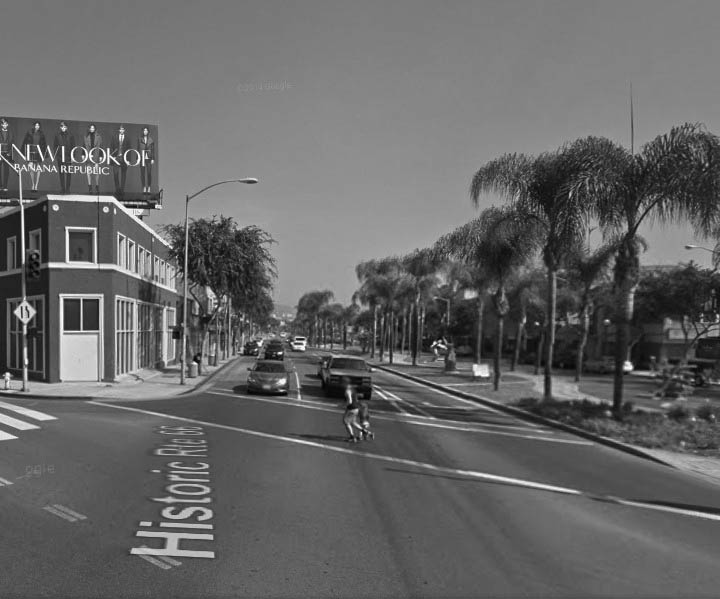 |
|
| (2014)*### – Google street view looking east on Santa Monica Boulevard at Doheny Dr. |
Historical Notes The building on the corner has stood empty for nearly 40 years. The billboard remains atop, and provides the owner tens of thousands of dollars in revenue each month. The billboard is grandfathered, and cannot be modernized. In addition, any modification to or construction in the building require the billboard to be taken down. So there it stands... |
Before and After
.jpg) |
.jpg) |
|
| (1948 vs. 2014) - Before and After - Santa Monica and Doheny |
Historical Notes The second white building on the left would become the Troubadour Nightclub in 1957. |
Santa Monica and San Vicente
 |
|
| (ca. 1946)##^* - An early model Cadillac meets up with PE car No. 5120 at the intersection of Santa Monica and San Vicente boulevards. Val's Coffee Shop can be seen on the NE corner at 8875 Santa Monica Blvd. |
Santa Monica and La Cienega
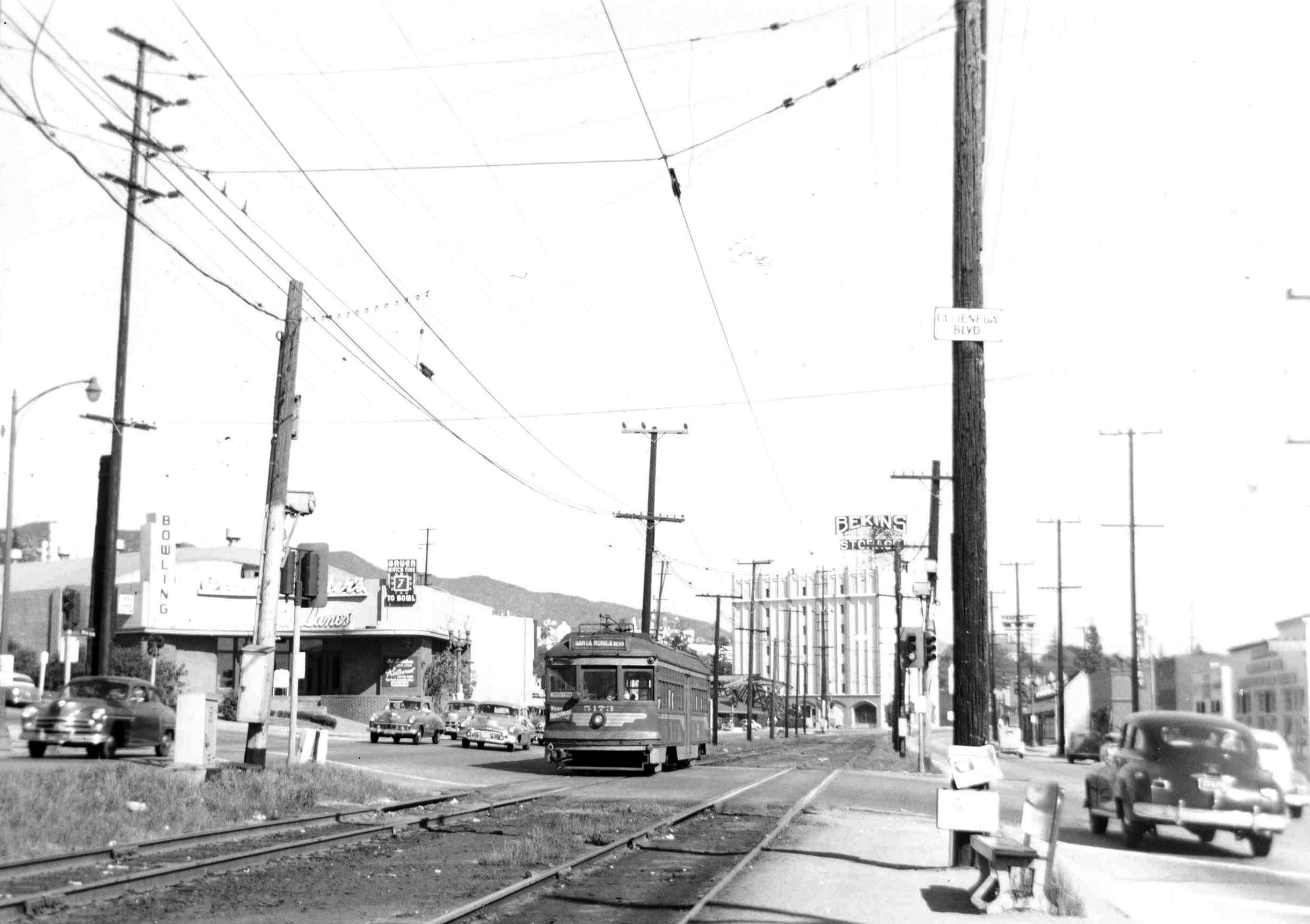 |
|
| (ca. 1947)#+#+ - View looking northeast showing streetcar and tracks running down the center of Santa Monica Boulevard at La Cienega Boulevard. The La Cienega Lanes bowling alley (built in 1940) is seen on the N/E corner. |
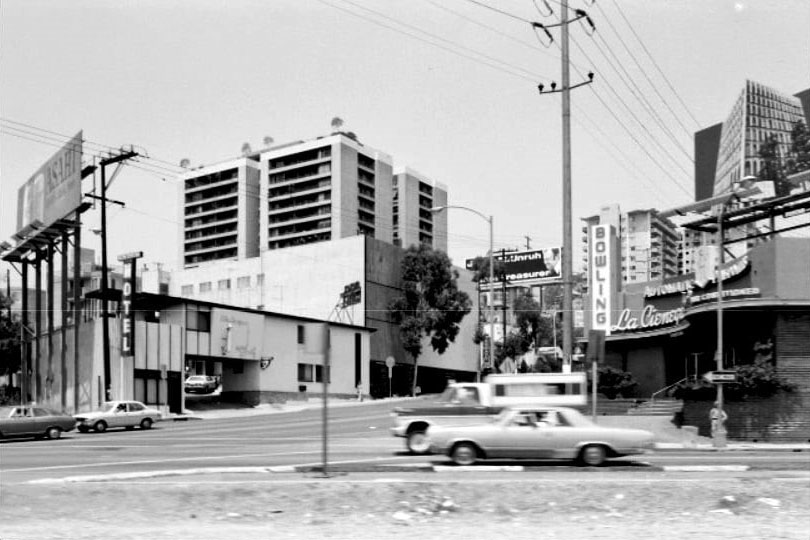 |
|
| (1974)^ – View looking north at the intersection of La Cienega and Santa Monica Boulevard with La Cienega Lanes seen on the right. |
Historical Notes In 1946, radio and television personality Art Linkletter and his associates acquired the bowling alley on the northeast corner of Santa Monica Blvd and La Cienega Blvd and called it Art Linkletter’s La Cienega Lanes. In the 1970s, it became a roller disco called “Flippers”. |
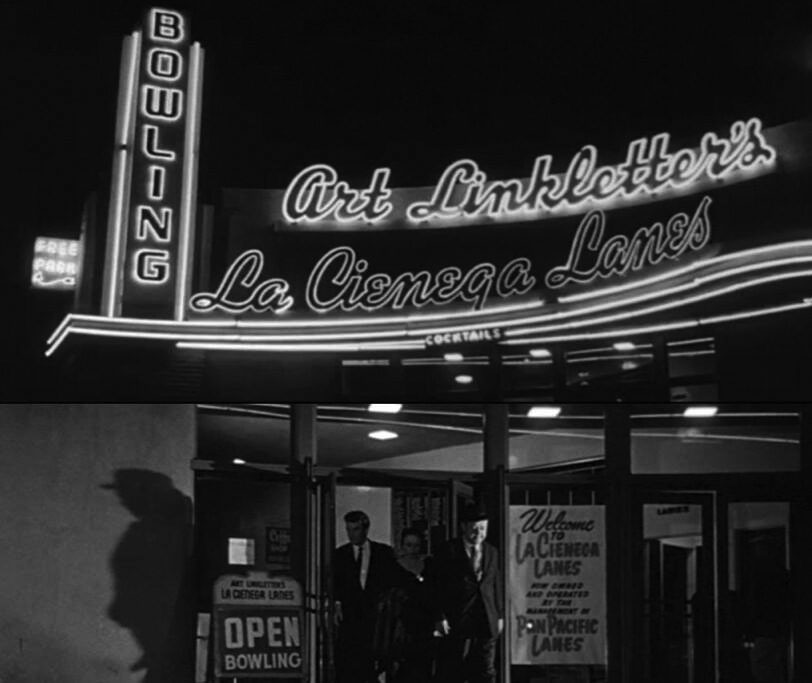 |
|
| (n.d.)* - Night view showing the front entrance to Art Linkletter's La Cienega Lanes on the N/E corner of Santa Monica and Lacienega boulevards. |
Historical Notes Art Linkletter was a radio and television personality who hosted several TV and radio shows for over 25 years (House Party, People Are Funny, and Kids Say the Darndest Thigs). He was famous for interviewing children on his shows, which led to a series of books quoting children.*^ |
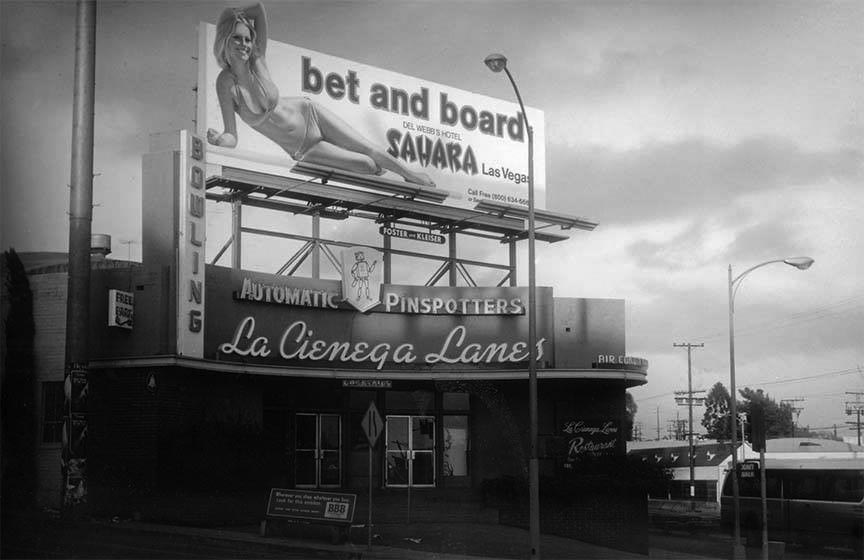 |
|
| (ca. 1965)* – View showing the La Cienega Lanes bowling alley, now with automatic pinspotters. |
Historical Notes La Cienega Lanes lived during a popular time for bowling, when the LA Times even had a regular bowling column. The lanes survived into the 1970s, but bowling began to lose its popularity. Adapting with the times, the building transformed into the next hottest thing: a late-70s roller disco. +++ |
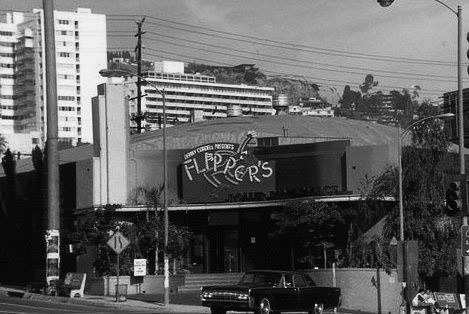 |
(ca. 1980)+++# - View showing Flipper's Roller Derby Palace on the N/E corner of La Cienega and Santa Monica boulevards. |
Historical Notes Flipper's Roller Boogie Palace opened up in July 1979. The owners were Denny Cordell, Nicholas Cowan and Flipper (a mysterious Englishman named Flipper). The property was partly owned by Berry Gordy, Motown's head man. Flipper's was a posh and exclusive nightclub for skaters. It was also a private club. However, one didn't have to be rich and famous to join. Membership was limited to 1,000. A 5-man membership committee chose the members who paid $200 annually plus a $7 entrance fee. It was open 8pm 'til late. +++# |
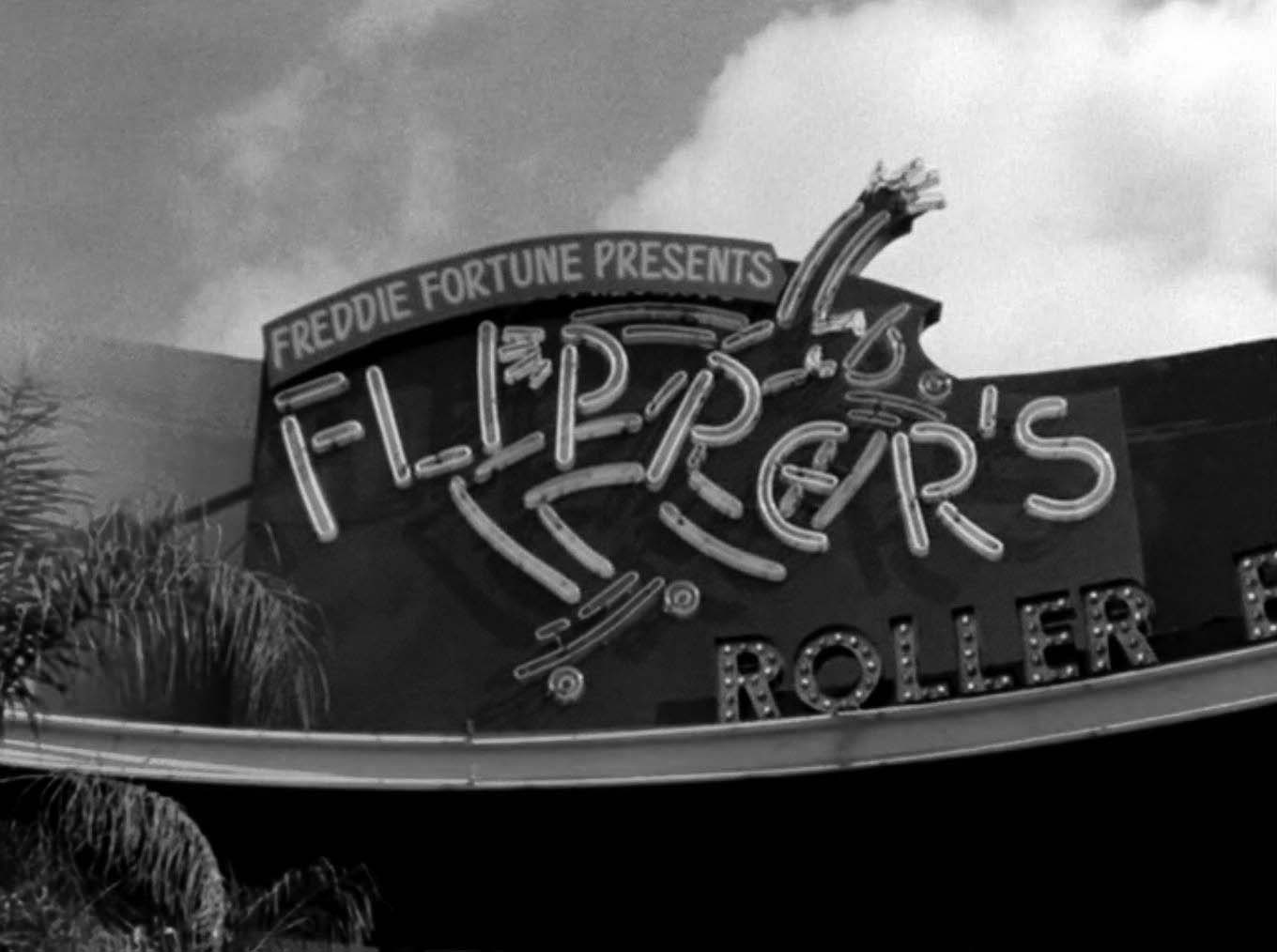 |
|
| (ca. 1980)* - Close-up view showing sign above the front entrance to Flipper's Roller Derby Palace. |
Historical Notes Flipper's had a bar, restaurant and a custom skate shop. It was decorated to look like a plush exotic tropical fantasy paradise. It had mirrors, disco balls, mural and private booths. Rather than wood, the skating floor was made of polyurethane. |
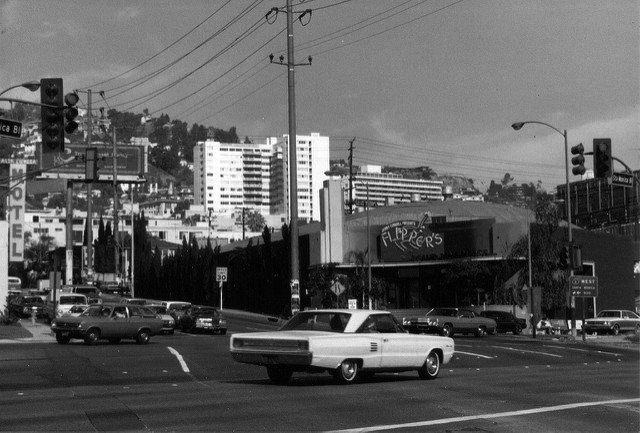 |
|
| (ca. 1981)*- View showing 1967 Dodge Coronet at the intersection of Santa Monica and La Cienega, with Flipper's Roller Derby Palace on the N/E corner. |
Historical Notes In 1983 the site became a Esprit De Corps. - a woman's apparel retail shop. Today a CVS drug store occupies the site. |
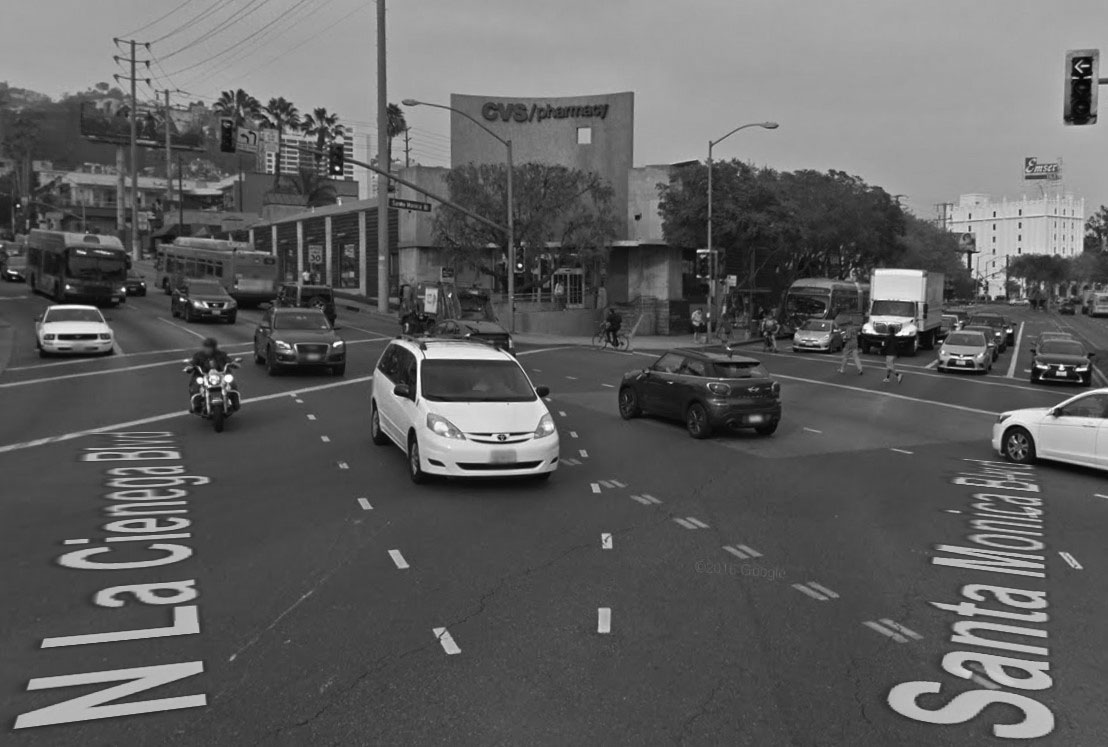 |
|
| (2016)* – Google street view showing the N/E corner of Santa Monica and La Cienega boulevards where a CVS Pharmacy now occupies the building which once housed the La Cienega Lanes. |
Then and Now
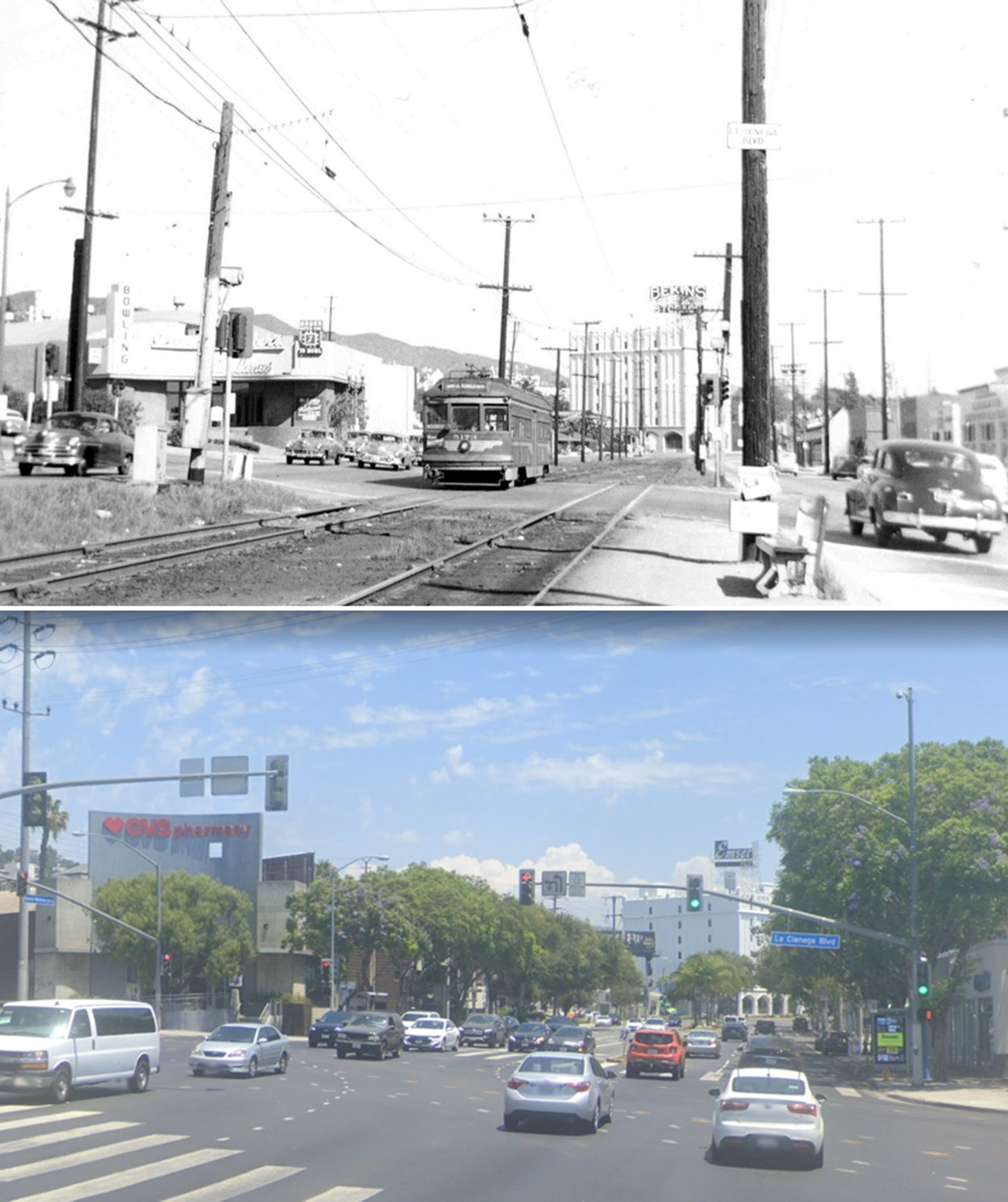 |
|
| (1947 vs 2022)* - Looking northeast showing streetcar and tracks running down the center of Santa Monica Boulevard at La Cienega Boulevard. The 1940-built La Cienega Lanes bowling alley (today a CVS Pharmacy) is seen on the N/E corner. In the distance is the old Bekins building (today, Emser Tile building). |
Santa Monica Blvd and Orlando Ave
 |
|
| (1930s)* - Looking north on Orlando Avenue toward Santa Monica Boulevard. |
Then and Now
.jpg) |
|
| (1930s vs 2021)* - Looking north on Orlando Avenue toward Santa Monica Boulevard. |
Santa Monica Blvd and Flores St
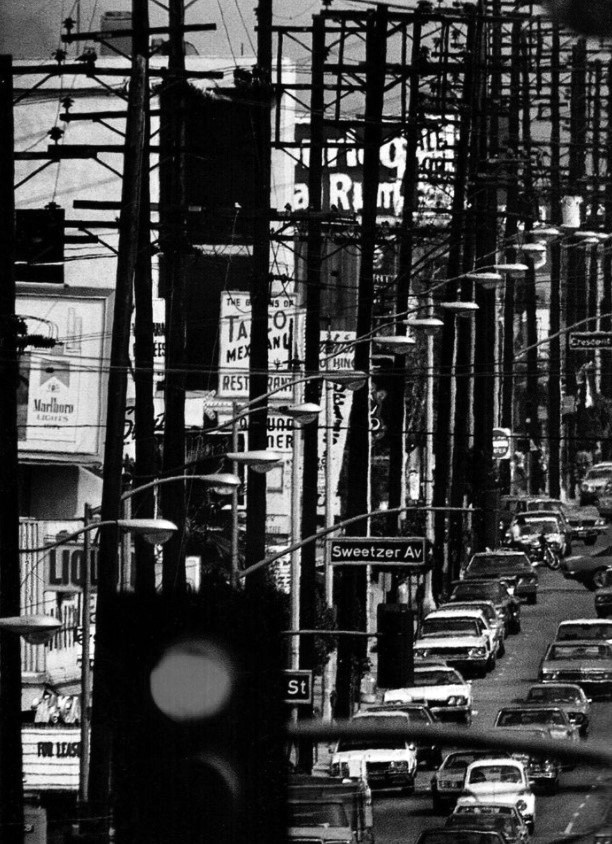 |
|
| (1979)^.^ – CAN'T SEE THE FOREST FOR THE TREES. Telephoto view looking east on Santa Monica Blvd at Flores Street showing overhead pole line congestion. The Gardens of Taxco Mexican Restaurant sign can be seen past Sweetzer Ave at Harper Ave. Taxco was actually located just north of the Yellow Submarine located on the NW corner. At lower-left can be seen The Gary Theatre (originally Players Ring Theatre, today Coast Playhouse) |
Historical Notes The Players Ring Theatre was a live stage theatre which opened by 1949. By the mid-1960s, this theatre was twinned and renamed Gary Theatre I & II. It ran gay porn movies during the 1970’s, and revival shows through the 1980’s. Since at least the mid-1980’s it has operated as a live theatre, known as the Coast Playhouse, it often presents plays with a gay theme, complementing its West Hollywood location.* |
 |
|
| (2019)^ – Google Street View looking East on Santa Monica Blvd at Flores Street. Basix Cafe can be seen at left, on the NE corner. Two doors to the East stands The Coast Playhouse (originally Players Ring Theatre). All the overhead lines and poles have been removed. |
Troubadour Nightclub
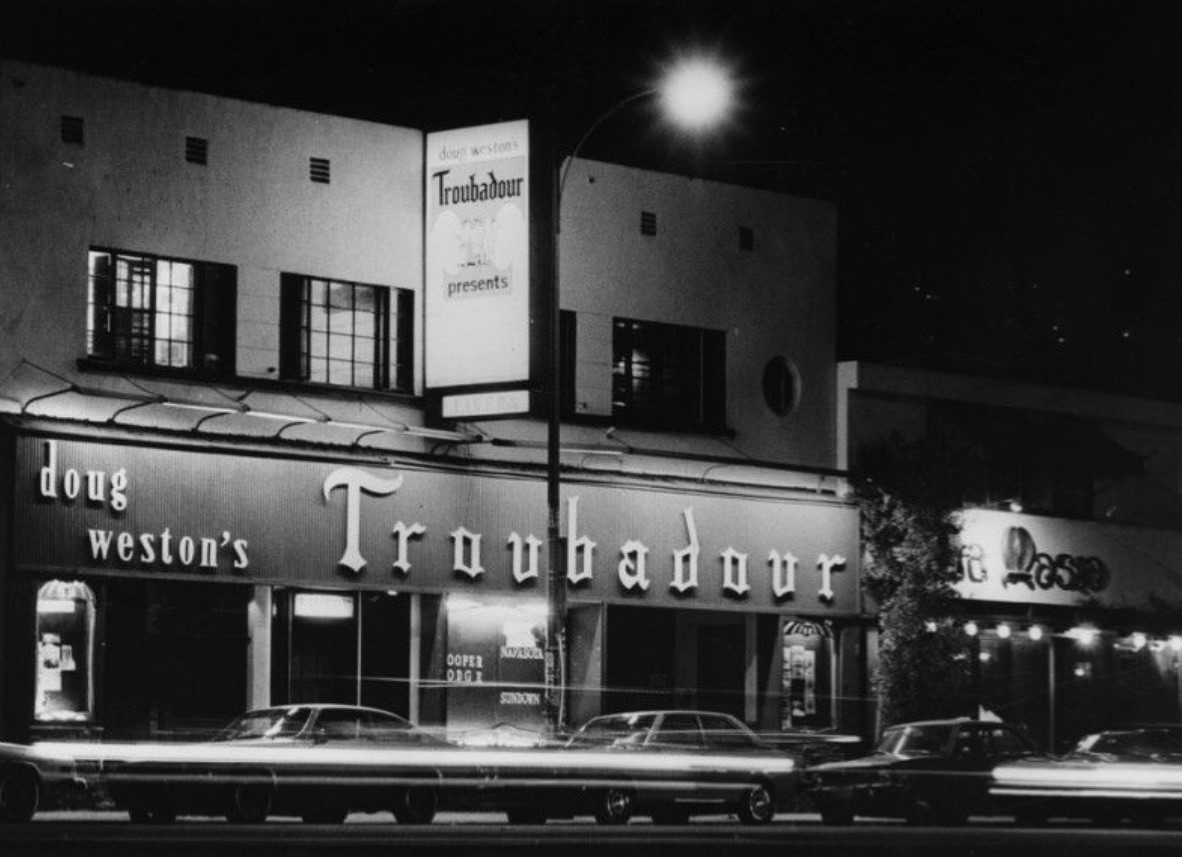 |
|
| (1979)* - The Troubadour Nightclub located at 9081 Santa Monica Boulevard, West Hollywood, just east of Doheny Drive and the border of Beverly Hills. |
Historical Notes Opened in 1957 by Doug Weston, the Troubadour was originally a coffee house located on La Cienega Boulevard. It then moved to its current location shortly after opening and has remained open continuously since. It was a major center for folk music in the 1960s, and subsequently for singer-songwriters and rock.*^ |
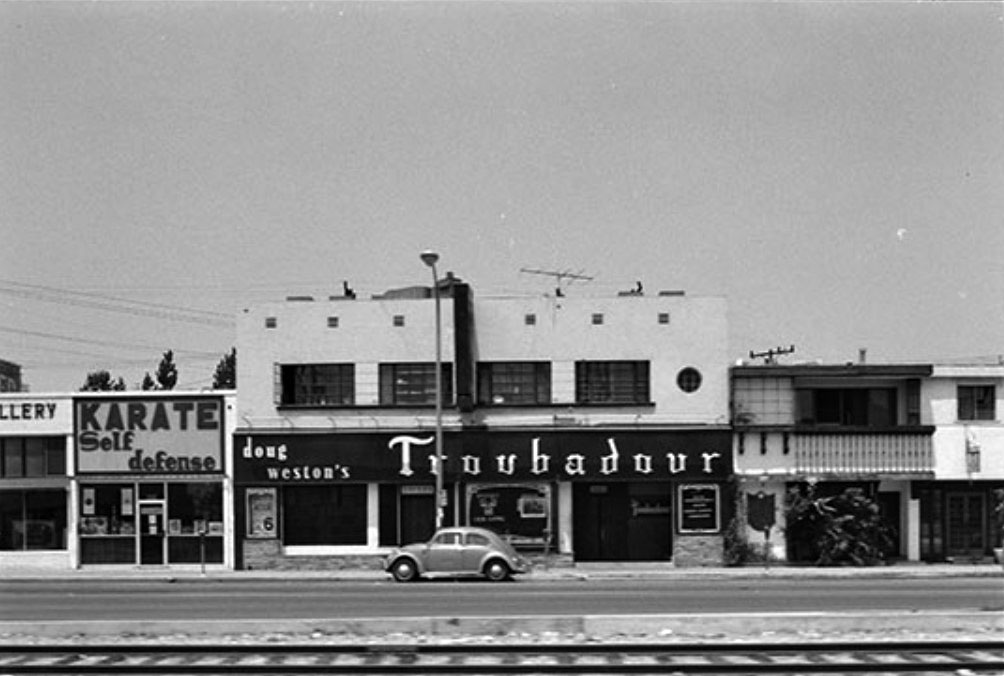 |
|
| (1974)^ – View looking across the tracks on Santa Monica Boulevard showing the Troubadour Nightclub. |
Historical Notes The Troubadour played an important role in the careers of Elton John, Linda Ronstadt, James Taylor, the Eagles, The Byrds, Love, Joni Mitchell, Hoyt Axton, Carole King, Bonnie Raitt, J.D. Souther, Jackson Browne, Van Morrison, Buffalo Springfield and other prominent and successful performers, who played performances there establishing their future fame.* |
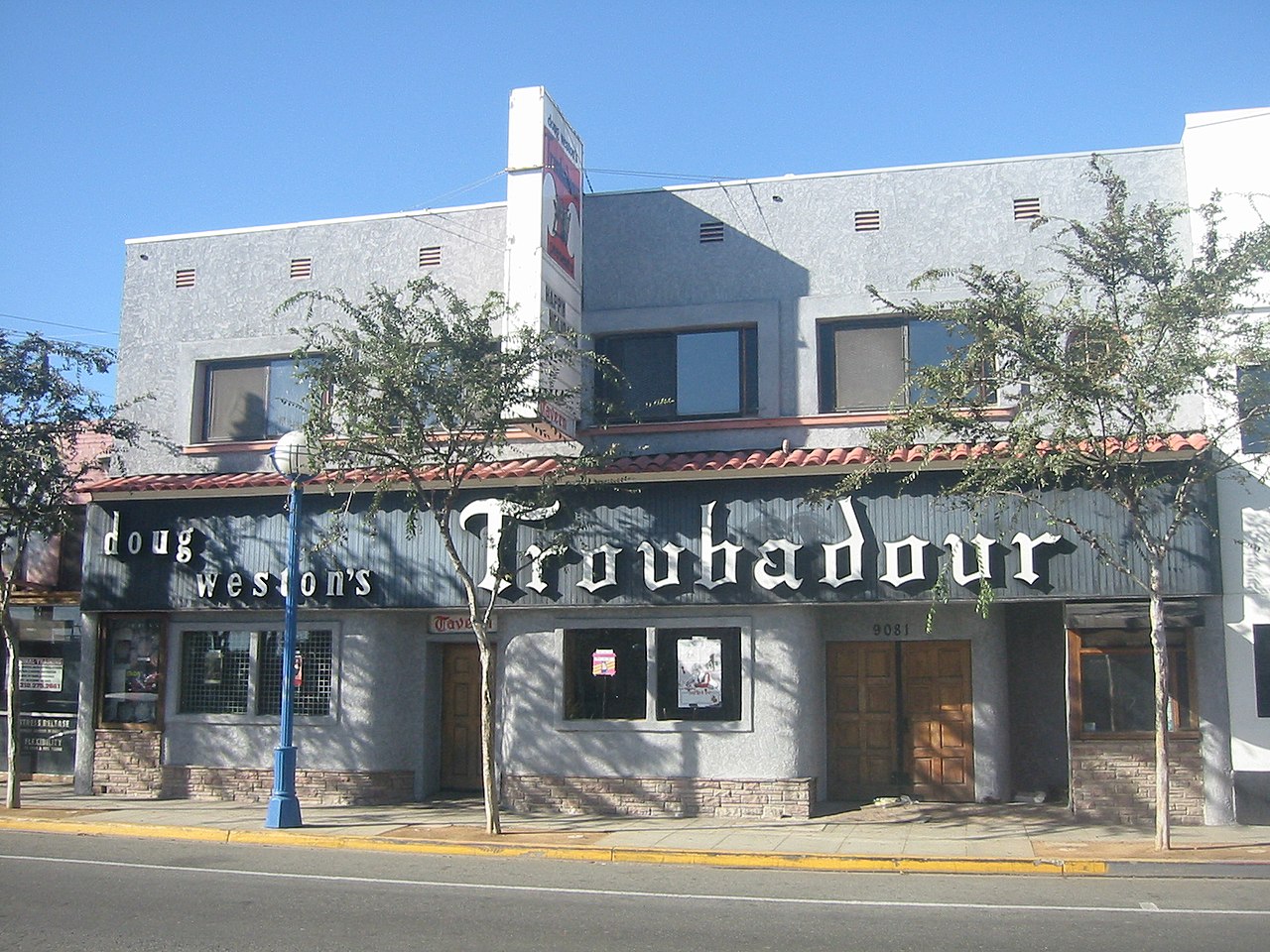 |
|
| (2006)* - View of Doug Weston's Troubadour nightclub in West Hollywood. Other than the paint color, the exterior hasn’t changed much since it opened in 1957. |
Historical Notes In 1962, comedian Lenny Bruce was arrested on obscenity charges for using the word "schmuck" on stage; one of the arresting officers was Sherman Block, who would later become Los Angeles County Sheriff. On August 25, 1970, Neil Diamond (who had just recorded his first live album at the Troubadour) introduced Elton John, who performed his first show in the United States at the Troubadour. In 1974, John Lennon and his friend Harry Nilsson were ejected from the club for drunkenly heckling the Smothers Brothers. Randy Newman started out at the club and comics Cheech & Chong and Steve Martin were discovered there. In 1975, Elton John returned to do a series of special anniversary concerts. In November 2007, James Taylor and Carole King played a series of concerts commemorating the nightclub's 50th anniversary and reuniting the two from their 1970 performance.* Click HERE for a contemporary street view. |
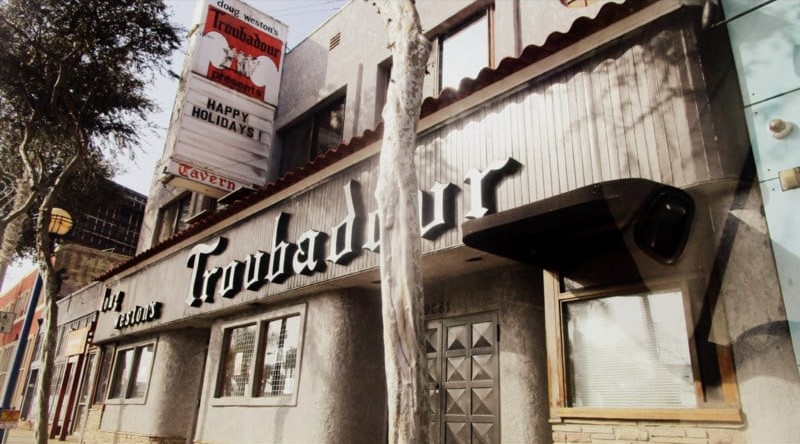 |
|
| (2020)^ - Close-up view of the front entrance to the Troubadour, 9081 Santa Monica Boulevard. Photo by Flo Selfman |
Historical Notes In 2020, like many small businesses & music venues, the Troubadour has struggled during the pandemic, and launched a GoFundMe page in May, which raised $70,000. In August, Elton John celebrated his 50th anniversary of playing the venue, and expressed his concern about the survival of the iconic nightclub. Comedian Bill Burr has also hosted 2 of his Monday Morning Podcasts from the venue to raise money during the Pandemic.^ |
Then and Now
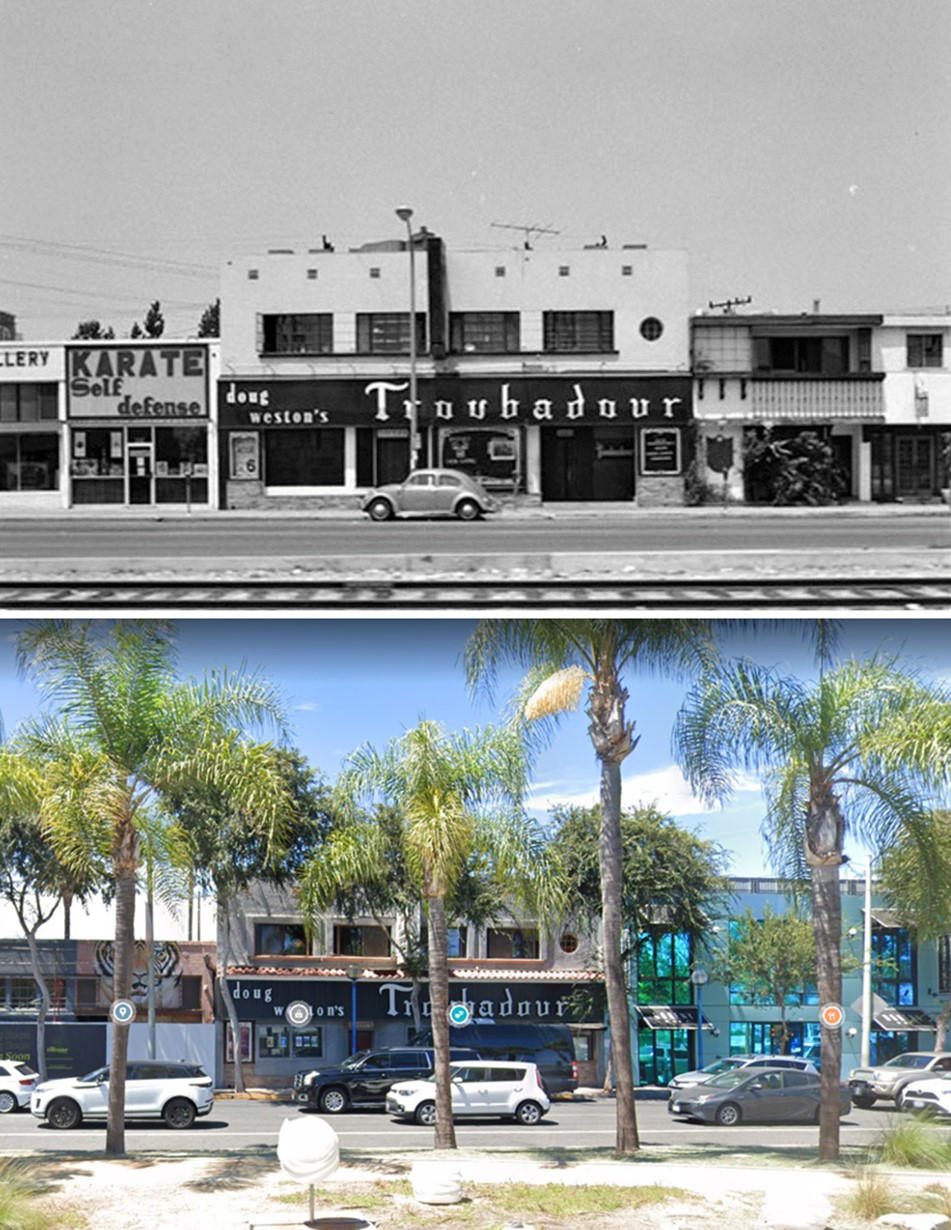 |
|
| (1974 vs 2022)* - Looking across Santa Monica Boulevard toward the Troubadour Nightclub. |
Jones Dog & Cat Hospital
 |
|
| (1938)* - Dr. Eugene C. Jones Animal Hospital located at 9080 Santa Monica Boulevard in West Hollywood. |
Historical Notes The Streamline Moderne Jones Dog & Cat Hospital building was designed by the prominent architecture firm of Wurdeman and Becket. Two other examples of the work of Wurdeman & Becket include the former Mobil Oil/General Petroleum Building, now Pegasus Apartments, and Bullock's Pasadena, now Macy's. As Welton Becket & Associates, the firm went on to design many of L.A.'s iconic landmarks, including Capitol Records Tower, the Music Center of Los Angeles County, and the Cinerama Dome. The redesigned structure, completed in 1938, is an excellent example of the Streamline Moderne architectural style that emerged in the 1930s. It features smooth wall surfaces, curved corners and volumes, and an emphasized horizontal design. The windows are arranged in continuous ribbons across the façade, with extensive use of glass block. Accentuating the building’s sleek lines, polished stainless steel is used for the entrance canopy and vertical fins rising above the main door. Taking its name from the curved form of a teardrop, which was the most efficient shape in lowering the wind resistance of an object placed in the stream lines of a wind tunnel, the Streamline Moderne evoked a sense of modern efficiency with curved surfaces, sleek finishes, and a spare use of detailing which often included pronounced horizontal banding and, in some cases, contrasting vertical accents.* |
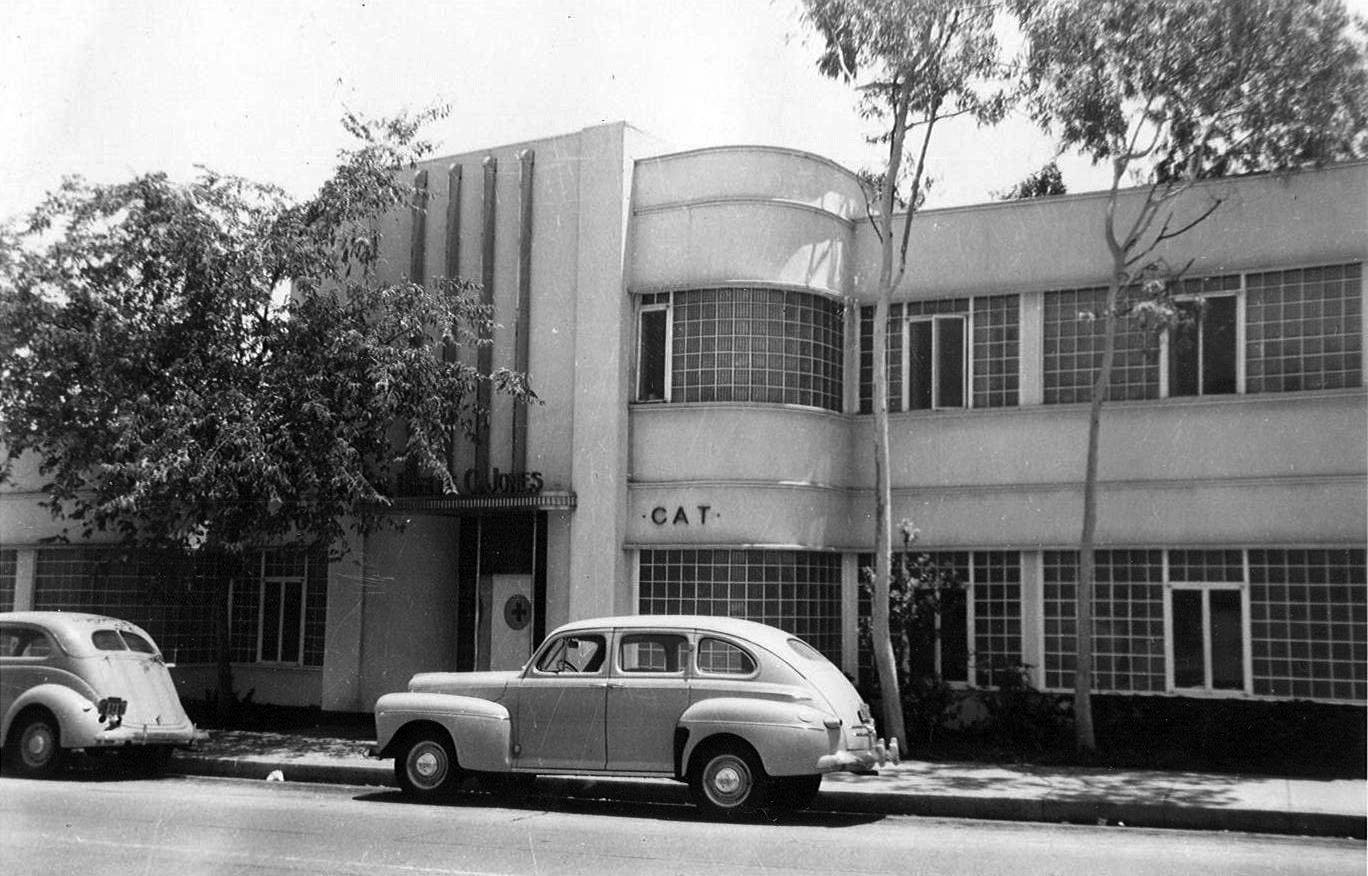 |
|
| (1947)^ – Two cars are parked in front of Jones Dog and Cat Hospital. |
Historical Notes Dr. Eugene C. Jones, a progressive veterinarian whose clients included the likes of Charlie Chaplin, Gloria Swanson and Rudolph Valentino, commissioned Wurdeman and Becket to expand and remodel his original 1928 animal hospital, transforming it into a sleek and modern facility. Dr. Jones’ animal hospital, which specialized in dogs and cats, was considered one of the first in Southern California. Its location at the western edge of West Hollywood near the border with Beverly Hills put it within short distance of the homes of wealthy clientele and their pets.* |
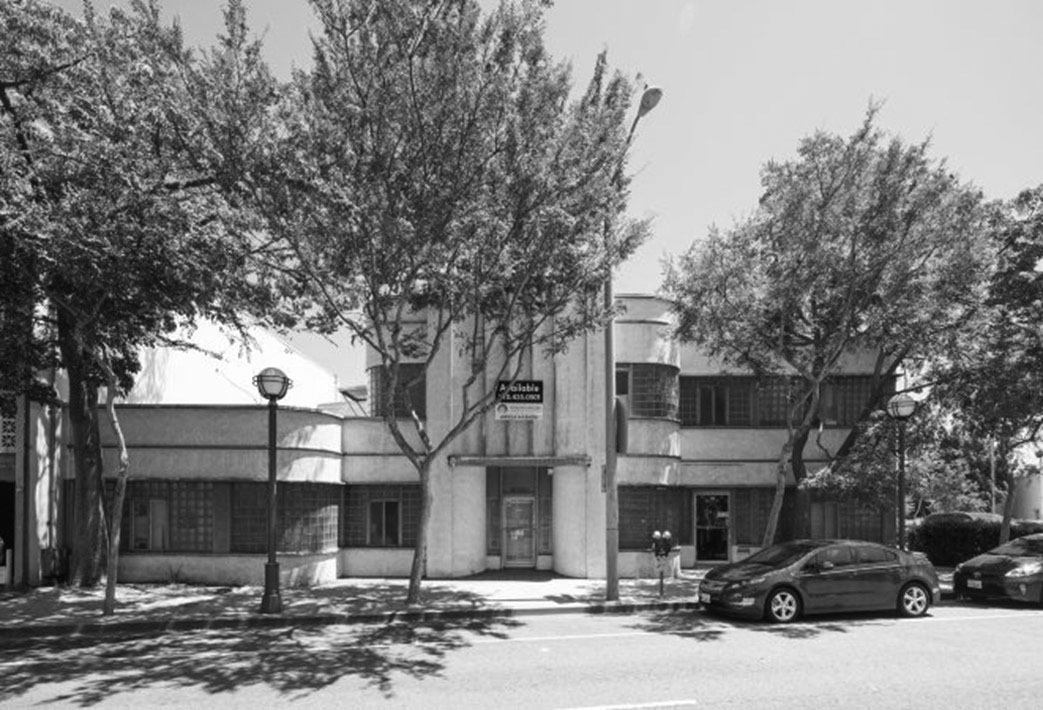 |
|
| (2014)^ – Jones Building available for lease. Located at 9080 Santa Monica Boulevard, across the street from the Troubadour Night Club. Photo by Hunter Kerhart |
Historical Notes The building operated as an animal hospital for several decades. Between 1951 and 1981, the building was owned and operated by R. Nichol Smith, D.V.M. as a dog hospital. This historic West Hollywood building was demolished in 2021 to make way for a mixed-use development.* |
Melrose, Santa Monica, and Doheny Intersection
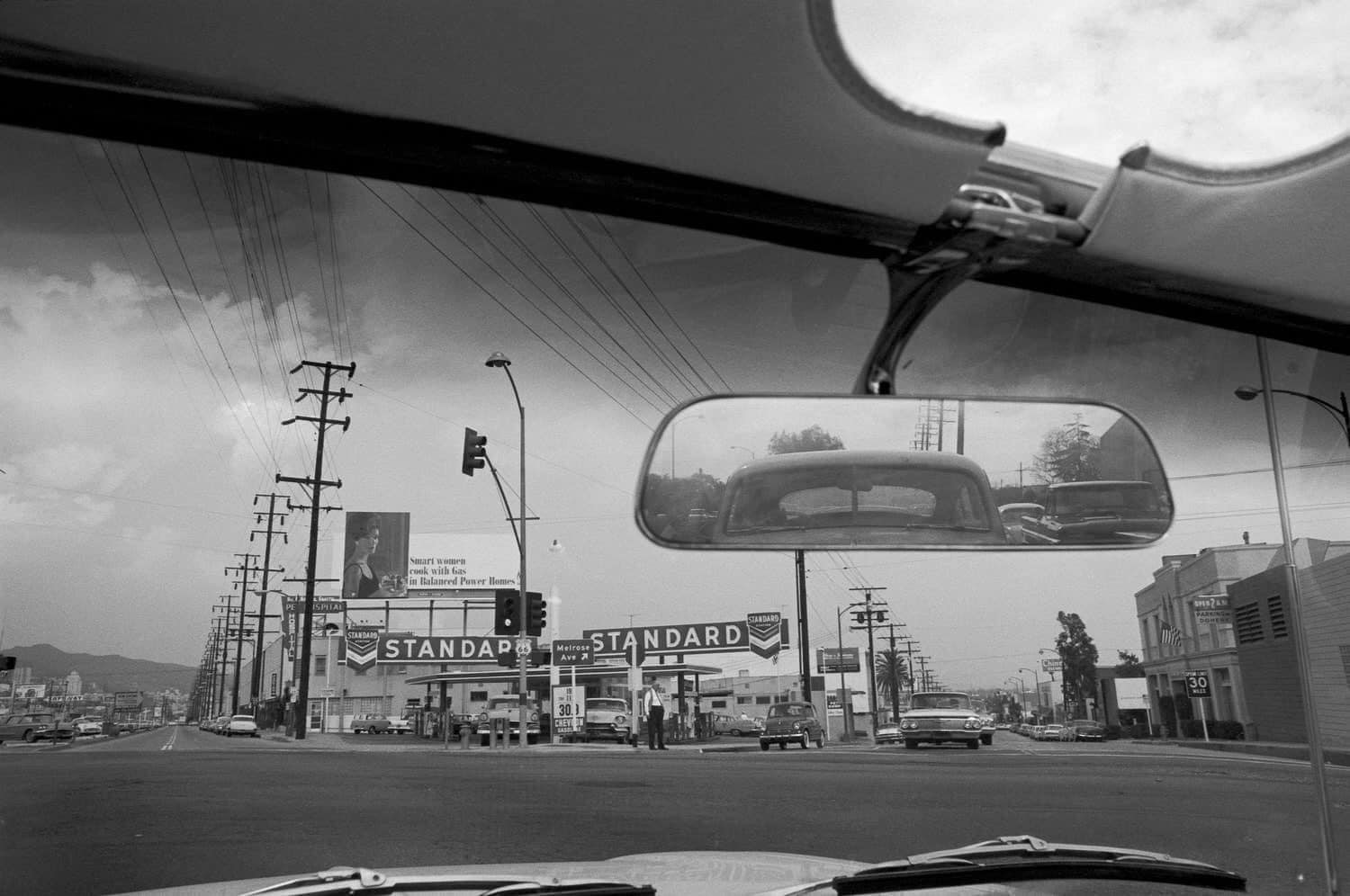 |
|
| (1950s)* – Looking East at the Melrose, Santa Monica and Doheny intersection. Santa Monica Blvd is on the left. The Troubador is out of sight off to the left on the other side of Santa Monica. The future Figaro’s can be seen as the two story white building on the right side of Melrose. |
Then and Now
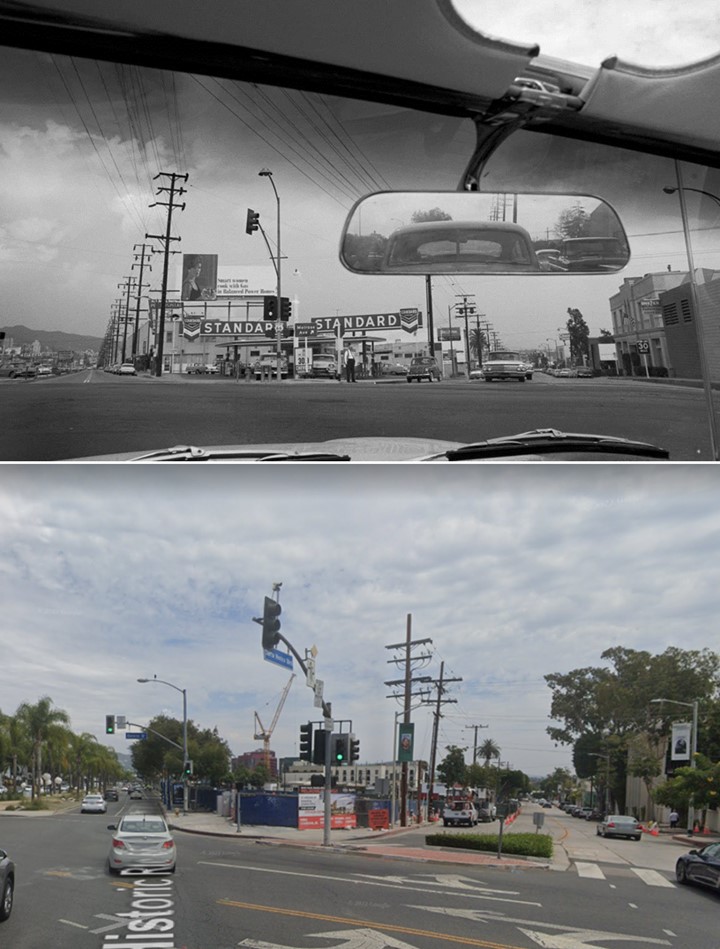 |
|
| (1950s vs. 2022)* – Melrose, Santa Monica and Doheny intersection. |
Doheny Drive
.jpg) |
|
| (1962)^ – View looking north on Doheny Drive between Sunset Blvd. and Santa Monica Blvd. |
Historical Notes Doheny Drive forms the western end of the Strip, which ends at Crescent Heights Boulevard to the east. It is named for Edward L. Doheny, a Los Angeles oil tycoon. |
Crescendo Nightclub
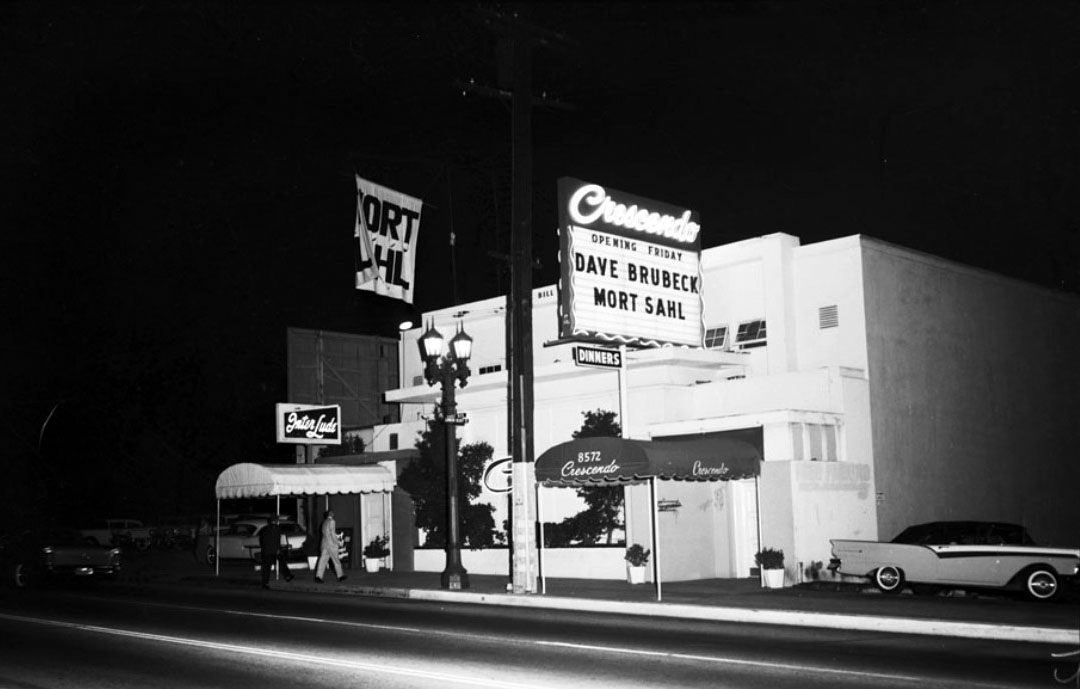 |
|
| (ca. 1958)***^^ – View showing the Crescendo Nightclub located at 8572 Sunset Boulevard on the Sunset Strip. The Marquis reads: Opening Friday – Dave Brubeck and Mort Sahl |
Historical Notes Gene Norman owned the Crescendo Nightclub (also the Interlude) on the Sunset Strip during the 1950s and 1960s featuring popular music and jazz. He also formed the GNP label which used many live recordings directly from the Crescendo Club. Norman featured virtually every record and cabaret star such as Johnny Mathis, Duke Ellington, Louis Armstrong, Count Basie, Bob Newhart an Ella Fitzgerald. The typical Crescendo show was Mort Sahl, The Dave Brubeck Quarter, June Christy and the Stan Kenton Band. During all that time he was producing jazz albums, both in clubs and in the studio.*^*^^ |
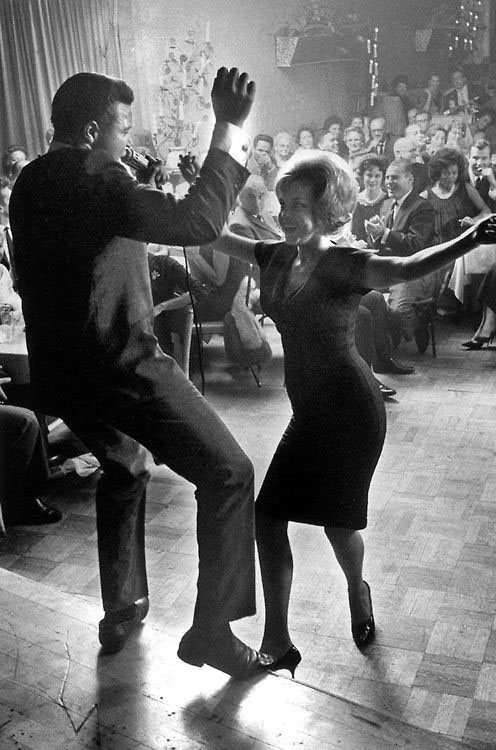 |
(1961)#^#* - Chubby Checker, originator of 'The Twist', dancing with audience member at the Crescendo Nightclub, Hollywood.
|
Historical Notes Chubby Checker (born Ernest Evans) is widely known for popularizing the twist dance style, with his 1960 hit cover of Hank Ballard's R&B hit "The Twist". In September 2008 "The Twist" topped Billboard's list of the most popular singles to have appeared in the Hot 100 since its debut in 1958, an honor it maintained for an August 2013 update of the list. He also popularized the Limbo Rock and its trademark limbo dance, as well as various dance styles such as the fly.*^ |
Dino’s Lodge (77 Sunset Strip)
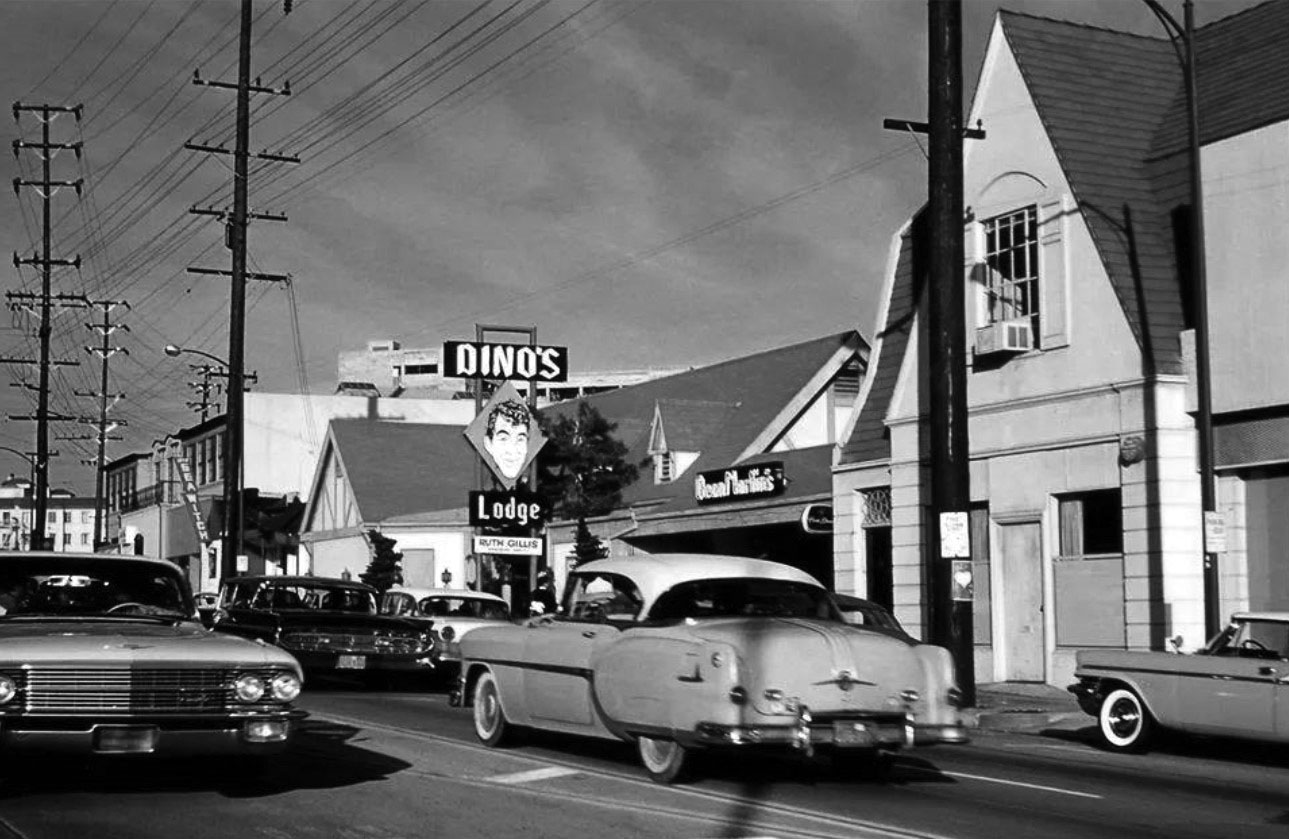 |
|
| (1962)* - View of Dino’s Lodge, located at 8532 Sunset Boulevard. |
Historical Notes The address of 8532 Sunset had been home to an auction house in the nineteen forties, one that specialized in wooden furniture. By the early fifties the space had been renamed, remodeled and opened as a dining spot called the Alpine Lodge. The family restaurant had a loosely defined wooden shoe concept and was not particularly successful. Described as "an attractive Swiss restaurant which fell on hard times," the owners soon dropped the word Alpine and replaced it with the name Dino, while leaving much of its decor intact. Dino's Lodge had its grand opening in the spring of 1958. When the strange sketch that became the memorable sign was raised to the sky, its base cemented to the ground and the switch turned on, most assumed this meant it was Dean Martin's restaurant. Of course, this is exactly what the owners of the former Alpine wanted. "Contrary to report," explained an April 1958 edition of the Los Angeles Times, "Dean Martin does not own the restaurant on the Strip ... They just use his name and give him a percentage." It was a large percentage. Fifty percent. * |
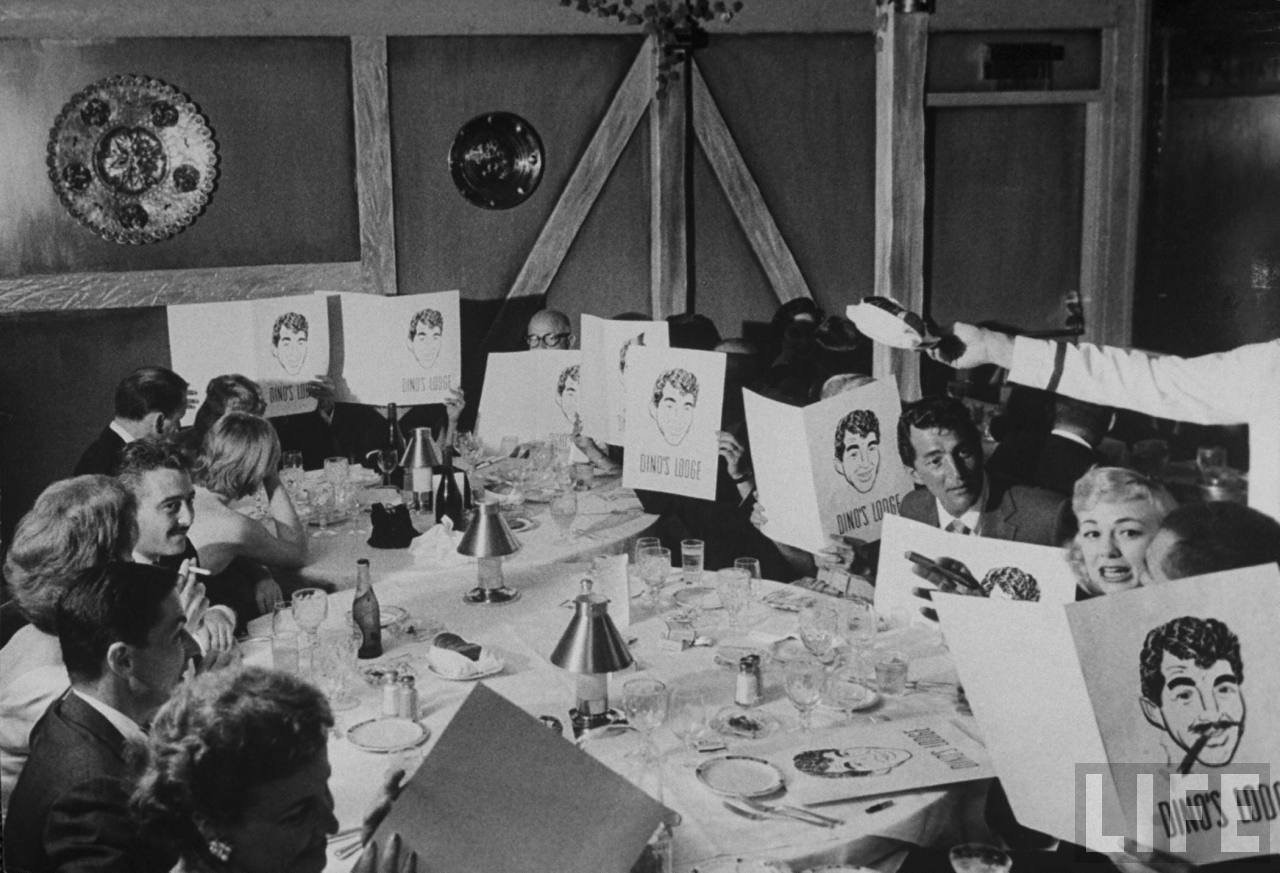 |
|
| (1960s)* – Dean Matin and friends enjoy a meal at Dino’s Lodge. Ernie Kovacs put a mustache and cigar on his menu. Life Magazine |
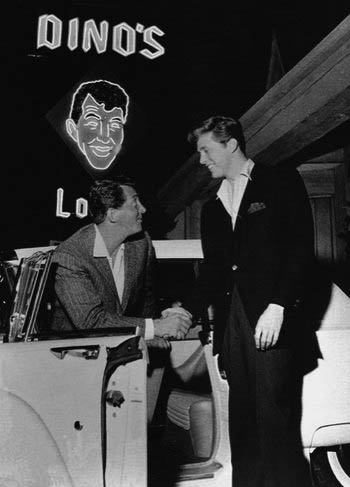 |
(1960s)* - View showing Dean Martin and 'Kookie' (Ed Byrnes), one of the stars of the TV show 77 Sunset Strip, in front of Dino's Lodge.
|
Historical Notes Dino's Lodge restaurant lasted twenty years. It is primarily remembered by fans of the television series 77 Sunset Strip. By the early seventies, this restaurant that had once hosted parties for Frank Sinatra, was part of a cornball travel agency package that advertised a two-hundred and forty-dollar "guided tour of a motion picture studio, a full day at Disneyland and dinner at Dino's Lodge."* |
Sea Witch Club
 |
|
| (ca. 1965)* – View showing the Sea Witch Club located at 8516 W. Sunset Boulevard, just a couple of doors east of Dino's Lodge. The sign by the front door reads: "Straight Jackets", which was the house band from 1964 to 1965. |
Historical Notes The Sea Witch was designed all out of raw wood and was supposed to look like a ship. Size wise, it was a very small club when compared to others on the Strip and always crowded. It had a capacity of maybe 60-70 people. |
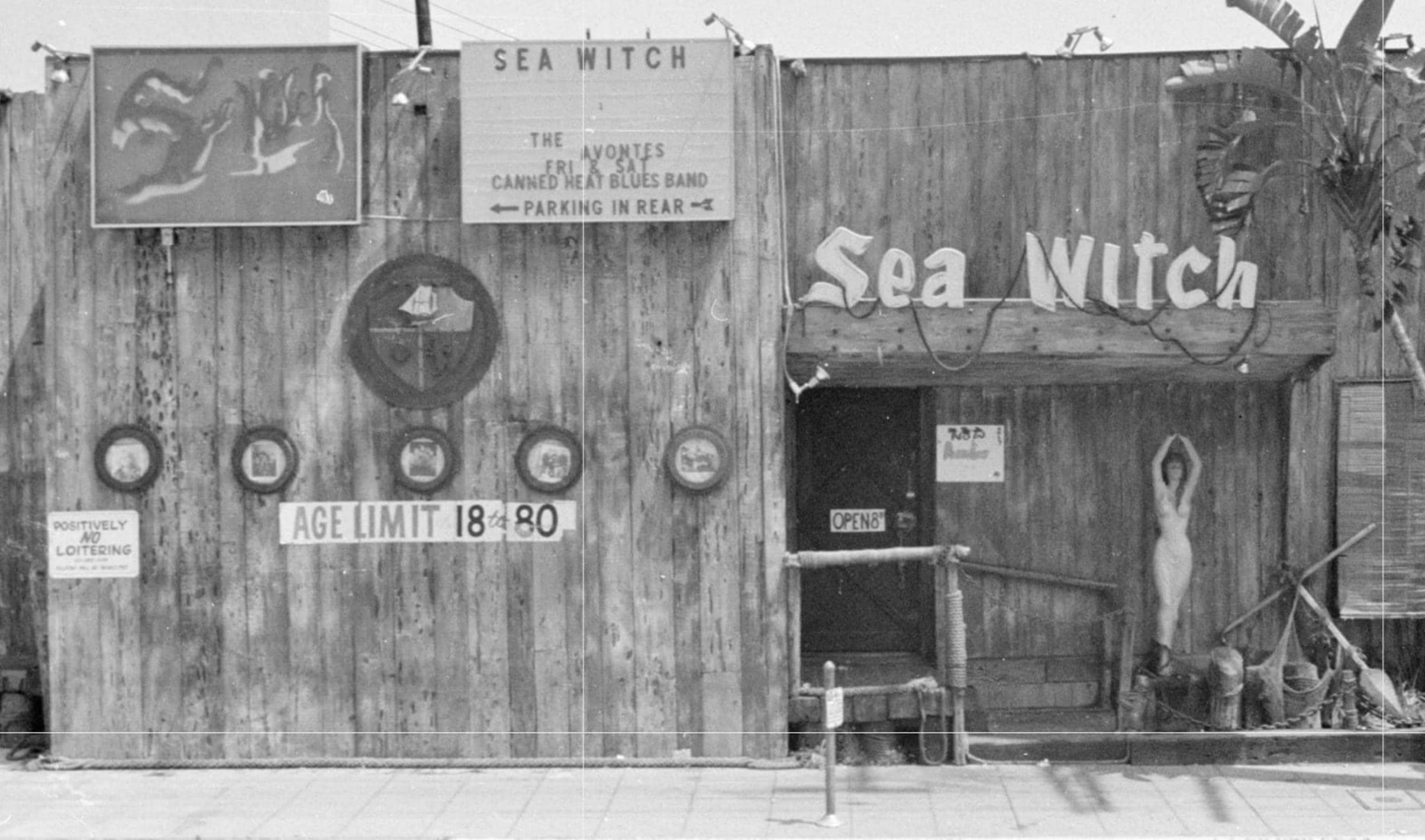 |
|
| (1960s)* – Daytime view of The Sea Witch on the Sunset Strip. Age Limit: ‘18 to 80’. ‘Canned Heat Blues Band now performing Friday and Saturday’. |
Historical Notes On December 9th and 10th, 1966, a new band called “The Doors” played to a packed audience at this now defunct venue. Unfortunately, the entire block of buildings which included the Sea Witch, Dino’s Lodge and the Tiffany Theater was torn down in 2013. Today the location that all three occupied is a multi-story parking garage.* |
* * * * * |
Chasen's Restaurant
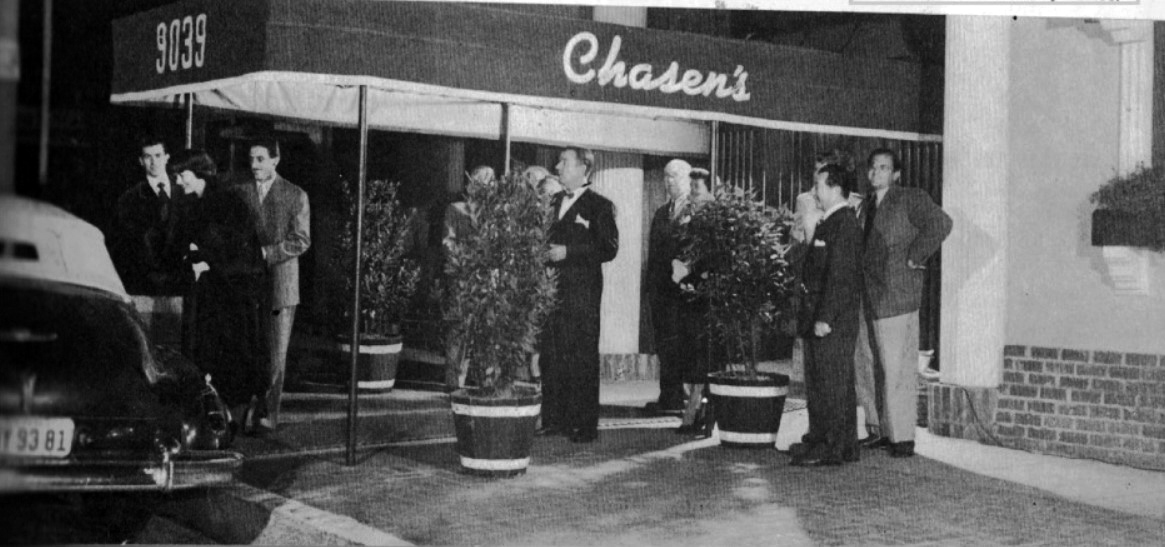 |
|
| (1940s)^.^ – View showing a group well-dressed people waiting for their cars in front of Chasen’s Restaurant located on the NE corner of Beverly Boulevard and Doheny Drive in West Hollywood. |
Historical Notes Chasen’s opened in 1936 by owner Dave Chasen at the suggestion of director Frank Capra. It was just a humble shack named "Chasen's Southern Pit " (because of a barbecue pit in the back). It chili quickly became popular with the show biz crowd, and Chasen's rapidly grew into Hollywood's premier restaurant. Chasen's stuck with the American/Continental fare that brought it success, serving it in a warm, clubby atmosphere of heavy wood paneling and red leather booths. They still served the chili that made them famous (although it wasn't listed on the menu anymore), as well as their hobo steak and deviled beef bones. When Elizabeth Taylor was making "Cleopatra " in Rome, she had their chili flown out to her. |
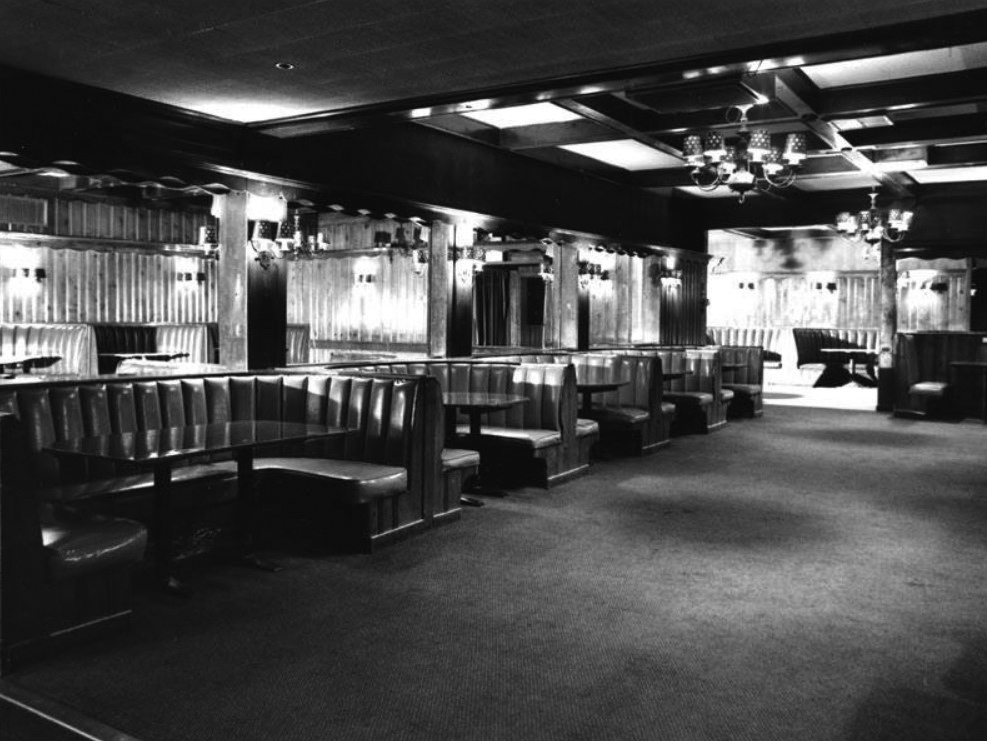 |
|
| (n.d.)^^ – Interior view of Chasen’s showing leather booths and heavy wood paneling. |
Historical Notes The restaurant, which was run by Maude Chasen and her husband Dave until his death in 1973, focused on hearty American/Continental cuisine and became as famous for its colossal seafood platters, hobo steak, a buffet that offered beluga caviar, and delicious cheese toast appetizers as its clientele.* |
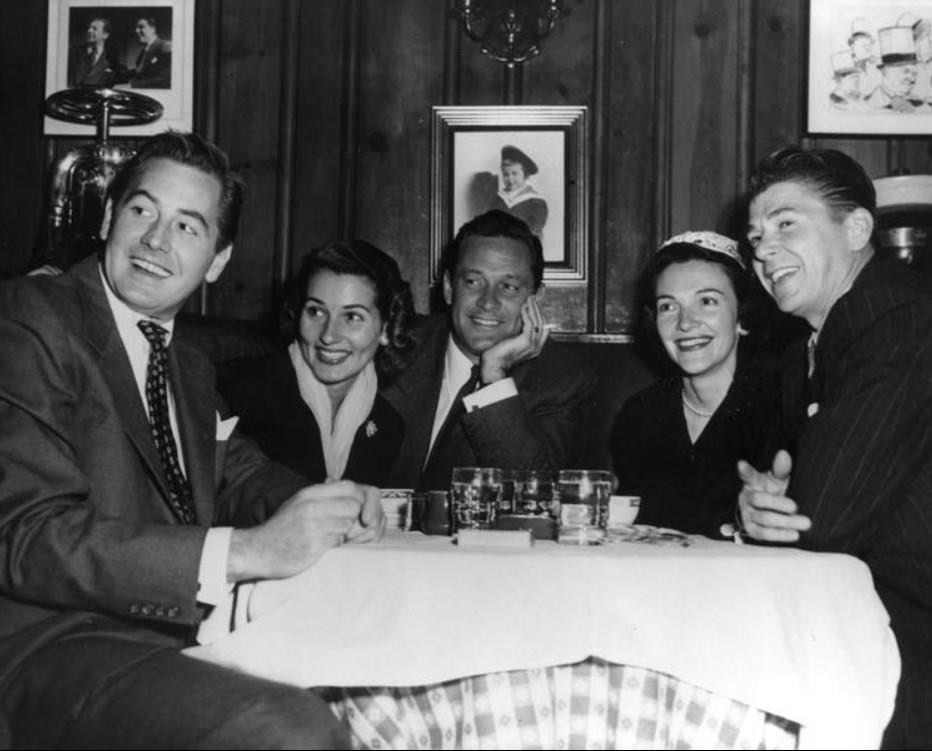 |
|
| (n.d.)^^ - Chasen’s was a hangout for celebrities. Seen at center are William Holden and wife, Brenda Marshall. To the right is Ronald Reagan and wife, Nancy. |
Historical Notes Chasen’s became the culinary hangout of Frank Sinatra, Cary Grant, Clark Gable, Lana Turner, and Groucho Marx. Jimmy Stewart held his bachelor party here, Howard Hughes was seen constantly on the house phone, Alfred Hitchcock routinely fell asleep at his table. After Johnny Carson won his third Emmy in as many years, he took all of the show’s insiders for a celebratory dinner at Chasen’s. Donna Summer wrote her hit “She Works Hard For the Money” on toilet paper in the bathroom—that was Chasen’s for you.* |
 |
|
| (2014)^ – View showing the front entrance to the legendary West Hollywood restaurant, Chasen’s located at 9029 Beverly Boulevard. |
Historical Notes After the restaurant closed in 1995 after a nearly 60 year run, Bristol Farms tore down most of the building but preserving the Beverly Blvd side. Inside, there's a chili station set up for the market, but it's unclear whether that chili is in fact the one that made this place famous. More than any other long lost restaurant in Los Angeles, this one, the site of many a drunken night of revelry for Tinseltown A-listers, has the most intrigue.^ |
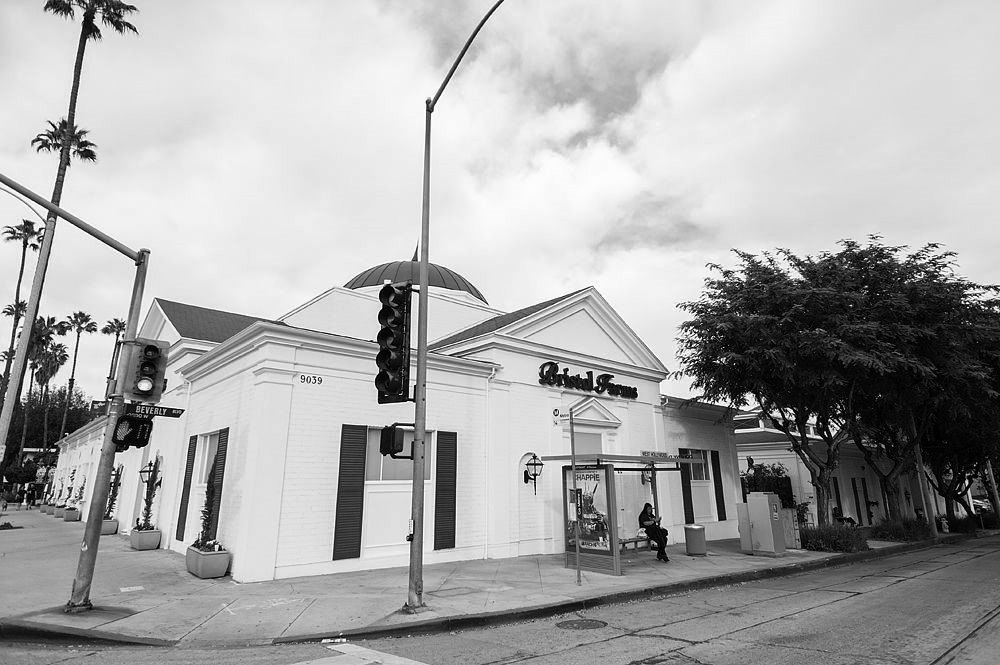 |
|
| (2015)** - View showing the Chasen’s Restaurant building, now a Bristol Farms, located on the NE corner of Beverly and Doheny. |
Historical Notes Now all that's left of the glorious edifice founded by comedian Dave Chasen is a Bristol Farms super market, though there's one last remnant located near the cafe that still contains original booths, paneling, and some vintage photographs from the iconic restaurant. There's also a plaque near the original entrance that tells of this legendary eatery, which entertained everyone from James Cagney and Clark Cable to Warren Beatty and Shirley Temple.* |
* * * * * |
Whisky A-Go-Go
.jpg) |
|
| (1965)* – Band, dance floor, and Go Go’s dancers in a suspended cage. |
Historical Notes The Sunset Strip Whisky was founded by Elmer Valentine, Phil Tanzini, Shelly Davis, and attorney Theodore Flier and opened on January 16, 1964. Though the club was billed as a discothèque, suggesting that it offered only recorded music, the Whisky a Go-Go opened with a live band led by Johnny Rivers and a short-skirted female DJ Rhonda Lane, spinning records between sets from a suspended cage at the right of the stage.^ The Doors were the nightclub's house band in the years after the Whisky made discotheque and go-go dancers a national craze. |
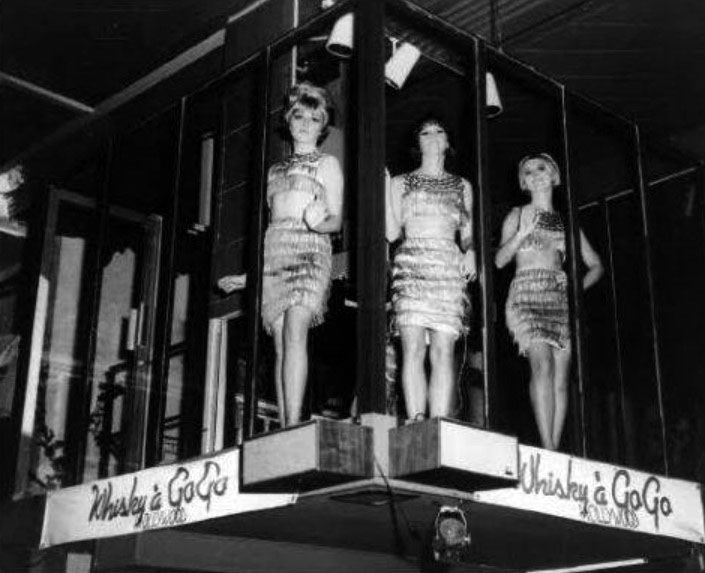 |
|
| (1964)* - Whisky a Go Go’s dancers in a suspended cage above the dance floor. |
Historical Notes The Turtles performed there when their newest (and biggest-selling) single "Happy Together" was becoming a hit, only to lose their new bassist, Chip Douglas (who had arranged the song), to the Monkees; guitarist Michael Nesmith invited him to become their producer. (He returned to the Turtles a year later, to produce them.) Neil Diamond also played at the Whisky on occasion.^ |
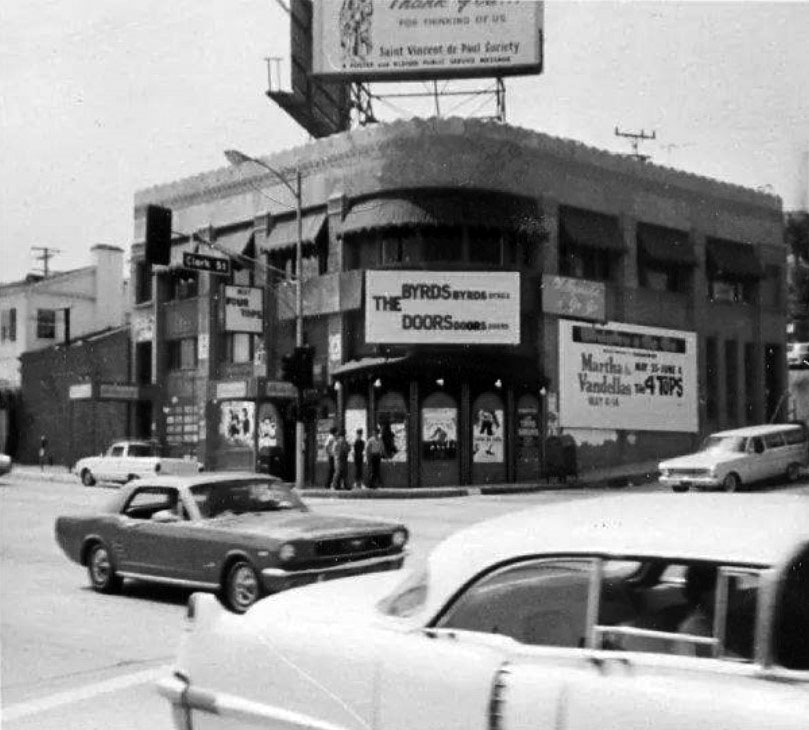 |
|
| (1967)* - View of the WHISKY A-GO-GO, located at 8901 Sunset Boulevard, on the Strip. Now playing: "The DOORS" & "The BYRDS" |
Historical Notes The Whisky played an important role in many musical careers, especially for bands based in Southern California. The Byrds, Alice Cooper, Buffalo Springfield, Smokestack Lightning and Love were regulars, and The Doors were the house band for a while—until the debut of the "Oedipal section" of "The End" got them fired. Van Morrison's band Them had a two-week residency in June 1966, with The Doors as the opening act. On the last night they all jammed together on "Gloria". Frank Zappa's Mothers of Invention got their record contract based on a performance at the Whisky.^ |
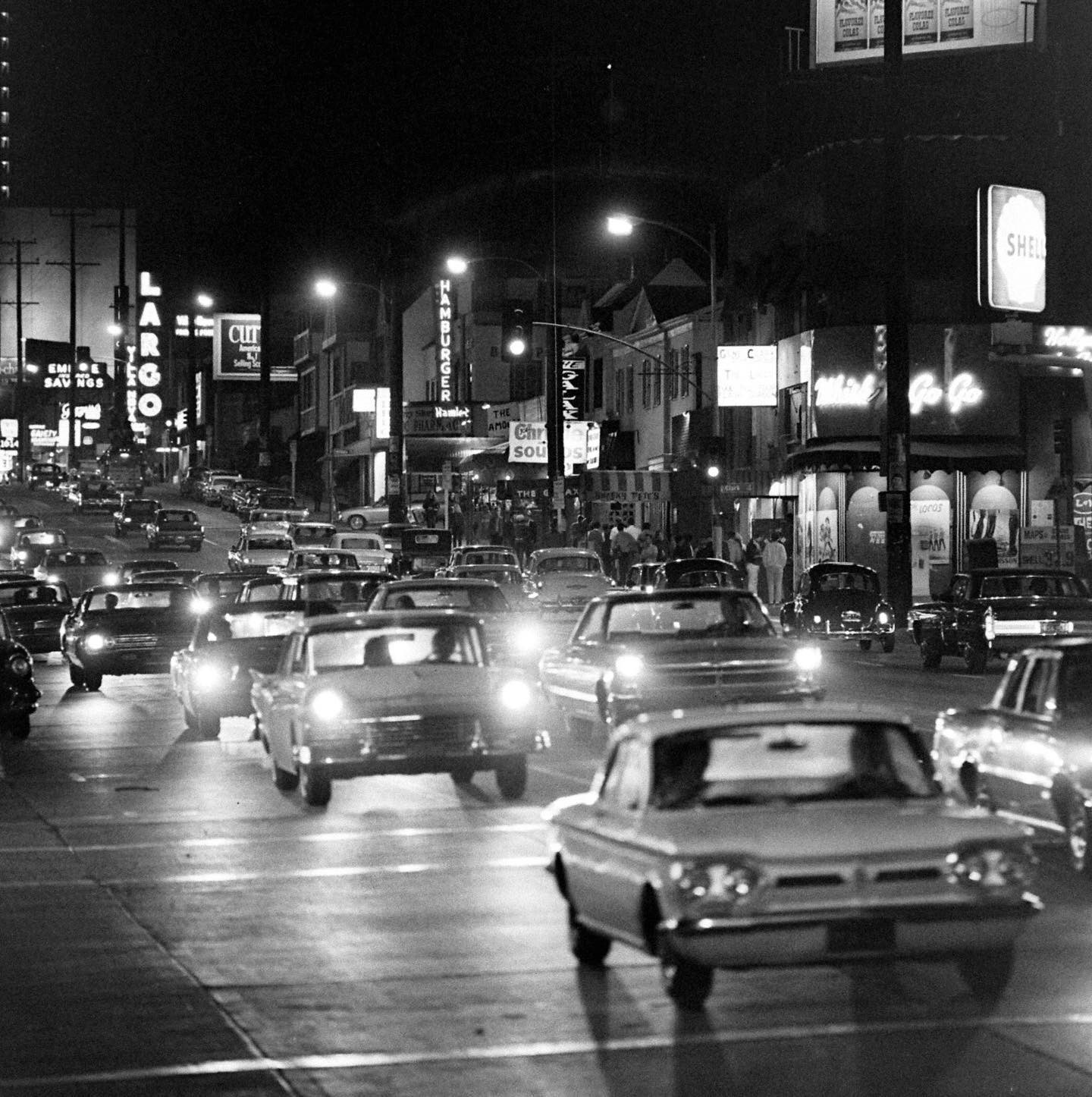 |
|
| (1966)* - Busy night on the Sunset Strip with the Whisky seen on the corner. Note the black-out “Y” on the sign. Also seen are Sneaky Pete's, The Galaxy Club, and Hamburger Hamlet. Signs for The Largo and Villa Nova are visible in the distance. Photo: Ralph Crane / LIFE Magazine |
Historical Notes The blacked-out "Y" on the sign at The Whisky was when the county revoked the club's dance permit around the time of the Sunset Strip Curfew Riots, stating that its name was a "bad influence" that promoted underage drinking. The Whisky responded by removing the "Y" from their sign and legally renaming themselves the "Whisk-A-Go-Go" and then obtaining a new permit.* |
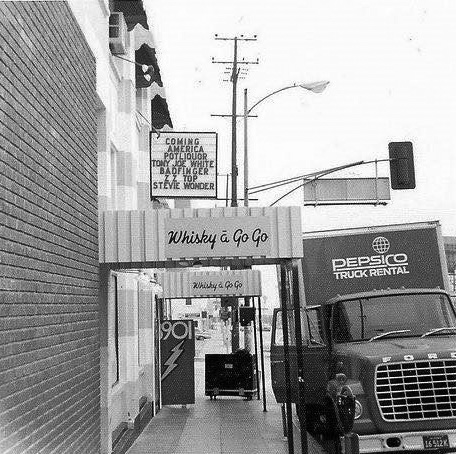 |
|
| (1972)^.^ - WHISKY A-GO-GO billboard shows “Coming Attractions” - America, Potliquor, Tony Joe White, ZZ Top, and Stevie Wonder. |
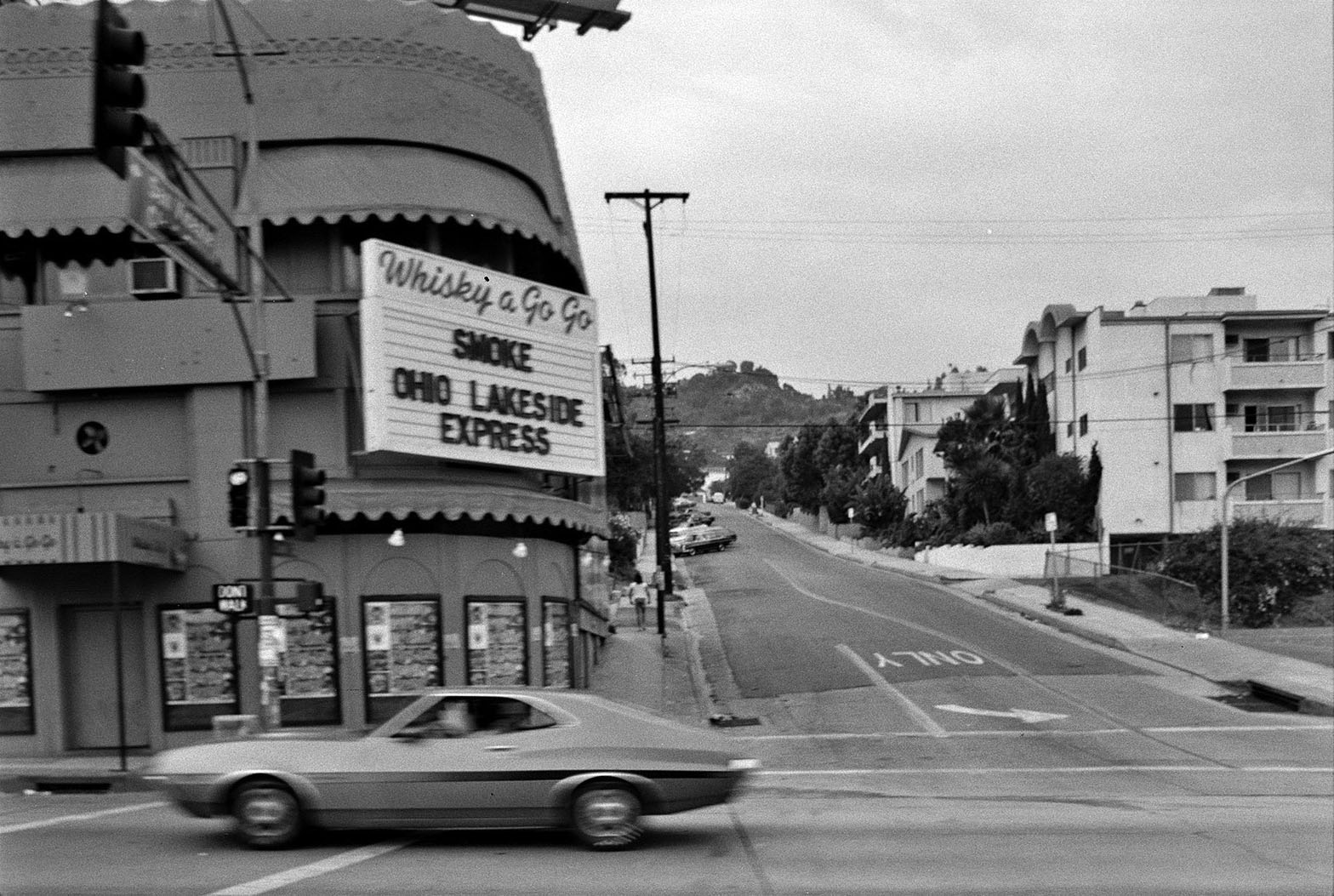 |
|
| (1974)* - Whisky A-Go-Go located on the NW corner of Sunset and Clark Street. Bands playing: Smoke and the Ohio Lakeside Express. Photo by Ed Ruscha / Getty Research Institute |
Historical Notes In the mid-1970s, the Whisky hosted stage presentations, including the long-running show The Cycle Sluts. During the early 1990s, the Whisky hosted a number of Seattle-based musicians who would be a part of the grunge movement, including Soundgarden, Mudhoney, Melvins, Fitz of Depression and 7 Year Bitch. In 1994 Oasis played a controversial set at the Whisky, with frontman Liam Gallagher visibly intoxicated. Immediately following the gig, lead songwriter Noel Gallagher temporarily left the group out of frustration, fleeing to San Francisco, where he penned the song Talk Tonight. In 1997, DownSet Headlining followed by Lambs Bread and System of a Down played at the Whisky. The band were unsigned at the time, and played songs from their early demo tapes, in particular containing the band's only live performance of the song "Blue".^ |
 |
|
| (2006)^ - Whisky A-Go-Go, 8901 W. Sunset Blvd., W. Hollywood. |
Historical Notes On September 12, 2016, the Whisky a Go Go launched an official TV channel on the Roku Connected TV platform. The Whisky a Go Go channel opens the Whisky's doors to a global audience with live music videos, full concerts and related content spanning its 52-year history.^ |
* * * * * |
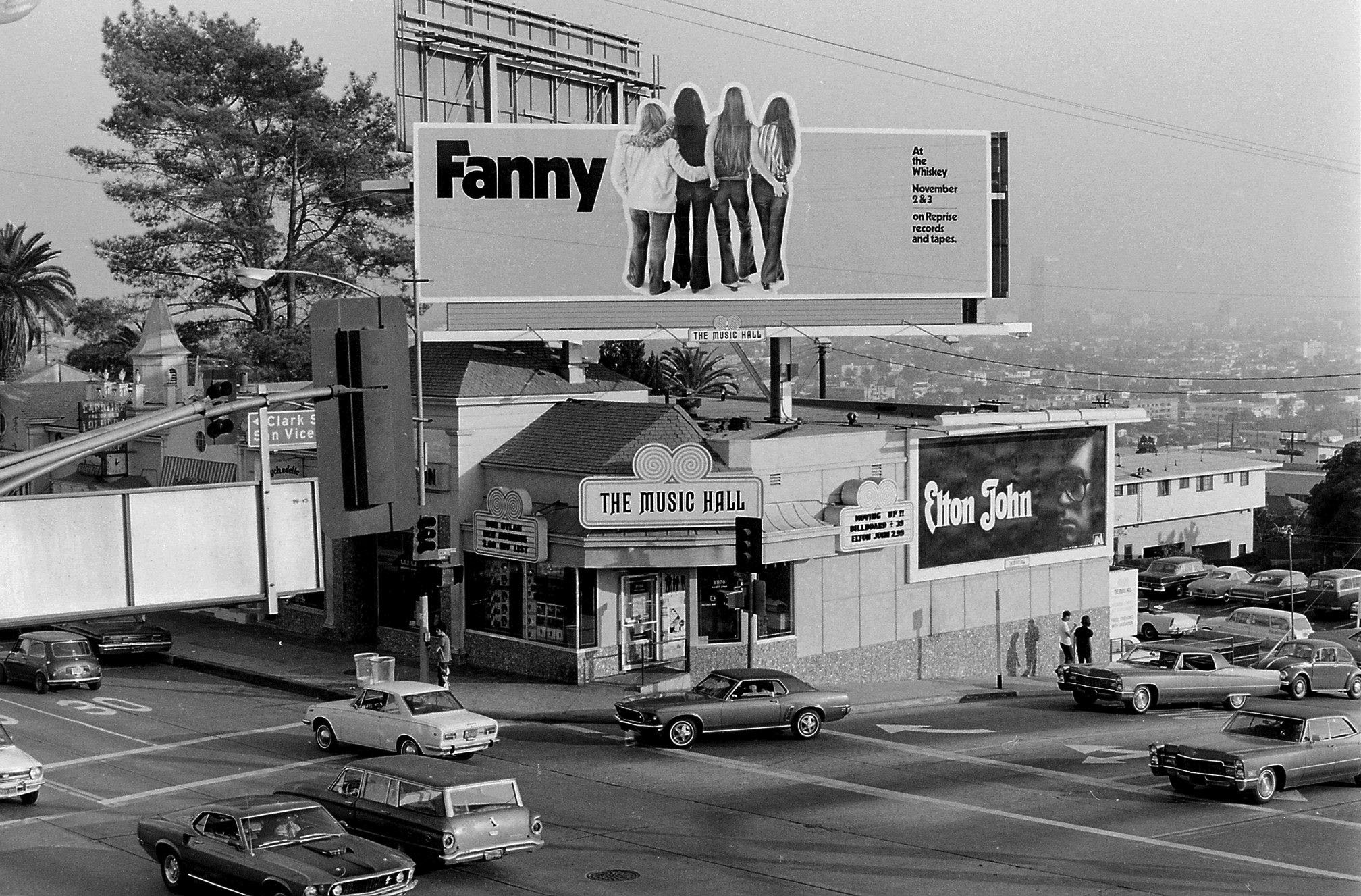 |
|
| (ca. 1970)##^* – View looking at the southeast corner of Sunset and San Vicente boulevards as seen from the 2nd floor of the Whisky A-Go-Go building. Shown here is The Music Hall (Record Store) with signboards on top and on the side of building. Click HERE to see contemporary view. |
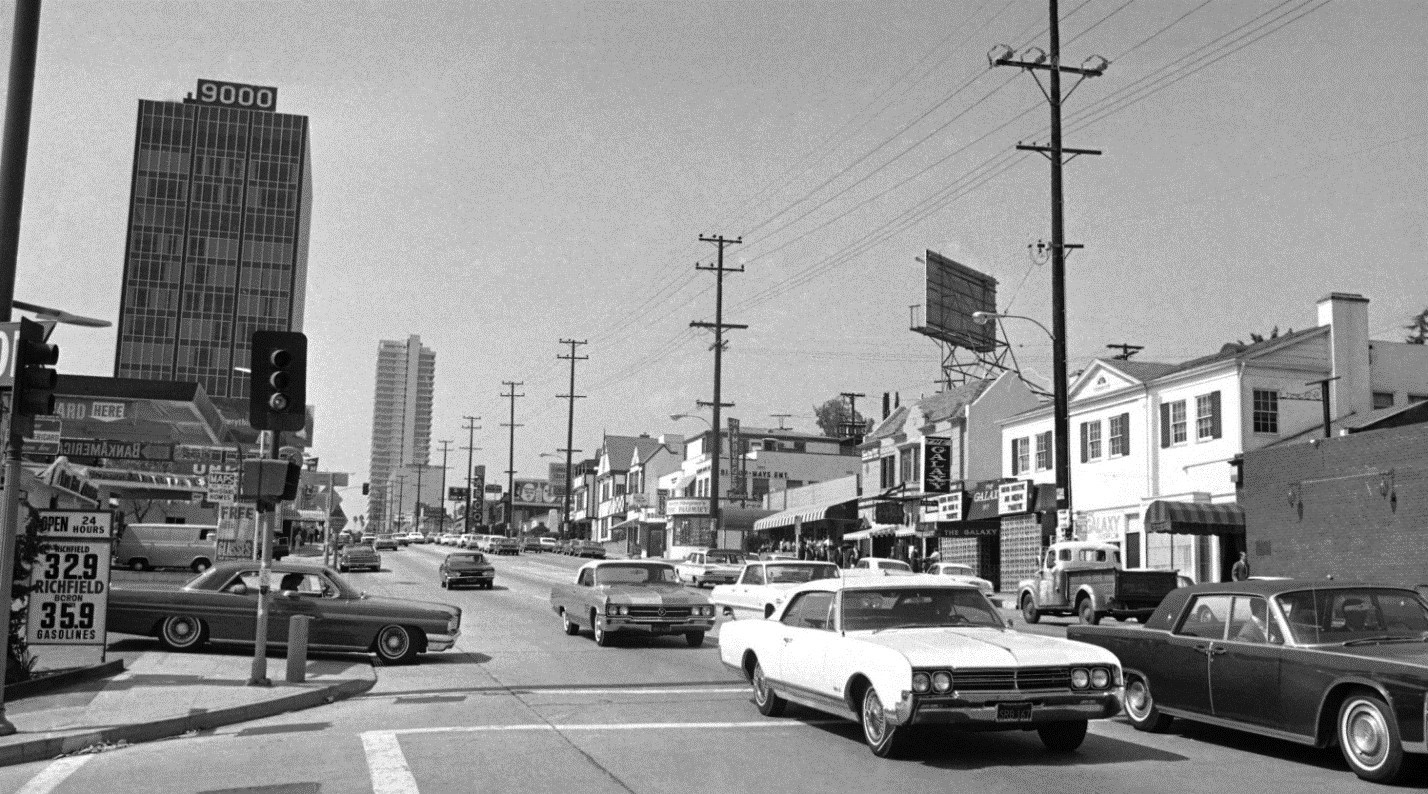 |
|
| (1960s)*# – View looking west on Sunset Boulevard at the intersection with N. San Vicente Boulevard. North of Sunset, San Vicente turns into Clark Street. On the southwest corner on the left is a Richfield Gas Station selling gas for 32.9 and 35.9 cents per gallon! |
Historical Notes After a bit of a slump in the 1950's, the Sunset Strip was revived in the 1960s with the opening of teen clubs Pandora's Box in 1962, Whisky A-Go-Go in 1964, modeled after the Chicago club of the same name, and Rose Deitch's Galaxy the same year. The Roxy Theatre and The London Fog opened in 1966. ###* This one block (seen above) was the throbbing heart of it all in the 1960s. Here, in between Clark and Hilldale, people were openly selling grass and acid. Love, on the Forever Changes album, have a song called, "Between Clark and Hilldale." |
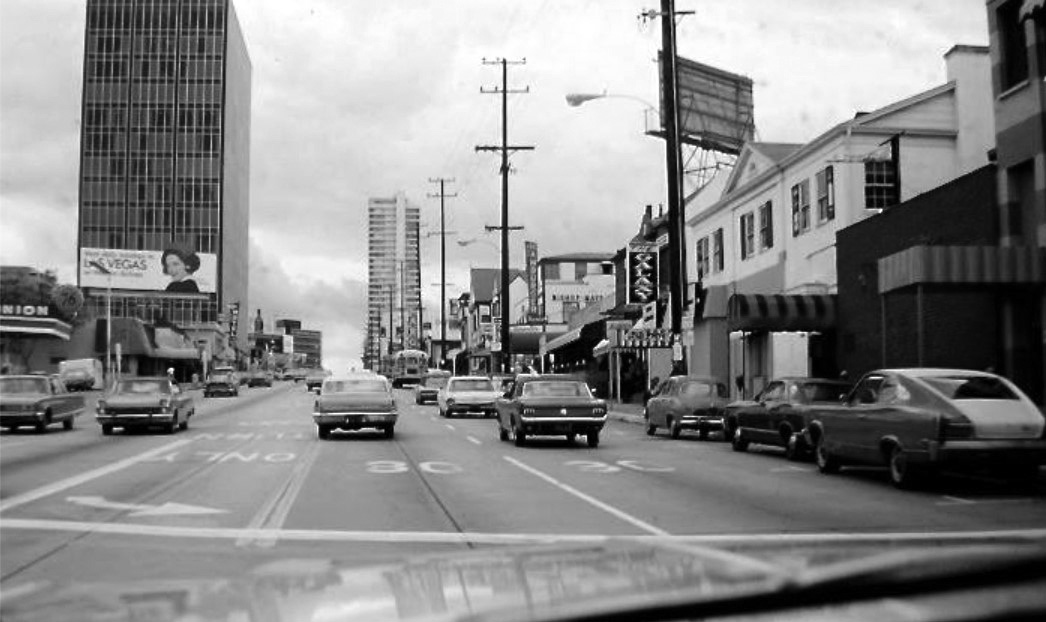 |
|
| (1968)^#^^ - View looking west on the Sunset Strip between Clark Street and Hildale Avenue. A '68 two-tone Rambler Marlin is parked directly in front of the Whisky A-Go-Go on the far right. |
Historical Notes On the far right, the building with the striped square awning is the Whisky A-Go-Go on the northwest corner of Sunset and Clark. The building with the arched awning to its left was Sneeky Pete's Night Club. The London Fog was the next building over (the Doors played there too). The next building over was the Galaxy with large sign and then on the next building, corner of Sunset and HIldale, stood the original Hamburger Hamlet. Further up the block you can see a sign for the Largo which is now The Roxy Theatre! Behind that was the Villa Nova - today The Rainbow.^#^^ By 1966, there were over a dozen music clubs on the Sunset Strip. The density of clubs on this short stretch of Sunset Boulevard resulted in late night crowds of young people that disturbed the neighbors and backed up traffic resulting in LA County Sheriffs enforcing a long-ignored 10 pm curfew for teens under 18, which had been on the books since 1939. ###* |
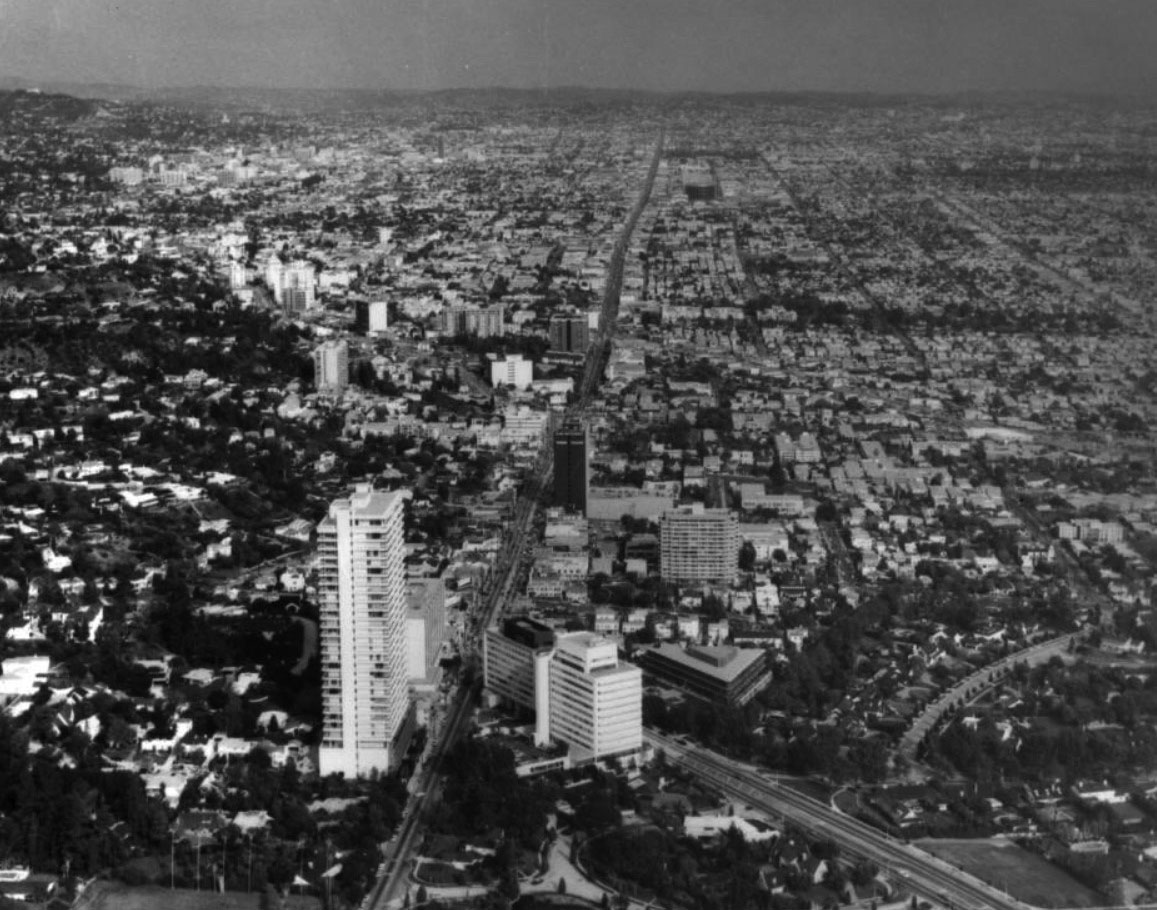 |
|
| (1968)^^ - Looking east down Sunset Boulevard (Hollyway Drive and Santa Monica Boulevard) at Doheny Road. Sunset veers to the left at center of photo. View is from above the northeast portion of West Hollywood just east of Beverly Hills. |
PJ`s Nightclub
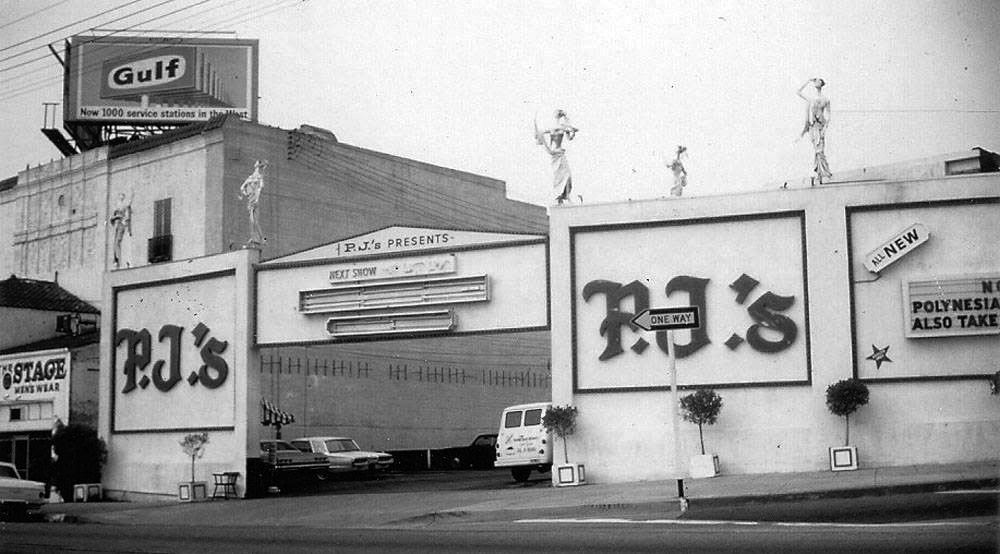 |
|
| (1960s)^ – View showing PJ’s Nightclub located on the northwest corner of Santa Monica and Crescent Heights Blvd in West Hollywood. Note the sculptures along the roofline. |
Historical Notes PJ's opened in 1961 as a late night hot spot that nightclub performers and other Hollywood celebrity types went to after the other clubs closed down. It hosted such acts as The Bobby Fuller Four, The Standells, Rufus Thomas, and Trini Lopez who recorded live albums there. The manager was Elmer Valentine before he left to found the Whisky A-Go-Go. |
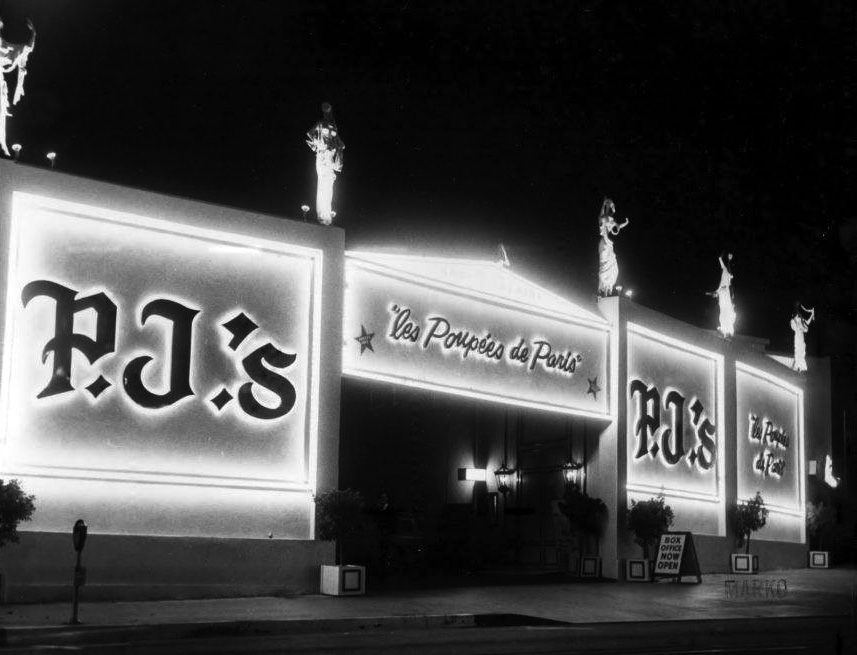 |
|
| (1960s)* – Night view showing the entrance to P.J.’s Nightclub featuring “les Pupees de Paris”. |
Historical Notes Les Poupées de Paris (The Dolls of Paris) was a musical puppet show created, produced and directed by Sid and Marty Krofft, that toured the United States throughout the 1960s. By 1966 PJ's had been bought by an organized crime figure, Eddie Nash and reputed organized crime figure Dominic Lucci, and was managed by Gary Fontenot (not an organized crime figure) for many years. In 1973, after Nash bought out Lucci's ownership interest in the club, it became The Starwood. It closed in 1981, torn down by the City, after too many citations for underage drinking and noise abatement issues. Before it was demolished it caught fire, though not burning totally. This occurred while unexplained fires befell other Nash-owned properties at the time. Subsequently the structure was torn down, and a mini-mall (Crescent Heights Plaza) was built on the site. Click HERE for contemporary view. |
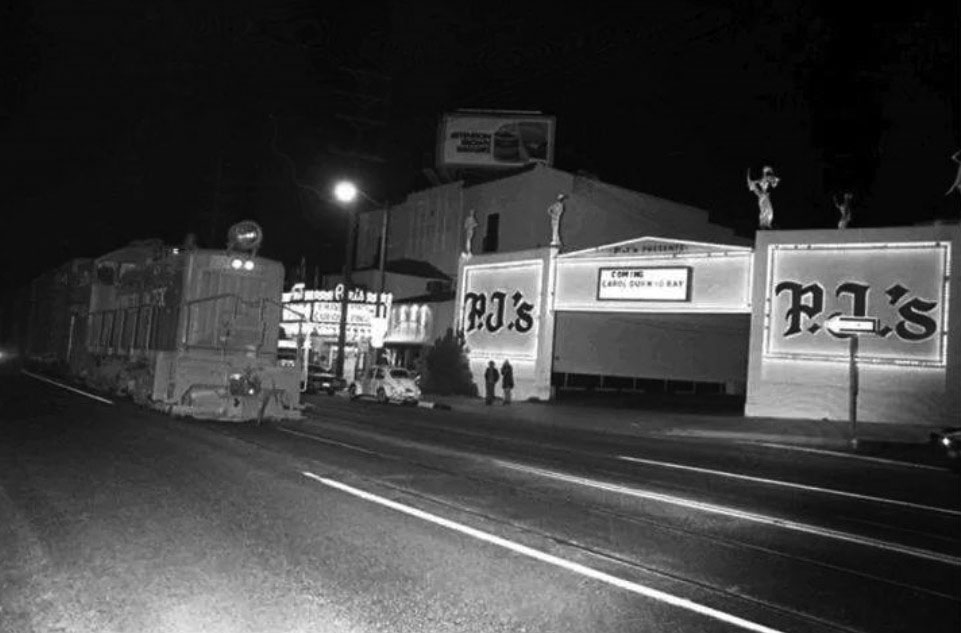 |
|
| (1968)* – View of a train passing by PJ`s Nightclub located at 8151 Santa Monica Boulevard. Southern Pacific freight trains ran down the middle of Santa Monica Blvd until the mid 70`s. |
Historical Notes The tracks running down the center of Santa Monica Boulevard were part of the Pacific Electric Railway since 1911 and carried red cars until the 1950s. They then remained largely unused for decades, serving the occasional Southern Pacific freight train through the 1970s. It was not until 1999 that the West Hollywood segment of the tracks were dug up and replaced by a landscaped median. |
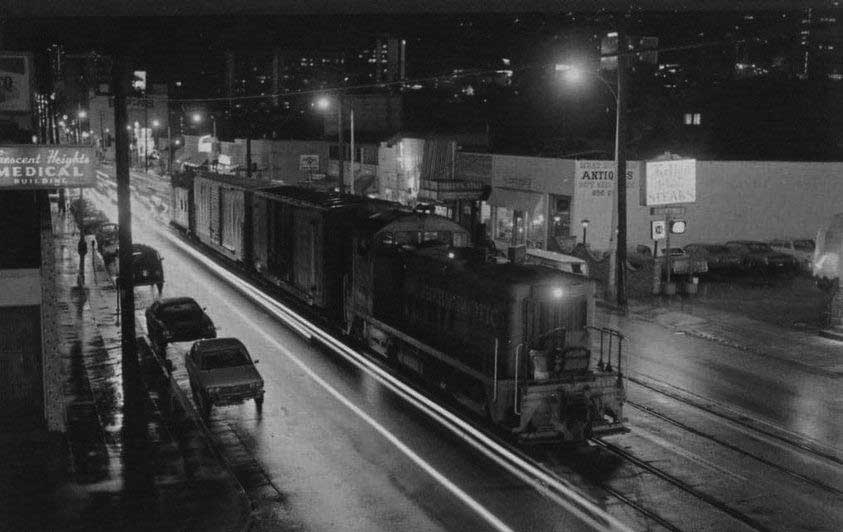 |
|
| (1972)^ - A freight train heads east through West Hollywood on the old Route 66 (Santa Monica Blvd). Crescent Heights Medical Building is seen on the left. Photo by Gary G. Allen. |
Historical Notes This was the last regular midnight run of a freight train down Route 66 (Santa Monica Blvd., West Hollywood), in May, 1972. |
* * * * * |
Pandora's Box
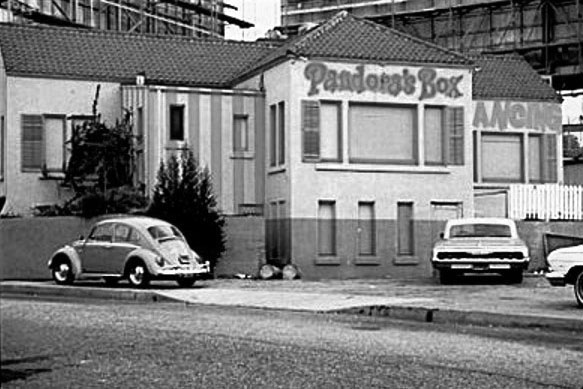 |
|
| (1960s)* – View showing Pandora’s Box Nightclub, located at the corner of Sunset Boulevard and Crescent Heights Boulevard. It was at the center of the Sunset Strip curfew riots in the mid-1960s. |
Historical Notes In the late 1950s Pandora's Box was a popular coffeehouse located at 8118 Sunset Boulevard, on the corner of Sunset Boulevard and Crescent Heights Boulevard. Home to some of the more adventurous artists in town, Pandora's Box hosted up-and-coming jazz musicians such as Les McCann and Carla Bley, while artist Burt Shonberg adorned the interior of the club with a mural similar to his works in the famous Cafe Frankenstein and The Purple Onion. |
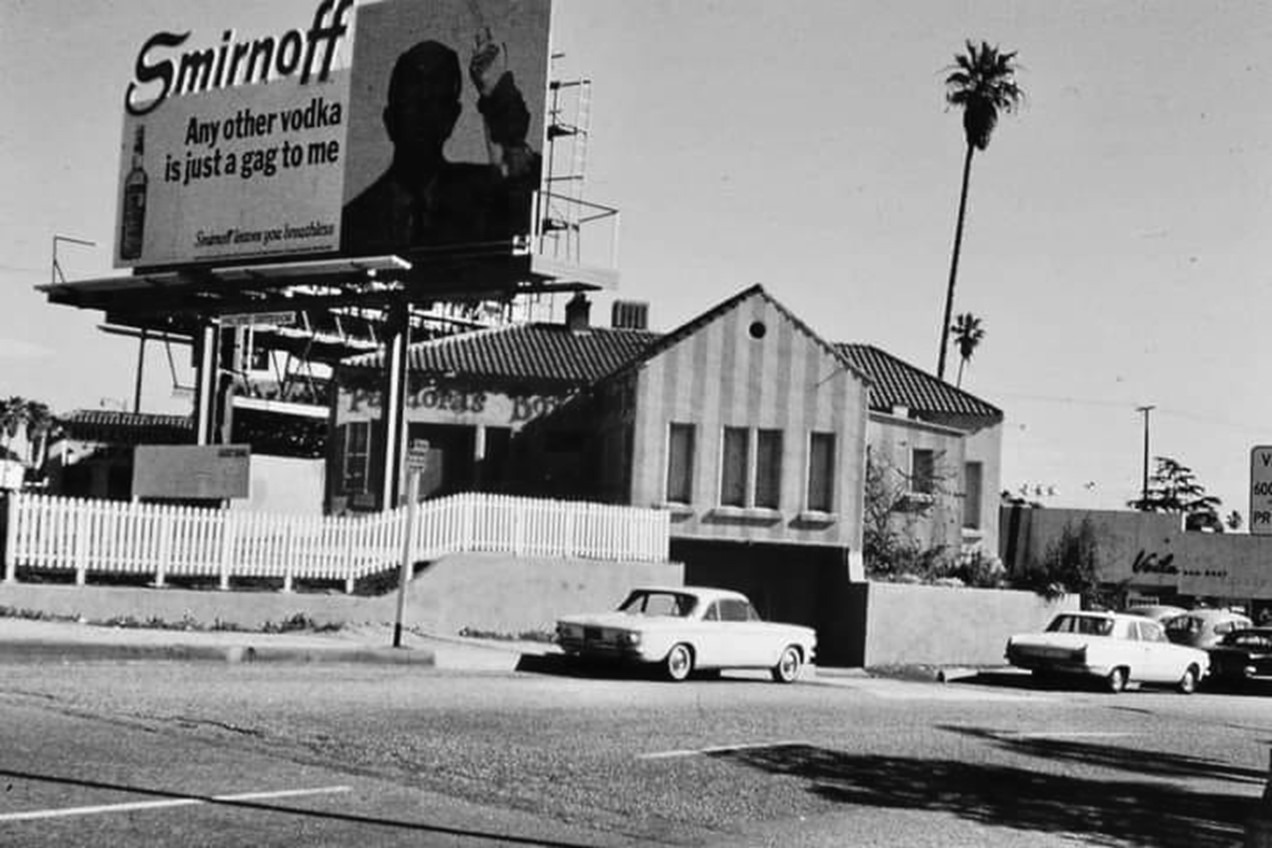 |
|
| (1967)* - Pandora’s Box, 8118 Sunset Blvd, West Hollywood. |
Historical Notes In 1966, annoyed residents and business owners in the district had encouraged the passage of a strict 10:00 pm curfew and loitering law to reduce the traffic congestion resulting from crowds of young club patrons. This was perceived by young, local rock music fans as an infringement on their civil rights, and on Saturday, November 12, 1966, fliers were distributed along the Strip inviting people to demonstrate later that day. Hours before the protest, one of L.A's rock 'n' roll radio stations announced there would be a rally at Pandora's Box. The Los Angeles Times reported that as many as 1,000 youthful demonstrators, including such celebrities as Frank Zappa, Sonny and Cher, Jack Nicholson and Peter Fonda (who was afterward handcuffed by police), erupted in protest against the perceived repressive enforcement of these recently invoked curfew laws. |
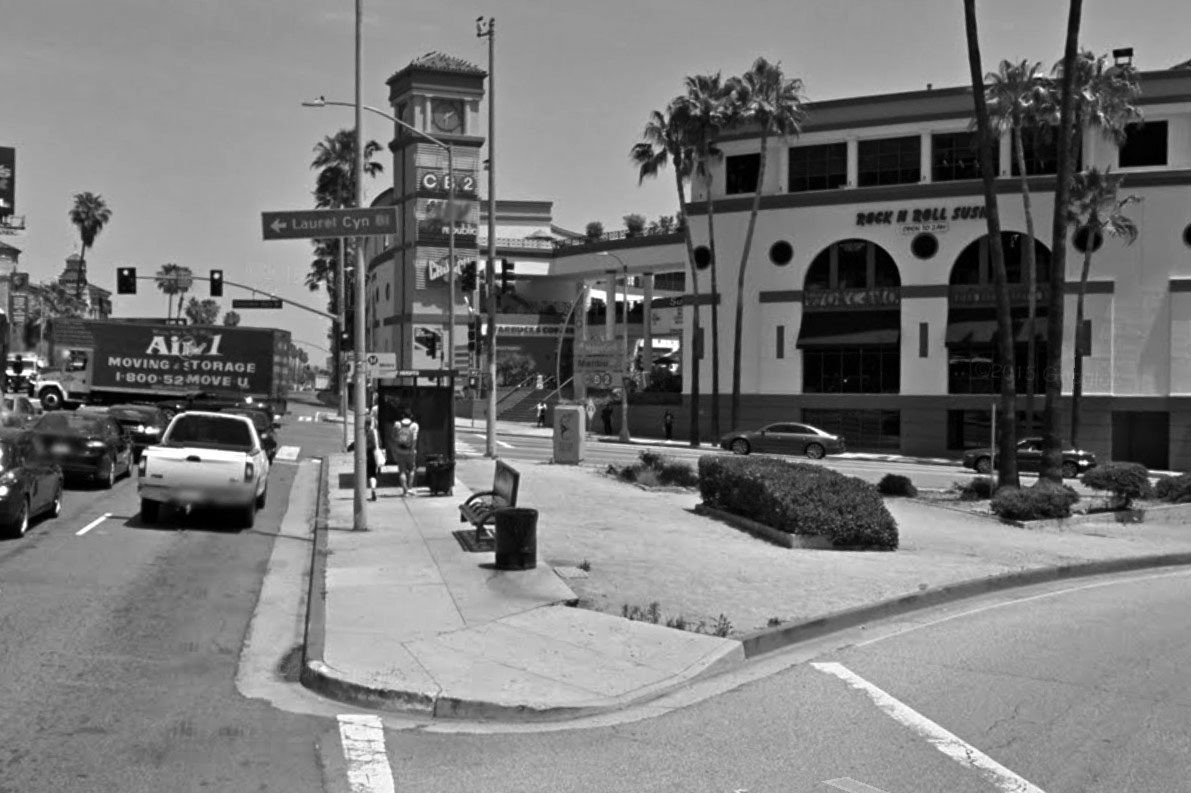 |
|
| (2016)* – Google street view showing the spot where Pandora’s Box once stood. Today, it is a traffic island. |
Historical Notes In November 1966, the Los Angeles City Council voted to acquire and demolish the club. The club was demolished in early August 1967 and today, the site exists as a traffic island. The 1967 film Riot on Sunset Strip is a fictionalized depiction of the events. Buffalo Springfield's 1967 hit single, "For What It's Worth (Stop, Hey, What's That Sound)," was written by group member Stephen Stills in response to the riot. |
* * * * * |
Canyon Country Store
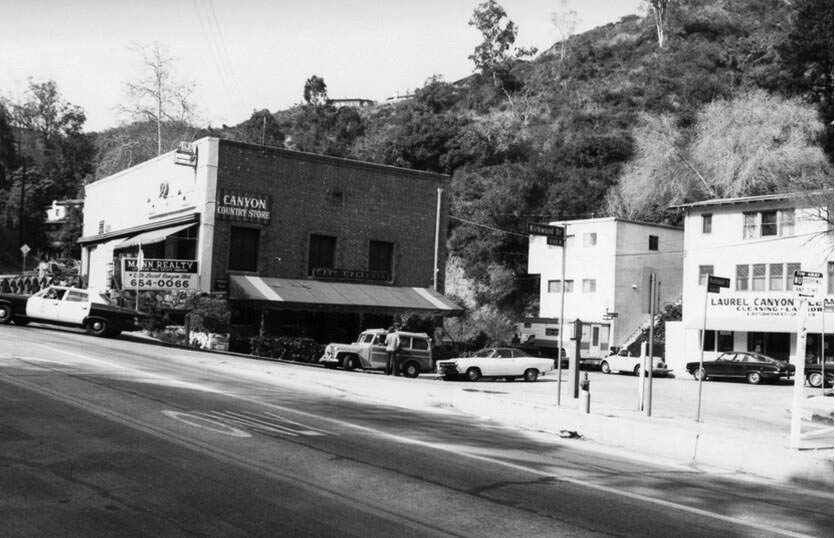 |
|
| (1968)* - View looking north on Laurel Canyon Blvd at Kirkwood Drive showing the Canyon Country Store on the northeast corner. |
Historical Notes The Canyon Country Store has been the makeshift cultural center of Laurel Canyon for a full century. Immortalized in the Doors song "Love Street," this deli-market is not a venue, but it's got historical music importance to spare, and continues to be -- as Jim Morrison put it -- the "store where the creatures meet." Known for its winding narrow streets and terrifying mudslides, Laurel Canyon became a part of the city of Los Angeles in 1923. Its close proximity to Hollywood and ample unused hillside attracted the film industry's elite "photoplayers" including Clara Bow, Errol Flynn and Harry Houdini. |
.jpg) |
|
| (2015)* - View looking north on Laurel Canyon Blvd at Kirkwood Drive showing the Canyon Country Store on the northeast corner. Same view as above but 47 years later. |
Historical Notes Throughout the '60s and '70s, the Laurel Canyon Country Store acted as a meeting place for musicians to write songs together and jam on the market's front patio. Joni Mitchell wrote Ladies of the Canyon and Nash wrote CSNY's "Our House" about the neighborhood. |
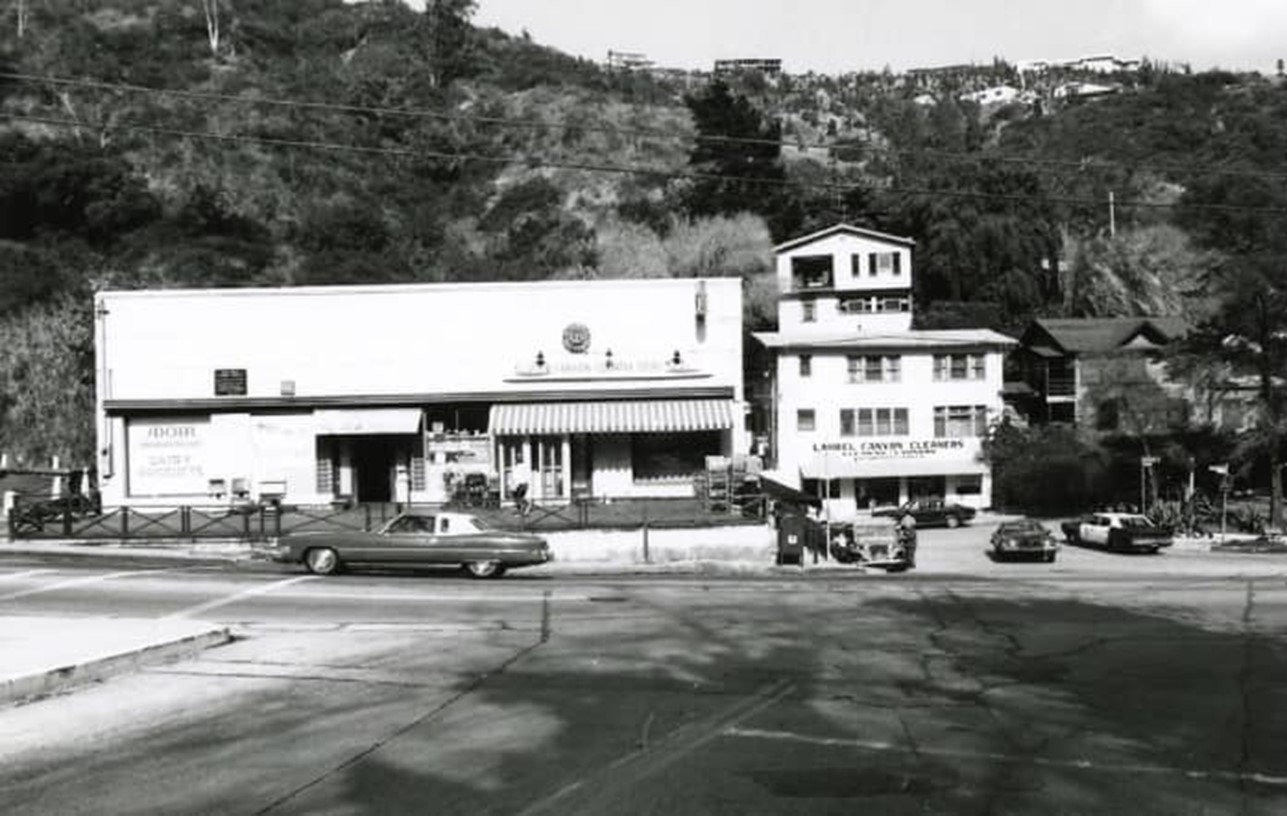 |
|
| (1974)* – Looking east on Kirwood Drive toward Laurel Canyon showing the Canyon Country Store. |
Historical Notes On what was the main connecting road between the San Fernando Valley and Hollywood, the artists hung out in the open. Mama Cass Elliot of the Mamas and the Papas lived in the shop's basement (now a fancy wine cellar) for a spell, where she penned "Twelve Thirty," better known by its chorus "Young girls are coming to the Canyon." |
Then and Now
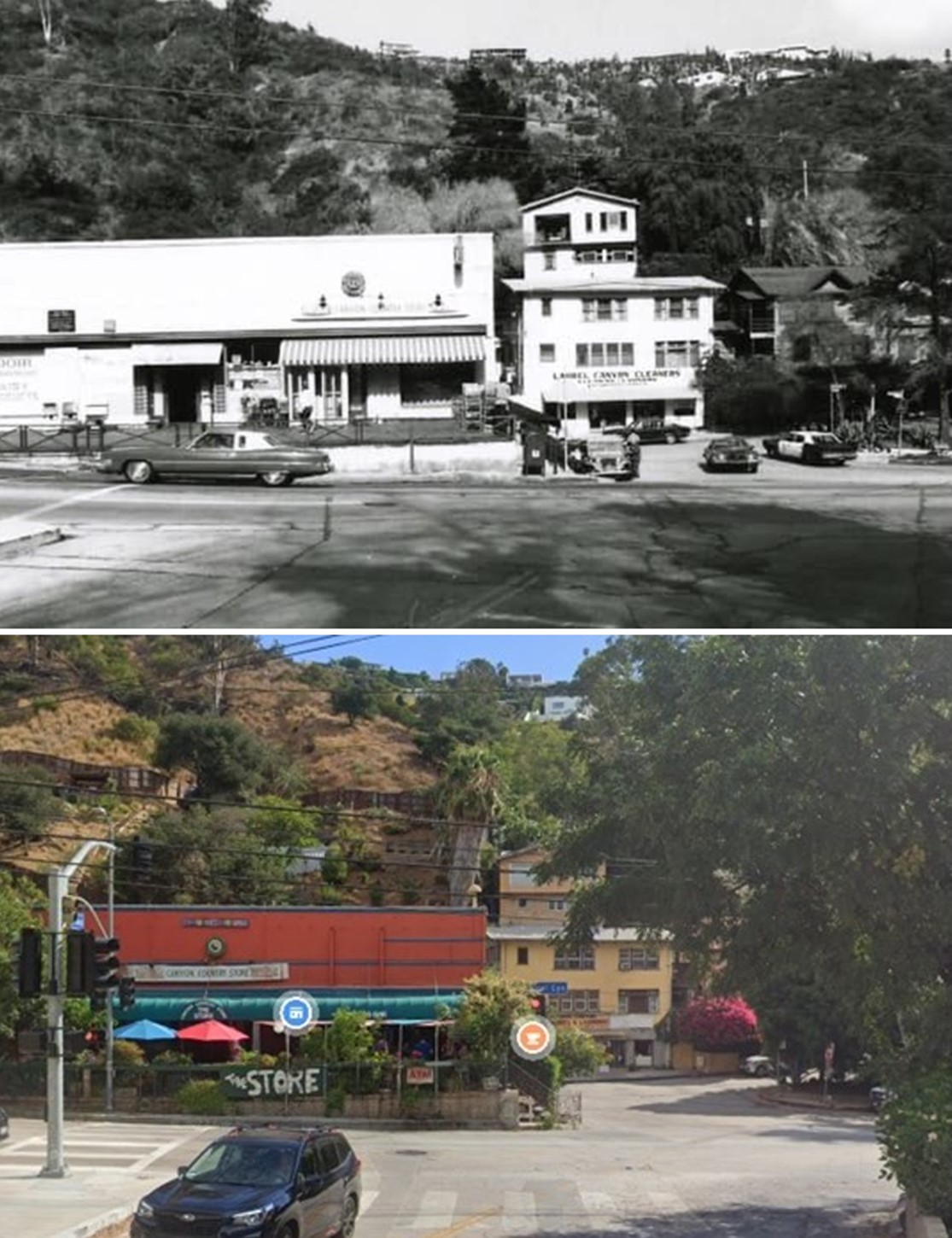 |
|
| (1974 vs. 2022)* – Looking east on Kirkwood Drive toward Laurel Canyon showing the Canyon Country Store. |
Historical Notes The Canyon Country Store, located at 2108 Laurel Canyon Boulevard in Los Angeles, is a historic landmark with deep ties to the area's music scene. Originally built in 1919 and rebuilt in 1930, the store became a key gathering spot during the 1960s and 70s, attracting legendary artists like The Doors, The Byrds, Crosby, Stills & Nash, and Joni Mitchell. Jim Morrison referred to it as "the store where the creatures meet" in The Doors' song "Love Street," and Mama Cass briefly lived in its basement. Today, the store operates as a grocery, deli, and coffee shop, while also showcasing photos of its famous patrons. It hosts an annual "Love Street Festival," celebrating Laurel Canyon’s musical legacy. |
Then and Now
 |
|
| (1970s vs 2020s)* – Looking NW on Laurel Canyon at Kirkood Drive showing the Canyon Country Store. Photo comparison by Trey Callaway. |
* * * * * |
Yellow Submarine
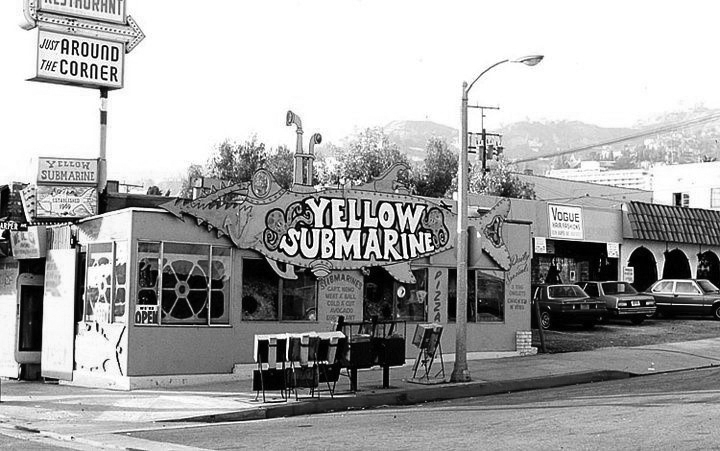 |
|
| (1979)* – View showing the Yellow Submarine located on the northwest corner of Santa Monica Boulevard and N. Harper Avenue in West Hollywood. |
Historical Notes The Yellow Submarine was a favorite hangout for Fairfax High School kids in the 1970s. Also known for its Avacado sandwiches. |
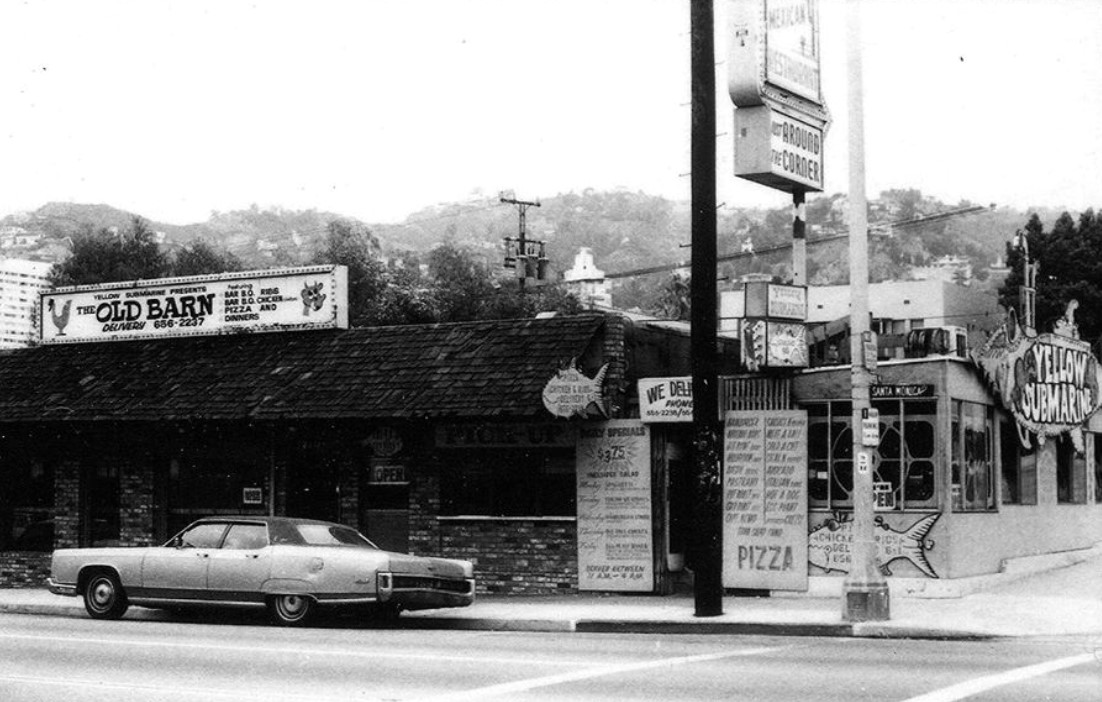 |
|
| (1982)* - View looking at the northwest corner of Santa Monica Boulevard and N. Harper Avenue showing the Yellow Submarine with the Old Barn to its left. The corner is now occupied by a Mexican restaurant. Click HERE for contemporary view. |
* * * * * |
Santa Monica and Fairfax
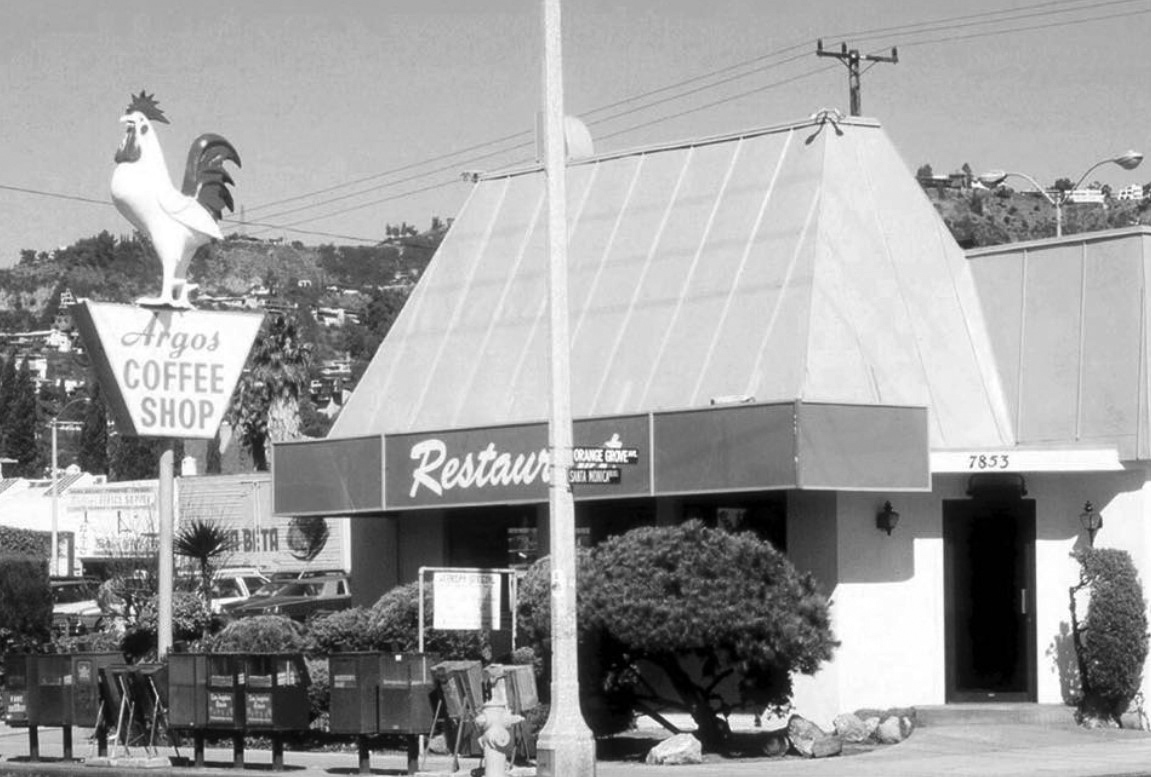 |
|
| (ca. 1970)* - View looking at the northwest corner of Santa Monica Boulevard and Orange Grove Avenue showing the Argos Coffee Shop. To the left is a shopping center located on the NE corner of Santa Monica and Fairfax where Alpha Beta can be seen. |
Historical Notes 'Alpha Beta' 1970s & 80s, became 'Boys' and then 'Ralphs' 1990s, turning-into 'Whole Foods' this millennium... |
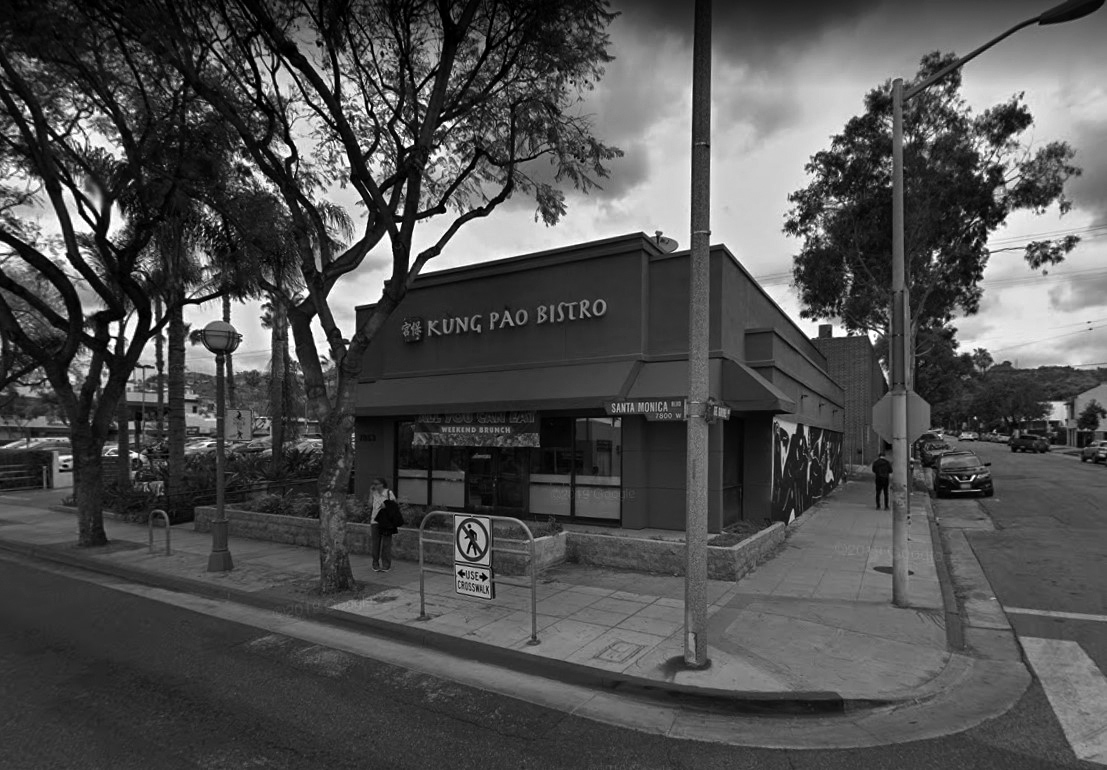 |
|
| (2019)* - Contemporary view of the NW corner of Santa Monica and Orange Grove showing Kung Pao Bistro standing where Argos Coffee Shop used to be, more than likely in the same building after modifications. Whole Foods stands in the shopping center just behind the restaurant (out of view). |
* * * * * |
Formosa Café
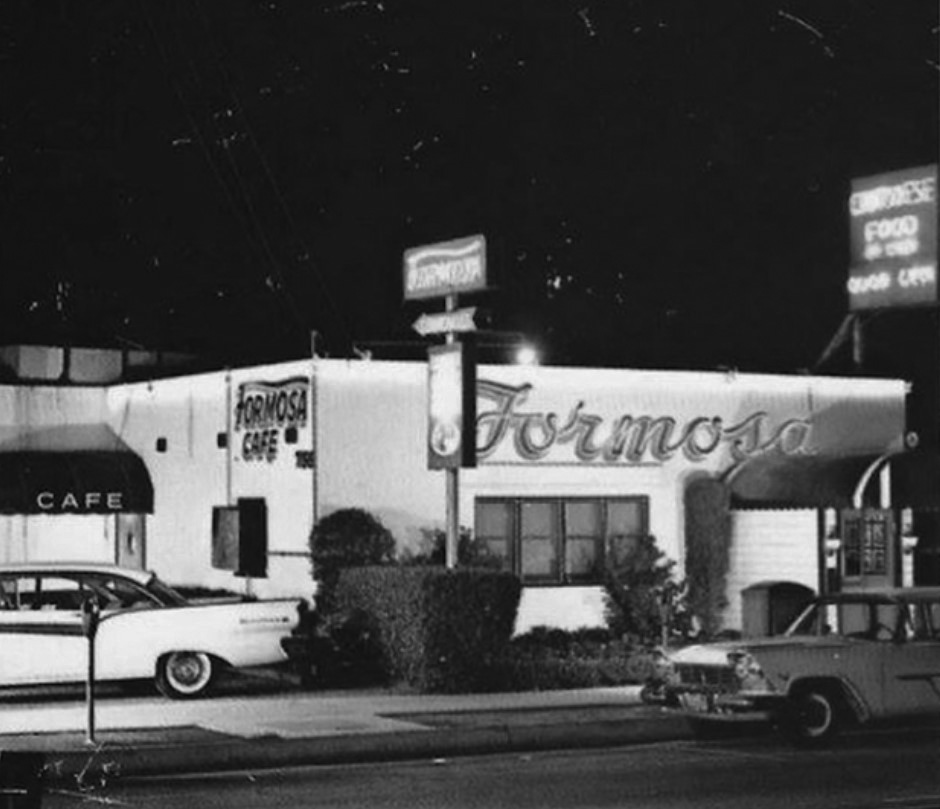 |
|
| (1950s)* - View showing the Formosa Café located at 7156 Santa Monica Boulevard in West Hollywood. |
Historical Notes Designated a local cultural resource by the City of West Hollywood, the Formosa had the good fortune of being located just steps from the Pickford-Fairbanks Studios, which was founded in 1919 and was later known as United Artists Studio, Samuel Goldwyn Studio, Warner Hollywood Studios, and currently The Lot since 1999. |
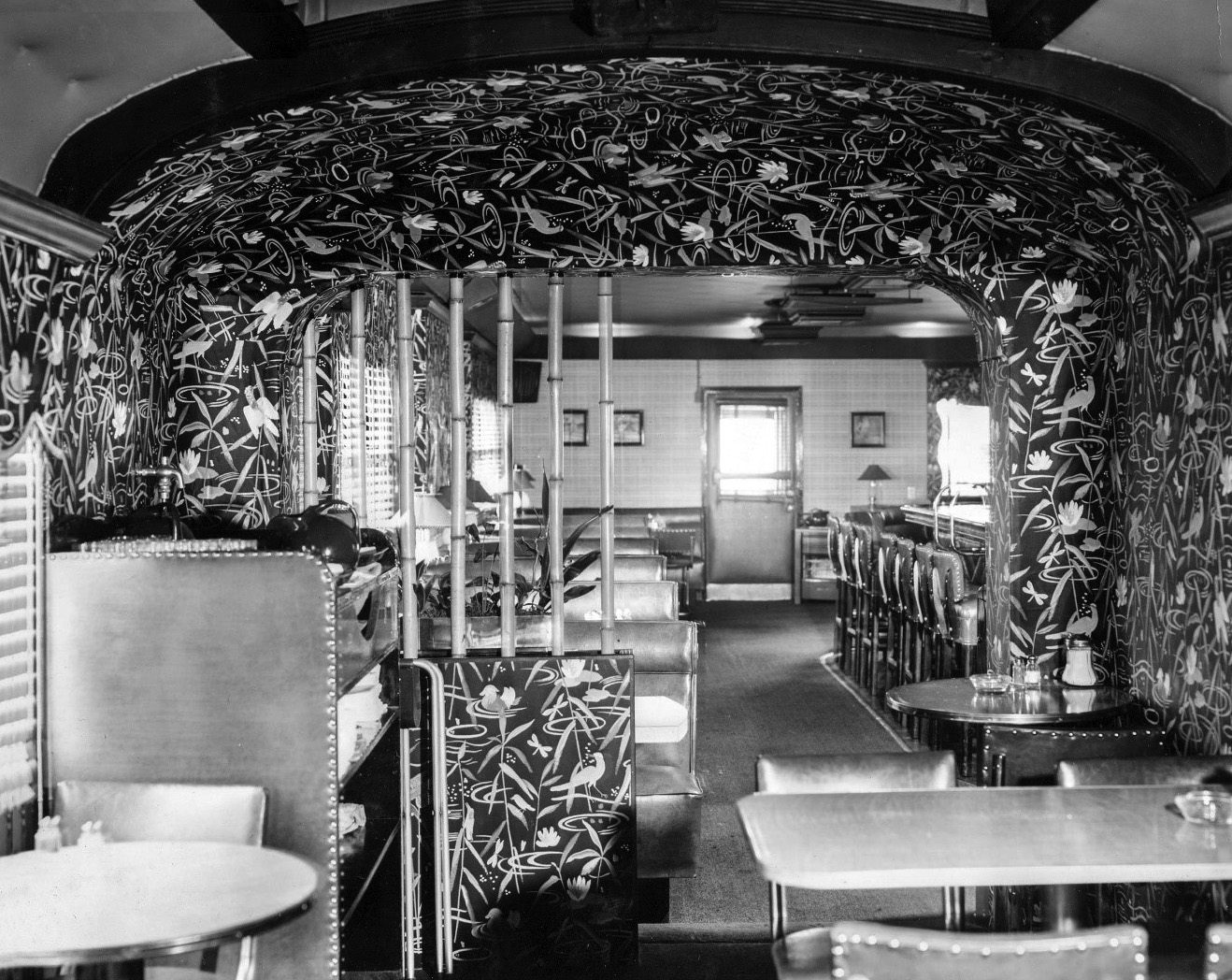 |
|
| (1933)^ – View showing the interior of the Formosa Café located at the SE corner of Santa Monica Blvd and Formosa Ave. Photo courtesy of the 1933 Group |
Historical Notes The Formosa was founded in 1925 by 1920s prize-fighter Jimmy Bernstein. Bernstein operated his establishment initially in a Red Car trolley located just east of The Lot Studios. In 1945, Lem Quon went into partnership with Bernstein, taking full ownership in 1976 when Berstein died. The restaurant remains in the family with Quom's grandson, Vince Jung, managing it.^ |
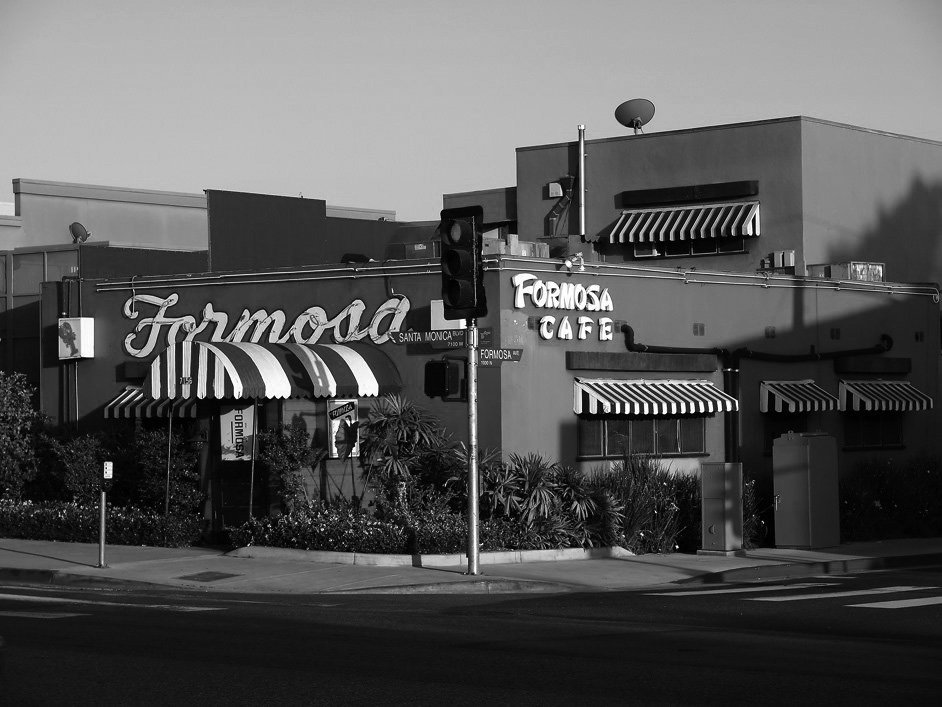 |
|
| (2007)*^ - Dusk view looking at the SE corner of Formosa Ave and Santa Monica Blvd, showing the Formosa Café. Photo by Gary Minnaert / Wikipedia |
Historical Notes Icons like Frank Sinatra, Marilyn Monroe, Humphrey Bogart, James Dean, and Elvis Presley would pop into the Formosa, adding to its reputation as one of Hollywood's most infamous and longest-running celebrity hangouts. |
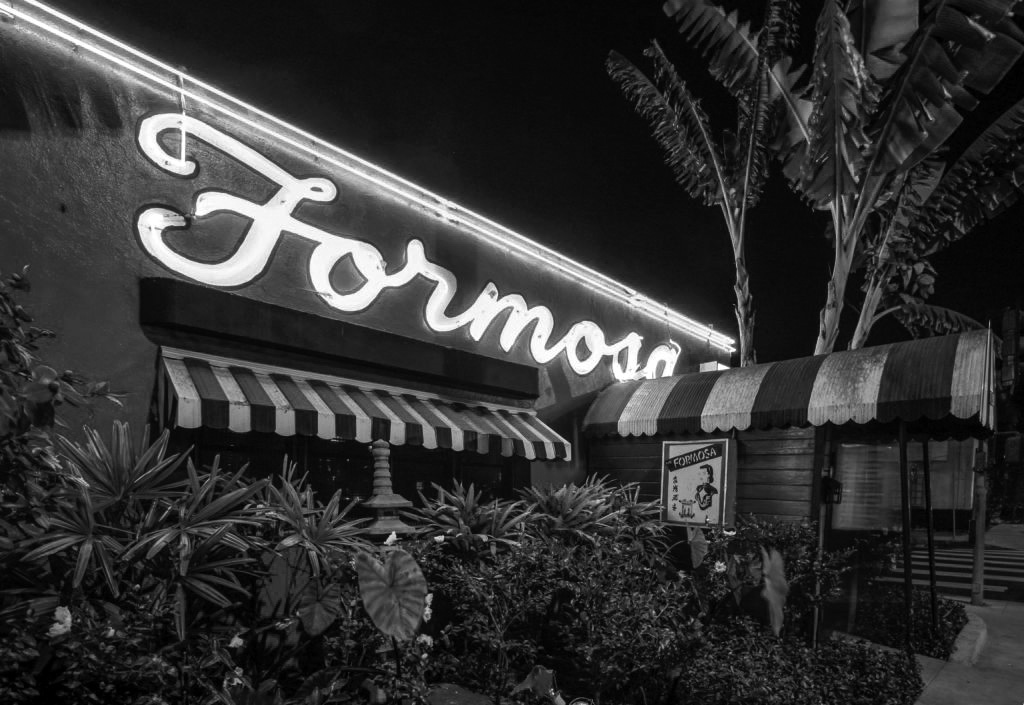 |
|
| (2010s)* – Night view showing the Formosa Café neon lights on face of building. Photo courtesy of the 1933 Group |
Historical Notes During the filming of Some Like it Hot, Marilyn Monroe frequented the legendary haunt and her photo still graces the restaurant's walls. In 2015, the restaurant's original red-and-black 1940s interiors were gutted and a "modern" interior was installed, despite clientele who enjoyed the nostalgic ambience. After negative reactions to the change, much of the original interior was rebuilt. Less than 18 months after the gutting, just before Christmas of 2016, the Formosa Cafe closed without advance notice.^ |
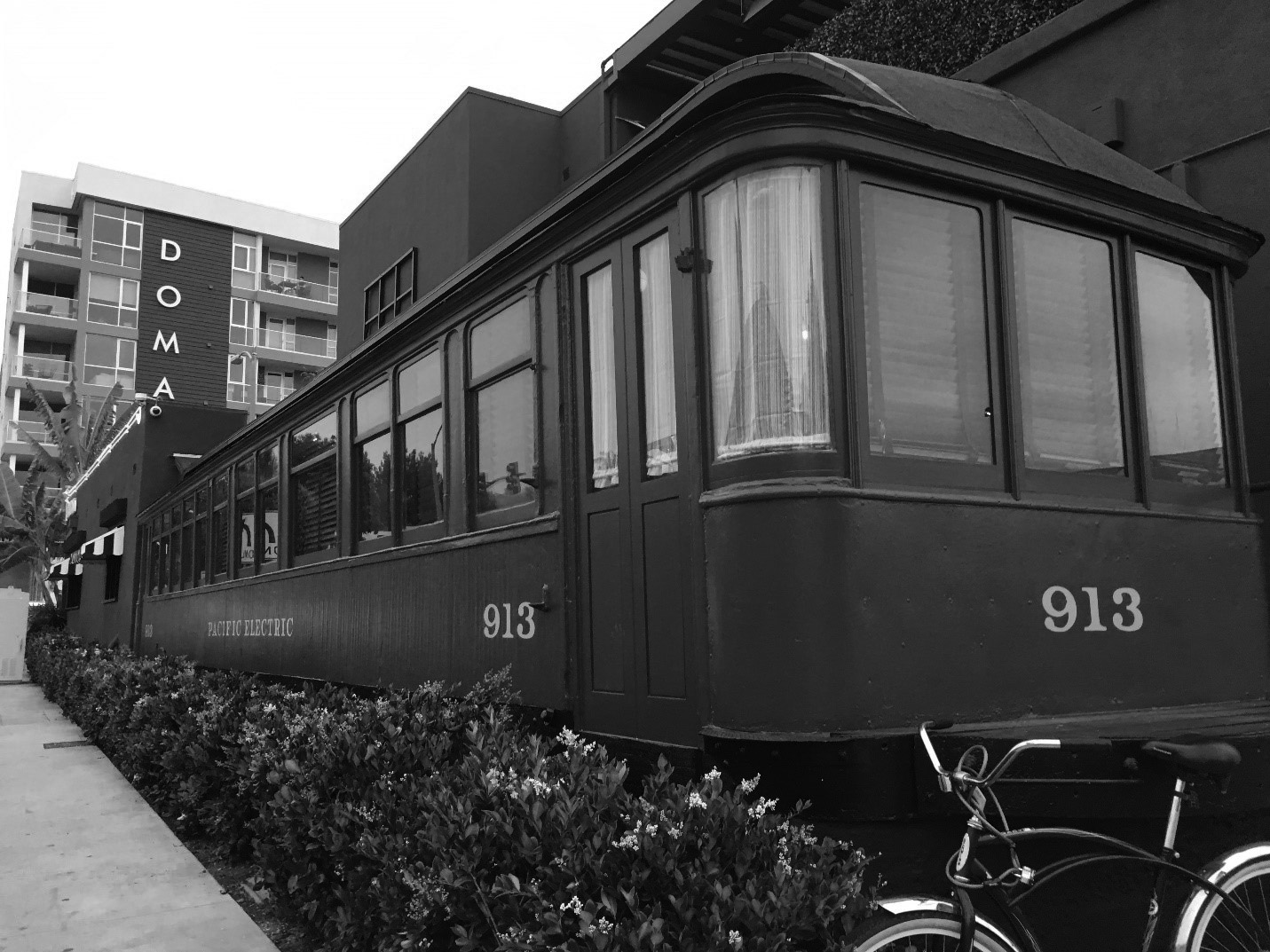 |
|
| (2019)* – View looking north on Formosa Ave showing a vintage streetcar as part of the Formasa Café with the Domain WeHo Apartments seen in the background (NE corner of Santa Monica and Formosa). Note the bicycle in the lower-right. |
Historical Notes Located just beyond the main bar, the fully revealed and restored Pacific Electric Red Car trolley dates to 1904 and is confirmed to be the oldest surviving Red Car in existence. Like the main bar, the 36-seat trolley is lined with celebrity photos installed above two- and four-seat banquettes. |
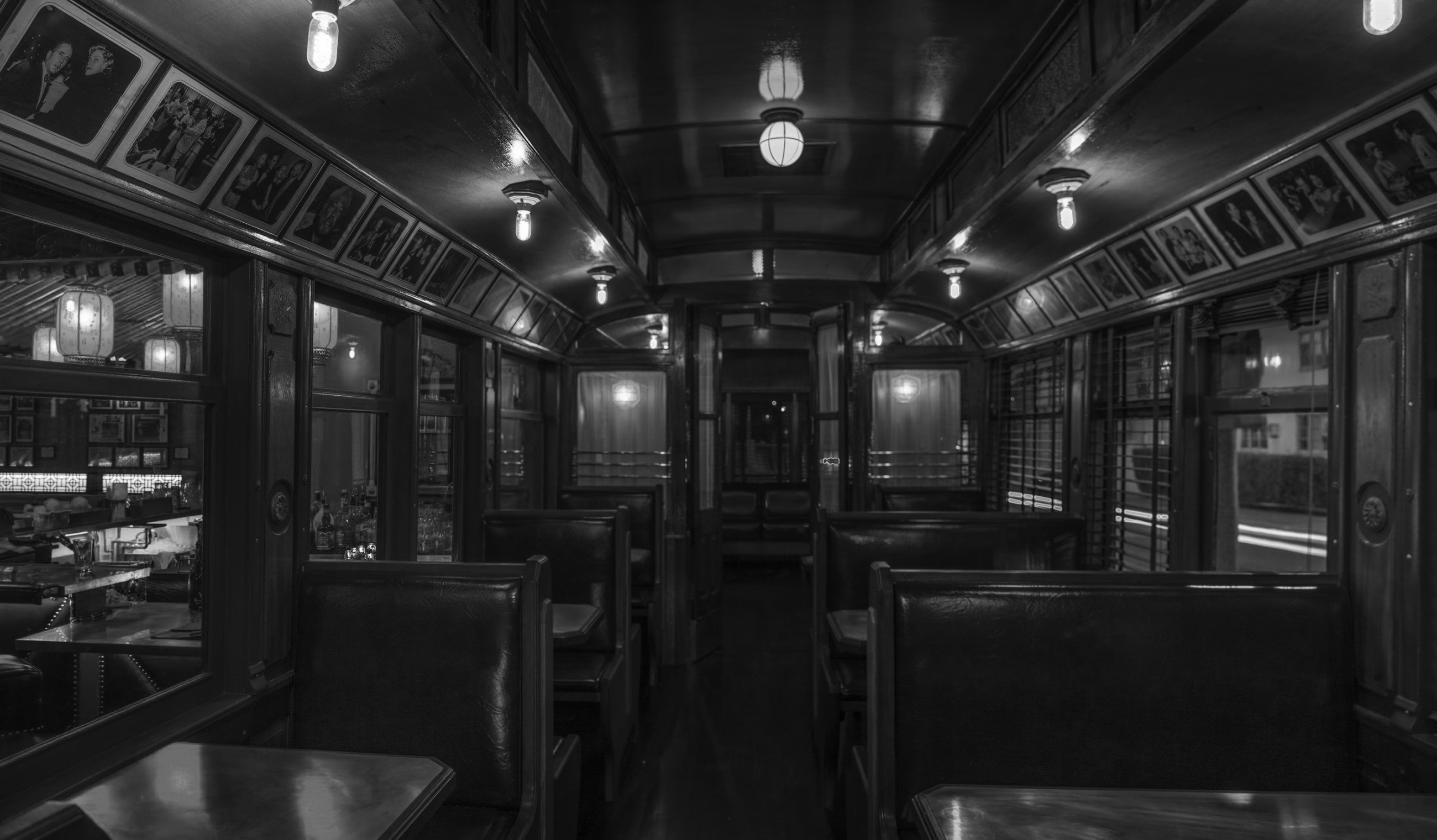 |
|
| (2019)^ - Interior of the Pacific Electric Red Car trolley at the Formosa Cafe | Photo by Maxim Shapovalov |
Historical Notes A discreet VIP room at the rear of the Red Car can host an additional 20 guests. Mickey Cohen reportedly ran his operations and called bookies from this back room, which has its own entrance. As an homage, Green installed a vintage rotary phone for guests to call in drink orders, which are served through a private window. |
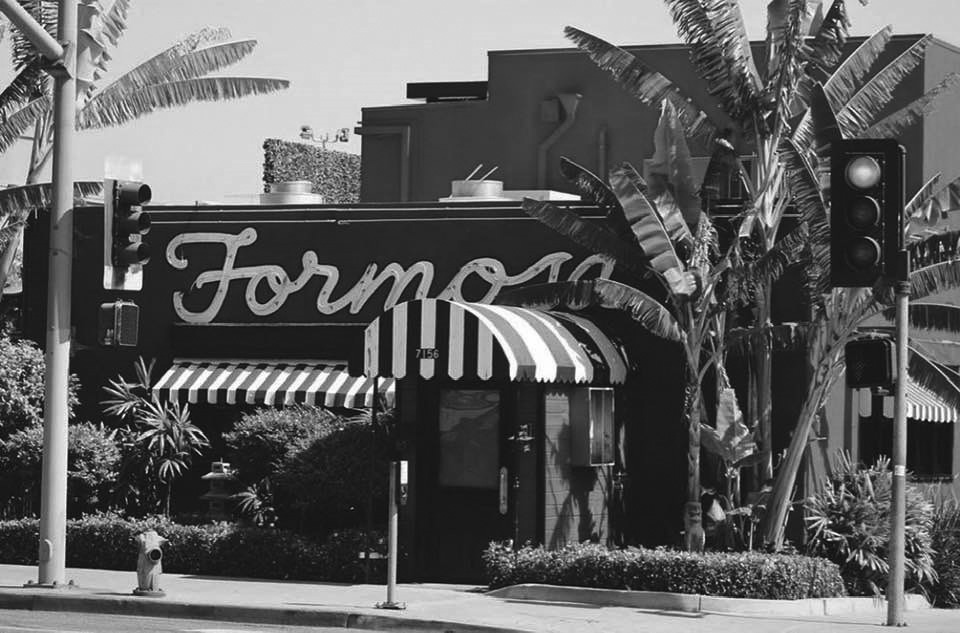 |
|
| (n.d.)^ - Formosa Café, 7156 Santa Monica Boulevard, West Hollywood. Photo courtesy of Linda Dukeslaw |
Historical Notes The Formosa is a star in its own right - in a memorable scene from L.A. Confidential (1997) set inside the Formosa, Ed Exley (Guy Pearce) mistakenly accuses actress Lana Turner (Brenda Bakke) of being a prostitute “cut to look like Lana Turner.” The Formosa has also appeared in Swingers (1996) and more recently, the Season 3 episode of Bosch, "Blood Under the Bridge." In 2019, the Formosa Café underwent extensive rehabilitation. That same year, the City of West Hollywood designated the Formosa as a local cultural resource/landmark. The rehabilitation project earned a Conservancy Preservation Award in 2020. |
* * * * * |
Ben Frank's Coffee Shop
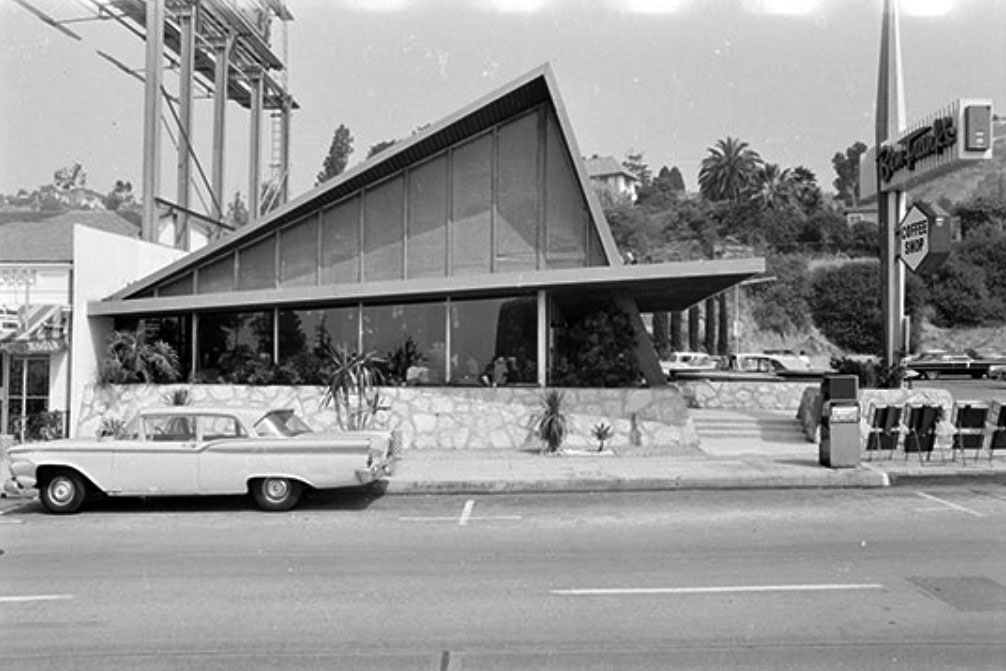 |
|
| (1966)* – View looking across the street showing Ben Frank’s Coffee Shop located at 8585 Sunset Boulevard, West Hollywood. Photo from the Getty Conservation Research Museum. |
Historical Notes Ben Frank’s was designed by architects Lane and Schlick and built in 1962. In form it follows neither the standard Googie formal language of Armét and Davis’s coffee shops, nor the traditional feel of the A-frame International House of Pancake restaurants, but rather exhibits a kind of kinky Googiefication of the A-frame. |
 |
(1967)* – Andy Worhol on Sunset Strip with Ben Frank's Coffee Shop in the background. |
|
Historical Notes For many years, Ben Frank's was an 'in' dining spot on the Sunset Strip in West Hollywood. It was casual and comfortable. It had a great location with plenty of parking. It was close to the clubs on the Sunset Strip where people were always milling about all hours of the day and night. And Ben Frank's was open 24 hours 7. It's rumored that musicians Stephen Stills and Richie Furay were driving down Sunset Blvd with producer Barry Friedmen when they spotted Neil Young's Pontiac hearse driving the other direction. They flagged him down and they all pulled into the parking lot of Ben Frank's where they discussed forming the band that was to become Buffalo Springfield. |
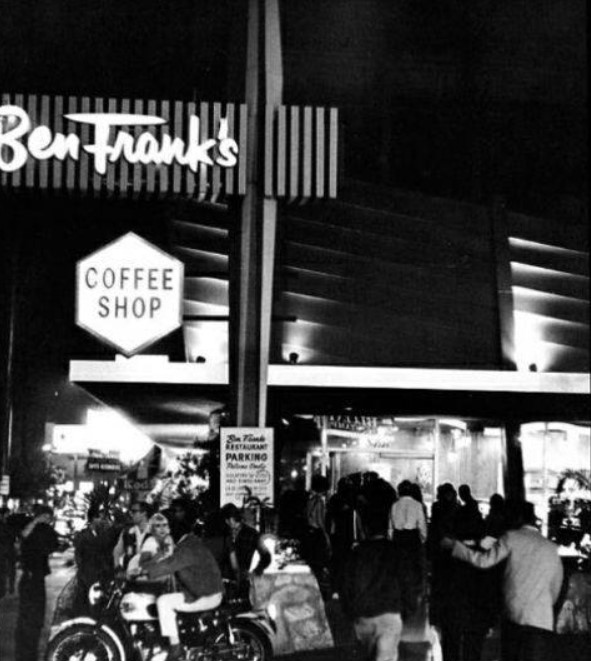 |
|
| (1972)* – View of Ben Frank’s Coffee Shop (now Mel's Drive-in) located at 8585 Sunset Boulevard, West Hollywood. |
Historical Notes Ben Frank's was founded by Arthur Simms and his son Thomas Simms. Arthur Simms moved to Los Angeles after serving in WW2. For a time Simms ran the commissary at MGM Studios. Simms was a dashing and flamboyant man, given to wearing pink sport coats. He opened his first restaurant in 1952 with partner Bob Ehrman, a coffee shop called Ben Frank's. Two more Ben Frank's would open in the Los Angeles area. Frank Zappa would often hang out at Ben Frank's. Ben Frank's would become Mel's Drive-in in 1997. |
Mel's Drive-in (previously Ben Frank's Coffee Shop)
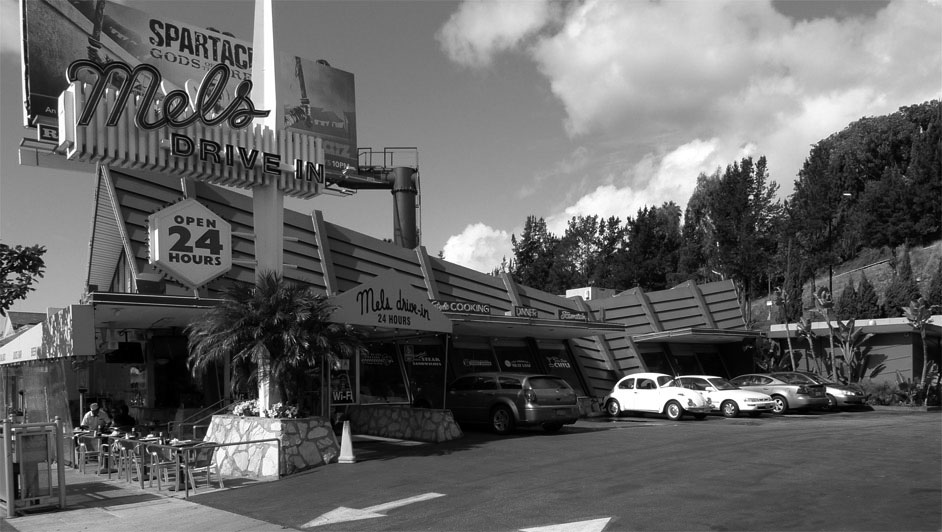 |
|
| (2011)* - View showing Mel’s Drive-in Restaurant, open 24 hours per day. |
Historical Notes Mel's Drive-Ins were born in the San Francisco Bay Area in 1947, created by Mel Weiss and Harold Dobbs, who at one time ran 11 drive-ins. In 1972 the craze had died out and George Lucas used the last remaining original Mel's Drive-In as the set for American Grafitti, after which it was demolished. In 1985 Mel's son Steven resurrected the nostalgic diners, now operating four in the Bay Area and four in the Los Angeles area, including this one on the Sunset Strip in West Hollywood. Mel’s remodeled the original Ben Frank’s building. Alterations included the addition of the awning in the front, extending the window openings at the parking-lot side of the A-frame, and the addition of an attached outbuilding in back. The pylon-shaped sign standard with its radiator-like fins is original. |
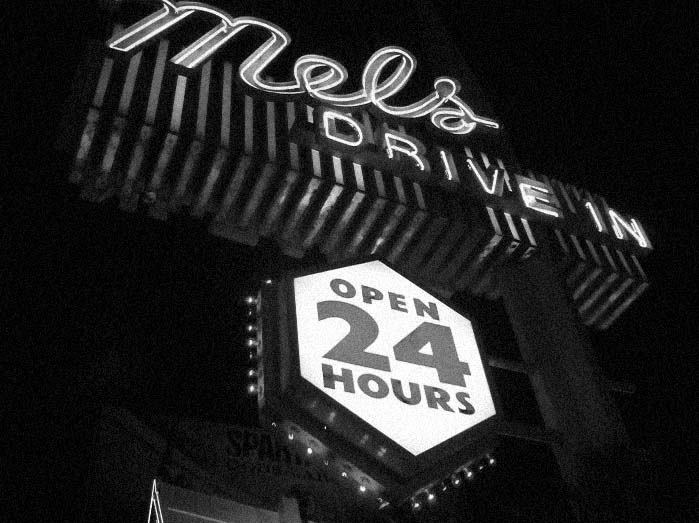 |
|
| (2011)* - View of Mel's Drive-In Coffee Shop, formerly Ben Frank's Coffee Shop. Despite the Drive-In name, Mel's doesn't actually provide car-hop service. Click HERE to see contemporary view. |
Historical Notes The 50s-feel diner sports table-side jukeboxes and a traditional burger and fries menu in a "Googie"-style building that was once Ben Frank's restaurant, a popular 24-hour coffee shop where rockers frequently gathered after gigs on the Strip. Click HERE to see more Early Views of LA Drive-in Restaurants. |
Cameo Theatre
 |
|
| (1961)* - The Cameo Theatre located at 8365 Sunset Boulevard in what is now West Hollywood. Today a shopping center is at this location. Click HERE for Contemporary View. |
Historical Notes In 1960 a group of actors announced plans to open a theatre in a storefront one door west of the Players Ring. The actors renovated the building into the same theatre-in-the-round format as the Players Ring. A review of their first production, “Sabrina Fair,” complained about the small space, but audiences didn’t seem to mind. The next shows, “Grand Prize“ in July and “Heaven Can Wait” in August, were hits. In November 1961 a musical written by Jesse Lasky Jr., the son of one of the founders of Paramount Studios, opened at the Cameo. Described as a robust serio-comic epic of the old Nevada mining and gambling town of Virginia City, “Ghost Town” played for more than two months. One of the Cameo’s biggest hits was “The Man in the Dog Suit” (1962), which played for eight months. It starred former contract starlet at RKO and Columbia Pictures Arline Judge and Ty Hardin – born Orison Whipple Hungerford Jr., and rechristened Ty Hardin by Henry Willson, the agent who discovered Rock Hudson – who was starring at the time in the hit television series “Bronco.” In October 1963 the Cameo hosted an arts seminar “for anyone interested in acting, directing, producing or writing for the stage.” Lecturers included Richard Boone, Richard Chamberlain, Raymond Massey, Jose Ferrer and Loretta Young. “King of Hearts” opened on Christmas day 1963. The next show, “It’s Still an Act,” which opened in October 1964, four months after a fire had destroyed the Players Ring next door, was the Cameo’s last. The building was soon razed as part of the shopping center development.* |
Garden of Allah Hotel
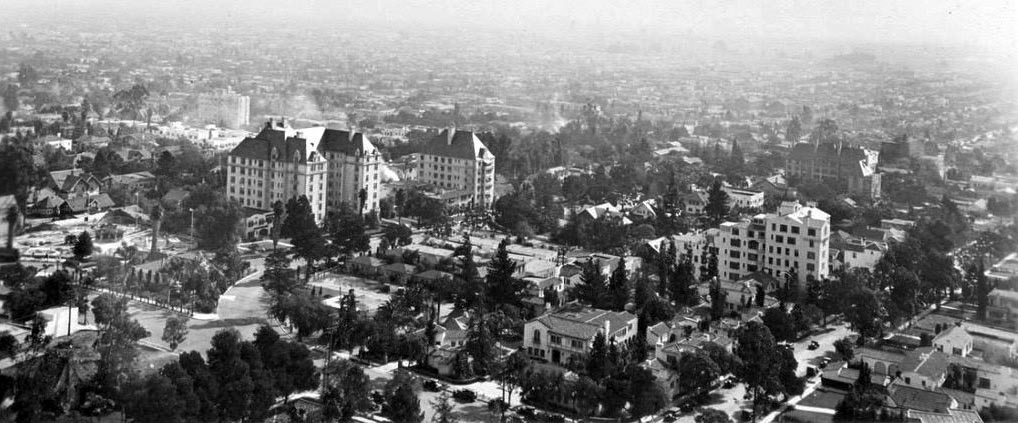 |
|
| (ca. 1930)#**# – Panoramic view looking southeast showing the Garden of Allah Hotel and complex as seen at lower-center. Sunset Boulevard runs diagonally from center-bottom to lower center-left with Crescent Heights on this side of the three apartment towers at center-left. |
Historical Notes The Garden of Allah was a famous hotel in Hollywood at 8152 Sunset Boulevard between Crescent Heights and Havenhurst, at the east end of the Sunset Strip. It was originally a 2.5 acre estate called Hayvenhurst^ that was built in 1913 by real estate developer William H. Hay as his private residence. *^ ^Originally named Hayvenhurst, it was built for $30,000 in 1913 by William H. Hay, developer of the Crescent Heights neighborhood, which was bounded by Sunset and Santa Monica blvds, to the north and south, Fairfax (then called Crescent Ave.) to the east and Havenhurst (originally spelled "Hayvenhurst") to the west. Hay and his second wife lived in Hayvenhurst briefly before building an even grander home down the street (where the Directors Guild building is now) and then finally retiring to a large house at 4400 Hayvenhurst Avenue in Encino, another neighborhood Hay owned and developed. After the Hays moved out, Hayvenhurst stood empty for a few years before Alla Nazimova acquired it, including during World War I, when the Hays allowed the Red Cross to use it as its Westside headquarters. Nazimova ... leased Hayvenhurst in November 1917.... She purchased it outright for $65,000 in August 1918. |
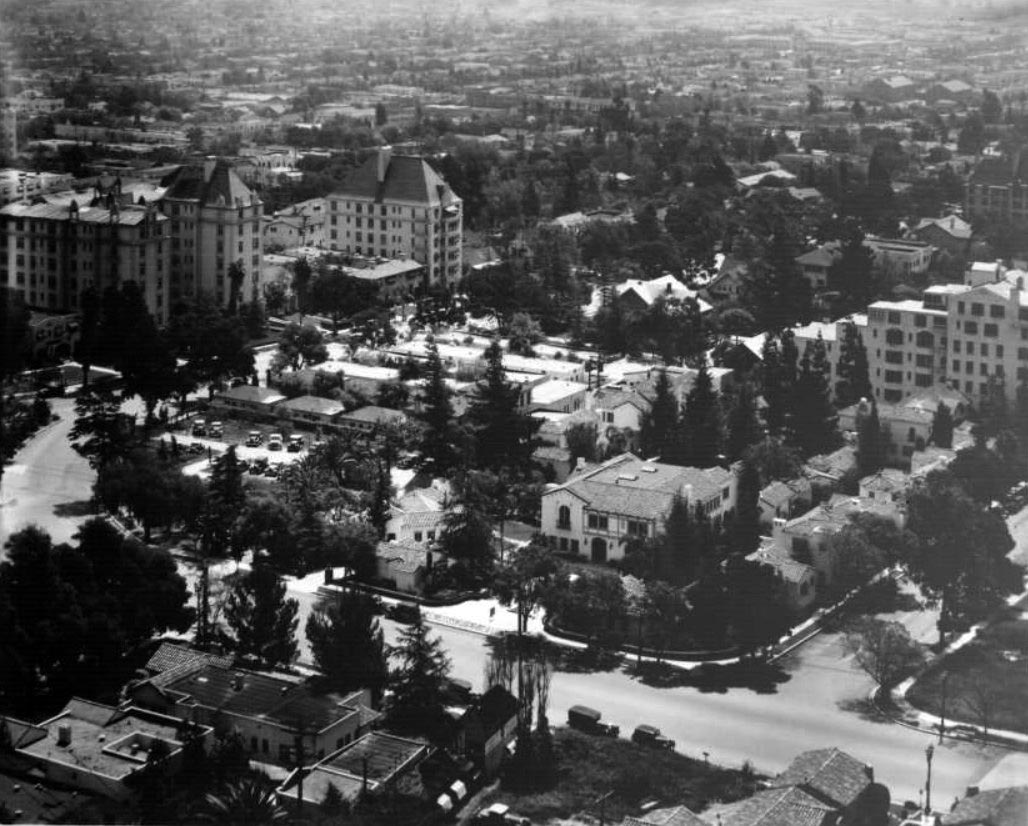 |
|
| (1930s)^^ – Closer view looking South-Southeast across Sunset Boulevard showing the Garden of Allah hotel complex in the middle of photo. Crescent Heights is on the left and Havenhurst Drive at right. |
Historical Notes Silent screen star Alla Nazimova acquired the property in 1918 and then, in 1926, converted it into a residential hotel by adding 25 villas around the residence. The hotel opened in January 1927 as the Garden of Alla Hotel (no final "h" on Alla). By 1930, new owners had changed the name to the Garden of Allah Hotel. Over the next two decades, the property went through a succession of owners, the last of whom was Bart Lytton, owner of Lytton Savings & Loan, who demolished the hotel in 1959 and replaced it with his bank's main branch.*^ |
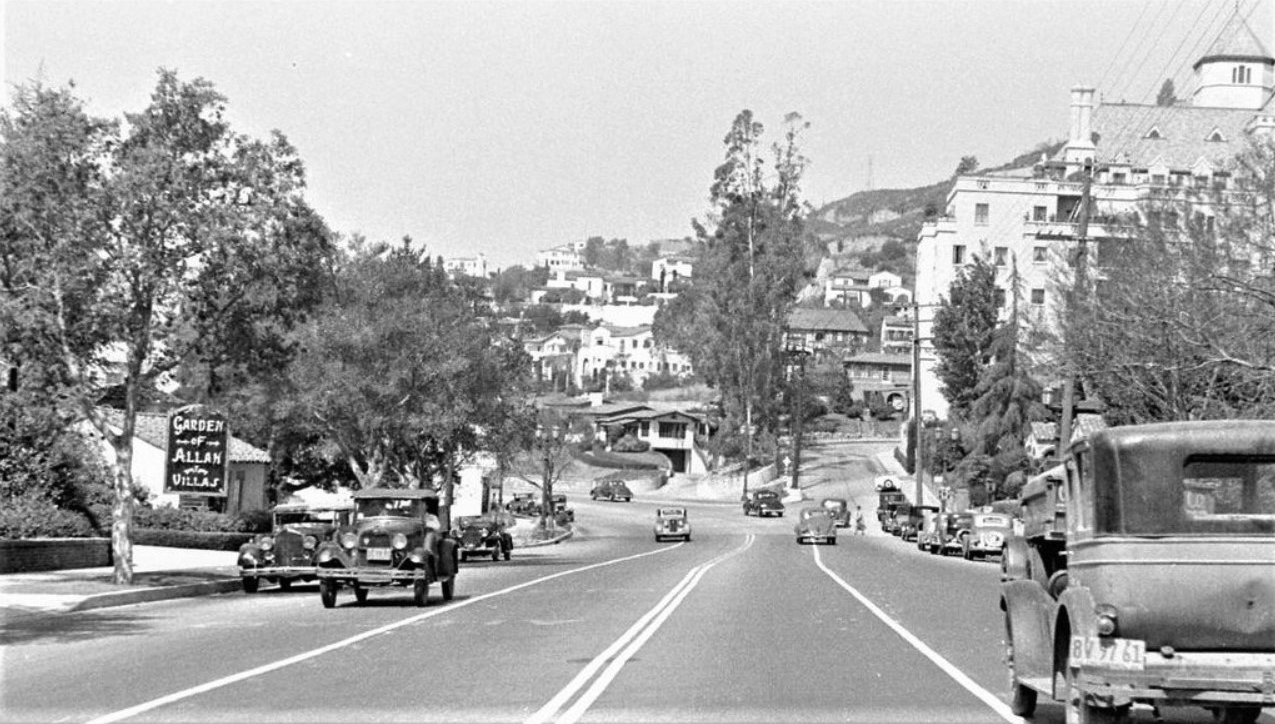 |
|
| (ca. 1936)^##* – View looking west on Sunset Boulevard toward Havenhurst Drive, just on the other side of the Garden of Allah (seen on the left). In the distance can be seen the confluence of Sunset which bends to the left and Marmont Lane which runs essentially straight forward. The Chateau Marmont Hotel stands formidably on the right. |
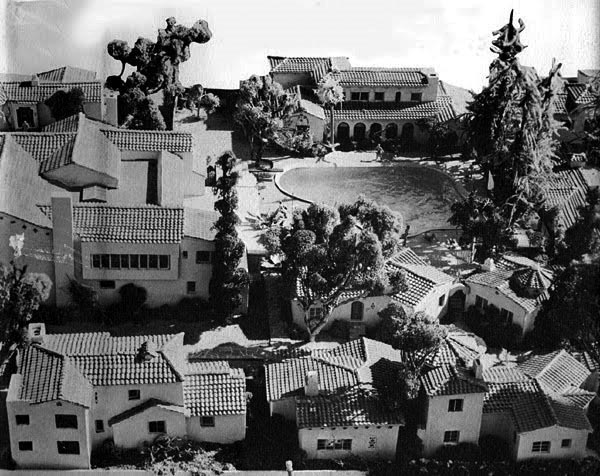 |
|
| (n.d.)##^ - Scaled miniature model of the Garden of Allah Hotel showing the new bungalows that now surrounded the main hotel. |
Historical Notes In the mid-1920s owner Alla Nazimova proceeded to spend a small fortune, adding 25 two-story bungalows built throughout the grounds. Known initially as “The Garden of Alla” (no final “h”). Unfortunately for Nazimova, the investment proved to be her financial undoing. Within a year of the opening she was bankrupt and in 1928 she sold her shares in the property. The hotel however was a huge and instant success. It attracted many people lured by Hollywood’s promise of fame and fortune and quickly became one of the places people stayed when they first arrived in Hollywood before making their way up the ladder.*^^ |
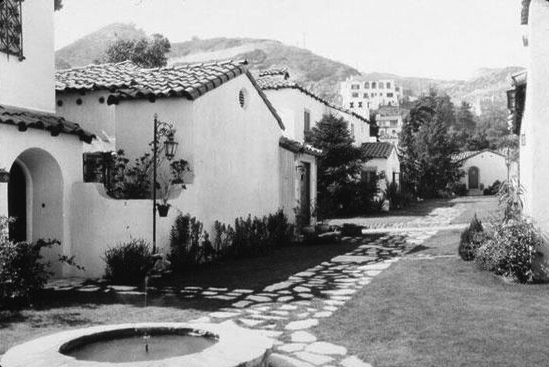 |
|
| (ca. 1930s)^.^ – View looking north showing villas at the Garden of Allah Residential Hotel and part-time home to most of Hollywood’s glitterati until 1959. |
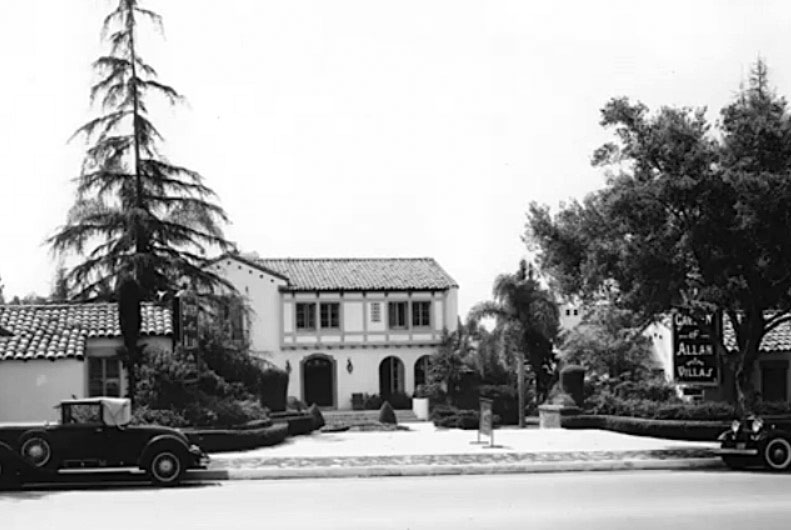 |
|
| (1930s)^x^ – View looking south from Sunset Boulevard showing the Garden of Allah Hotel. |
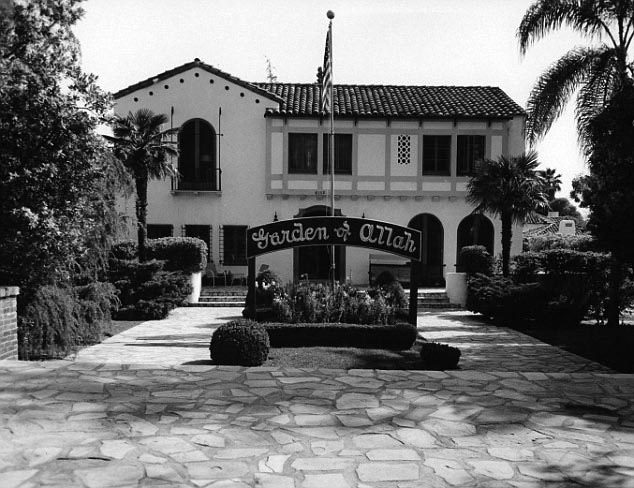 |
|
| (1940)##^ – View showing the Garden of Allah Hotel 'Main House' located at 8152 Sunset Boulevard. |
Historical Notes The 'Hotel / Main House,' frequently described as the "big house," contained eight guest rooms a restaurant, the kitchen and staff quarters ... and the bar, where even during the War years one could get a drink.*^^ Within walking distance from The Garden were; Ciro's, the Mocambo, the Trocadero, La Rue, the Players, and of course Schwab's Drugstore, just across Crescent Heights. |
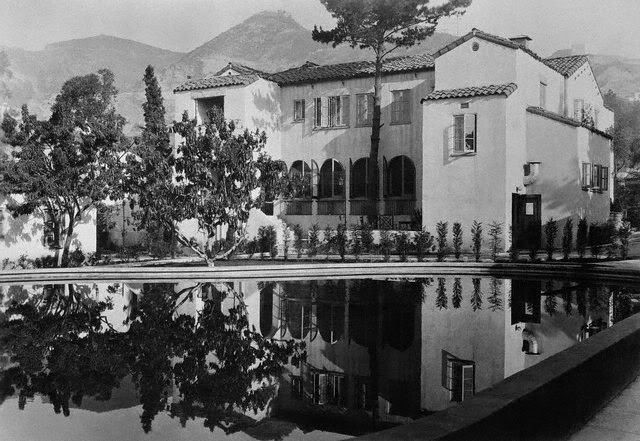 |
|
| (ca. 1940s)#**# - View, looking north, of the swimming pool situated directly behind the ''Hotel / Main House”, with the Hollywood Hills in the background. |
Historical Notes For sometime, this was the largest swimming pool in town. It was built to remind Nazimova of her home in Yalta. Paramount Studios had bestowed Nazimova with the home and grounds when the star was at her apex so that she could enjoy a glamorous retreat in the burgeoning Hollywood community. A 1959 LA Times article discusses those early years: To garnish the gift, Nazimova built Hollywood’s largest swimming pool—65 x 45 ft.—and had it shaped like the Black Sea of her girlhood. The pool hung like a dewy sapphire around the heart of her garden.+#+#+ |
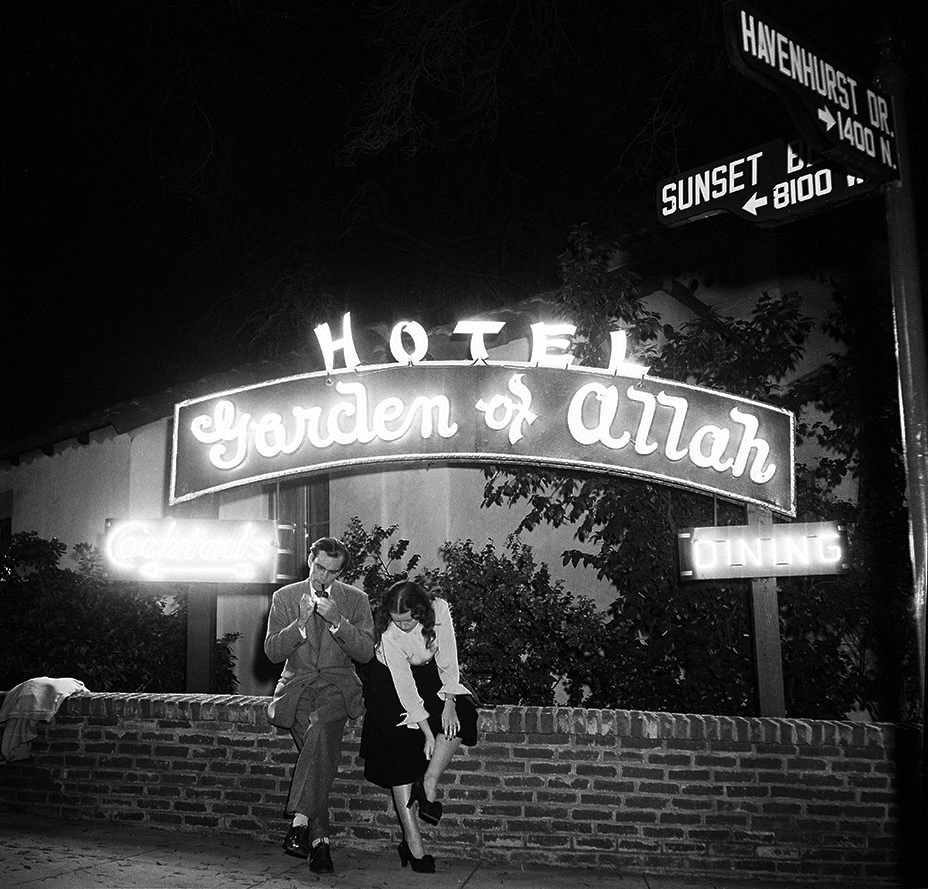 |
|
| (1951) ^x^– View showing a man and woman sitting on a wall in front of the Garden of Allah Hotel. The man is lighting his pipe while the woman is checking her stocking. |
Historical Notes For decades, the Garden of Allah was not so much a hotel as one very long house party — one where every vice was allowed to flower. And it's easier to say who didn't check in at the Garden rather than who did. Humphrey Bogart, Frank Sinatra, Laurence Olivier, Greta Garbo and Orson Welles were among the actors who lived there. Writers included F. Scott Fitzgerald, W. Somerset Maugham, Dorothy Parker and Ernest Hemingway. Marlene Dietrich liked to swim naked in the pool, while Errol Flynn would pounce on every beauty who so much as dipped her toe in it. ##^ |
 |
|
| (1950s)##^* – View looking at the southeast corner of Sunset Boulevard and Havenhurst Drive showing the Garden of Allah Hotel Restaurant (after expansion). Sign reads: Now Leasing – Apts – Bachelors – Villas. |
Historical Notes As Hollywood grew, the studio era began to wane and the city eventually surrounded the Garden of Allah. The real estate it was built on became more valuable as commercial property than the hotel itself. The hotel became seedier and the new stars, such as Montgomery Clift and James Dean, stayed at the nearby Chateau Marmont, which afforded more privacy and less chance of encounters with the less stylish transients who increasingly occupied the neglected villas at the Garden of Allah. In 1959, the Garden of Allah came to its official end. Lytton Savings and Loan had bought the property, and had plans to turn the corner of Sunset and Crescent Heights into a business center, anchored by a bank. +#+#+ |
Lytton Savings and Loan
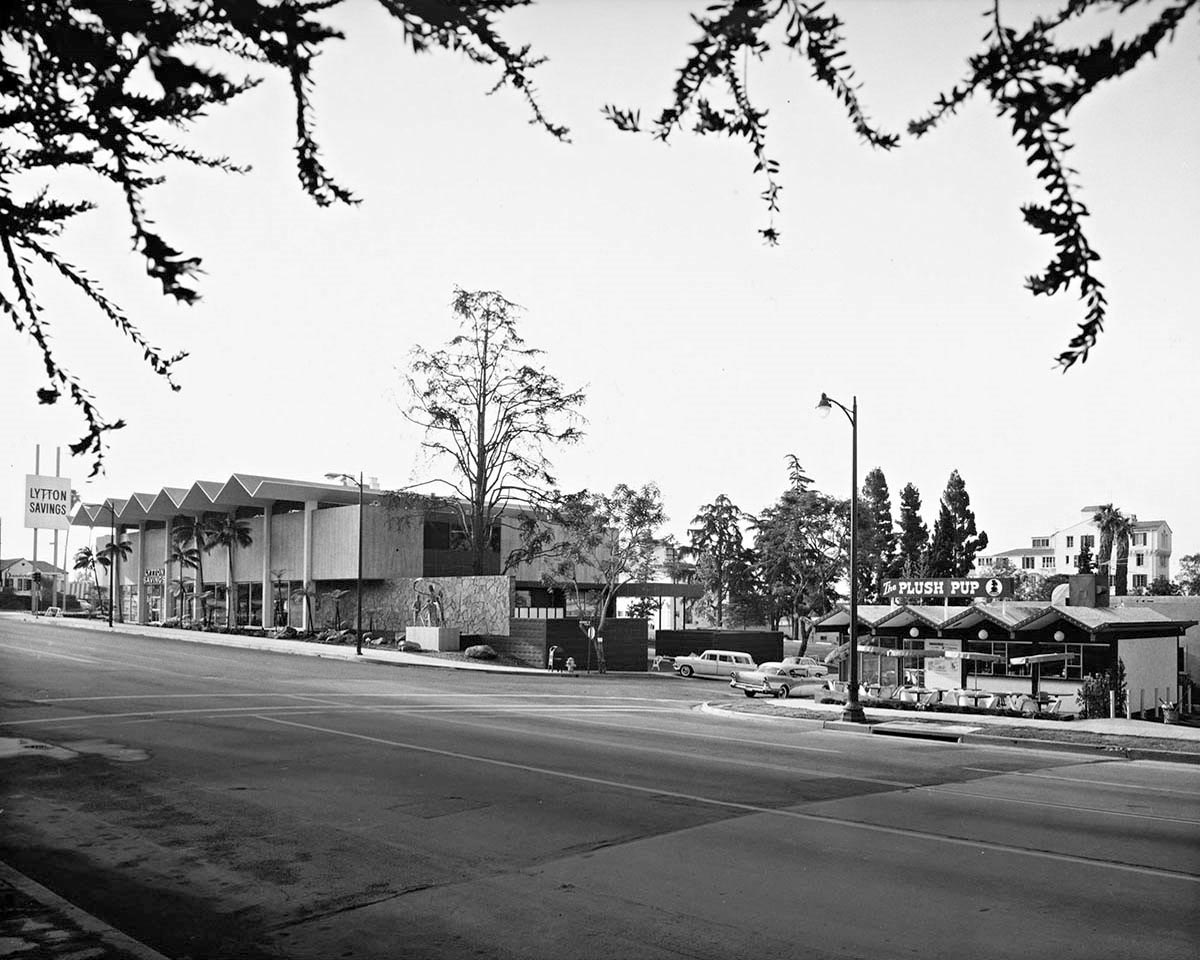 |
|
| (1960)#+#+ – View looking southeast toward the intersection of Sunset Boulevard and Havenhurst Drive showing the Lytton Savings and Loan Building on the left (S/E corner). On the right and across the street stands the Plush Pup Restaurant (S/W corner) with Colonial House on Havenhurst Drive behind it. Click HERE to see contemporary view. |
Historical Notes Lytton Savings occupied the former site of the Garden of Allah. The storied Hollywood inn with surrounding villas was purchased by Lytton Savings in 1959 and razed to make way for the firm’s new home office. *^ |
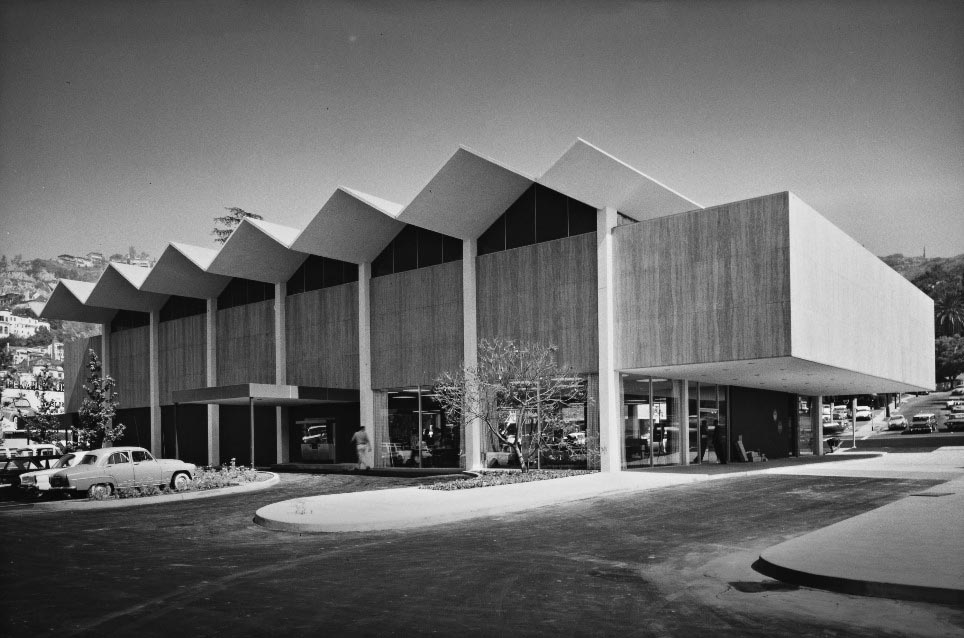 |
|
| (1960)#+#+ - View looking northwest showing the back of the Lytton Savings and Loan Building (today a Chase Bank) with the Hollywood Hills in the background. |
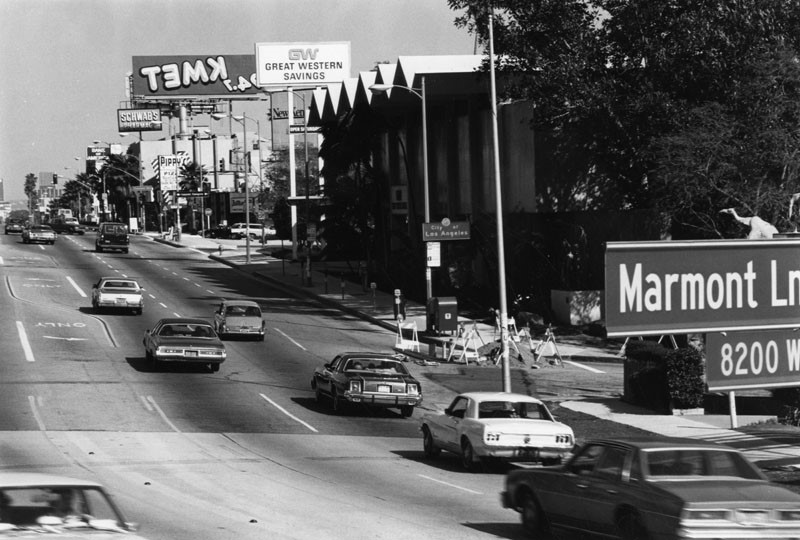 |
|
| (1979)* – View looking east on Sunset Boulevard toward Crescent Heights showing the Lytton Savings and Loan building, occupied above by Great Western Savings and Loan, and today by Chase Bank. Click HERE to see contemporary view. |
Then and Now
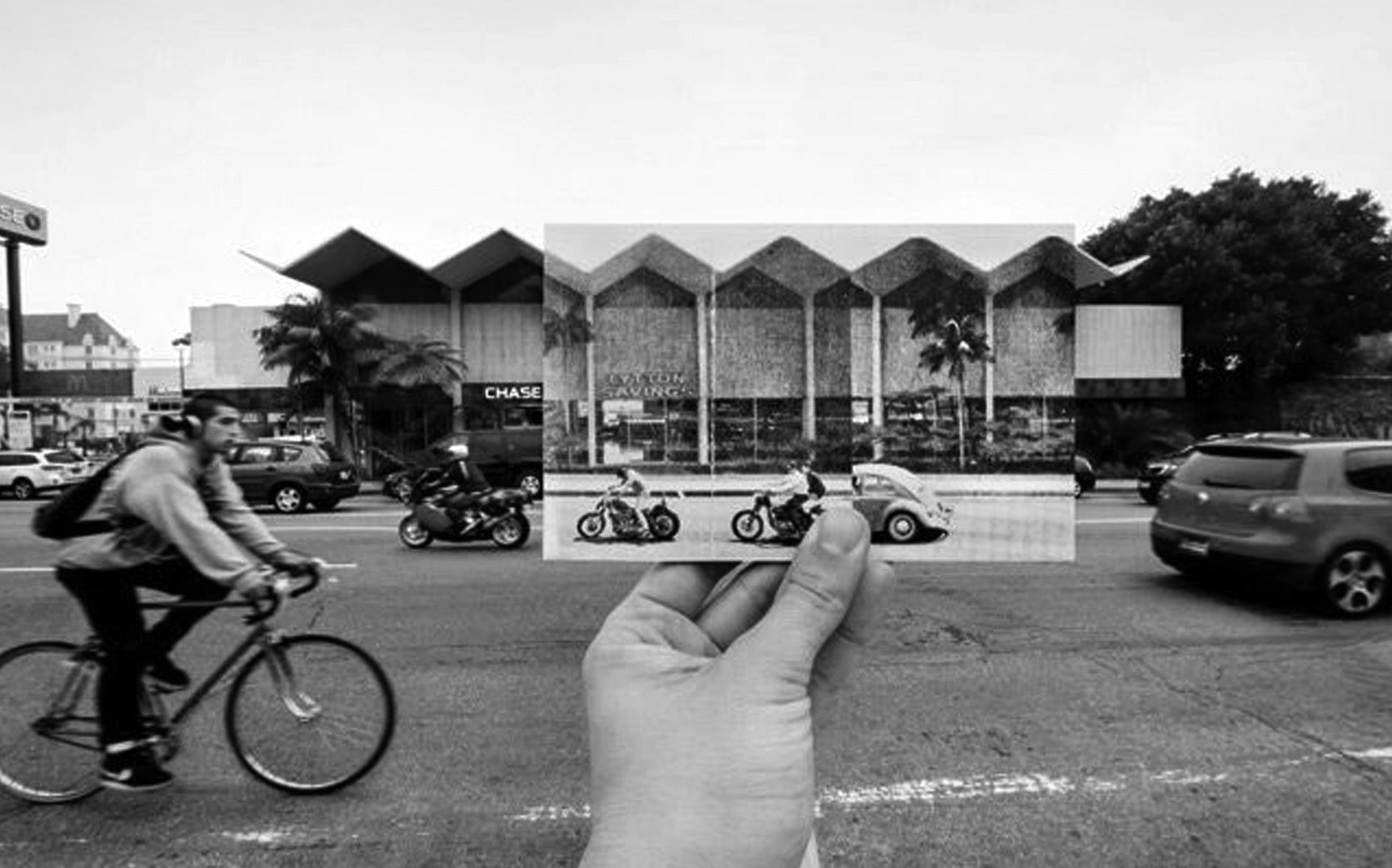 |
|
.jpg) |
|
| (1970s vs. 2010s)^.^ – Composite view showing Lytton Savings and Chase Bank – Then and Now. |
Then and Now
 |
|
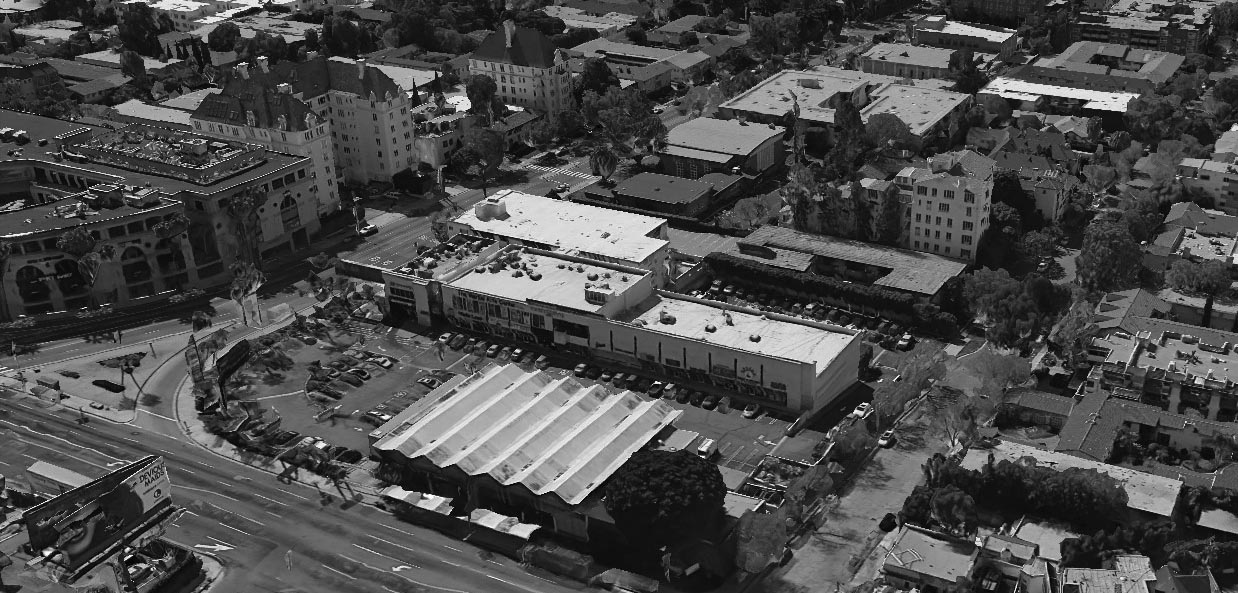 |
|
| (ca. 1930)#**# vs. (2016)*### - Aerial view showing the Garden of Allah Hotel site near Sunset and Crescent Heights. |
Spago Hollywood
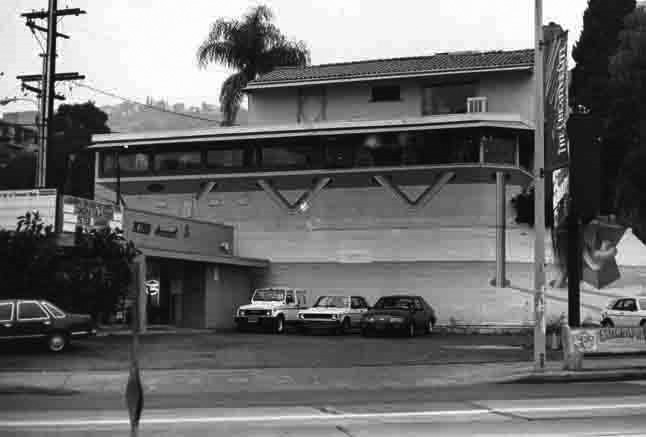 |
|
| (1980s)^##^ – View looking at the northeast corner of Sunset Boulevard and Horn Avenue showing the world famous Spago Restaurant. |
Historical Notes This was the original Spago, located at 8795 Sunset Boulevard (entrance at 1114 Horn Avenue) on the Sunset Strip in West Hollywood. It opened in 1982, and closed in 1997 when the Beverly Hills location opened. *^ The original Spago attracted almost everyone who was anyone in Hollywood, from producers to politicians to major movie stars. In 1975, Wolfgang came to Los Angeles and very quickly garnered the attention of the Hollywood elite as chef of Ma Maison in West Hollywood. From Ma Maison, Wolfgang went on to create his first flagship restaurant, Spago, in West Hollywood on the Sunset Strip. From its opening day in 1982, Spago was an instant success and culinary phenomenon. Wolfgang and Spago earned many accolades during its popular eighteen years in West Hollywood, including winning the prestigious James Beard Foundation Award for Outstanding Chef of the Year, twice, in 1991 and 1998, and the James Beard Foundation Award for Restaurant of the Year in 1994. Wolfgang is the only chef to have won the Outstanding Chef of the Year Award multiple times. After 15 successful years in West Hollywood, Wolfgang moved Spago to Canon Drive in Beverly Hills.^* |
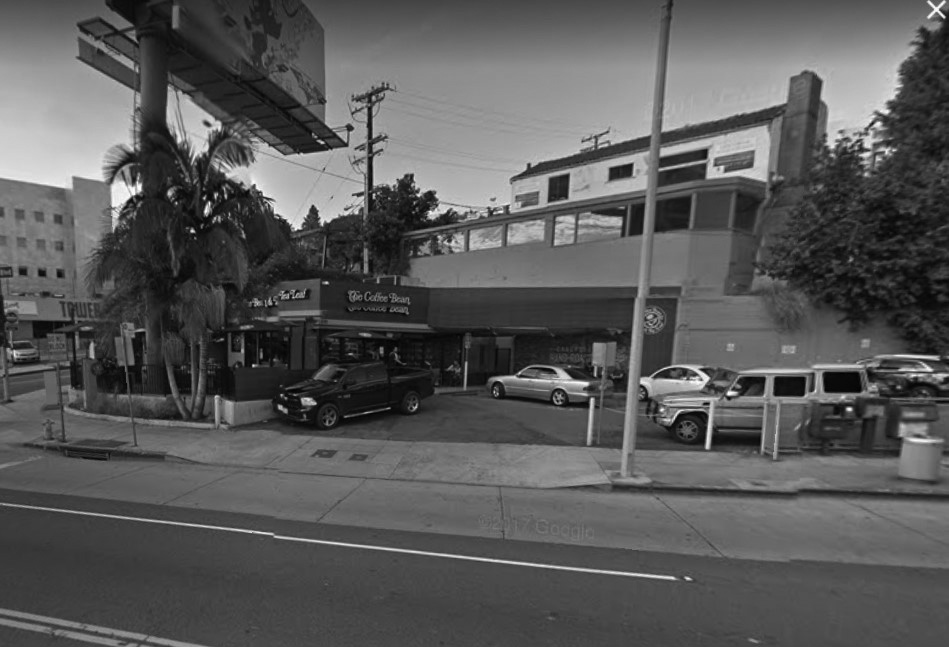 |
|
| (2016)* – Google street view showing the northeast corner of Sunset and Horn, location of the original Spago Restaurant. Tower Records can be seen across the street. |
Historical Notes Little known fact: That unassuming building that was occupied by Spago once housed the legendary Café Gala which was significant for its association with the history of the LGBTQ community in West Hollywood. It was one of the first supper clubs with an openly gay clientele. Run by the eccentric Baroness Catherine d’Erlanger and Johnny Walsh, the Venetian-themed club saw a co-mingling of straight and gay patrons. At Café Gala, gay and lesbian stars did not have to worry about being caught up in a police raid. Regular guests included Cole Porter, Judy Garland, and Lena Horne. Pianist Bobby Short started out here, and when Dorothy Dandridge made her debut performance, it was one of the hottest tickets in town. By the 1960s, the property was occupied by Russian-Armenian restaurant. From 1982 to 2001, it was the home of Spago.^* |
Scandia Restaurant
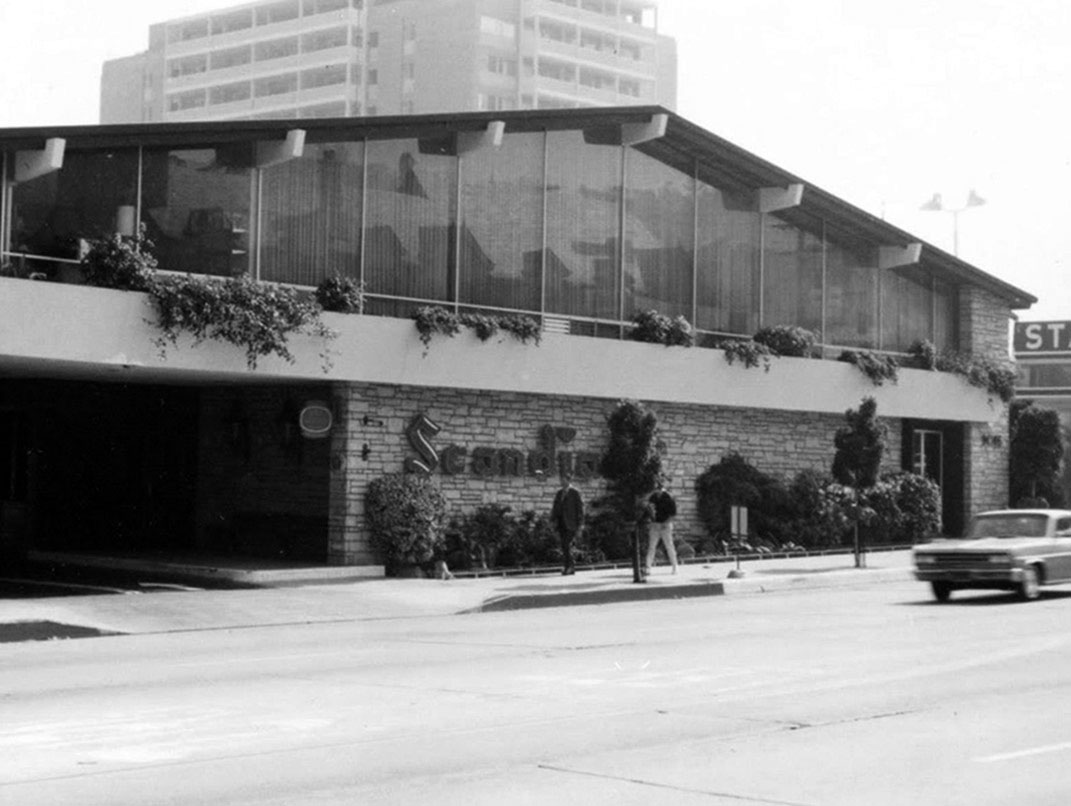 |
|
| (1970s)* – Daytime view of ‘High End’ Scandia Restaurant located at 9040 Sunset Boulevard in West Hollywood. |
Historical Notes Scandia wasn’t just high-end—it was happening. In its heyday, customers would beg, borrow, and steal for a reservation before 11 p.m. It’s where Frank Sinatra kept an office upstairs complete with a personal shower; Jack Webb held his wedding reception in the main dining room in 1958; and James Garner ate brunch on Sundays while filming The Rockford Files. The restaurant was even name-dropped in American Gigolo, and visited by five American presidents.* |
 |
|
| (1980)* - View of patrons standing outside the once legendary Scandia restaurant, located at 9040 Sunset Boulevard in West Hollywood. |
Historical Notes Opened in 1957, Scandia was originally owned by Ken Hansen. Along with his wife, Tova, he turned the restaurant into a culinary landmark with elegant decor, impeccable service, and delectable Scandinavian and French cuisine. Ken’s sister-in-law, Teddy, served as hostess. Scandia was a popular destination for members of the entertainment industry for decades. Inside, it included theme rooms: the Skal Room, which included a large copper bar, the Danish Room, full of Danish memorabilia, and the Terrace Room, fashioned after the Belle Terrace at Copenhagen's Tivoli Gardens. The restaurant offered a late-night dinner starting at 10:30 p.m. for the after-theatre crowd and had an award-winning wine cellar containing thirty thousand bottles. It closed its doors in 1989. |
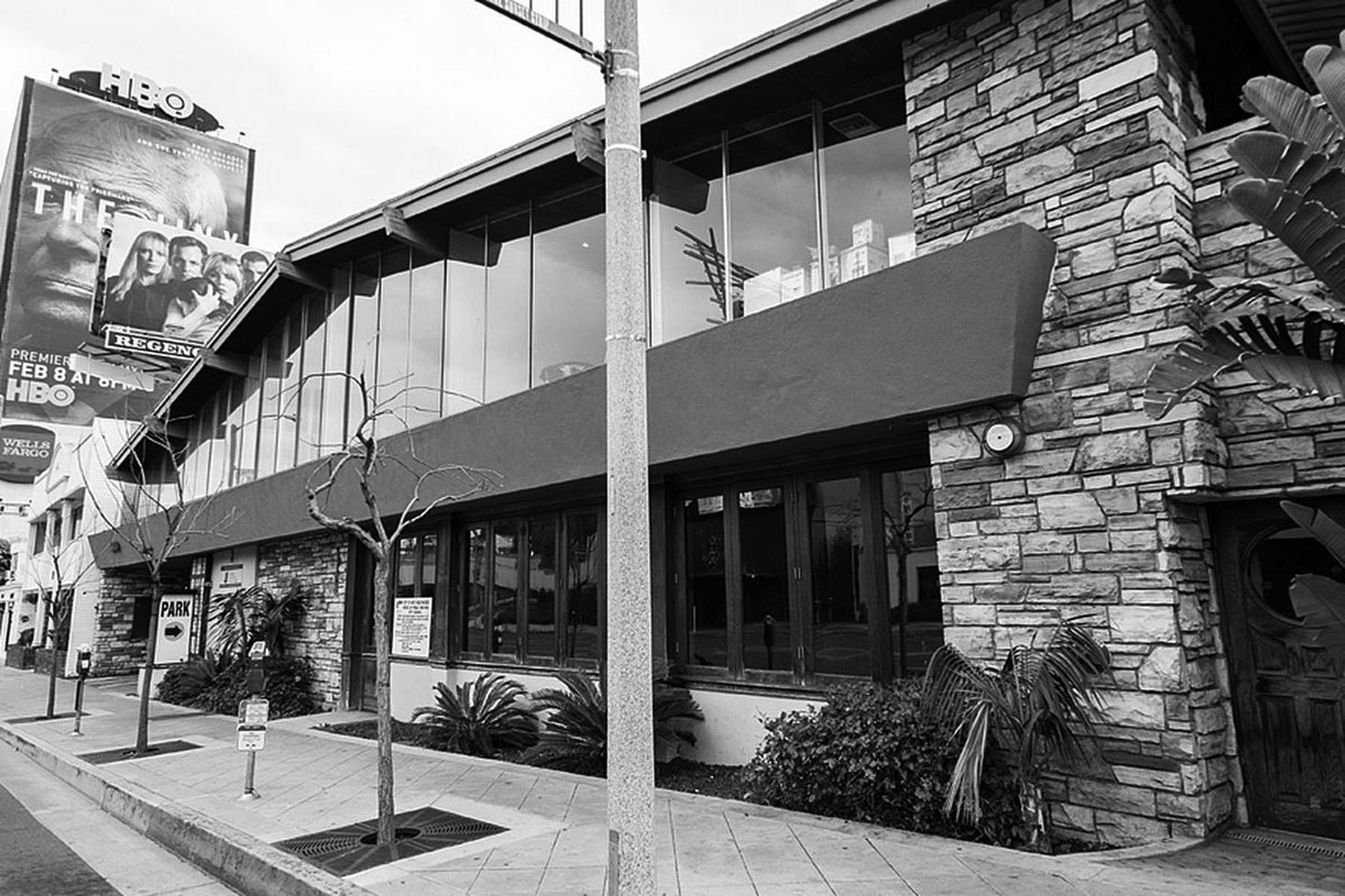 |
|
| (2015)^ – View of the old Scandia Restaurant building before it was demolished to make way for a new hotel (The West Hollywood EDITION). |
Historical Notes In 2019 the West Hollywood EDITION Hotel was completed on the site where Scandia Restaurant once stood. |
Rocky and Bullwinkle
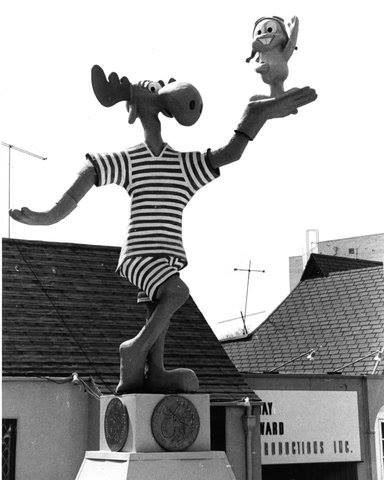 |
(ca.1975)##^* – Rocky and Bullwinkle on the Sunset Strip, 8200 W. Sunset Boulevard. |
Historical Notes From 1961 to 2013, this 15-foot-tall cartoon statue stood beside the former home of Jay Ward Productions, the company that created Rocky the Flying Squirrel and his pal Bullwinkle. The erstwhile squirrel and moose once faced a billboard ad for a Las Vegas hotel featuring a bathing-suit-clad showgirl, and every time her suit changed, Bullwinkle's shirt got painted to match. #++ |
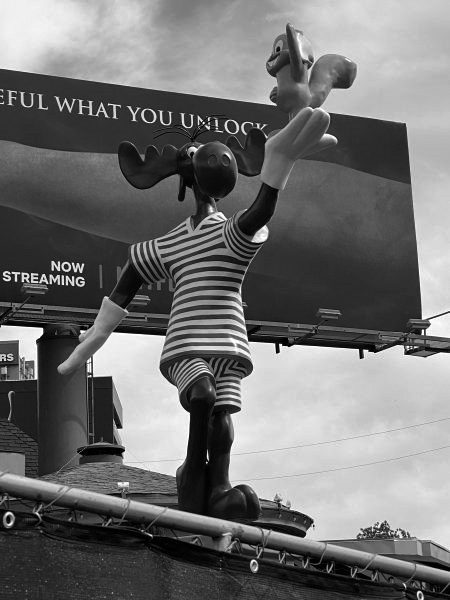 |
|
| The iconic Rocky and Bullwinkle statue back on the strip again at Sunset and Holloway Dr. |
Historical Notes In April 2020 the iconic Rocky and Bullwinkle statue found a permanent new home in the triangle at the intersection of Holloway Drive and Sunset Boulevard.* |
* * * * * |
Gene Autry Hotel Continental (later Continental Hyatt House and Andaz by Hyatt)
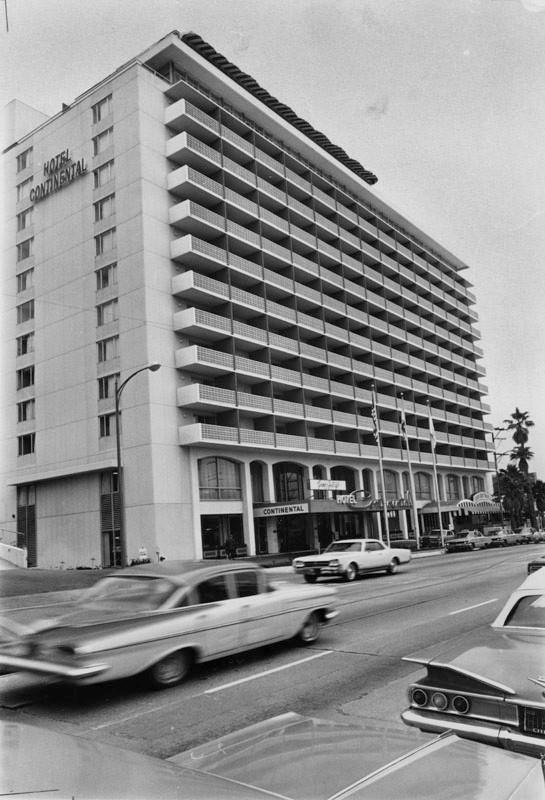 |
||
| (1966)* - Close-up view showing the 14-story Hotel Continental on the Sunset Strip, located at 8401 Sunset Boulevard. |
Historical Notes The hotel opened in 1963 as the Gene Autry Hotel. Sold in 1967, it was renamed the Continental Hyatt House. In 1976 it became the Hyatt on Sunset until February 1997 when the hotel was renamed the Hyatt West Hollywood. In January 2009 the hotel was renovated and renamed the Andaz West Hollywood.*^ Click HERE to see contemporary view. |
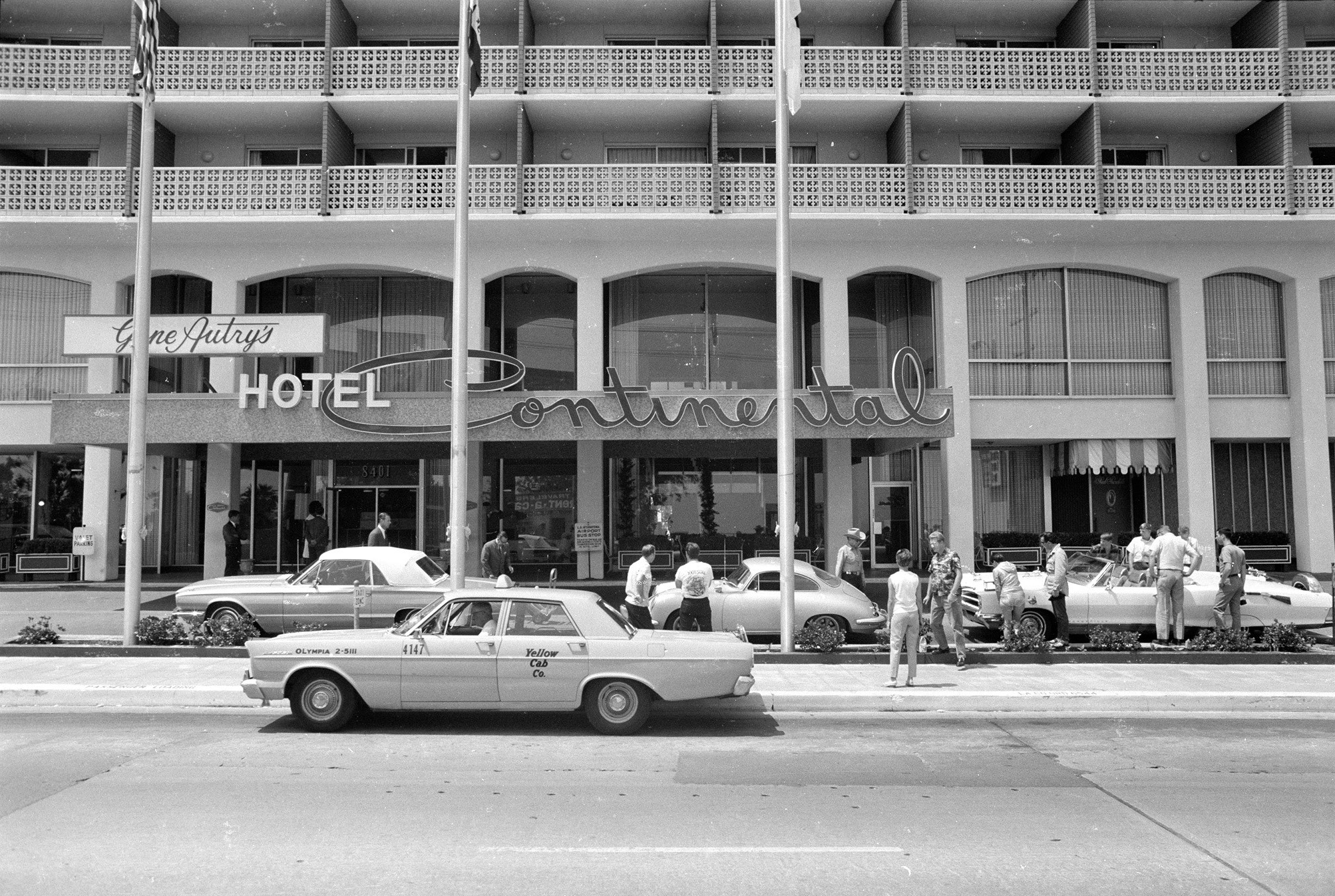 |
||
| (1966)^.^ - Gene Autry Hotel Continental as seen from across Sunset Boulevard with a 1965 Ford Galaxy taxi parked in front. |
Historical Notes Originally developed in 1963 as The Gene Autry Hotel Continental, it later become known as The Continental Hyatt House, and the Riot Hyatt as a reflection of its guests' propensity for partying. The hallowed halls have seen everything from Richard Cole (Led Zeppelin’s tour manager) riding his motorcycle through the hotel, to Keith Richards of the Rolling Stones (allegedly) tossing a television off of the balcony of room 1015. “We’ve since learned a few lessons and now the TVs are bolted to the walls and the balconies have been converted into sleek sunrooms,” noted Henning Nopper, the general manager at the Andaz West Hollywood. “Our history is one of Andaz West Hollywood's differentiating factors and is something we’re extremely proud of, so we definitely try and pay homage to that when we can.”* |
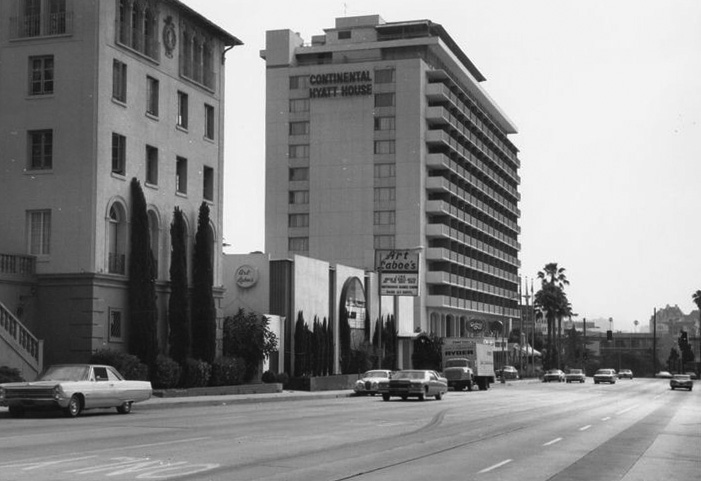 |
||
| (ca. 1967)^.^– View showing the Continental Hyatt Hotel on the Sunset Strip -- and note that Ciro's/the Comedy Store was called Art Laboe's. |
Historical Notes In the late 1960s and 1970s the hotel's proximity to popular clubs such as the Whisky a Go Go made it the preferred Los Angeles accommodation for touring rock groups, notably English bands Led Zeppelin, The Who and the Rolling Stones. It was often referred to at the time as the Riot House, a play on the name Hyatt House. In 1976 the hotel became the Hyatt on Sunset. In February 1997, the hotel was renamed the Hyatt West Hollywood. The hotel was renovated in 2008 and reopened on January 8, 2009 as the Andaz West Hollywood, the second Andaz hotel in the new brand by Hyatt Hotels and Resorts. The 14-story Andaz West Hollywood has 239 rooms, including 20 suites and a restaurant called RH (“Riot House”). The renovation was completed by New York-based architecture and interior design firm Janson Goldstein LLP and includes a hand-painted metal disk 11-foot sculpture by renowned New York-based artist Jacob Hashimoto. The balconies made famous by stories of rock stars throwing televisions from them are now glass-enclosed sunrooms that overlook Sunset Boulevard. |
* * * * * |
Sunset Tower (1970 - Present)
 |
|
| (1979)* - Looking out upon West Hollywood from a balcony at the Sunset Hyatt Hotel (later Andaz West Hollywood), showing the neighborhood and the iconic Sunset Tower; Downtown Los Angeles is partially visible through the haze on the right. |
Historical Notes After a period of decline in the early 1980s, the building was renovated and has been operated as a luxury hotel under the names The St. James's Club, The Argyle, and most recently the Sunset Tower Hotel. |
 |
|
| (2005)*^ – View showing the Sunset Tower Hotel located at 8358 Sunset Boulevard in West Hollywood. Photo by Carol M. Highsmith via Wikipedia |
Historical Notes The building was saved from deterioration and possible demolition when it was purchased in 1985 from architect David Lawrence Gray, FAIA by Peter de Savary who promised to "lovingly restore" the building to its former glory by spending $25 million to convert the building into the first American branch of his luxury hotel chain, the St. James's Club. The Lancaster Group purchased the hotel from de Savary in 1992, renaming it the Argyle. In 2004, Jeff Klein purchased the hotel. Klein hired designer Paul Fortune to renovate the hotel, adding more modern amenities, and restored its original name.^ |
 |
|
| (2011)^ - Sunset Tower, 8358 Sunset Blvd in West Hollywood, with the Downtwon LA skyline in the background. Photo by Mike Jiroch via Wikipedia |
Historical Notes The Sunset Tower building was listed on the National Register of Historic Places in 1980. In the 1990's the Sunset Tower Hotel was known as the Argyle Hotel. Before that it was known as the St. James Club and Hotel, a grand 13 story, the Strip's 1st high-rise (built in 1931), and one of Hollywood 's best examples of Art Deco design. Virtually every star in Hollywood stayed here at one time or another. It was a favorite of Howard Hughes, who kept a number of suites here fore his various girlfriends; other guest included Clark Gable, Jean Harlow, Marilyn Monroe, Frank Sinatra and John Wayne (who is said to have kept a cow on the balcony outside his penthouse suite for fresh milk). |
* * * * * |
Sunset Strip's Billboards
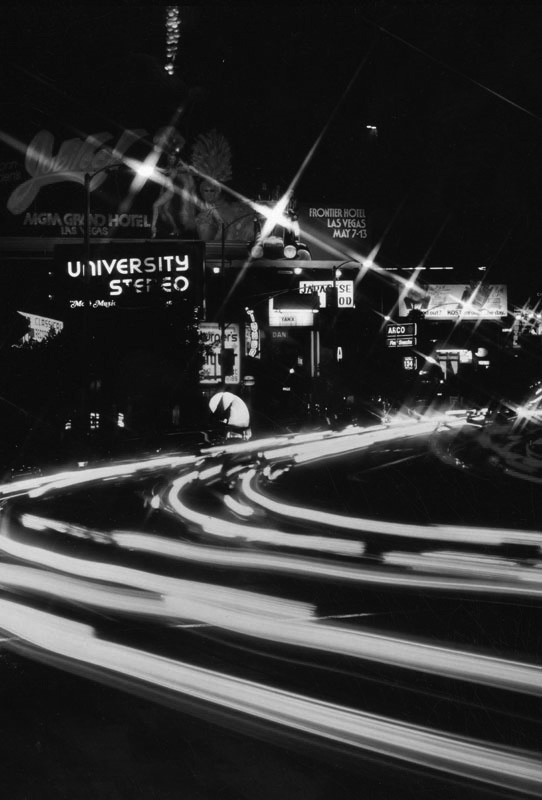 |
|
| (ca. 1980)* - Night view of large billboards along Sunset Strip with automobile headlights creating a neon-like streak. |
Historical Notes The Strip has a long tradition of innovative and memorable signage. In the 1960s and ‘70s making it “big” for musical artists meant a custom-painted billboard on Sunset Strip. |
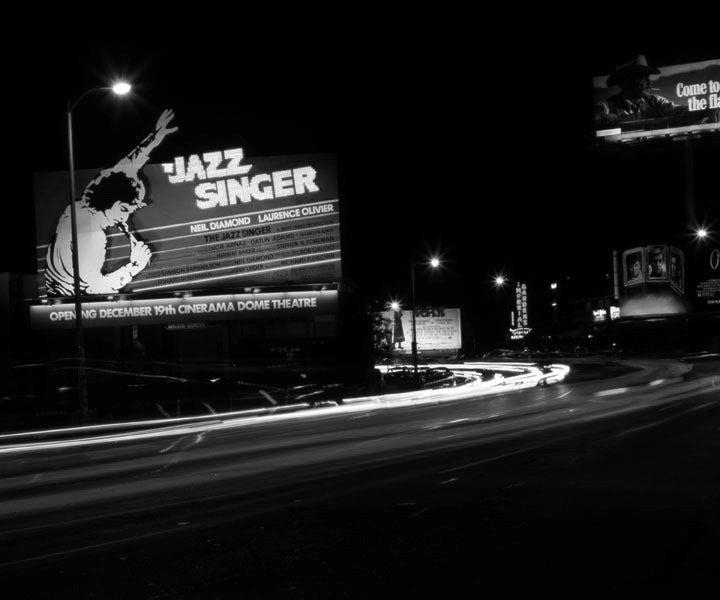 |
|
| (1980)* - View looking west from the northern side of Sunset Boulevard near Chateau Marmont at night. It is a part of the famous "Sunset Strip", the mile and a half stretch of Sunset Boulevard passing through West Hollywood. Large billboards for the "Jazz Singer", "Popeye", "Ordinary People", and Marlboro cigarettes are present on both sides of Sunset Boulevard. Shown in the distance is the yellow neon sign of Imperial Gardens Restaurant, later demolished, located at 8225 Sunset Boulevard. |
Historical Notes In the 1970s, the Sunset Strip became known for its prolific billboard advertising, especially by musicians and record companies promoting new albums, according to Robert Landau’s “Rock ‘n’ Roll Billboards of the Sunset Strip.” |
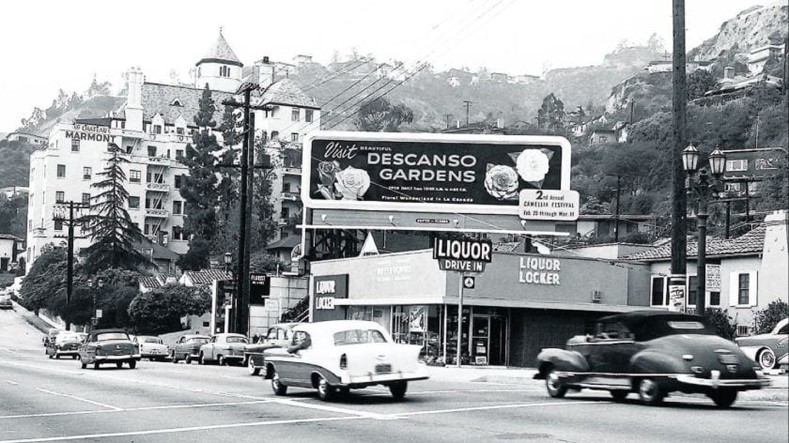 |
|
| (1959)* - Sunset Boulevard and the Chateau Marmont in the background. Note the billboard on top of the Liquor Locker for Descanso Gardens. |
Historical Notes The Strip has a long tradition of innovative and memorable signage. It wasn't until the 1960s and ‘70s that musical artists started to appear "big" along the Sunset Strip. |
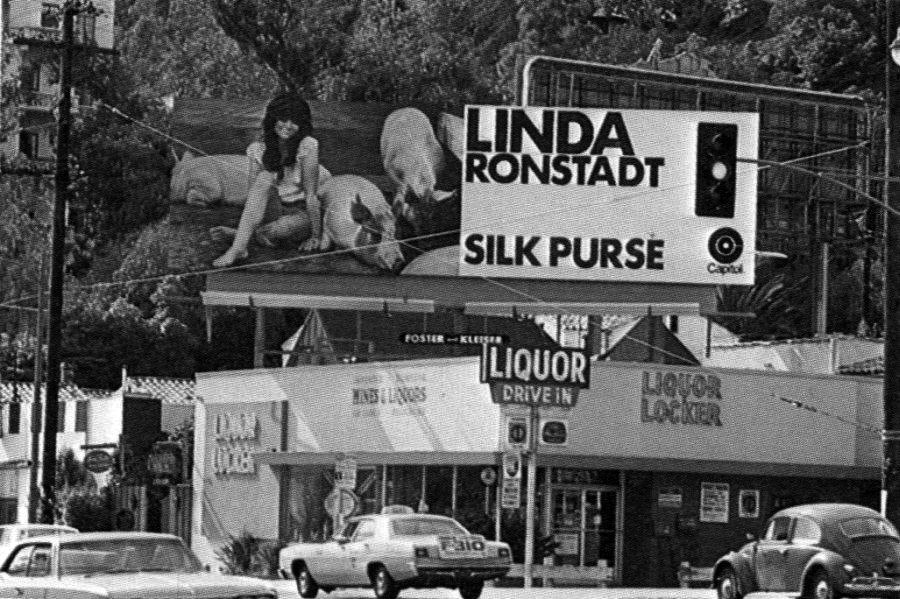 |
|
| (1970)*- Linda Ronstadt billboard atop Liquor Locker at 8161 Sunset on the Sunset Strip. |
Historical Notes Author Andrew Greeley, in his book God in Popular Culture, described Ronstadt as "the most successful and certainly the most durable and most gifted woman Rock singer of her era." Signaling her wide popularity as a concert artist, outside of the singles charts and the recording studio, Dirty Linen magazine describes her as the "first true woman rock 'n' roll superstar ... (selling) out stadiums with a string of mega-successful albums." Amazon.com defines her as the American female rock superstar of the decade. Cashbox gave Ronstadt a Special Decade Award, as the top-selling female singer of the 1970s. By the end of 1978, Ronstadt had solidified her role as one of rock and pop's most successful solo female acts, and owing to her consistent platinum album success, and her ability as the first woman to sell out concerts in arenas and stadiums hosting tens of thousands of fans, Ronstadt became the "highest paid woman in rock". She had six platinum-certified albums, three of which were number 1 on the Billboard album chart, and numerous charted pop singles. In 1978 alone, she made over $12 million (equivalent to $44,000,000 in 2016 dollars) and in the same year her albums sales were reported to be 17 million – grossing over $60 million (equivalent to a gross of over $220,000,000, in 2016 dollars).* |
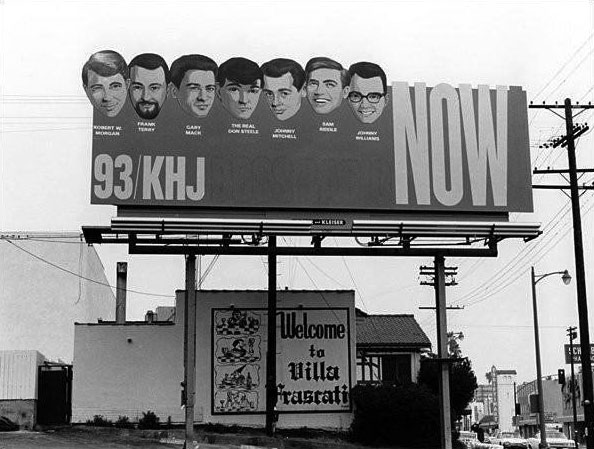 |
|
| (1960s)^ – Billboard advertising the 93/KHJ which helped cultivate a love for rock and roll in the 60’s and 70’s (along with KRLA). The small but popular Villa Frascati Restaurant, 8117 Sunset, is located directly east of the sign. |
Historical Notes KHJ (AM) was a nationally noted Top 40 station from 1965 to 1980. In 1965, programming consultant Bill Drake crafted KHJ's top-40 format. Drake hired program director Ron Jacobs, who had created formats in Hawaii and California. The format featured a restricted playlist and restrained commentary by announcers (although a few, such as Robert W. Morgan, Charlie Tuna, Humble Harve Miller, and The Real Don Steele, were allowed to develop on-air personalities). Other DJs from 1965-68 included Roger Christian, Gary Mack, Dave Diamond, Sam Riddle, Johnny Williams, Frank Terry, Johnny Mitchell, Tommy Vance, Scotty Brink, Steve Clark, Bobby Tripp, Tom Maule and Bill Wade. Part of the format, known as "Boss Radio", were jingles by the Johnny Mann Singers.* |
 |
|
| (1979)* - View of billboard on Sunset Strip advertising Superman adjacent to parking lot on 8459 Sunset Boulevard. Photo by William Reagh |
Historical Notes Parking lot and billboard are still there. Click HERE for contemporary view. The billboard was advertising the movie Superman II (Released in 1980) starring Christopher Reeve, Gene Hackman, and Margot Kidder. Christopher Reeve's last Superman movie was "Superman IV: The Quest for Peace" released in 1987. It was the final installment of the original Superman film series starring Reeve as the iconic superhero. |
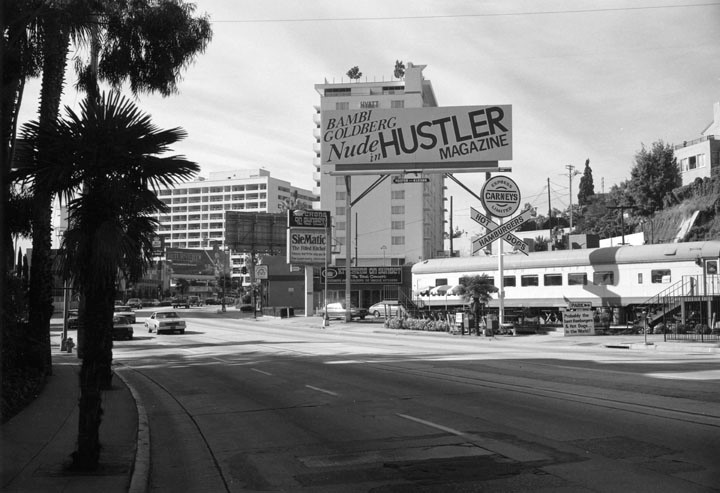 |
|
| (1983)* - A view of Sunset Boulevard showing Carneys Diner, located at 8351 Sunset Blvd with large billboard advertising Hustler Magazine in the background. |
Historical Notes Carneys first opened its doors in 1968. John Wolfe Sr., a local radio executive, decided to build his burger joint from two aging Union Pacific rail cars. Carneys quickly became a landmark on the Sunset Strip, specializing in Hot Dogs and Hamburgers. |
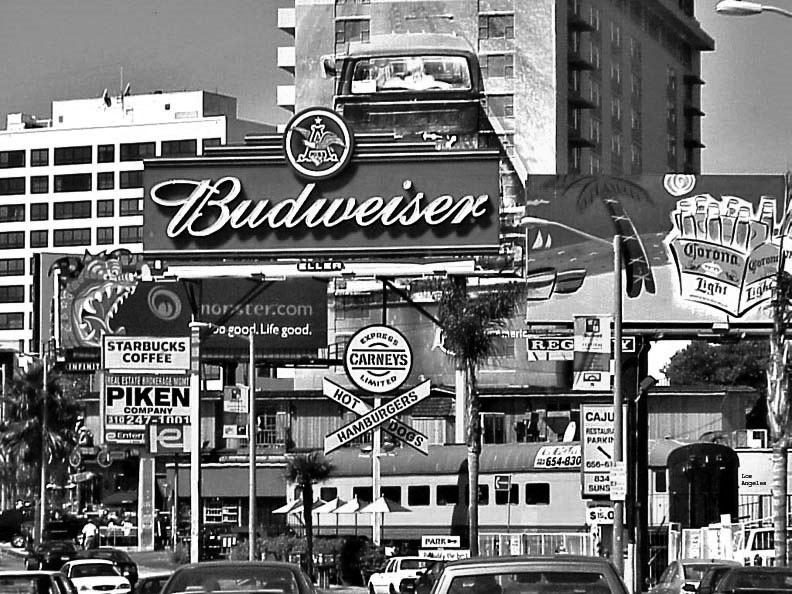 |
|
| (2001)* - A potpourri of billboards surround Carneys Diner on the Sunset Strip in West Hollywood. Photo courtesy of Wikipedia Commons |
Tower Records
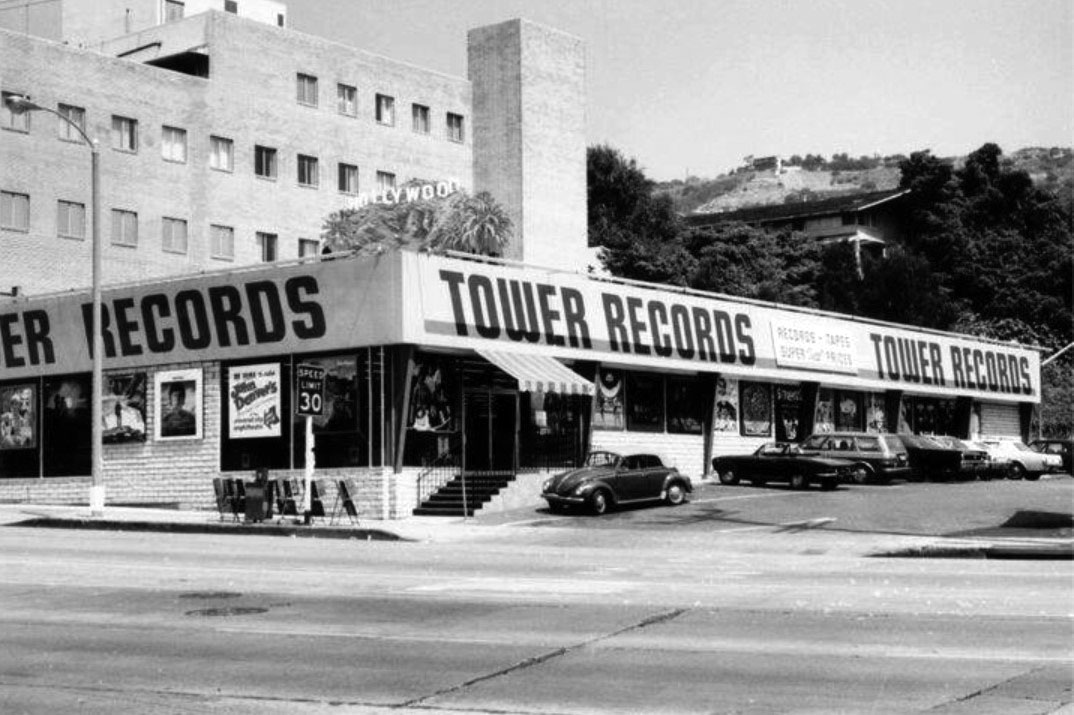 |
|
| (1970s)##^* – View showing Tower Records on the north side of Sunset with the Hollywood Hills in the background. |
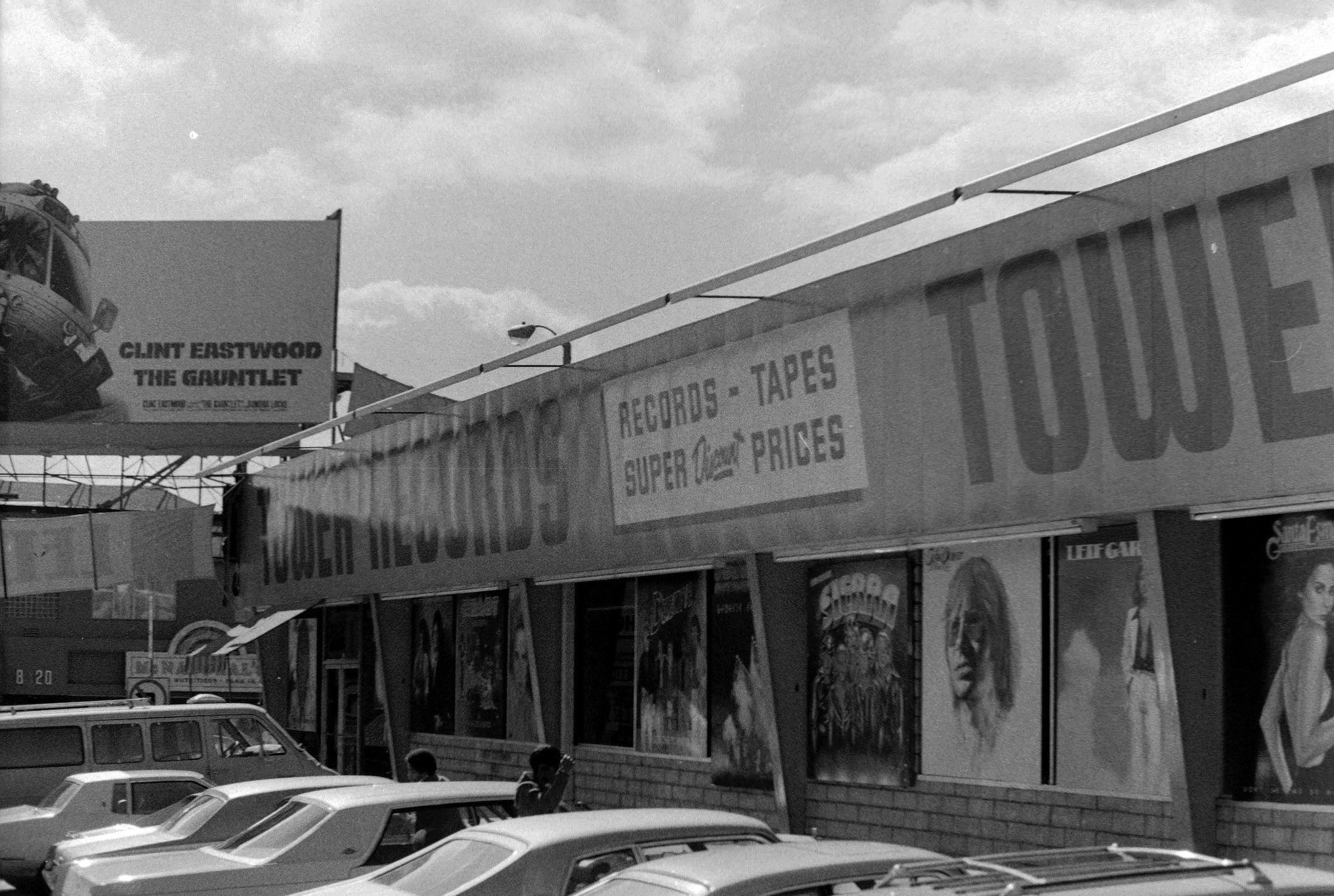 |
|
| (1977)^ - Close-up view of Tower Records from parking lot. Photo by Jeff Katz |
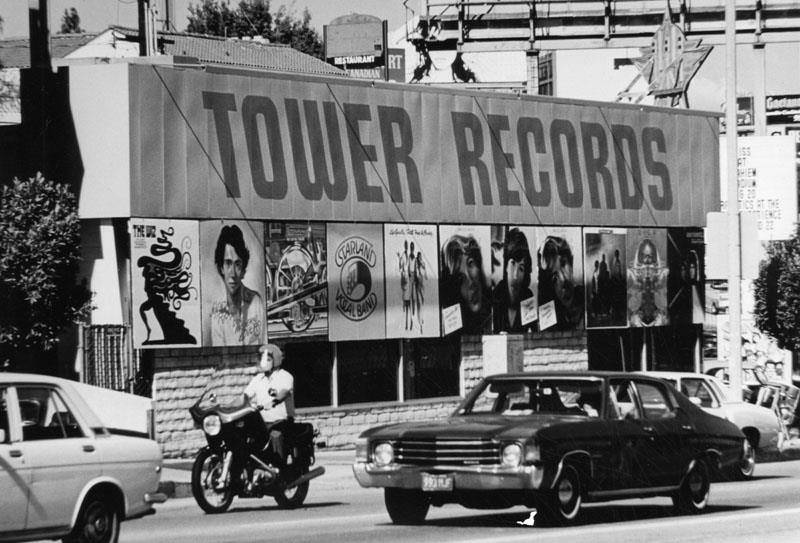 |
|
| (ca. 1980)* - Record albums are promoted outside a Tower Records music store on the Strip near San Vicente Boulevard. Sunset's Strip enclave was a nucleus for album production and promotion for America's popular music buffs. |
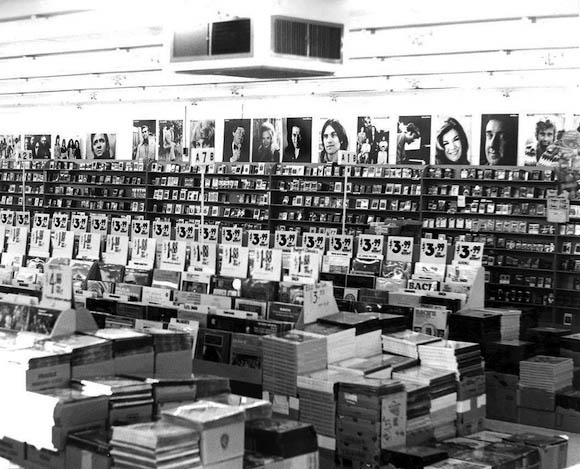 |
|
| (ca. 1970s)* - Interior view of Tower Records on Sunset Boulevard in West Hollywood. |
Historical Notes In February 2022, the iconic Tower Records building underwent a major reconstruction. The renovation removed the east-side walls (while retaining the recognizable metal structural supports), opened up the south wall, replaced the roof, and installed new utilities. Although drastically altered, the building retains its original foundation and core frame. Here's the Tower building (8801 Sunset Blvd) history timeline |
* * * * * |
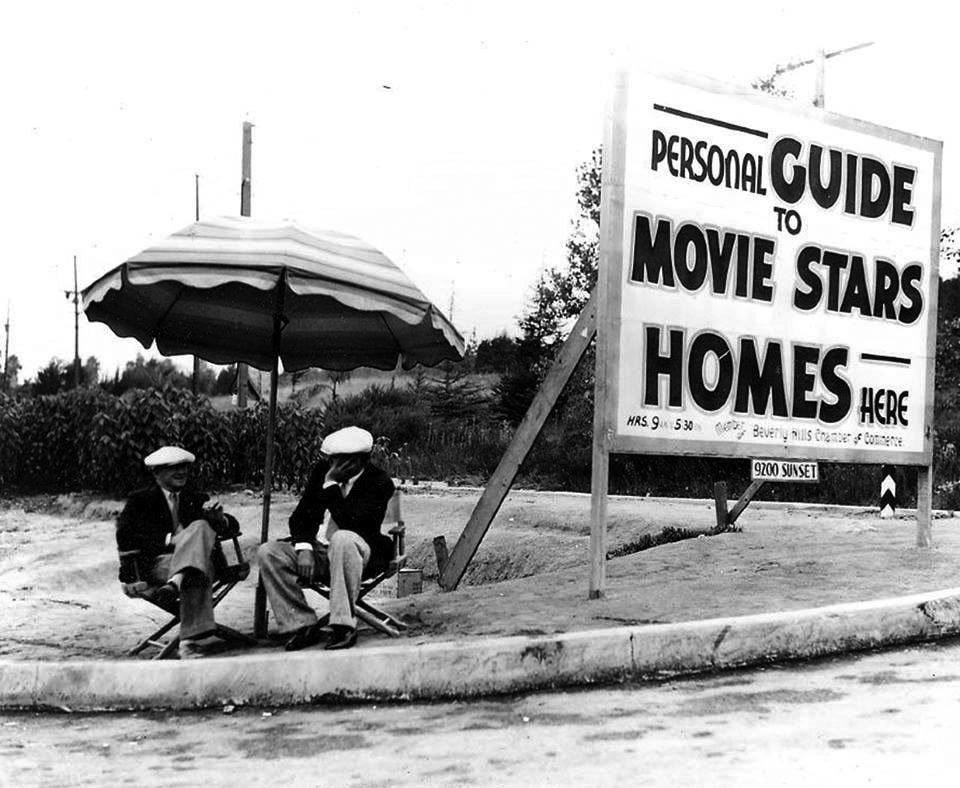 |
|
| (1935)^*^# – View showing two Hollywood tour guides at work. The address on the sign reads 9200 Sunset Boulevard, which happens to be the address of the BOA Steakhouse today. |
Historical Notes Southern California is renowned for its many celebrity estates, and driving through Hollywood, West Hollywood, and Beverly Hills looking for the stars' homes is now a time-honored tradition and a favorite pastime of tourists. |
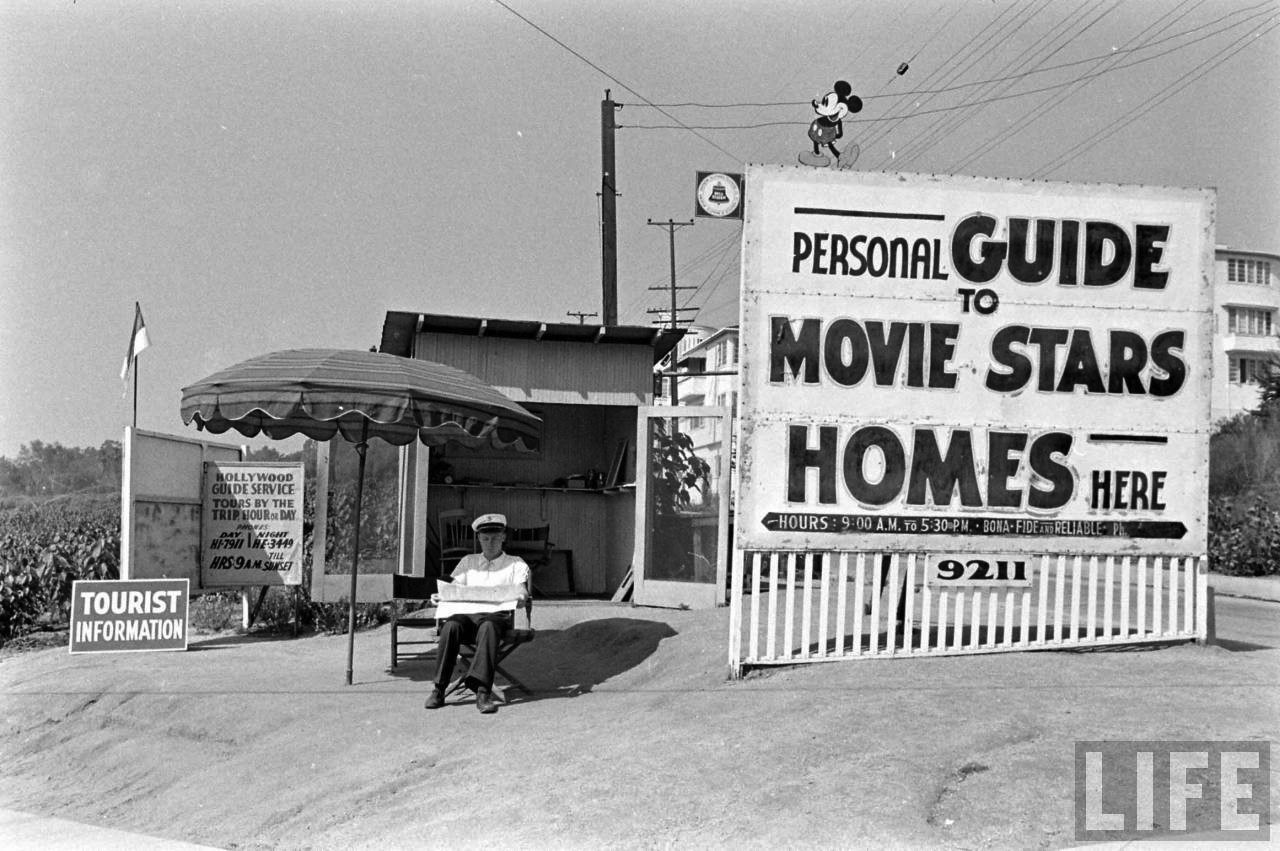 |
|
| (1938)^^++ – Life Magazine photo showing a tour guide looking at what appears to be a map while sitting in front of his office booth at 9211 Sunset Boulevard, near Doheny Rd. |
* * * * * |
Please Support Our CauseWater and Power Associates, Inc. is a non-profit, public service organization dedicated to preserving historical records and photos. Your generosity allows us to continue to disseminate knowledge of the rich and diverse multicultural history of the greater Los Angeles area; to serve as a resource of historical information; and to assist in the preservation of the city's historic records.
|
More Historical Early Views
Newest Additions
Early LA Buildings and City Views
History of Water and Electricity in Los Angeles
* * * * * |
References and Credits
* LA Public Library Image Archive
^* California Historic Landmark Listing (Los Angeles)
^ California Historical Society Digital Archive
** Retronaut - Hollywoodland Sign
#^WhitleyHeights.org: Aerial of Cahuenga; Whitley Heights Aerial
#+LA Weekly: Laurel Canyon Country Store
***The Story of Hollywood by Gregory Paul Williams
^^^California State Library Image Archive
^**Huntington Digital Library Archive
**^Table Magazine: LA Observatory
^++Sunset Plaza
+++The WeHo Ho: An Insider's Guide to West Hollywood; La Cienega Lanes
**#Beguiling Hollywood: The Hollywood Hotel
^^#LA Times: Hollywood Citizens News Building; Marlboro Man Signboard; Mark C. Bloome
+^#Facebook.com: Hidden Los Angeles
*#*Elvis Blog
#^^Hollywood Walk of Fame Historic Buildings
#++GoCalifornia.about.com: Sunset Strip
#^*Pinterest.com: Old Hollywood; Los Angeles
#^# DWP - LA Public Library Image Archive
##*The Daily Mirror: Garden Court Apartments
##^Daily Mail: Hollywood's Hotel Hedonism
##+Facebook.com: Greenblatt's Deli
*^*MTA Transportation and Research Library Archives
*^^Nuestra Señora la Reina de los Ángeles - losangelespast.com
^^*Cinema Treasures: Vogue Theater; Pantages Theater; Iris Theatre; Marcal - World Theatre
*^*^YMCA Hollywood - paulwilliamspoject.org
*^^*Vintage Los Angeles: Facebook.com: Lucy/Holden; Villa Nova; Sunset Tower Apartments; Earl Carroll Revolving Stage; Schwabs Sunset; Player's Club
^*^^Pomona Public Library Poscard Collection
^^^^Water and Power Associates
^*^#Facebook.com - Bizzare Los Angeles
^^^#KCET: How the Town of Sherman Became West Hollywood; The Player's on the Sunset Strip; L.A.'s First Freeways
+++#Go-Go Notebook.com: Flipper's Roller Derby Palace
***^Pinterest.com: Bertrand Lacheze; Vintage Los Angeles: Sunset Strip; Trocadero Nightclub
^**^Griffith Observatory: laparks.org
**##MartinTurnbull.com: The Players; Hollywood-Western Building; Earl Carroll Theater; Sherry's Restaurant; Hollywood and Highland
^^##Alison Martino's Vintage Los Angeles: Wallichs Music City; The Villa Nova
^^++Life Magazine
++^^RockCellar Magazine: Sunset Strip
^+++Brucebase: The Roxy Theatre
#+#+Facebook.com
#+++TheSunsetStrip.com: Sunset Plaza
^##*Flickr.com: Michael Ryerson; Bill Badzo
^#^^Facebook.com - Vintage LA: 1968 Sunset Strip; Yellow Submarine; 1984 Sunset Strip
^^#*Flickr.com: Elizabeth Fuller
*#*#Facebook.com - Great Photos from Los Angeles's Past: Players Nightclub
*^#*Calisphere: University of California Image Archive
*^^#Mt. Hollywood - Small Mountain, Big Dreams
*^##OAC - Online Archive of California
#**#Facebook.com: Garden of Allah Novels, Martin Turnbull
#*^#Historic Hollywood Theatres: Grauman's Chinese Theatre
#^**The Go Go's: Local Coffee Shops and Diners; PJ's Nightclub
#^^#The Rise and Fall of Dino's Lodge by Kliph Nesteroff
#^##ShareTV.com: 77 Sunset Strip
##^*Facebook.com: Classic Hollywood-Los Angeles-SFV
*###Google Maps
###*GoLosAngeles.abouttcom: History of the Sunset Strip
###+The Guardian: Anarchy on Sunset Strip
####Neatorama.com: Dean Martin and Jerry Lewis Restaurant Owners
#^#*Pinterest.com: Rock'n'Roll & Boogie Woogie
**^**Los Angeles City Historical Society
***^^Oldshowbiz.tmblr.com: Crescendo Club
***##Googie Architecture
**^^^Pinterest.com: Sunset Strip
*^^^^SeriousEats.com: Carneys Diner
*^*^*Blogspot.com: It's a wrap - USA/Mexico - Mel's Drive-In
*^#^*Vintage Everyday
*^*^^Crescendo GNP
^*^*^Go Los Angeles About.com: Sunset Strip
^***^Flickr.com: gsjansen
*^^^*RareMaps.com
^#*#^Private Los Angeles Tours: Ciro's Nightclub
^#^#^LA Curbed: Sunset's Tower Records
*#*#*wehoville.com: Tower Records
+#+#+The Garden of Allah Hotel
*# Skyscraperage.com. - Griffith Observatory; Elvis at Knickerbocker Hotel; Gruen Sign; Garden Court Apartments; Mt. Hollywood; Ben-Hur Coffee; Sherry's Restaurant; Griffith Observatory; Sunset Strip 1960s; Cahunega and Highland Intersection ca1937; Googie's; Selma and Argyle
*^ Wikipedia: Hollywood; Hollywood Athletic Club; Hollywood Bowl; Grauman's Chinese Theatre; Grauman's Egyptian Theatre; Pantages Theatre (Hollywood); John Hanson Ford Theatre; 20th Century Fox; Samuel Goldwyn.Studio; Barnsdall Art Park; Greek Theatre; Griffith Observatory; Cinerama Dome; Ralphs; Hollywood Palladium; Hollywood and Vine; Hollywood Masonic Temple; Hollywood Pacific Theatre; Max Factor; West Hollywood; Brown Derby; Hollywood Christmas Parade; The Hollywood Hotel; Cord Automobile: Sunset Tower; West Coast Radio City - Los Angeles; Earl Carroll Theater; Cafe Trocadero; Breakfast in Hollywood; Whitley Heights; Hollywood Christmas Parade; Garden Court Apartments; Chili Bowl Restaurant - Art Whizin; The Hillview; Paramount Studios; Hollywood Freeway; Hollywood Roosevelt Hotel; J. J. Newberry; Claudette Colbert; Whisky A Go-Go; Gazzari's; The Whtie Parade; The Troubadour; Starwood Club; Hollywood Post Office; Chubby Checker; Decoration Day; 77 Sunset Strip; Chateau Marmont Hotel; The Doors; The Comedy Store; Ciro's Nightclub; The Ravenswood; Googie Architecture; Charlie Chaplin; Doheny Drive; Shirley Temple
< Back
Menu
- Home
- Mission
- Museum
- Major Efforts
- Recent Newsletters
- Historical Op Ed Pieces
- Board Officers and Directors
- Mulholland/McCarthy Service Awards
- Positions on Owens Valley and the City of Los Angeles Issues
- Legislative Positions on
Water Issues
- Legislative Positions on
Energy Issues
- Membership
- Contact Us
- Search Index